Last updated on November 28, 2023

Blue Sun's Twilight | Illustration by Piotr Dura
The first set I ever tried properly drafting was Scars of Mirrodin way back in 2010. I hadn’t been interested in the idea before then, nor had any of my local store’s regulars.
I did a couple Drafts of the Zendikar sets but had no idea what I was doing. I’d been playing for about a year and someone sold me on the idea. I’ve loved drafting ever since, so this journey back to the plane really feels nostalgic for me.
Phyrexia: All Will Be One looks really cool and I can’t wait to draft it. Let’s jump in and look at all the cards!
Rating Breakdown
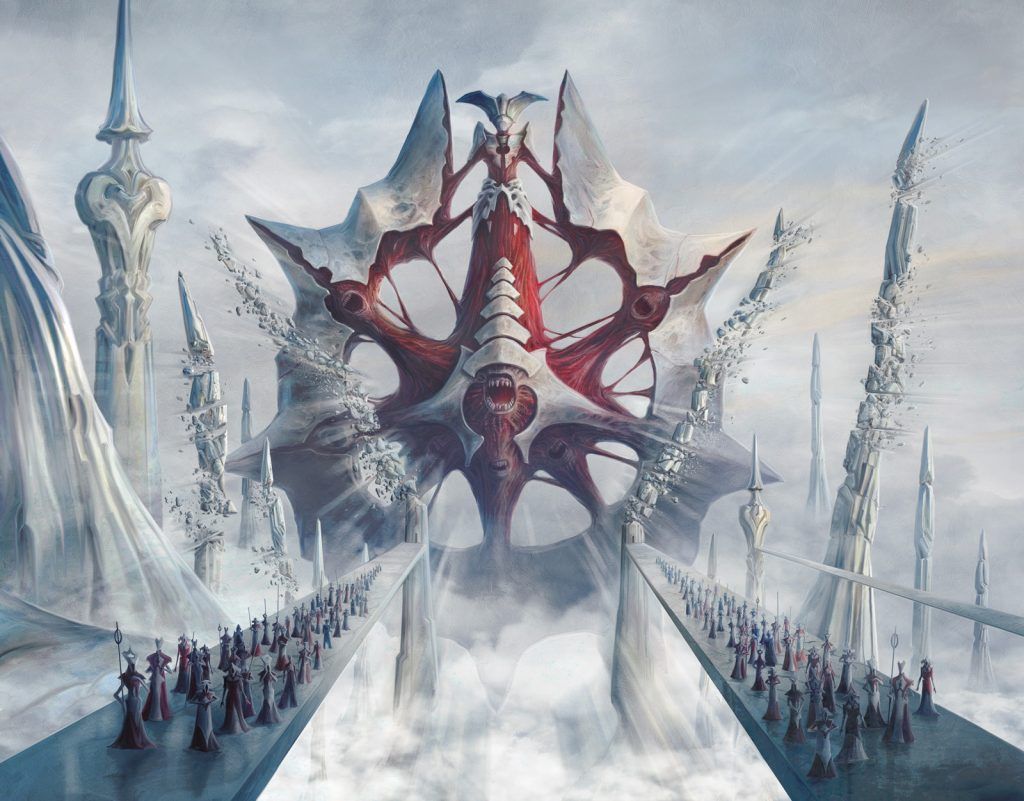
Mondrak, Glory Dominus | Illustration by Jason A. Engle
As always, just a quick reminder that these reviews are based on my initial impressions of the set. There’s no way to tell how fast or slow the format is or how good each of the draftable decks are going to be without actually playing the set, so I’m reviewing each card assuming that the archetype it’s designed for is, in fact, playable. My hope is that these insights will go some way in helping inform your decisions in your first attempts at playing the format.
Before we get to it, here’s what my ratings of the cards mean:
- 10: The absolute best of the best. 10s will make a meaningful impact on any game regardless of when you play them and will be extremely tough to beat. This includes cards like Titania's Command or Wurmcoil Engine.
- 8 to 9: Extremely good cards, usually game-winning bombs, and the most efficient removal spells, though not quite good enough to be a 10/10. Think cards like Gix, Yawgmoth Praetor or Mishra, Claimed by Gix
- 6 to 7: Important roleplayers. These cards are typically the best uncommons that really drive you towards playing a particular color, like build arounds and good removal. These are cards like Overwhelming Remorse or Third Path Iconoclast
- 3 to 5: The average Limited card. Most commons and uncommons will end up in this range, and most of your Limited decks will be made up mostly of these. Think cards like Ambush Paratrooper or Gix's Caress
- 1 to 2: These cards are generally pretty bad and ideally you won’t play any of them. They should be kept in the sideboard and might be useful in specific situations. This includes cards like Take Flight or Fog of War
- 0: Absolutely awful cards. Virtually unplayable in every scenario, and you should never put these cards in your main deck. These are cards like The Stone Brain or The Stasis Coffin.
Set Mechanics
First I’m going to do a quick rundown of the various mechanics in this set and how I expect them to play out in limited.
Toxic N
I normally do these in alphabetical order, but this one is the most important to discuss so I’ll do it first.
Toxic is basically the new infect. Players that are dealt combat damage by creatures with toxic also get a number of poison counters equal to those creatures’ toxic numbers.
There’s no way to modify how much poison is dealt other than giving extra instances of toxic (which do stack up). You don’t have to worry about getting blown out by a Giant Growth on that one creature you let through thanks to this retool.
This is more than likely going to be the cornerstone of the set. Slowly poisoning players in white and black or very quickly out of green gives this mechanic a lot more versatility than it's ever had in the past. It’s going to be very important for a lot of decks to work on poisoning thanks to some of the other mechanics.
Corrupted
I think this is a really interesting take on poison. Poison counters have only been used to get your opponent dead as fast as possible until now, but corrupted abilities give you a reason to want to get the first few hits in and then have no need to rush to the finish line.
Corrupted is only active while your opponent has at least three poison counters. There are some very powerful payoffs for doing so, which really gives you an incentive to get this going by any means necessary. It’s also a focus of some of the Draft archetypes, so you need to be very careful about letting through that third poison counter.
For Mirrodin!
It can’t be all doom and gloom. There’s still a small pocket of resistance against the Phyrexian autocracy that’s plaguing the plane, and they have their own keyword.
This new take on living weapon from the Scars of Mirrodin block is featured on several equipment in the set. For Mirrodin! creates a 2/2 rebel creature token attached to that equipment when it enters. It’s mostly focused in red and white as they’re the main colors for these rebels, and it’s probably going to be a very strong mechanic.
Equipment has a huge flaw in that the most valuable cards in any Limited deck are creatures and removal spells, but equipment is neither. Now your equipment can also be considered a creature, which means it slots into your deck very easily. But not only that, your leaves the equipment behind to power up something else down the line when it dies.
I’d be surprised if this wasn’t the best take on the “equipment matters” archetype that we’ve seen in a long time.
Oil Counters
Oil counters are nothing particularly special, to be honest. It’s just a new kind of counter that a variety of cards in the set use in different ways. Each one uses them very differently and there are some Draft archetypes that are focused around them.
They also work very nicely with…
Proliferate
Proliferate is a fantastic mechanic and a fan favorite that’s made its way into the set. If a card instructs you to “proliferate,” you get to choose any number of permanents or players that counters on them and add an extra one of each of those counters to them.
It’s worth noting that there are no cards in this set that use +1/+1 or -1/-1 counters, which the developers have pointed out is to try to curb the power level that we’ve seen proliferate have in previous sets. But that doesn’t stop it from doing good work in proliferating poison counters, loyalty counters (there are five planeswalkers at rare) and oil counters, so it’s likely to still be strong.
There’s also a specific proliferate Draft archetype in blue and black with some cards that pay you off when you do it, so keep an eye out for those!
Spheres
Sphere is a new land type in the set. The structure of Phyrexia is centered around these “spheres” (very similar to the circles of hell from Dante Alighieri’s The Divine Comedy).
Spheres don’t do anything inherently different from other lands. Much like “Gates,” this is just a flavorful marker that can be referenced on cards.
White Cards
Against All Odds

Rating: 2/10
Both of Against All Odds’ modes are situational and overcosted. You really need to reliably make use of both to make it work, which requires a deck with good ETB triggers and plenty of cheap creatures to return.
Even then finding room for this isn’t easy, so I don’t expect this to be played in anything but the most dedicated of decks.
Annex Sentry
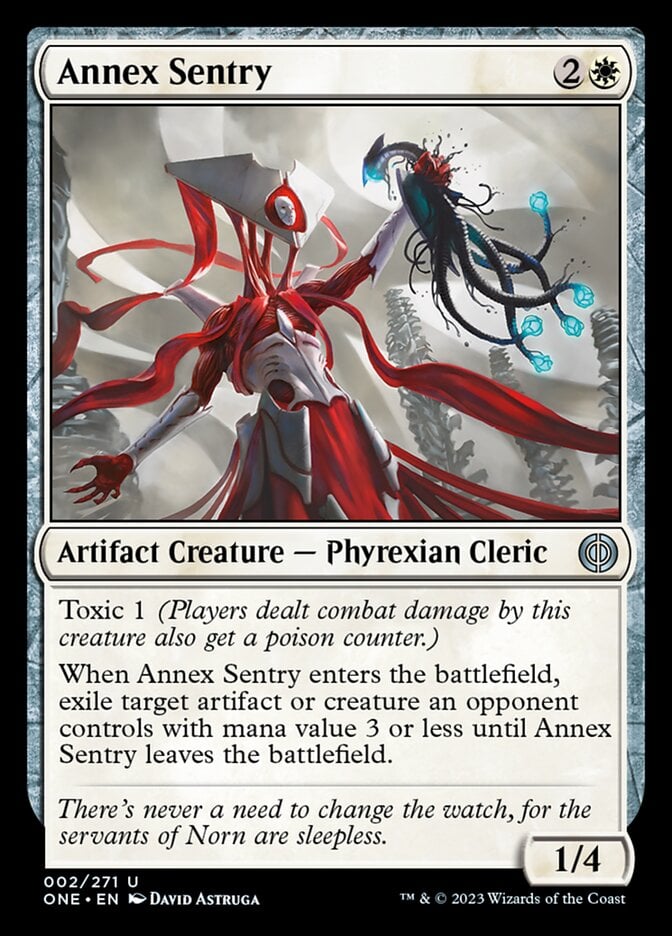
Rating: 7/10
Banisher Priest and its many variants are always very strong Limited cards. A 1/4 with toxic 1 is much better than a 2/2 overall, so we’ve had the ability’s power level diminished as a result.
That’s by no means a deal breaker, though, because Annex Sentry still hits plenty of good targets and is very strong against tokens, which won’t be coming back when this leaves the battlefield.
Apostle of Invasion
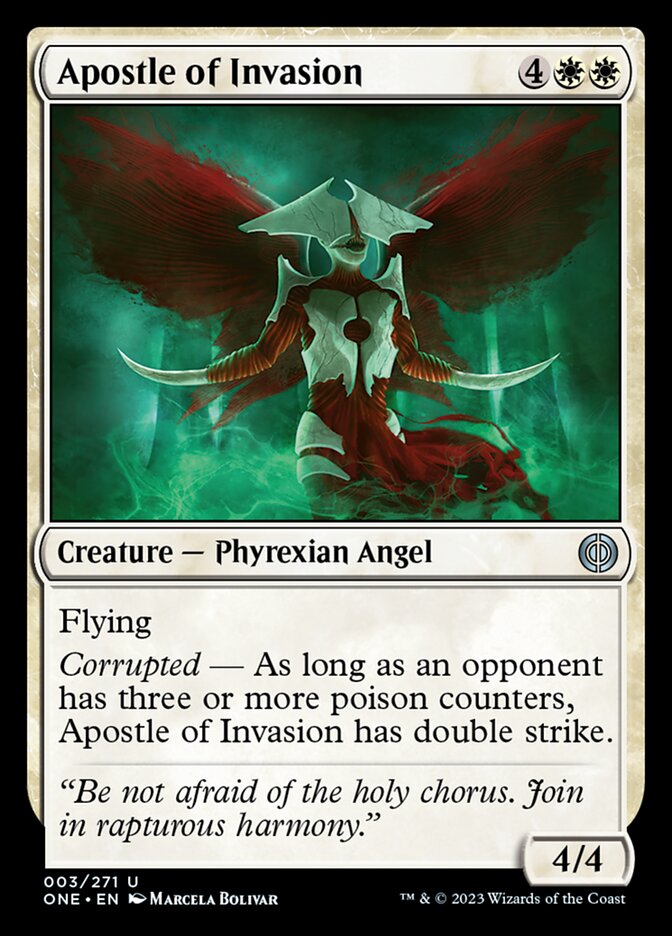
Rating: 4/10
Sadly a 4/4 flier for six is quite a bit below rate these days. The double strike is very powerful and could make Apostle of Invasion a nice curve topper if you can enable it in the right deck and reliably have corrupted online by the time you play it.
Basilica Shepherd

Rating: 4/10
Basilica Shepherd is a really solid 5-drop. A 3/3 flier plus a pair of mites is a great deal and something I’m very interested in flickering since there are a couple ways to do that in the set. It’s a good amount of value to see, and I imagine that the mites will add up very quickly.
Bladed Ambassador

Rating: 6/10
Cards like Adanto Vanguard and Seasoned Hallowblade are completely obnoxious because you can pretty much always make them indestructible. What’s good about Bladed Ambassador is that you have to put quite a bit more work into it if you want to keep making it indestructible. You only get one use of it spotted to you, but you can really make it last with proliferation and oil counter synergies.
While not as powerful as its predecessors, it’s still a very strong card and probably one of the best 2-drops white has to offer.
Charge of the Mites
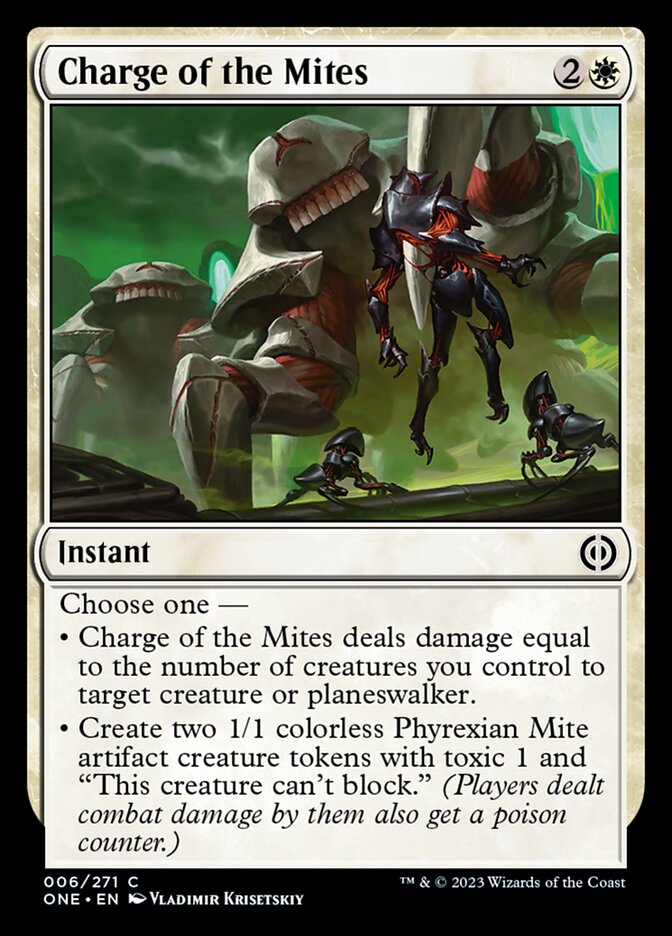
Rating: 5/10
Three mana for a pair of 1/1 tokens, especially ones that can’t block, isn’t that good of a deal. But give Charge of the Mites the extra option of being an actual removal spell? Yes please!
Compleat Devotion
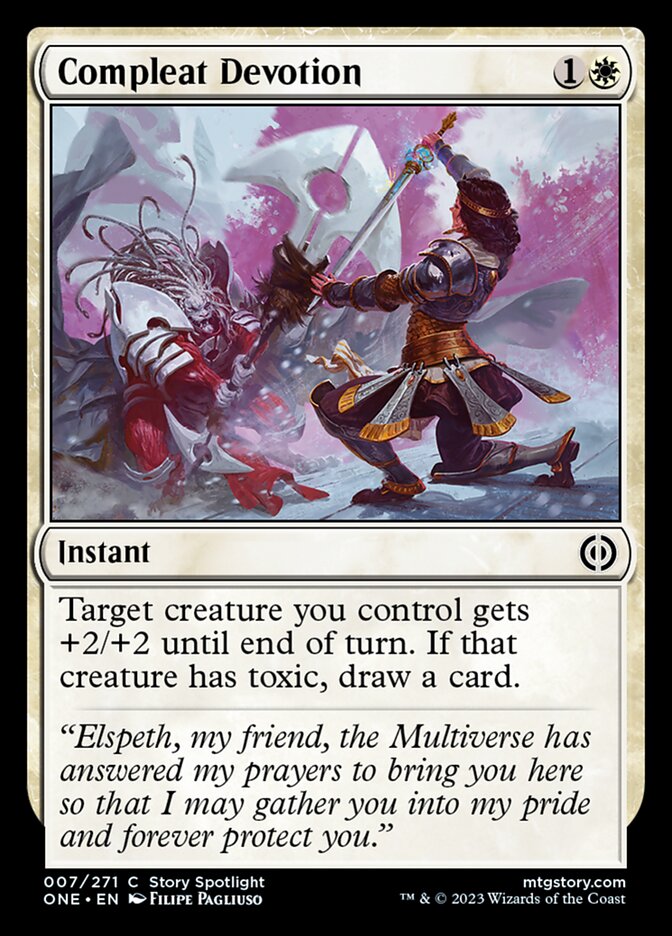
Rating: 5/10
Compleat Devotion is what I want out of a combat trick. The +2/+2 is unconditional and it has a very easy out to getting me a straight up two-for-one.
Granted, it won’t be that good in every white deck, but I’d prioritize this pretty highly as soon as you know you’re in a toxic-themed archetype.
Crawling Chorus
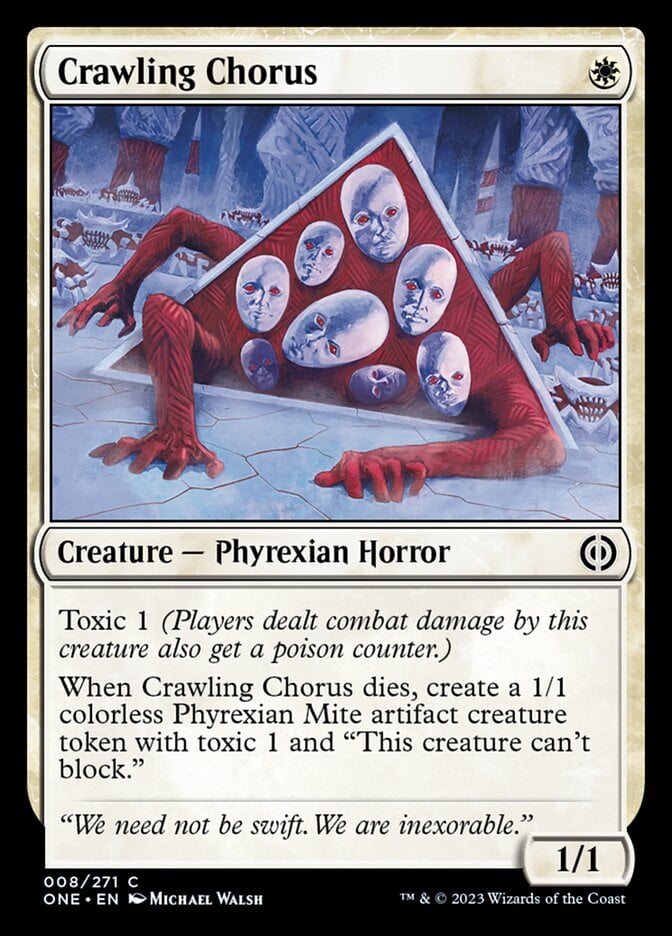
Rating: 4/10
Crawling Chorus is certainly one of the creepiest artworks in the set, and it’s not a bad card overall. Basically a toxic-themed Doomed Traveler.
It’s looking like aggro is very well supported in this set, and this a pretty solid 1-drop to start your curve with.
Duelist of Deep Faith

Rating: 5/10
An excellent 2-drop. The first strike on your turn is huge if you’re taking the offensive. Duelist of Deep Faith is a great way to get a poison counter or two down early in decks where you want to enable corrupted since it should take a while before your opponent can effectively block it.
Elesh Norn, Mother of Machines
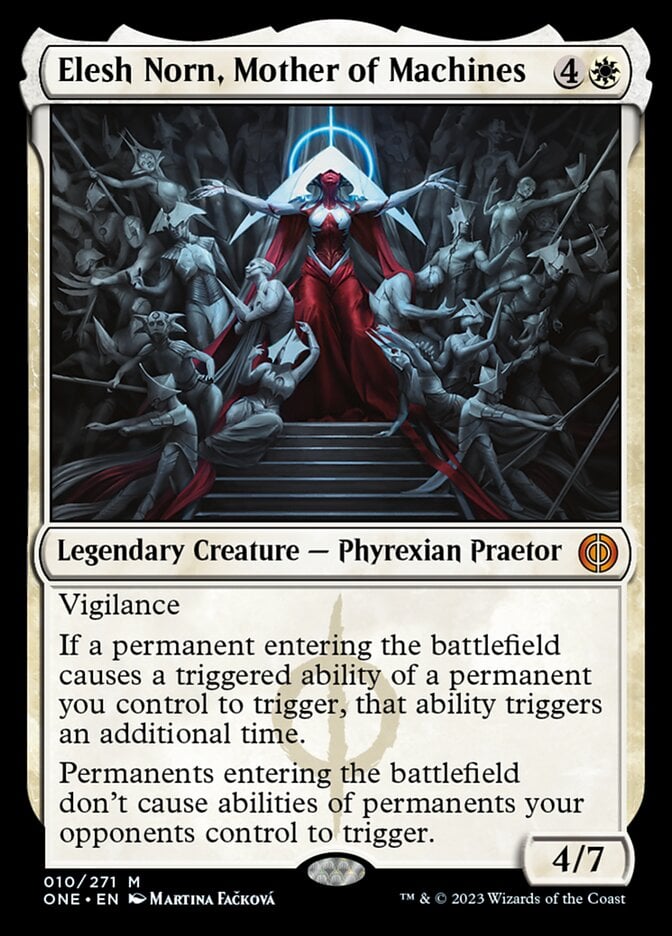
Rating: 8/10
It should be obvious looking at our new Elesh Norn that the more ETB triggers that you have, the better it becomes. That said, a 4/7 with vigilance for just five mana is way above the rate we’d usually expect, and you might get a lot of inherent value from shutting down your opponent’s triggers.
Elesh Norn, Mother of Machines is even splashable if you want is to be. I’d play this in any white deck and would try to pack my deck with all the ETB triggers I could find if I picked it up early enough in a Draft.
The Eternal Wanderer

Rating: 10/10
Our first rare planeswalker is a scary one for sure. The Eternal Wanderer’s first ability is fine, but it’s only going to be relevant in a few cases. It’s also nice that you can flicker equipment to retrigger their for Mirrodin! abilities.
Its second ability is kind of ridiculous. 2/2 double strike tokens should make a very sizable impact on the board right away, and they even kill your opponent quickly when you’re making them every turn.
But what really catches my eye is the Wanderer’s third ability. Tragic Arrogance was a really powerful card in its day, but it wasn’t even in the form of a powerful planeswalker that also got to do other things. You can leave your opponent with their worst creature while you keep your best, and the Wanderer will stick around for another turn to keep putting the pressure on if they don’t have removal.
All of this is even without mentioning how hard this is to kill given that it could have as high as six starting loyalty and can only be attacked by single creatures. The Wanderer looks absolutely absurd, and I’m looking forward to giving it a try.
Flensing Raptor

Rating: 5/10
Always love to see a strictly better Wind Drake. Flensing Raptor looks incredibly good to enable corrupted not just because it’s a toxic flier itself, but Jumping another toxic creature to get a hit in helps you keep up the tempo and get your damage in.
This is precisely what you need to get corrupted online early.
Goldwarden’s Helm
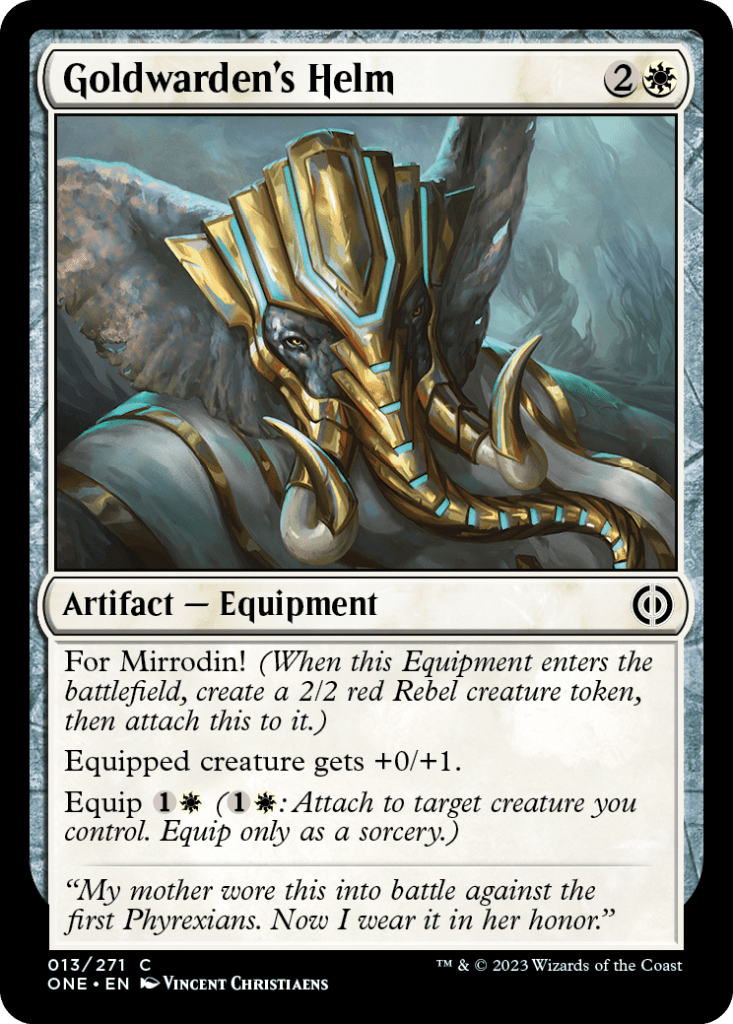
Rating: 2/10
The for Mirrodin! mechanic is inherently very powerful and we’ll see some very powerful cards that use it later, but that’s why Goldwarden's Helm looks as bad as it does. We’re not that interested in a vanilla 2/3, and the equipment that’s left behind isn’t good at doing much.
That said, this is still serviceable thanks to the aforementioned mechanic if your deck needs to go deep on equipment.
Hexgold Hoverwings
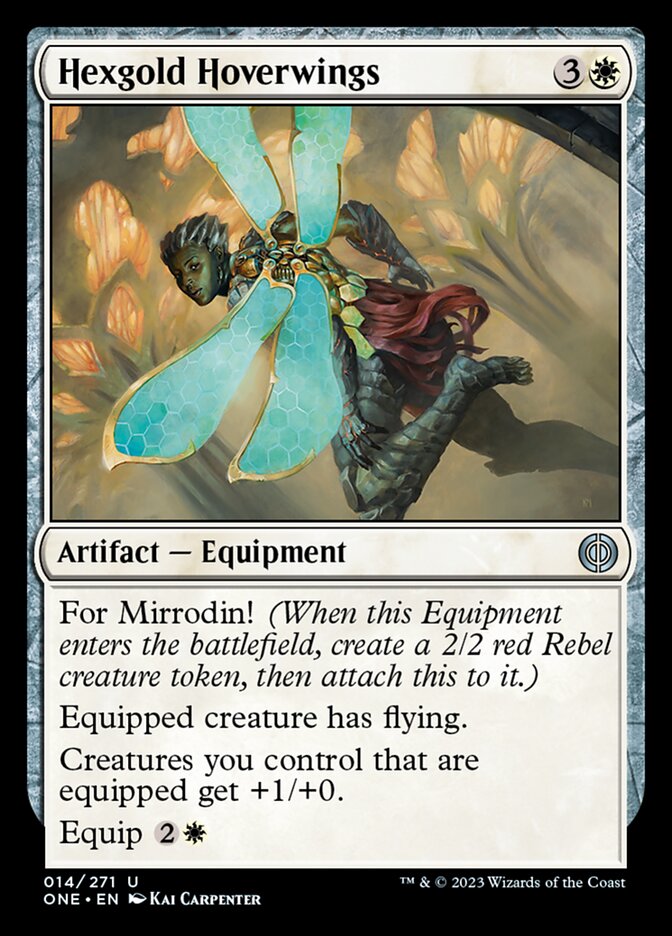
Rating: 4/10
This is a 3/2 flier for four mana on its own, which isn’t that bad. The equipment is very reasonable to leave behind and Hexgold Hoverwings doesn’t even need to be equipped to give the +1/+0 bonus to your other creatures, so I’d say this is a decent card all ‘round.
Incisor Glider
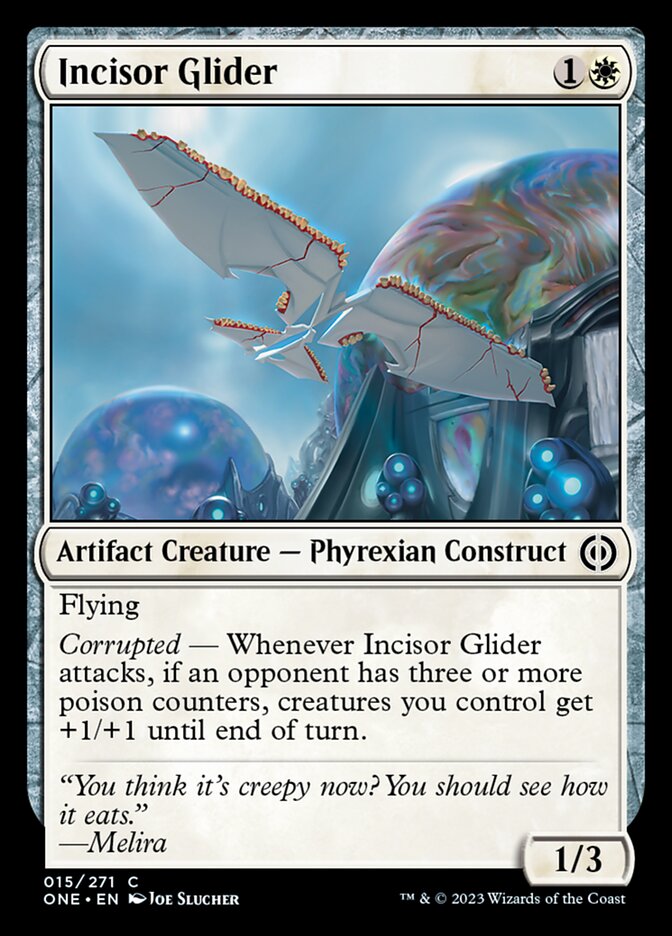
Rating: 4/10
While a simple Concordia Pegasus isn’t going to look that impressive, Incisor Glider is a very powerful payoff for getting corrupted online. We just saw just how powerful Ambush Paratrooper could be from The Brothers’ War, and this seems to fulfill a very similar role.
Indoctrination Attendant
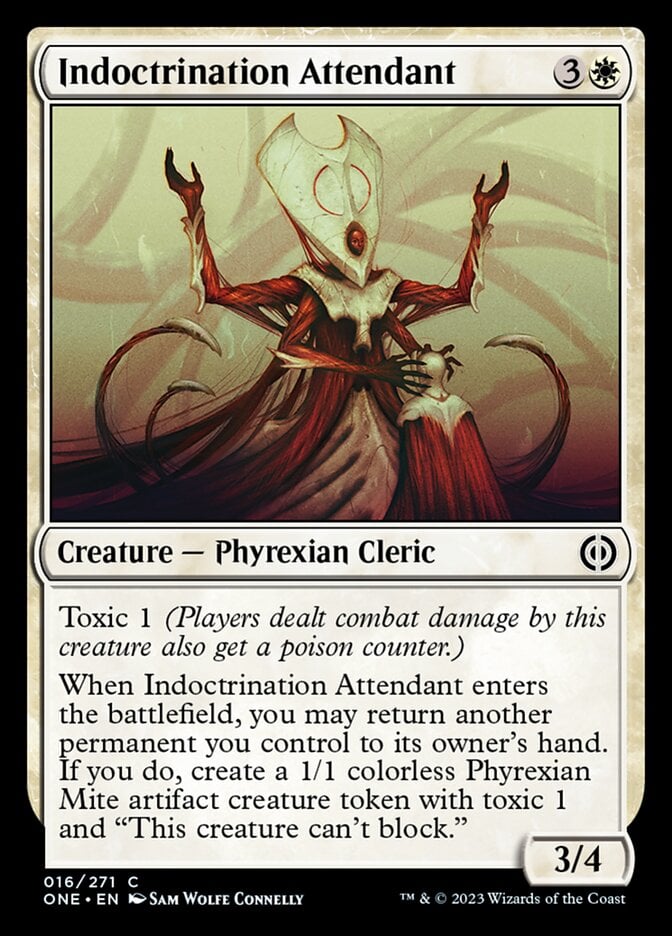
Rating: 4/10
I’ve already seen quite a few nice triggers that Indoctrination Attendant’s ability will let you reuse. Returning a permanent to the hand isn’t as good as just flickering it, but it won’t end up mattering too much if the ability is good enough.
Infested Fleshcutter
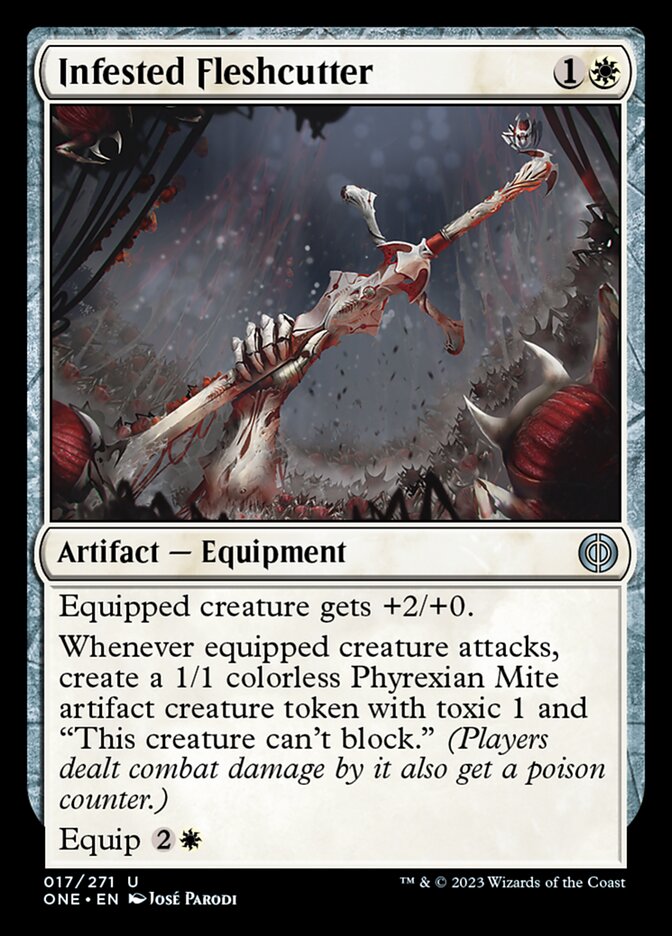
Rating: 1/10
It’s hard to justify weak equipment. Creating a Phyrexian Mite token on attack is very strong, but it costs so much mana to get there that I think Infested Fleshcutter is likely just bad. You have to have spent five mana and then gotten a good attack in to just get a single mite.
This is just too expensive for not enough of a payoff, especially when compared to the for Mirrodin! cards.
Jawbone Duelist

Rating: 5/10
Double strike and toxic pair very nicely together. Funnily enough, double strike also pairs very nicely with equipment, which is abundant in this set.
These two facts make this new Fencing Ace variant a really strong 2-drop.
Kemba, Kha Enduring
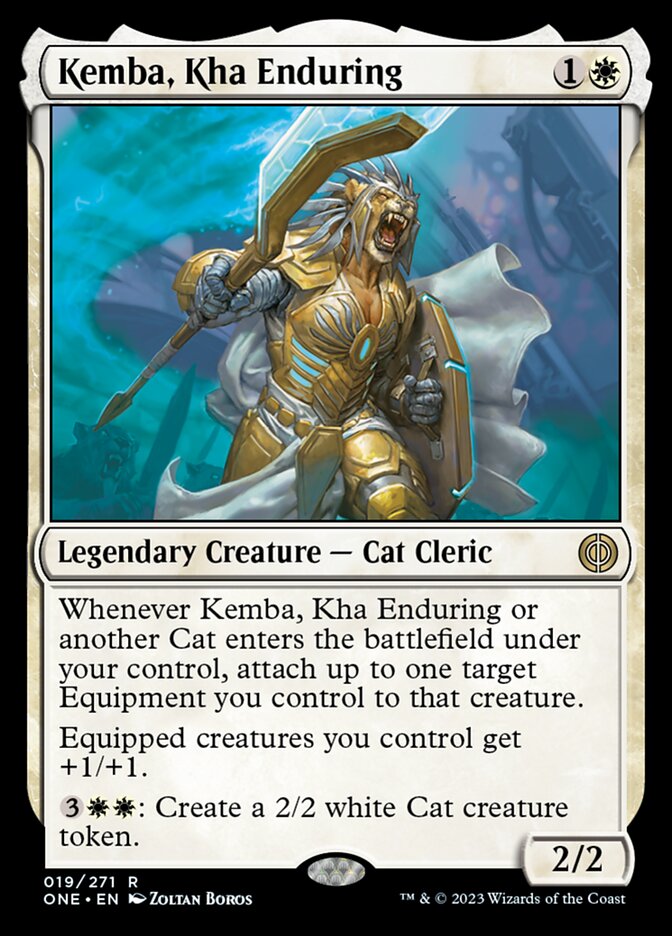
Rating: 6/10
Yay, a new Kemba! Kemba was one of my favorite characters in Scars of Mirrodin, and I loved her card. The new Kemba is a little weird, but ultimately it’s a 2-mana 2/2 with three big upsides, so it can’t be that bad.
What I don’t like is that Kemba, Kha Enduring is literally just a Glory Seeker in a vacuum, but throw some powerful equipment into the mix and it starts to shine. That wouldn’t be at all impressive in a normal set, but for Mirrodin! is a very strong ability and one that should mean that a lot of white decks will be able to get some decent value from Kemba.
It can also create a lot of free tokens in the late game which is a nice bonus, but overall this Kemba looks like a nice build around for the equipment deck.
Leonin Lightbringer
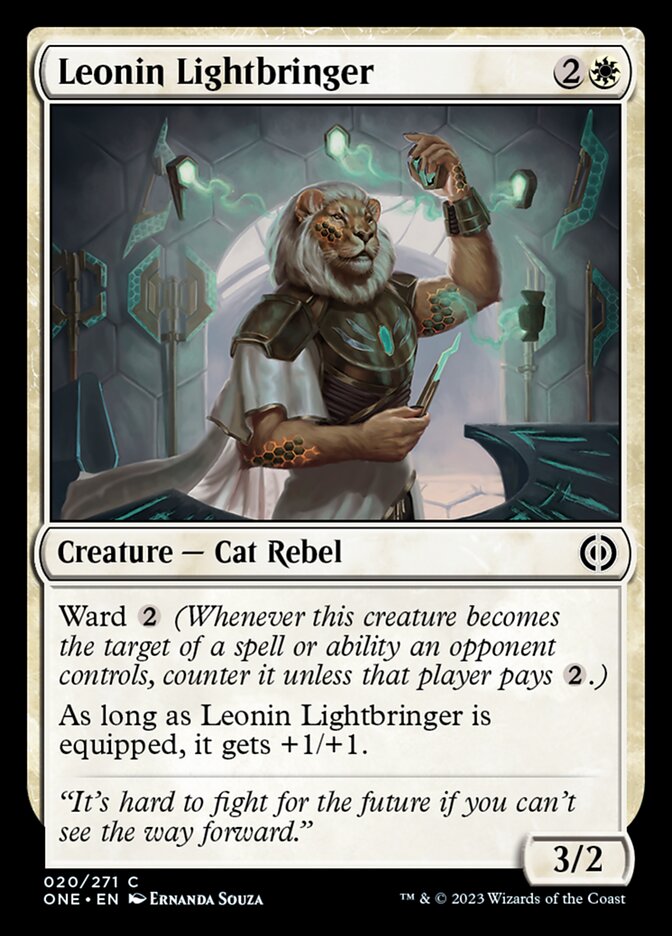
Rating: 4/10
The base rate on this cat isn’t too bad, definitely something you can fill out a curve with. Getting the +1/+1 shouldn’t be that hard to pull off thanks to all of the For Mirrodin! equipment in the set, so Leonin Lightbringer might actually be a very desirable card in the right deck.
Mandible Justiciar

Rating: 4/10
White is definitely not short on strong 2-drops in this set. A 2/1 lifelink and an easy way to grow it each turn is definitely something I’m interested in, especially in the white/blue artifacts archetype.
Mirran Bardiche

Rating: 3/10
Like the other common equipment we saw earlier, the base rate of a 4/3 vigilance for five mana isn’t particularly desirable. Yeah, you get a free equipment out of it, but I doubt you want to play Mirran Bardiche at all outside of a dedicated deck for it at four mana to equip and a relatively small bonus.
Mondrak, Glory Dominus
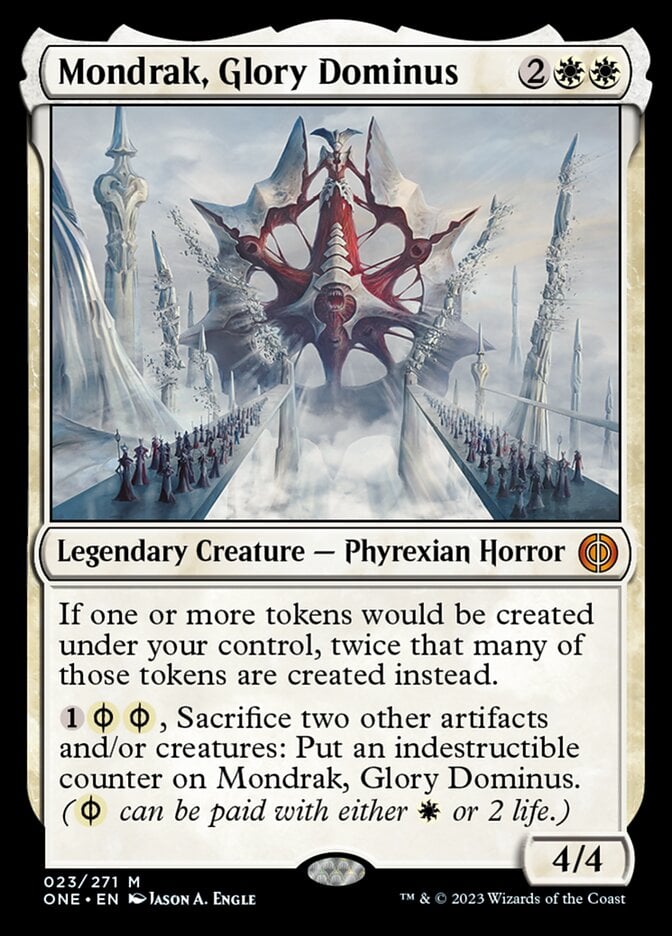
Rating: 8/10
Just like Elesh Norn, Mondrak, Glory Dominus gives you a relatively niche bonus that looks great in a constructed environment where you can build around it, but it’s a little harder to make use of in Limited. But there are a lot of token generators in this set, which means that a lot of decks should be able to get some advantage from the white Dominus.
The protection ability is pretty nice and can cost just one mana thanks to the Phyrexian mana in it, but it’s likely that sacrificing two permanents just to save a vanilla 4/4 won’t be worth it. Just make sure you really want to keep it around if you’re going to do that.
Norn’s Wellspring
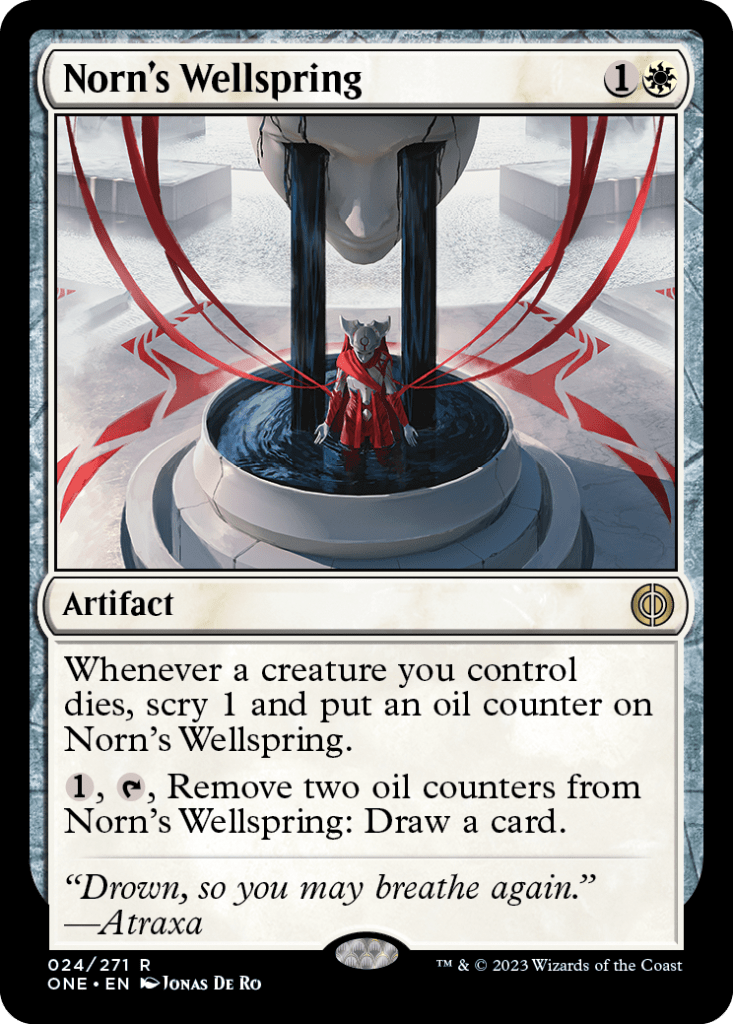
Rating: 6/10
It’s really nice to see some solid card draw in white. You only get to draw for every two creatures that die, but the scrying in between can also help smooth out your draws.
What’s more is that you can use proliferating to add more and get more draws once you’ve got a single oil counter down. This can sit on the battlefield slowly generating advantage throughout the game, and it’s still worth it even if this only draws you one or two cards.
Orthodoxy Enforcer
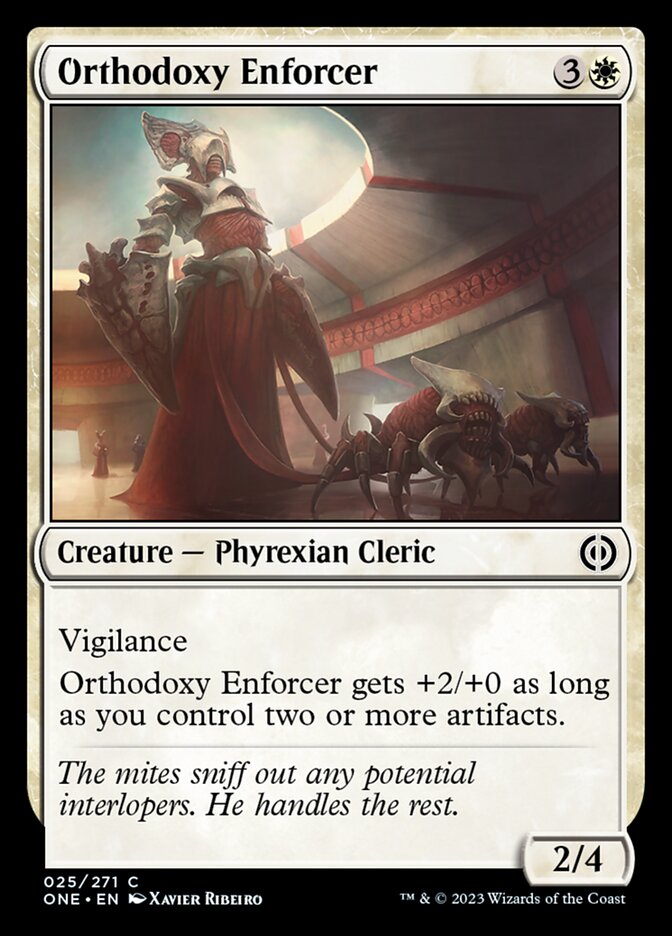
Rating: 4/10
Having two artifacts in play shouldn’t be that difficult to accomplish between mites, equipment, and a bunch of other things. Assuming you can do that, a 4/4 vigilance for four like Orthodoxy Enforcer is probably something you’re happy with.
Ossification

Rating: 7/10
You can pretty much ignore the “enchant basic land you control” clause. All that serves is to reduce Ossification’s power level in constructed. We’re playing limited, so we always have a spare basic land on the board.
So this is just a Journey to Nowhere with the upside of killing planeswalkers. That’s an upside I’m very happy to see in a set that has five of them at rare (but only four that can be targeted).
Phyrexian Vindicator
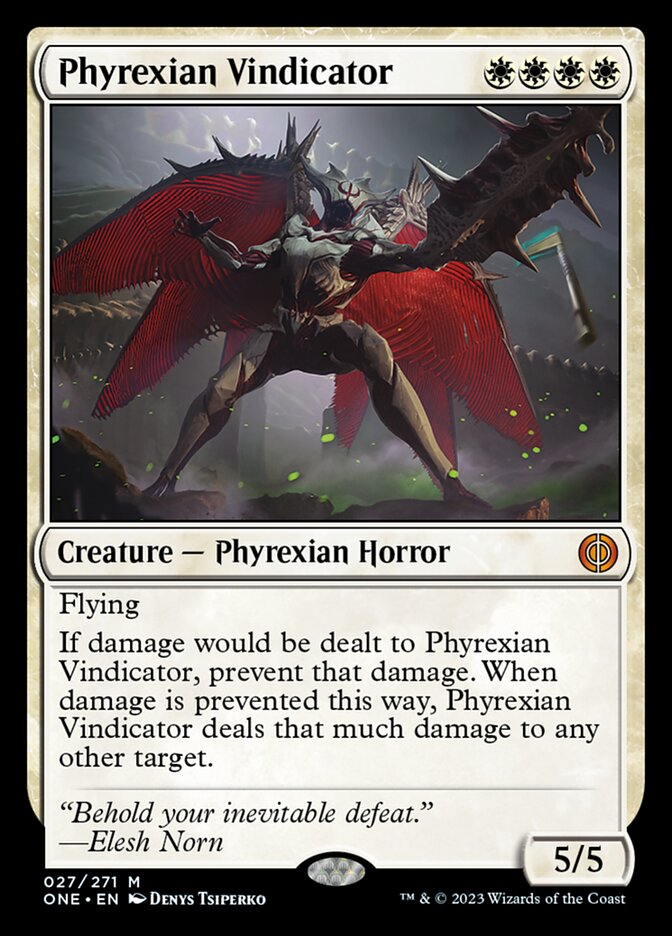
Rating: 3/10
Cards like Phyrexian Vindicator (we’ll get to Phyrexian Obliterator shortly) often look impressive but don’t play out anywhere near as well as they look. Quadruple white is a prohibitively difficult mana cost, and this is still vulnerable to a lot of removal while its ability looks strong.
I want some kind of immediate benefit if I’m stretching my deck’s mana base to cast this thing as opposed to just a big fat creature that can’t take damage.
Planar Disruption

Rating: 7/10
We’ve come a long way since the days of Arrest and Pacifism. There’s really nothing bad to say about this new variant. Planar Disruption does everything you want to do, and does so very cheaply.
These cards have inherent downsides, like being weak to flicker and sacrifice effects, but they should still be good enough when they come as powerful and efficient as this.
Plated Onslaught
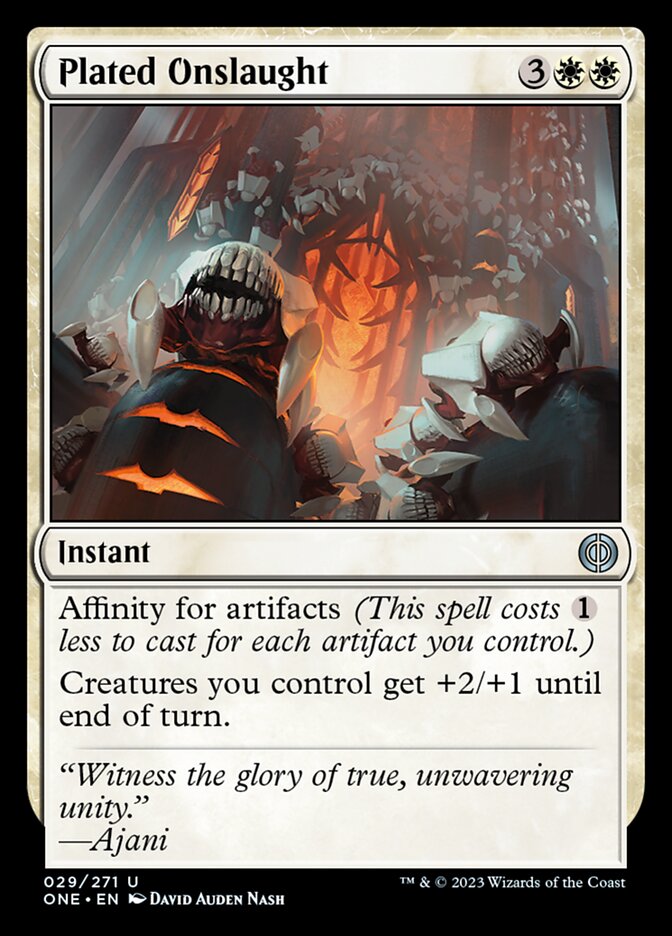
Rating: 5/10
Inspired Charge is a card that a lot of white decks are very happy to play one copy of, especially when they’re going wide. Affinity makes Plated Onslaught quite a bit more interesting than that because it shouldn’t be too difficult for quite a few white decks to cast this for just , which really pushes it over the edge.
Porcelain Zealot

Rating: 5/10
It’s hard to overstate how powerful an ability like Porcelain Zealot’s is. Triggering turn after turn adds up fast.
+1/+1 might not sound like a lot, but it’s often enough to push a creature past a blocker that it wouldn’t have otherwise been able to attack through. Pushing your toxic creatures through is especially useful, so don’t sleep on this.
Resistance Reunited
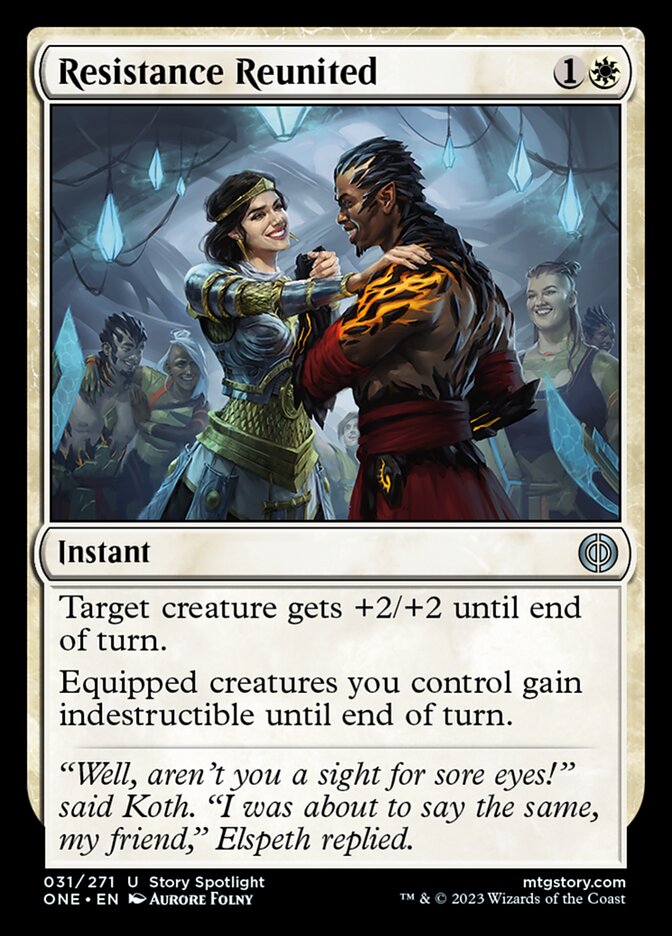
Rating: 2/10
You might know that I’m generally not a fan of combat tricks if you’ve read my reviews before. +2/+2 for two mana is quite bad, so you really have to want Resistance Reunited’s second mode before wanting it.
This can be devastating in the right deck so it’s not exactly unplayable, but you need to have multiple equipment before wanting one of these.
Sinew Dancer

Rating: 4/10
I really like Sinew Dancer’s design. Master Decoy variants have been very powerful in the past, but they can be miserable to play against.
At least this has a nice balance where it’s very weak at first, but it becomes Gideon's Lawkeeper, one of the game’s best ever tappers, if you can turn on corrupted.
Skrelv, Defector Mite
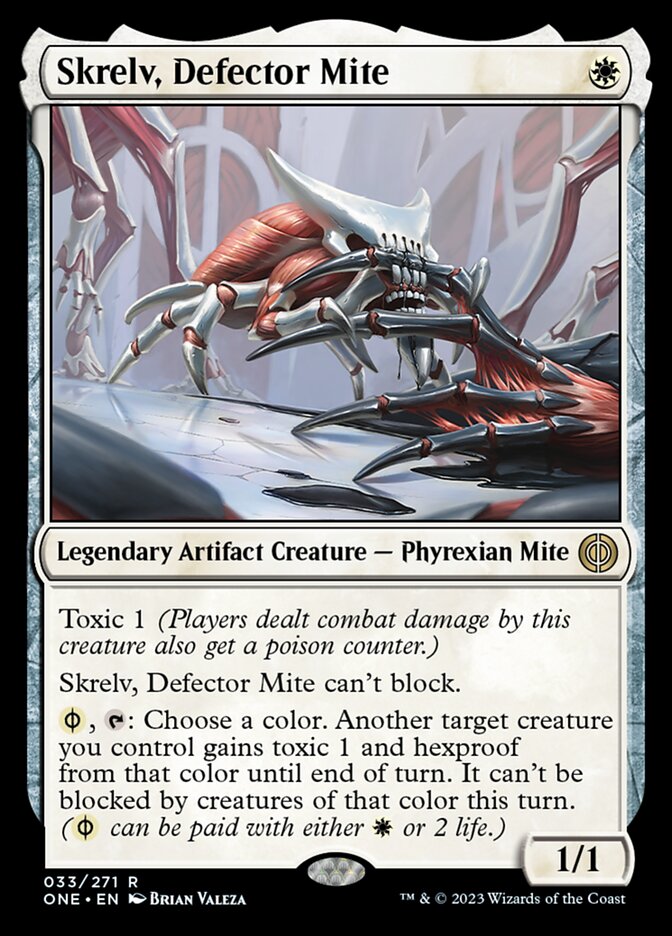
Rating: 9/10
I’m not sure what would have been on my bingo card for this set, but Phyrexian-ized Mother of Runes wouldn’t have ever crossed my mind.
Skrelv, Defector Mite is absurd. It starts out as a great 1-drop that’ll rack up a couple poison counters if left unimpeded. And it basically turns off your opponent’s removal spells in the late game, so you don’t particularly care if it can’t block.
This is templated more like Giver of Runes so it won’t be able to protect itself from removal like Mom can, but the ability is still ridiculous. If your opponent has a premium removal spell and you have Skrelv plus a 6/6, they have to waste that premium spell on Skrelv instead of the thing that’s actually killing them.
I’d be very surprised if this wasn’t the most annoying card in the set to play against.
Skrelv’s Hive
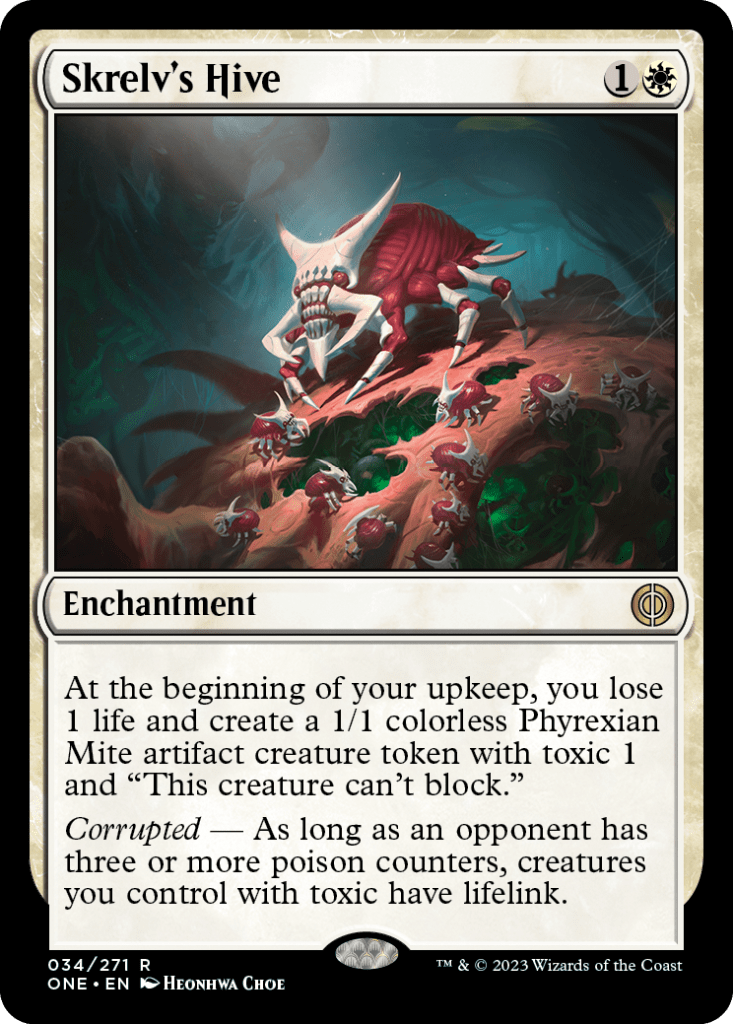
Rating: 5/10
Sadly, Bitterblossom this is not. The biggest problem is that the mites can’t block, which means that Skrelv's Hive does very little to help you mitigate the one life you lose each turn.
Granted, it does eventually give your creatures lifelink, but it just looks like the kind of card that your opponent can, to some extent, ignore. It’s especially bad if you draw it in the late game. The ability to block is very important, and I believe it’s holding this back from being a bomb rare.
Swooping Lookout
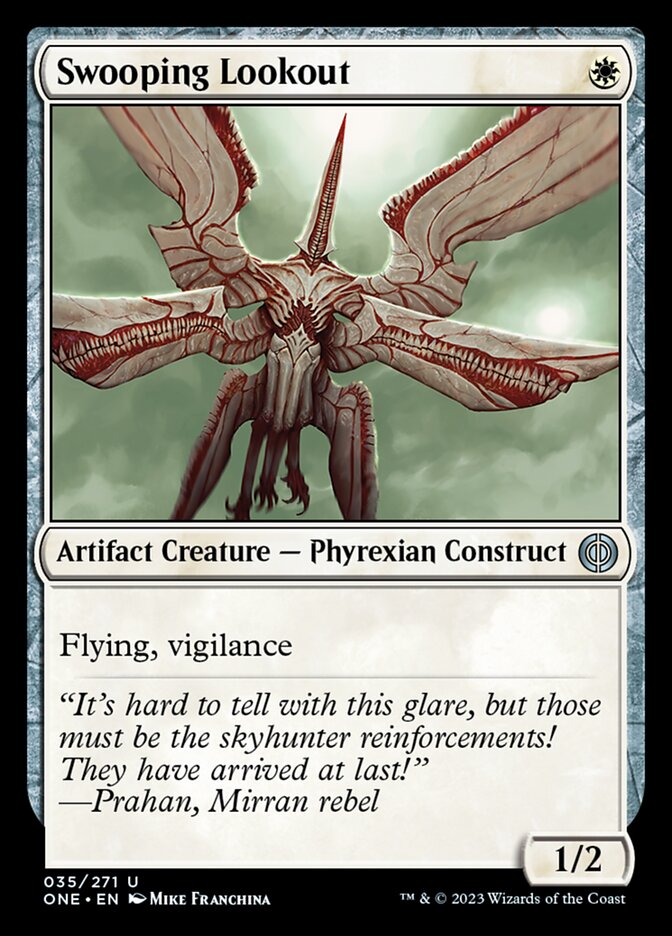
Rating: 4/10
It doesn’t get much more boring than Swooping Lookout, but recent sets (which by this point is about five years’ worth, but I still can’t believe it) have proven to us just how strong 1-drops can be. My early impressions are that this set looks quite aggressive and a Suntail Hawk with some very significant upgrades should feel right at home in an aggressive setting.
Vanish into Eternity
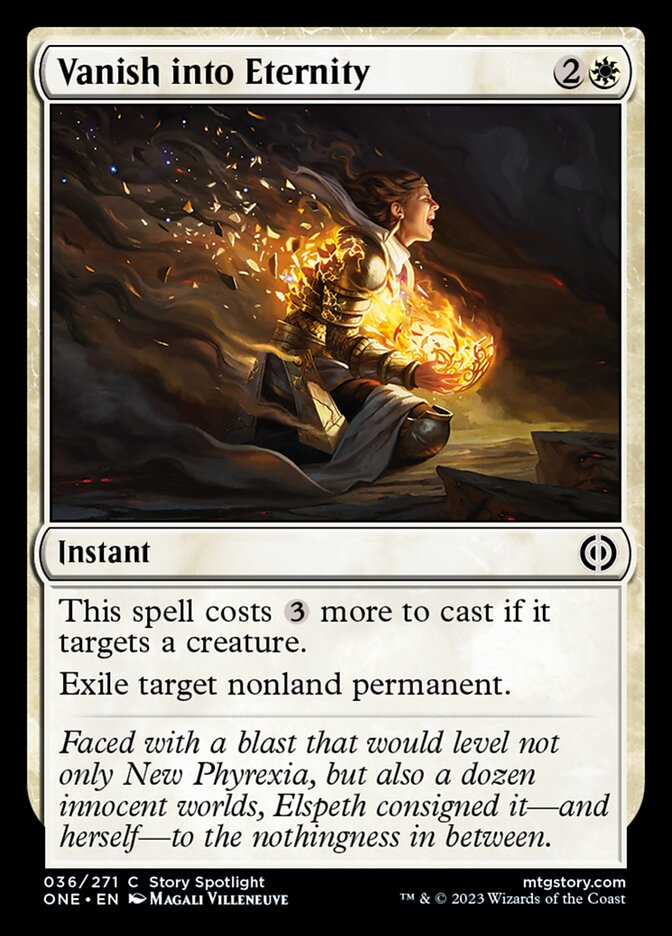
Rating: 4/10
Removal spells live and die by how effectively they deal with creatures. While Vanish into Eternity does so for six mana, it’s still instant speed and it exiles, so it’s not all bad.
I’d imagine a lot of white decks will want one, but the second will be unnecessary.
Veil of Assimilation

Rating: 1/10
I just don’t see Veil of Assimilation happening. Sorcery-speed pump spells are bad in general.
Sure, this is one that can be reused and might trigger when you play new creatures, but I can’t imagine a lot of decks would want to spend a slot on playing this. It’s also uncommon so you’re not even likely to pick up multiples and turn the bonus into something more impactful.
I’d say just don’t bother, but I’d love to be proved wrong.
White Sun’s Twilight

Rating: 10/10
I remember learning to play MTG and loving Martial Coup, which blew my mind having come from a game where board wipes were banned if they were ever printed.
Now that it’s back in this new form I’m very excited, and White Sun's Twilight is one hell of a Limited card. The best board wipes in Limited are ones that allow you to rebuild your board quickly, and a pile of Phyrexian Mites is the perfect way to do that.
It might be costly to do, but casting this for four or five mana to get a couple mites and some life is still a reasonable mode for it.
Zealot’s Conviction
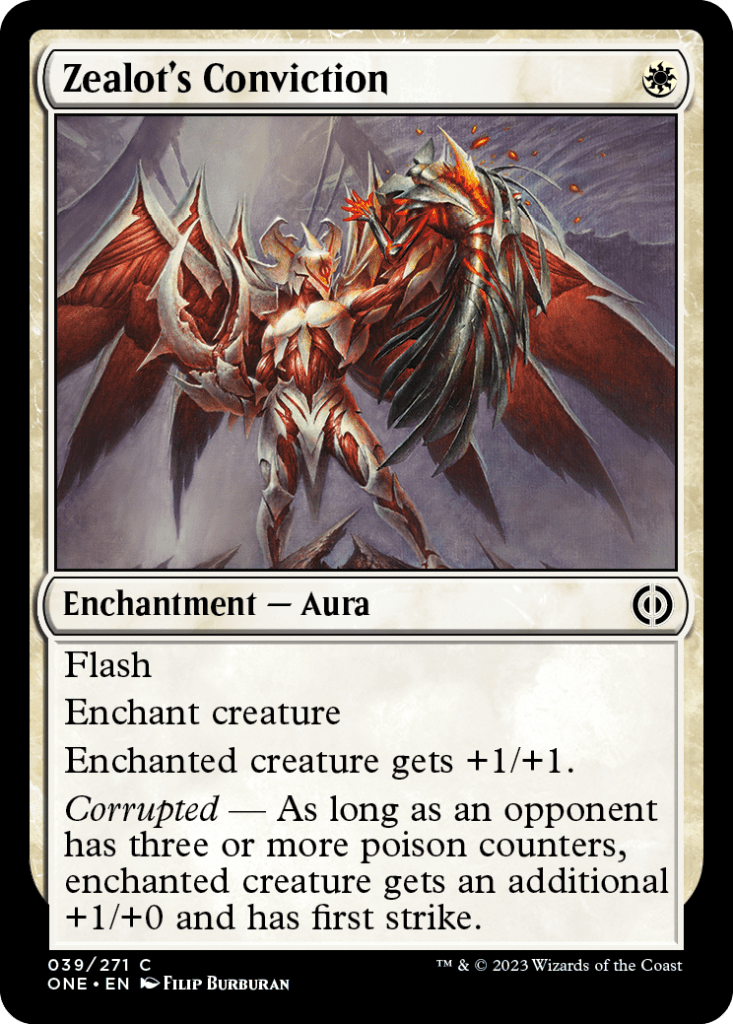
Rating: 4/10
White overall looks like a very aggressive color, with several premium 1- and 2-drops to choose from. Given that, I actually like Zealot's Conviction. A cheap combat trick that sticks around for later turns and is especially nasty if you’re poisoning your opponent is something that I’m guessing you want in this format.
Blue Cards
Aspirant’s Ascent
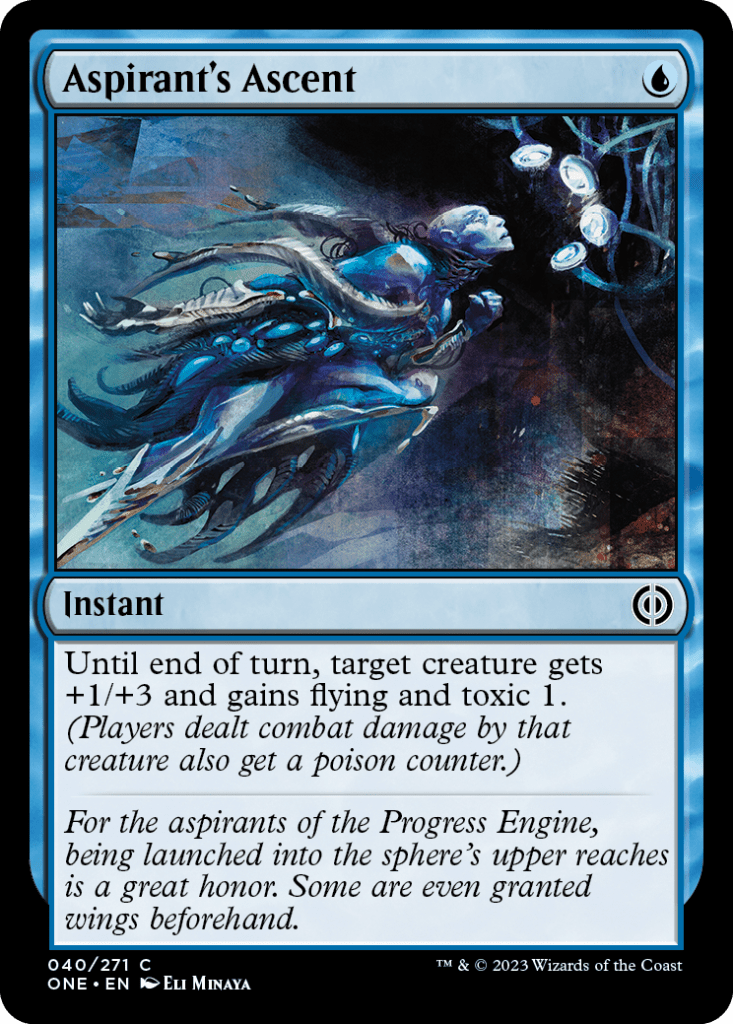
Rating: 2/10
Cheap combat tricks like Aspirant's Ascent are usually fine, but blue normally doesn’t care about them. Blue decks can normally find better combat tricks from their partner colors even when they can go aggressive, and I doubt this set will be any different.
Atmosphere Surgeon

Rating: 6/10
We’ve seen previous versions of this exact card and they’ve all sucked. Except they usually cost about twice as much mana and they grant flying as a triggered ability.
This new design is much cleaner, allowing you to stock up on oil counters and then grant flying whenever you like instead of only when your trigger says so. Atmosphere Surgeon looks really good to me, and a great way to close out games by sending your biggest creatures over top of your opponent’s blockers.

Rating: 6/10
The fact that Blade of Shared Souls starts out with a creature attached and you can have that creature be any creature you control is a decent start, but sticking around and letting you upgrade every creature you draw to the best creature you have sounds pretty strong to me. Just the simple fact that you can immediately improve it to a 4/4 if you have a 4/4 creature in play and you draw a 2/2.
This is close to bomb rare level, but the thing holding it back is that you can only copy your own creatures. You can’t guarantee they’ll be good enough when you’re falling behind. But it does look good other than that.
Blue Sun’s Twilight

Rating: 10/10
Mind Control spells are incredibly powerful in Limited. Not only do they basically kill an opposing creature but they give you one too, making them an easy two-for-one.
Blue Sun's Twilight goes one step further by giving you a three-for-one if you can cast it for enough mana. That’s absolutely absurd. It’s a tad on the expensive side, but the payoff is absolutely game breaking.
Bring the Ending
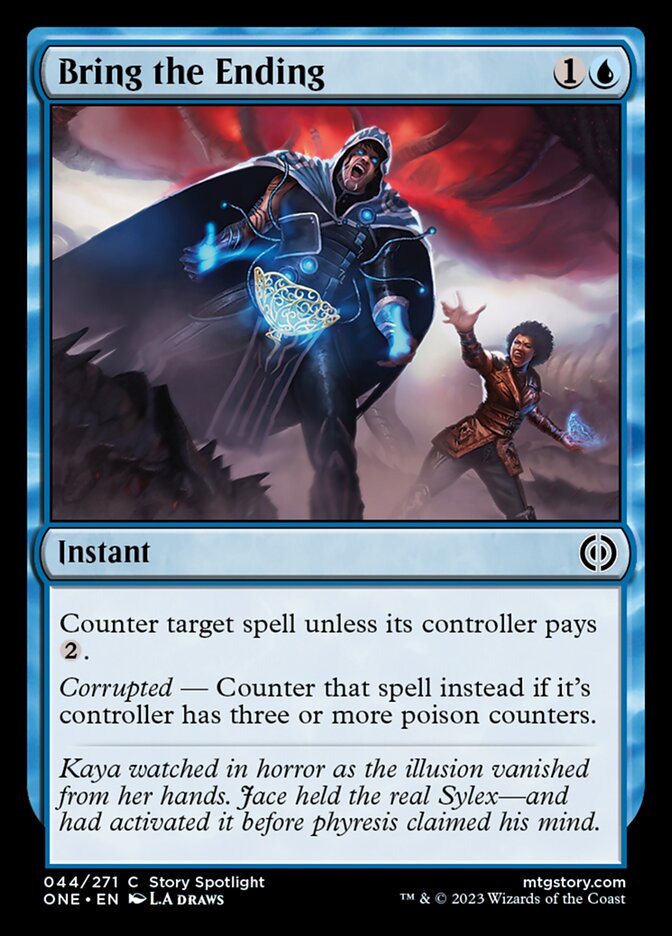
Rating: 5/10
The problem with Quench is that it’s only reliable in the early game. Your opponent can usually just pay the extra two mana later on. This version is so much better.
Assuming you can typically get to three poison counters with your deck, Bring the Ending might just be a straight-up hard counter at most points in the game, if not all.
Chrome Prowler
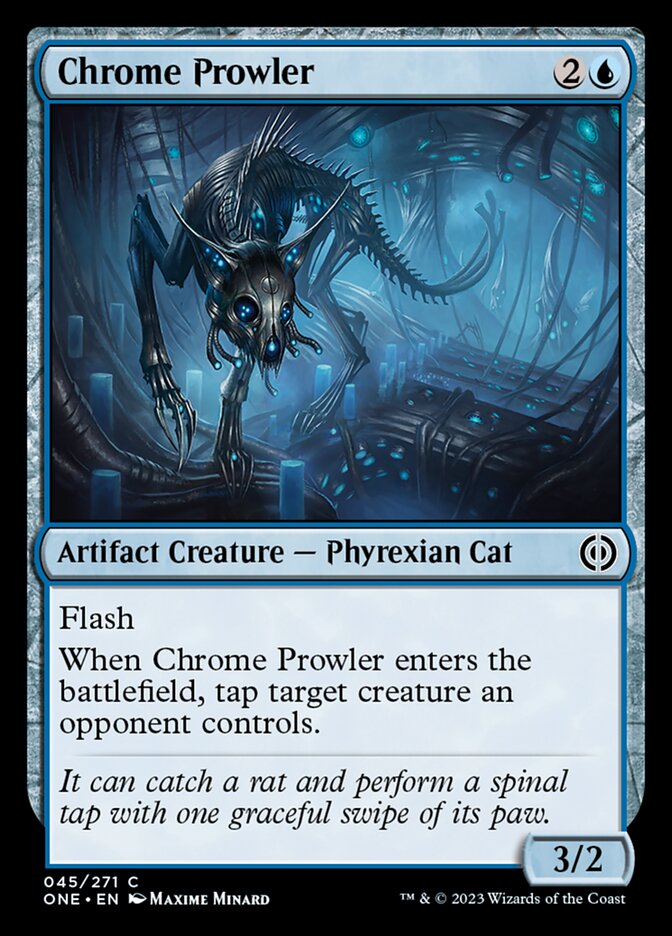
Rating: 4/10
Chrome Prowler’s stats aren’t too bad, and flash alongside its trigger make this a pretty versatile card with a few different applications.
Distorted Curiosity
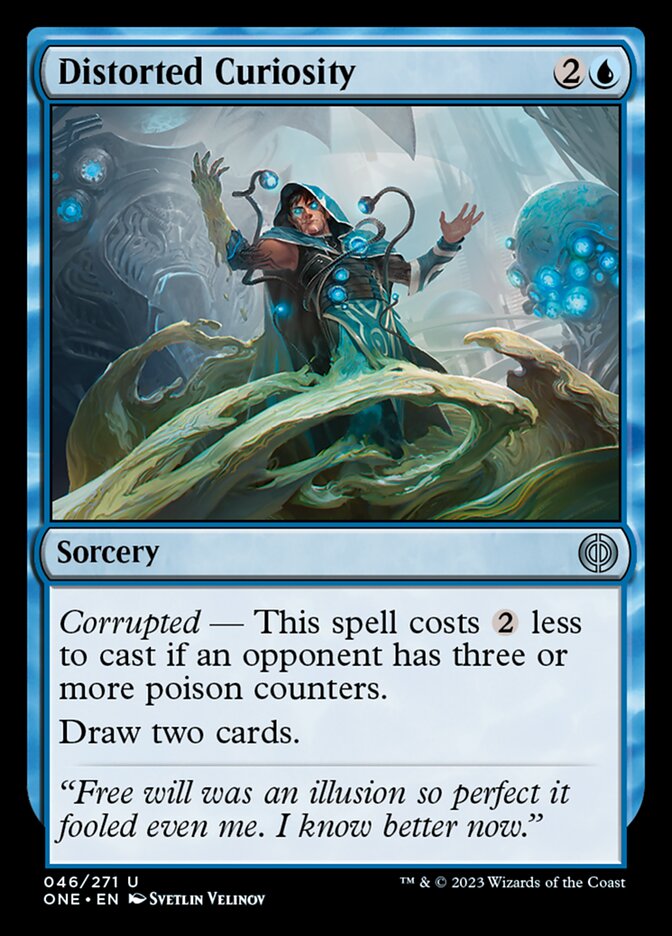
Rating: 5/10
Divination is a fine card, and having it cost one mana is of course ridiculous. I don’t think Distorted Curiosity’s corrupted should be that hard to make work, but I’m sure plenty of decks would be happy with just plain Divination even if it is.
Encroaching Mycosynth
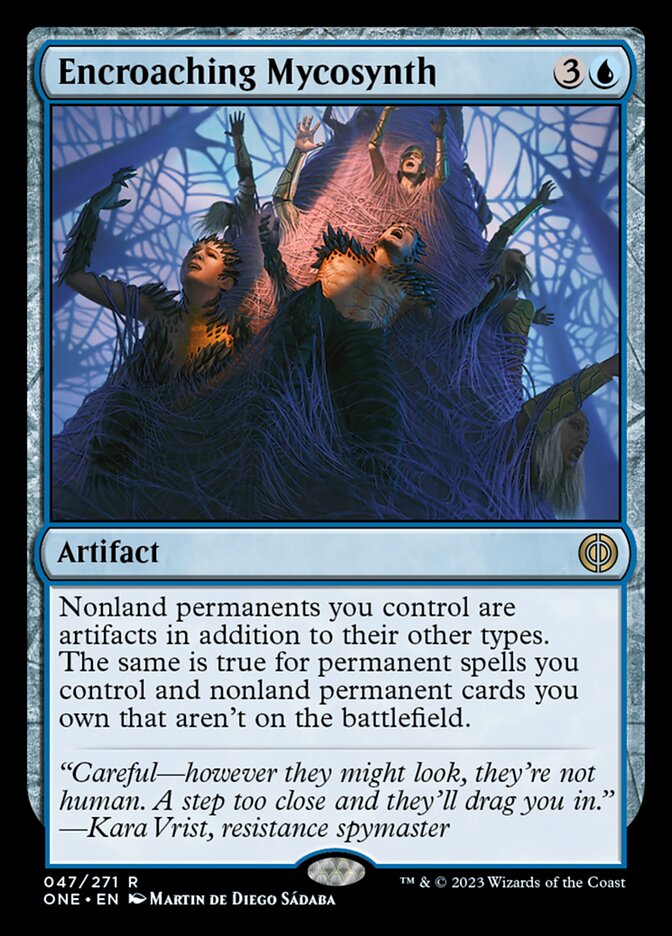
Rating: 0/10
Encroaching Mycosynth is pretty easy to review. It’s a constructed/Commander plant and nothing more. Leave it in the sideboard and put it in your sweet artifact Commander decks.
Escaped Experiment
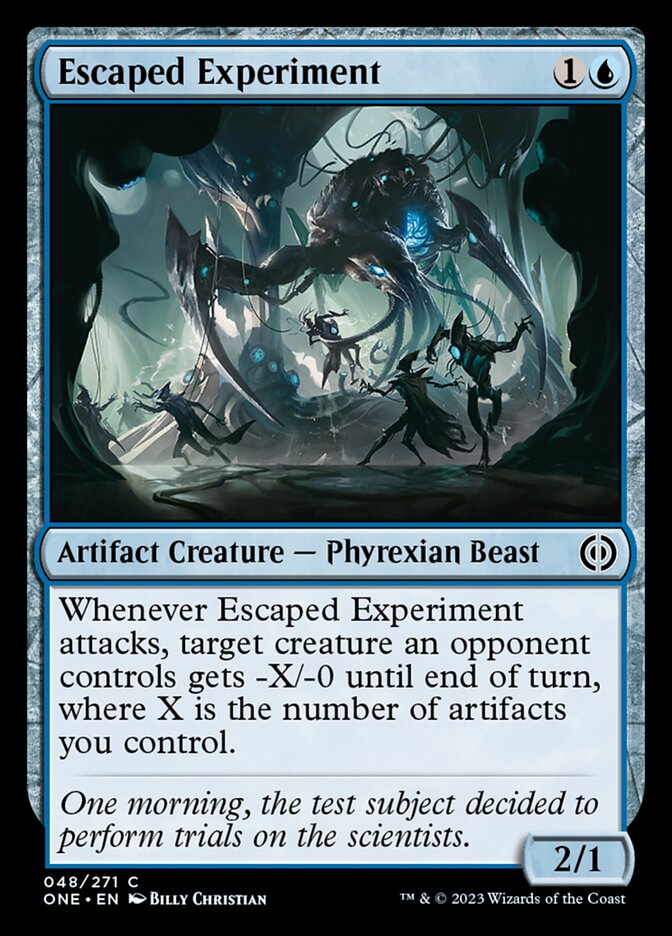
Rating: 2/10
Escaped Experiment is a 2-drop, but not one that’s particularly threatening. Your opponent doesn’t care too much to let this hit them once or twice and it’s very easy to block, even with the power reduction ability.
You can use this to help your other creatures attack freely to some extent, but it’s so difficult to have this survive the combat that it might end up being more of a liability.
Experimental Augury
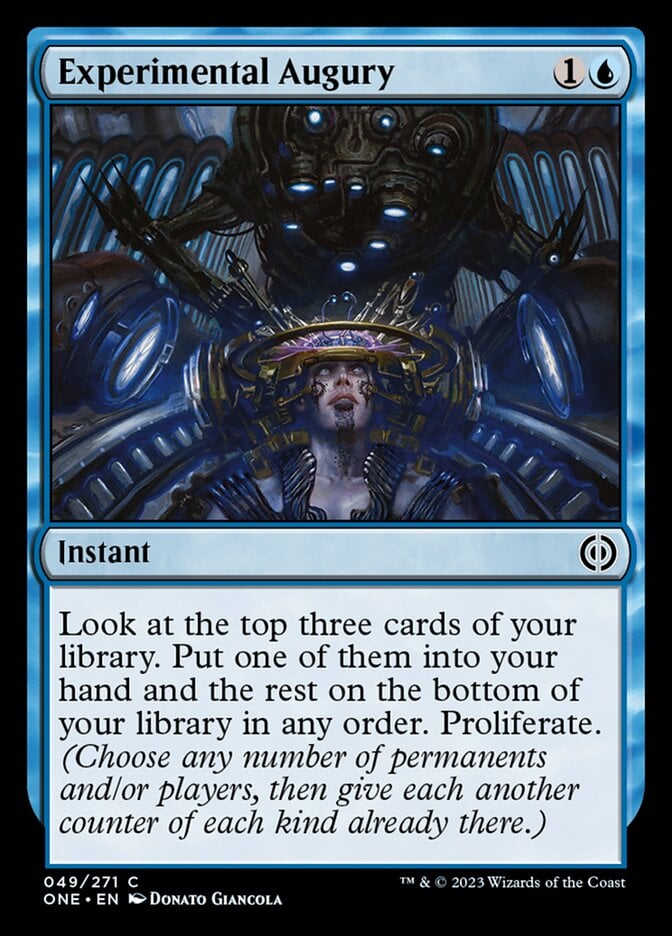
Rating: 4/10
We’ve seen a lot of cheap draw spells like Experimental Augurythat have looked kind of unnecessary but have actually performed well in the spell-centric archetypes in recent sets. This Anticipate plus proliferate spell should be exactly what that deck wants given that this set has that archetype and also focuses on oil counters.
Eye of Malcator
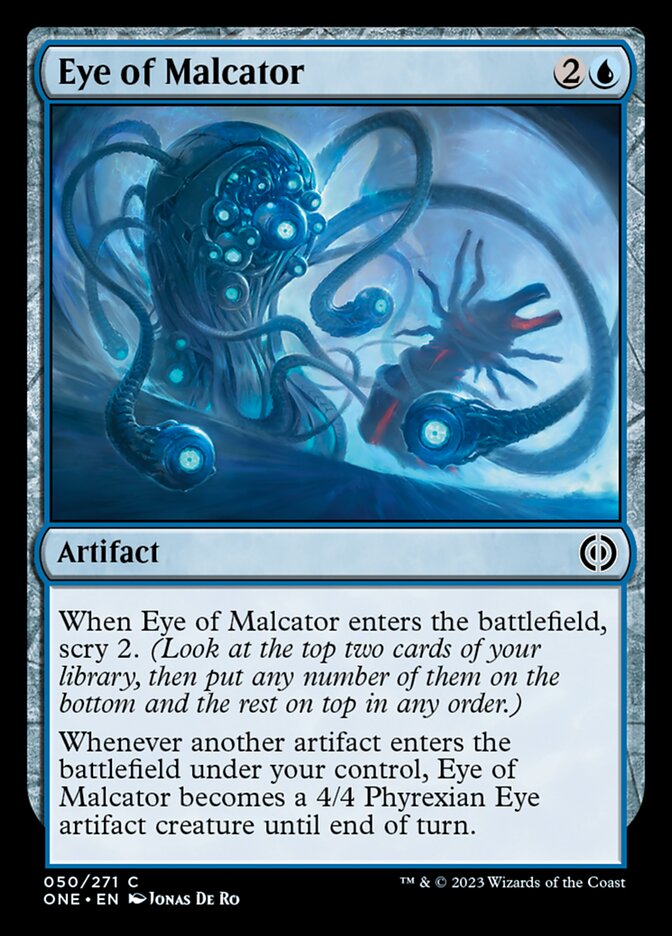
Rating: 6/10
Eye of Malcator will often look an awful lot like a 4/4 for three with no downsides if you’re going for this artifact-themed deck. Spotting you a scry 2 up front will even help you accomplish that the following turn.
You need a lot of artifacts in your deck for this to work, because you’ll have wasted a card and potentially lost the game because of it if this sits there turn after turn not being able to attack.
Font of Progress
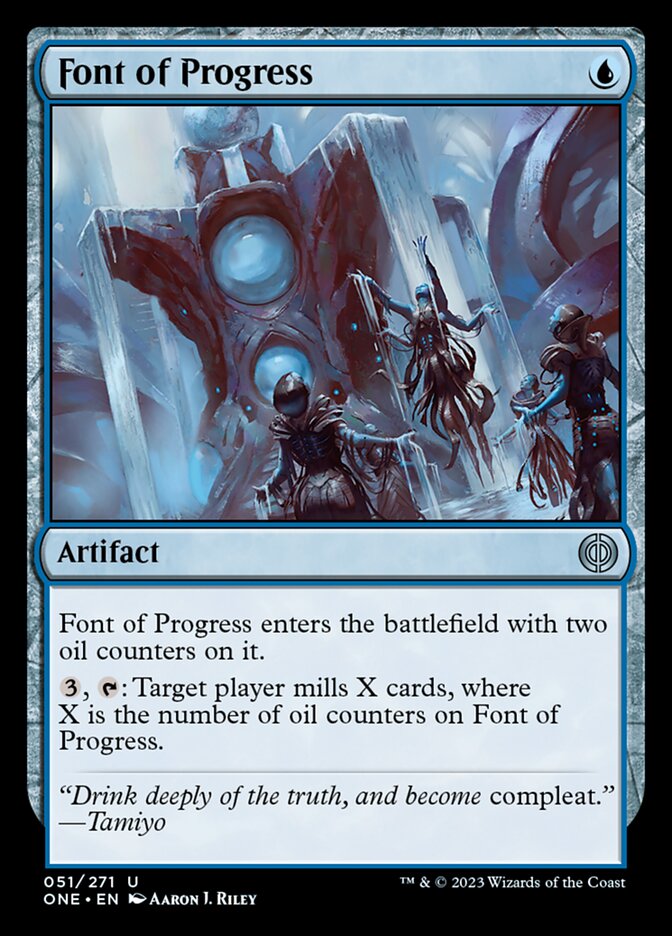
Rating: 2/10
While I love mill cards in general (I have a Bruvac, the Grandiloquent Commander deck, after all), I don’t think Font of Progress does it for me. It’s a bad version of Millstone on its own.
You have to be adding more oil counters in some other way for this to become a reasonable card. This could be a consideration if you had a lot of ways to do that, but it’s still very slow and doesn’t do anything until you get it going.
It could be a great sideboard option against very slow decks, so bear that in mind.
Gitaxian Anatomist
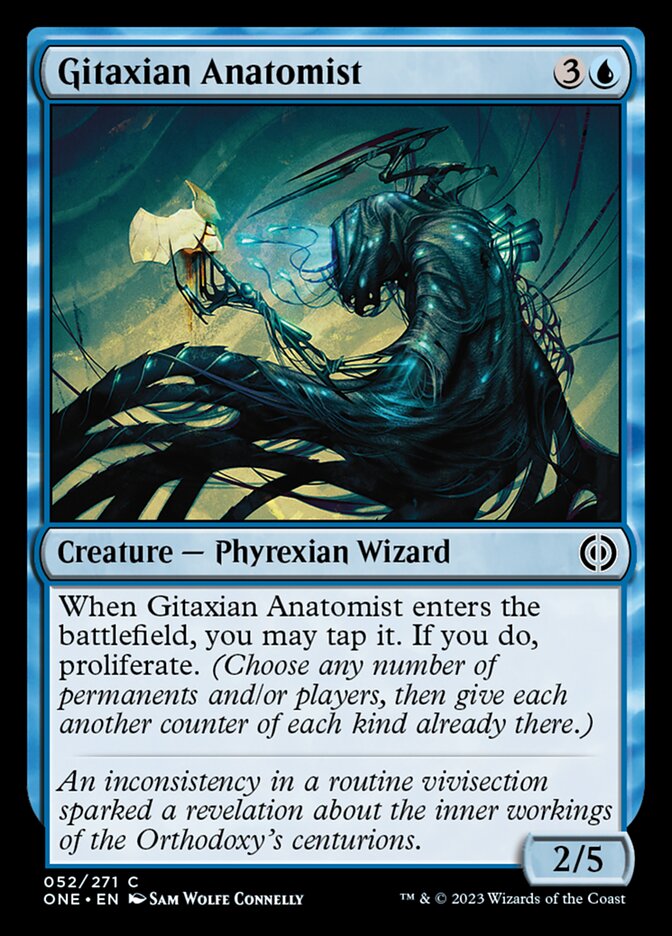
Rating: 1/10
A 2/5 for four mana just isn’t good enough in most formats, and Gitaxian Anatomist’s very mediocre triggered ability doesn’t do anything to make up for that.
Gitaxian Raptor

Rating: 3/10
Gitaxian Raptor would be incredible if it could grow itself for mana. Mistwalker did a lot of good work back in Kaldheim, but it could grow indefinitely and was a shapeshifter. Take away those advantages and I don’t think the result looks too promising.
Glistener Seer
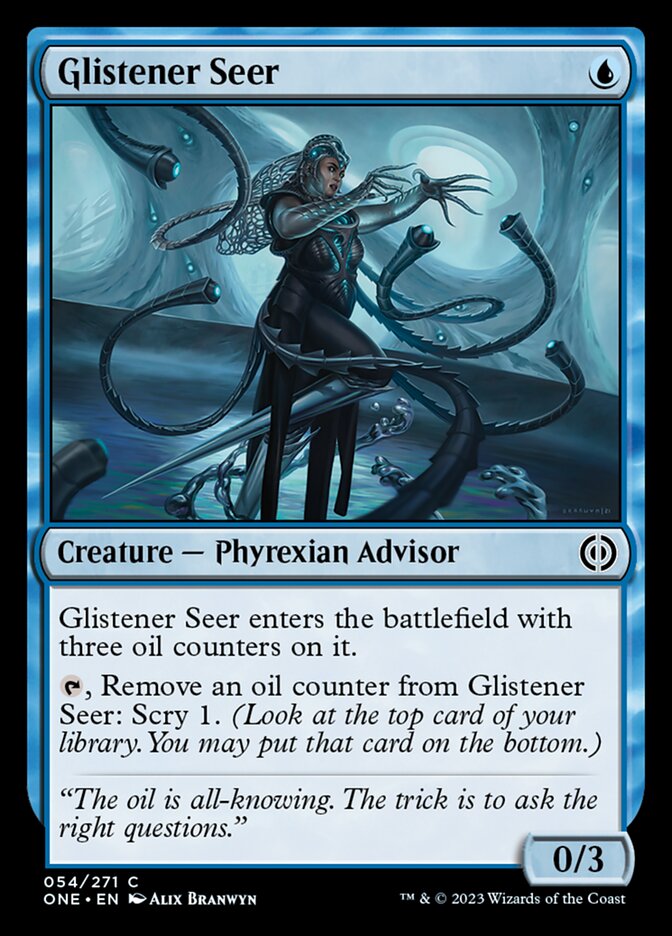
Rating: 2/10
Having a 0/3 for one might actually be desirable if this set is really aggressive. But even then Glistener Seer isn’t very impactful and is likely only a borderline playable at best.
Ichor Synthesizer
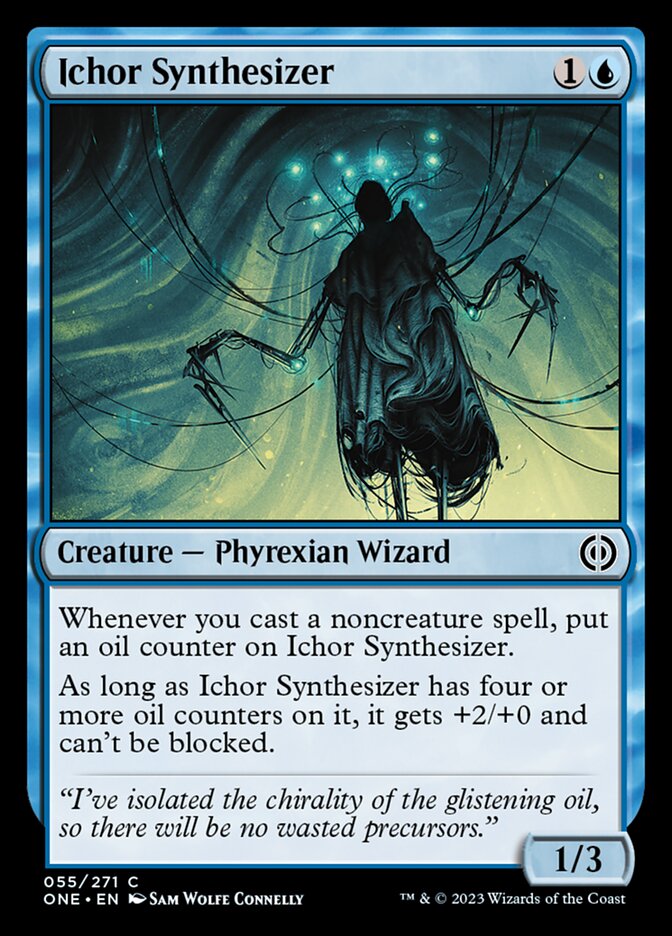
Rating: 3/10
I really don’t like that Ichor Synthesizer does absolutely nothing until it gets up to the fourth oil counter. That could really hold it back from being playable, even though you can get there faster with proliferation and the like.
An unblockable 3/3 is a pretty big reward if you can do it reliably, so it’s worth at least giving it a try.
Ichormoon Gauntlet

Rating: 0/10
Given that Ichormoon Gauntlet is a mythic rare, it’s surely not too much to ask that it just proliferate whenever you cast a spell rather than only proliferating one target. The planeswalker text is really cool, but not something you’re interested in for Limited.
The odds of getting both together is extremely low, even with a bunch of rare planeswalkers. But an artifact that just spots a single counter every time you cast a spell isn’t worth spending a whole card on when you take that out of the equation.
Jace, the Perfected Mind
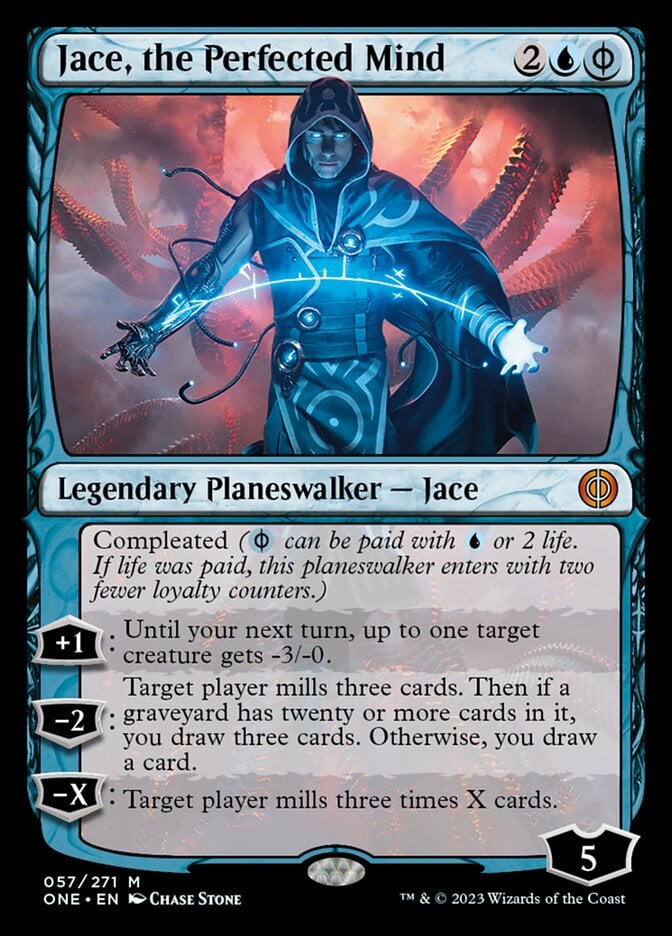
Rating: 8/10
Evil Jace hits the ground running pretty effectively. Casting Jace, the Perfected Mind on three mana sounds very appealing since -3/-0 should pretty much neutralize your opponent’s 2-drop and keep their aggression in check.
I wouldn’t put much stock in his mill abilities, but you’ll only need about eight or nine loyalty to one-shot your opponent with Jace’s -X if you cast it on four mana and immediately +1 it. Given that, Jace becomes a very powerful threat that stops creatures from threatening both you and itself while threatening an auto win when its loyalty gets high enough, which is an amazing combination of abilities.
Malcator’s Watcher

Rating: 5/10
The least Malcator's Watcher will do is block something big and draw a card. But the best it might do is trade for something and draw, maybe while getting in a couple points of damage. That’s such an annoying blowout that it probably just holds back opposing creatures while it pecks away.
Meldweb Curator
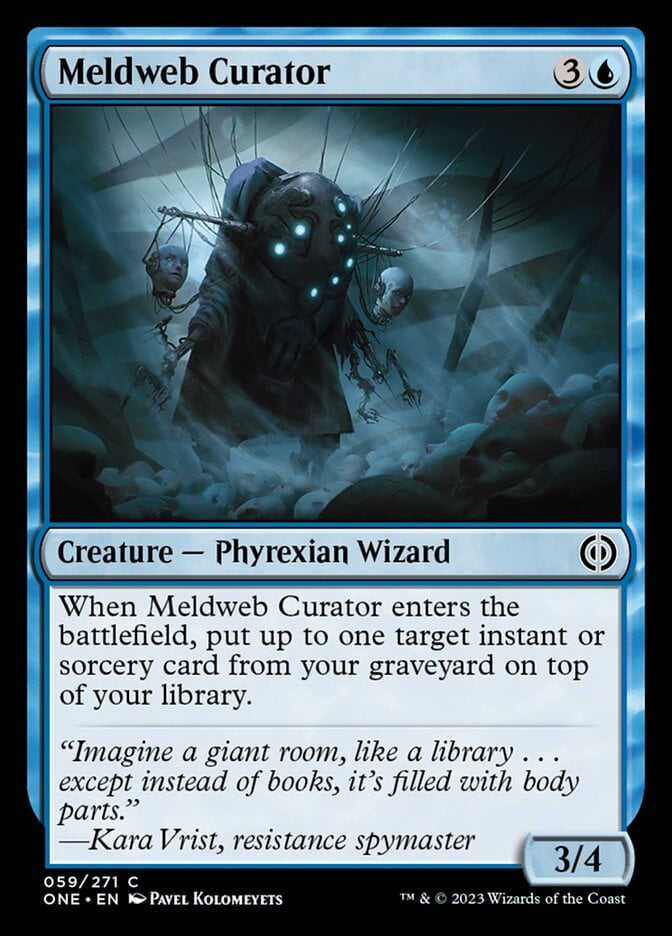
Rating: 3/10
ArchaeomancerMeldweb Curator is not. Putting a spell back on top of your deck isn’t the same as drawing it. Whatever you get back has to be worth basically skipping your next draw step to get back.
And even then this creature isn’t quite big enough to make much of an impact otherwise by itself.
Meldweb Strider
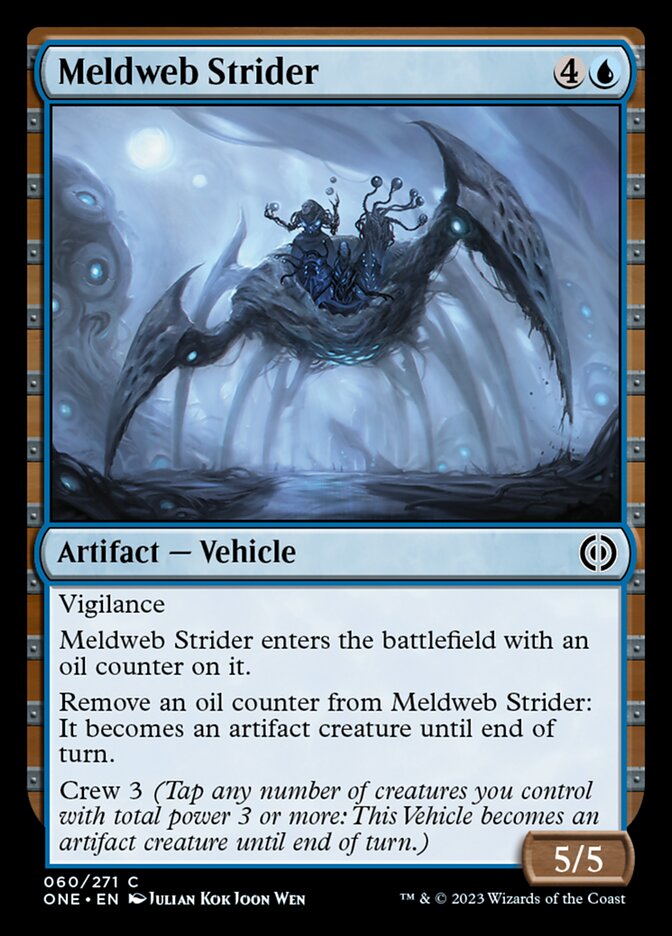
Rating: 4/10
Meldweb Strider doesn’t seem too bad if you can proliferate more counters onto it. At least it has the failsafe of you being able to crew it sometimes and a 5/5 vigilance is big enough that it should work nicely on both offense and defense.
Mercurial Spelldancer

Rating: 9/10
Honestly, a 2-mana 2/1 that can’t be blocked is already pretty obscene, let alone whatever the other wall of text does. Turns out Mercurial Spelldancer’s wall of text is also pretty decent because getting free copies of spells every now and again is something I’m always interested in if I’m getting it on a card that’s doing something else.
Mesmerizing Dose
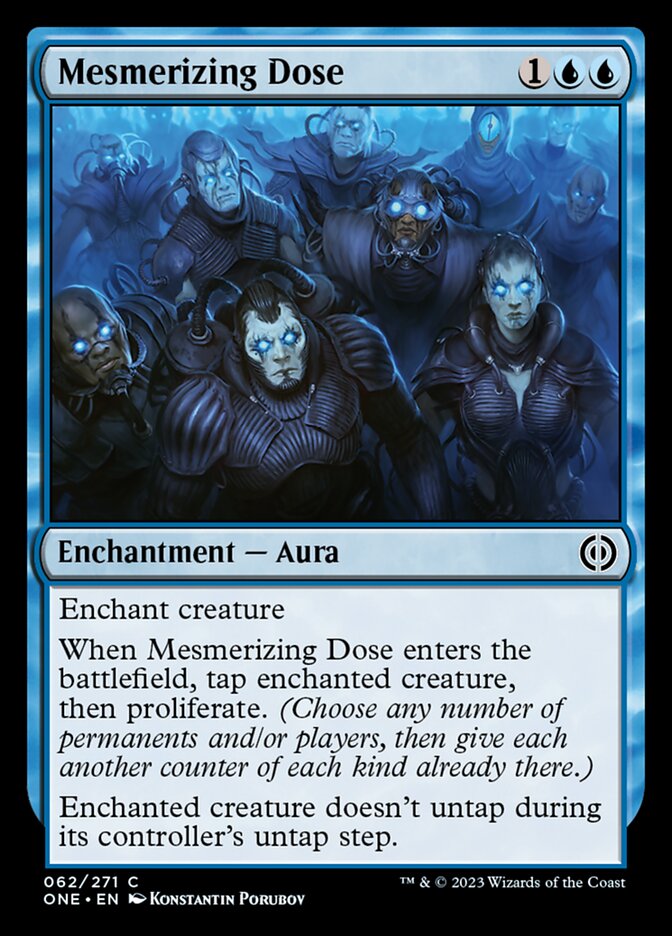
Rating: 5/10
Claustrophobia used to be the gold standard for blue removal, but times have changed and it’s started to look a little dated. Tacking on a free proliferate is just the kind of advantage that could make it strong again, so I’d expect Mesmerizing Dose to be your go-to removal spell for blue decks.
Mindsplice Apparatus
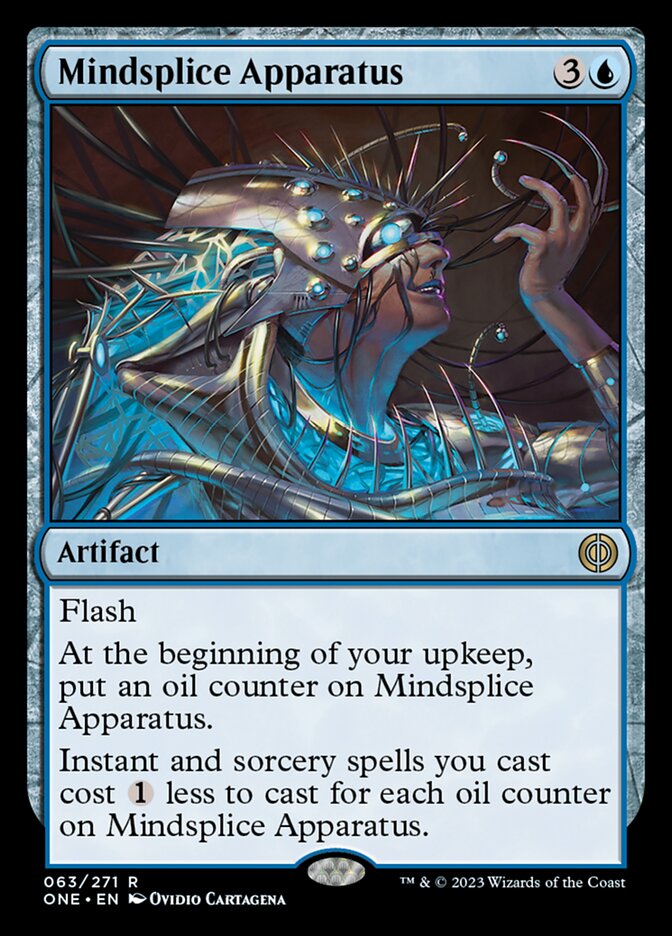
Rating: 1/10
Spending a whole card just to make future spells cost less isn’t an effect you care about in Limited. There might be some deck that can really use Mindsplice Apparatus especially since it also synergizes with oil counters, but the majority of decks should just stay clear.
Minor Misstep
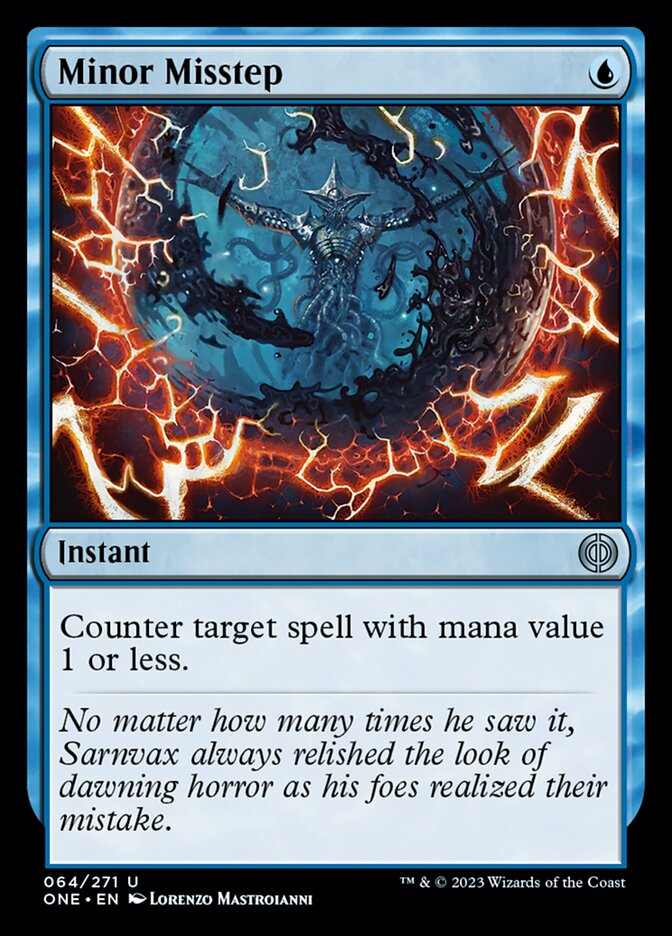
Rating: 0/10
Mental Misstep didn’t take long to become the most egregious mistake that was made by New Phyrexia. It was so powerful that it ended up banned in every eternal format within just a few months of being printed.
But none of that made it anywhere close to playable in Limited, and Minor Misstep doesn’t fare any better. There just aren’t enough targets for such a limited-use counterspell.
Prologue to Phyresis
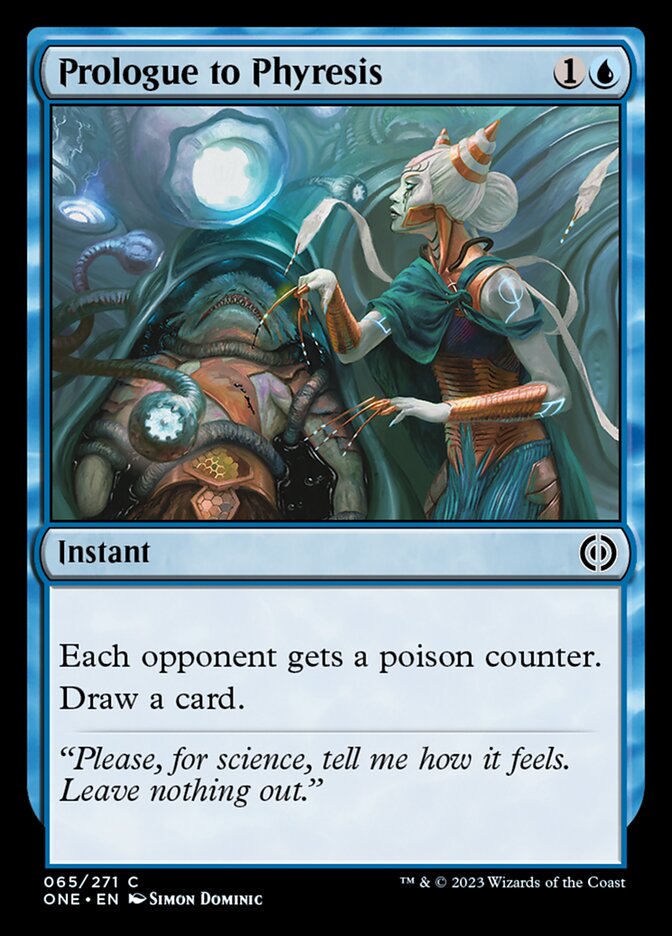
Rating: 4/10
Well, Prologue to Phyresis is at least a guaranteed way to get a poison counter. It might be quite difficult to get up to the three poison counters with just combat, so this gives you a guaranteed poison and another card just in case.
This sounds like a great way to get the first poison counter down so that you can proliferate further ones, particularly in the blue/black proliferate deck. It looks good for a variety of decks and I’m interested to see where it lands.
Quicksilver Fisher
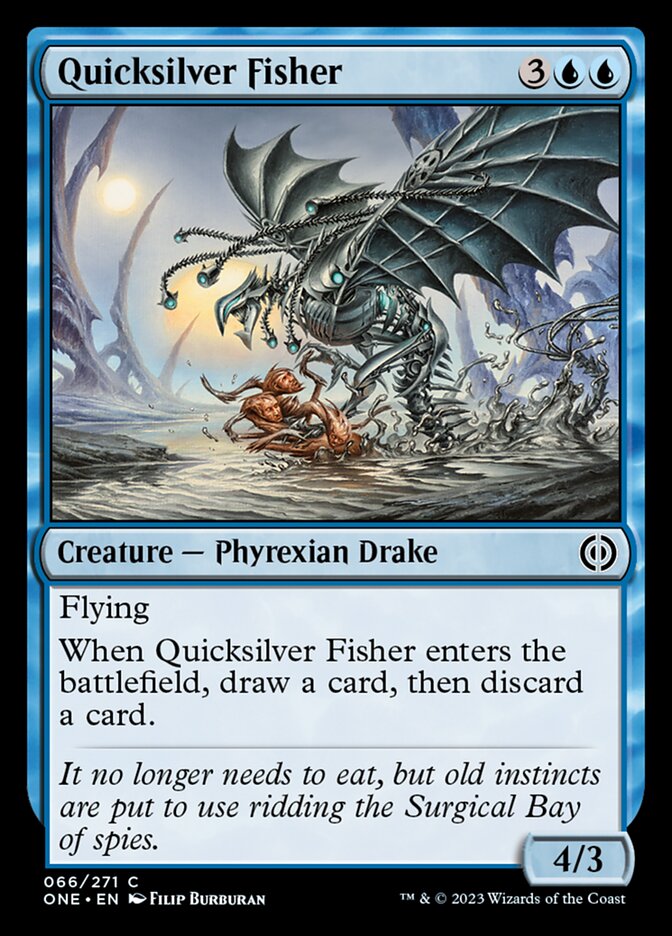
Rating: 6/10
Fun fact for you: Quicksilver Fisher is Magic’s first ever 4-power common flying creature for just five mana. It baffles me that this isn't uncommon because it certainly has the power level for it.
There have been recent formats where Air Elemental was one of the best blue non rares, and I imagine this will be very strong here. Sure that fourth point of toughness makes a big difference, but I think that’s a fair trade for a great loot ability on entering the battlefield.
Reject Imperfection
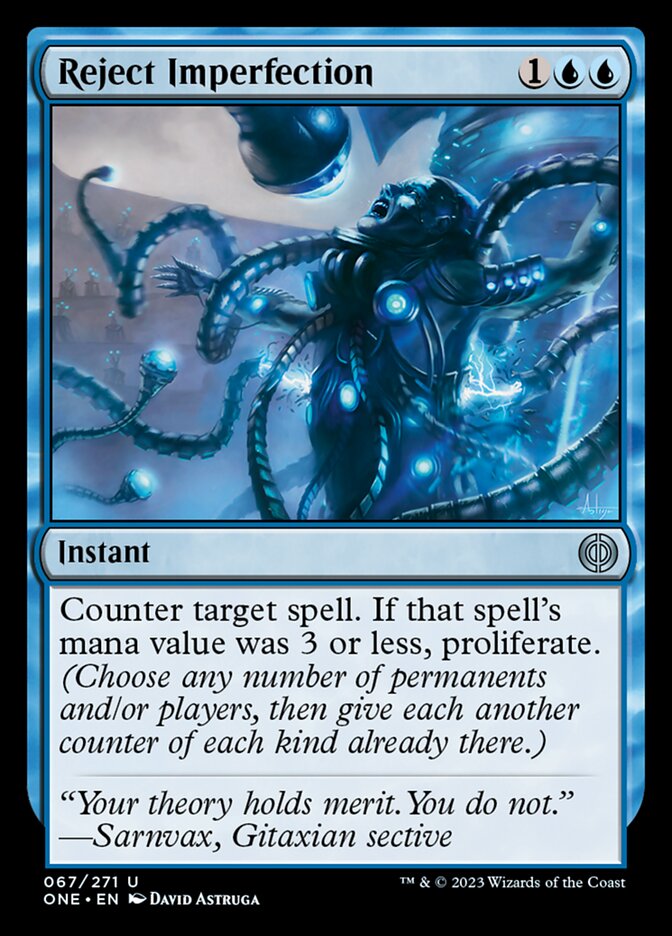
Rating: 2/10
While I appreciate having a conditional proliferate tacked onto Reject Imperfection, it’s still just a Cancel. Either the format is too fast for it to exist, or slow enough that it’s fine.
We’ve also seen a much better counterspell in Bring the Ending, so I doubt this will see much play.
Serum Snare
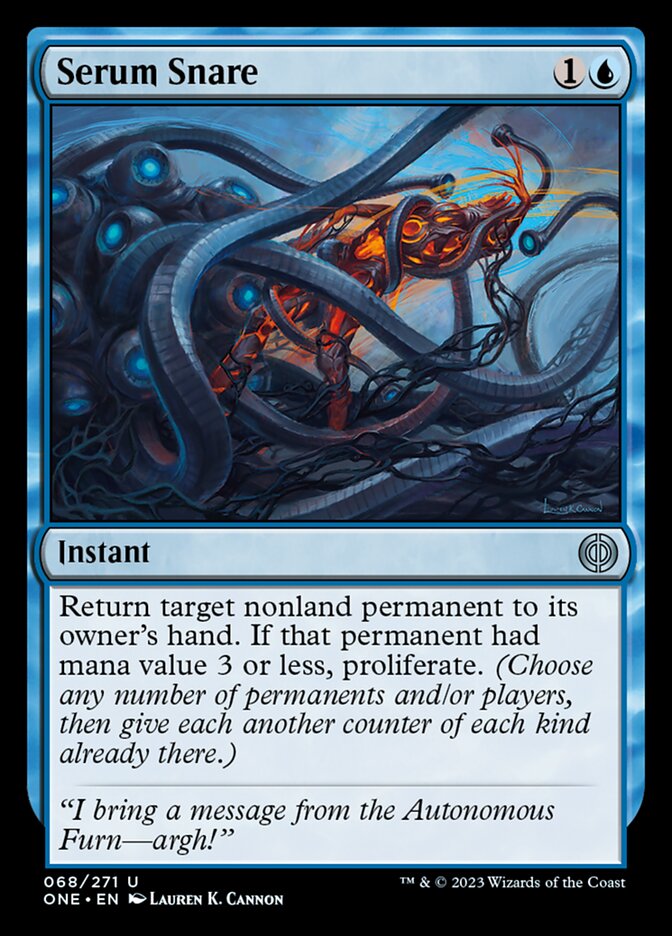
Rating: 3/10
I always love knowing where my bounce spells are in Limited, but Serum Snare doesn’t inspire me with much confidence. The proliferate bonus is definitely nice, but this is ultimately just Disperse most of the time, which is a card some decks definitely like having access to but don’t always need.
Tamiyo’s Immobilizer

Rating: 6/10
Tamiyo's Immobilizer might be quite far away from being Icy Manipulator, but it’s still pretty strong at letting you keep your opponents’ best creatures tapped down instead of attacking you. Not only can you proliferate a bunch more counters onto it to keep it going for longer, but there are also plenty of ways to add oil counters that you can incidentally stack on when you need them.
Tamiyo’s Logbook
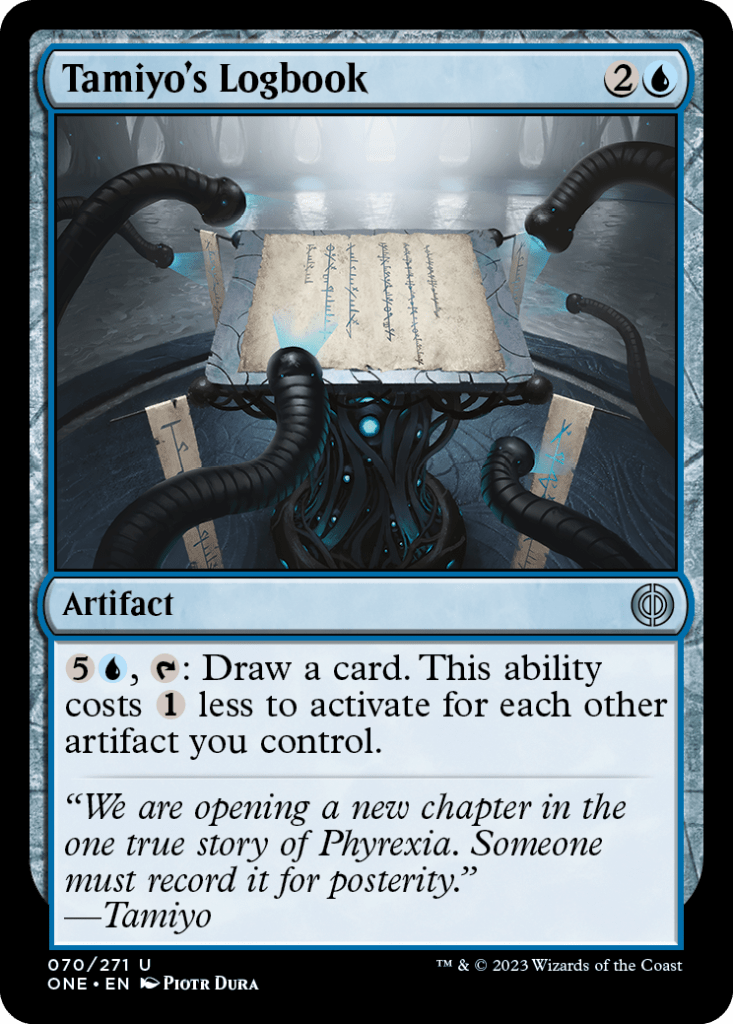
Rating: 3/10
I don’t think I’d have put much stock into Tamiyo's Logbook if it weren’t for Jodah's Codex in Dominaria United. The card wasn’t game breaking, just a nice addition for some of the domain decks.
I’d imagine that this will be a pretty decent payoff if you can build around Logbook and have plenty of artifacts in play to reduce its cost. You just need to make sure your deck can fully support it.
Tekuthal, Inquiry Dominus

Rating: 8/10
Tekuthal, Inquiry Dominus looks like a very interesting bomb. It’s big enough that you’re going to play it no matter what deck you are, but every now and again you’ll get some great extra value from being able to double up on your proliferates.
This should be very easy to make it indestructible in the right deck, so I think Tekuthal balances out where you’re very happy with it in any blue deck, but it’ll be an insane bomb in some.
Thrummingbird
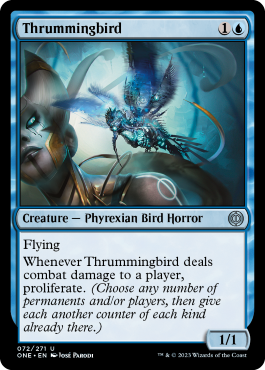
Rating: 5/10
Yes, a classic reprint that I remember playing with in Scars of Mirrodin. Great at enabling poison, oil, and just randomly proliferating to trigger your abilities that care about it.
Thrummingbird is solid and does the job but can be outclassed by nearly any flying creature, so that’s something to bear in mind.
Transplant Theorist
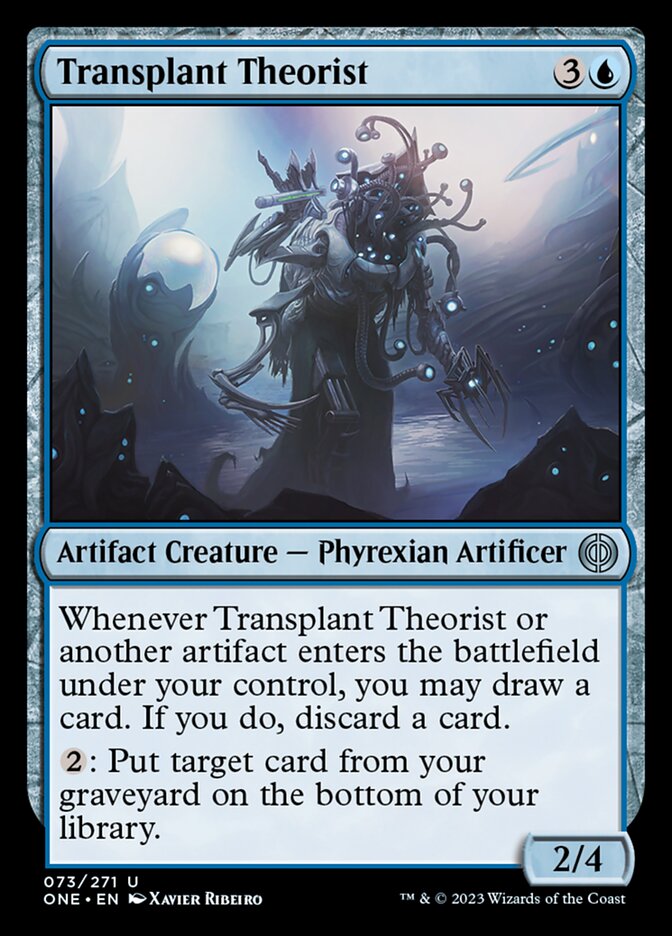
Rating: 6/10
Getting to loot every time an artifact enters the battlefield is a really nice payoff. While Transplant Theorist itself is a little on the small side, the looting easily makes up for it.
You probably won’t be using the activated ability much, but I love that it’s there for those just-in-case moments.
Trawler Drake

Rating: 4/10
Trawler Drake is the card that’s supposed to pay you off for being in the “spells matter” deck, except it really sucks to draw it late after you’ve cast all your spells. Cards like this usually need to be more like Crackling Drake so that they’re still good when you draw them later on.
One upside is that it uses oil counters, so it can just grow whenever you proliferate or use something that adds those counters. This means it’s far less likely to be useless later in the game.
And of course it must be killed immediately or the game is likely just over when you draw it and cast on turn 3.
Unctus, Grand Metatect

Rating: 6/10
It appears that the fan favorite Grand Architect has been Phyrexian-ized and given a name. Unctus, Grand Metatect does quite a lot for just a 3-drop. Even if your creatures are mostly nonblue or nonartifacts, you can turn them into blue artifacts pretty cheaply and allow them to reap the benefits that Unctus is offering.
+1/+1 and looting when this attacks is a nice deal, and something you’re likely happy to spend a little extra mana doing.
Unctus’s Retrofitter
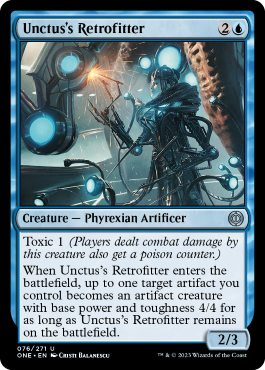
Rating: 7/10
Skilled Animator was one hell of a card. Making the artifact creature a little weaker while making the main body a little bigger absolutely does not change that.
There are quite a few cheap artifacts that you can turn into creatures with Unctus's Retrofitter and you could always just grow something that’s already a creature, like a mite token or something similar.
Vivisurgeon’s Insight
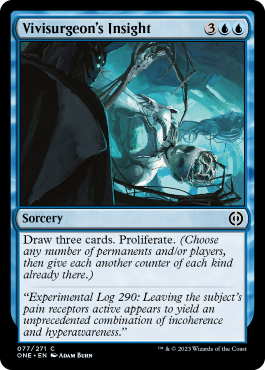
Rating: 3/10
I’ll be very happy if Vivisurgeon's Insight is good in the format. Five mana to just draw three cards is a bit too expensive in a world where decks can pressure you turn after turn and tack on a free proliferate doesn’t change that enough.
But this can be very effective at restocking your hand while advancing your gameplan a little if you’re not under so much pressure all the time because the format turns out it’s on the slow side.
Watchful Blisterzoa

Rating: 4/10
I’m sure we can all look at Watchful Blisterzoa and imagine scenarios where it dies and you draw a whole handful of cards. I don’t think that’s likely to happen all that often. It’s not guaranteed to die even if you can stack a bunch of counters on it.
It could just as easily be exiled, bounced, or locked down under a Pacifism of some kind. Djinn of the Fountain seemed to show us just how 6-mana 4/4 fliers are no longer good enough to stand by themselves, so I’m careful to not rate this too highly.
Ultimately the key is not to value the draw ability too highly. If you can trade this off for a Quicksilver Fisher and draw one card then that’s still a pretty good deal.
Black Cards
Ambulatory Edifice

Rating: 6/10
I love me some two-for-ones. Even a situational one like Ambulatory Edifice is worth it from time to time. There are plenty of small creatures around for you to pick off thanks to the Phyrexian Mite tokens.
Playing this on turn 3 and killing a 1- or 2-drop for free is a nice simple way to get a quick and easy board advantage, and that makes this something you should definitely play.
Annihilating Glare
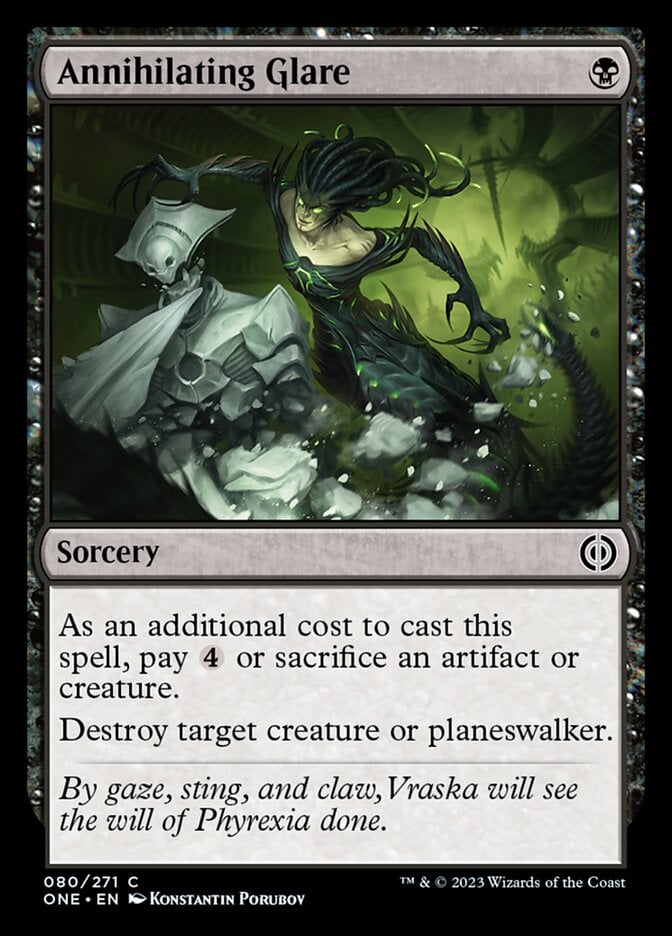
Rating: 6/10
We’ve seen this a few times before, between Spark Harvest and Eaten Alive and it’s always been excellent. Nothing much else to say really.
You need removal spells and Annihilating Glare is premium removal for any black deck while being especially good if you have free things to sacrifice.
Anoint with Affliction
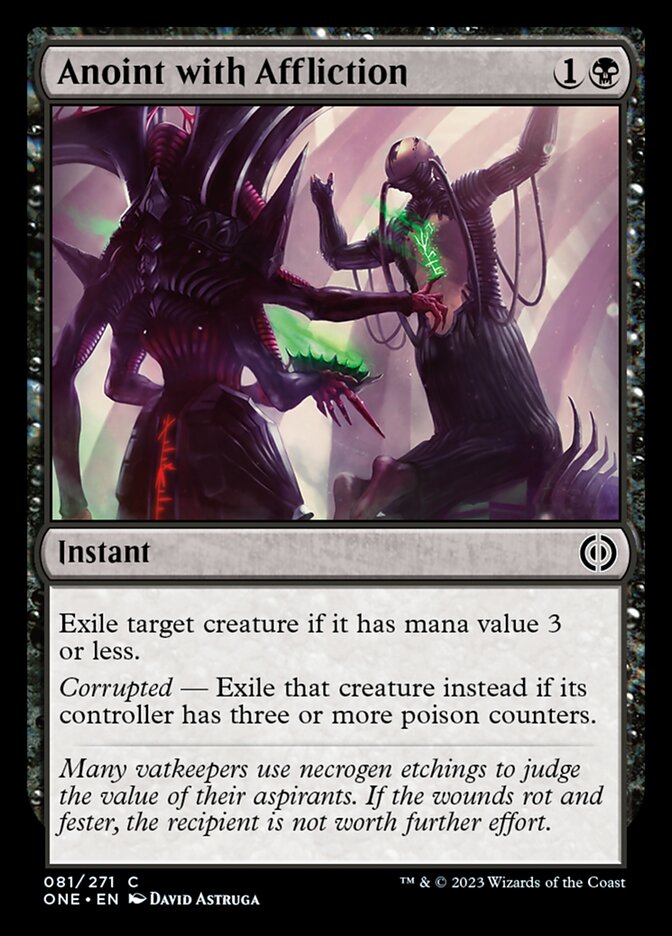
Rating: 8/10
I really hate the templating of Anoint with Affliction, but that doesn’t stop it being an exceptionally powerful removal spell. Corrupted shouldn’t be that hard to turn on, but this would be great if all it did was exile 3-drops. As it stands it’s absolutely crazy.
I keep looking at my rating and thinking, “how can a common be this high?” But it really is. It’s powerful and efficient, everything a premium removal spell should be. Draft as many as you can before everyone else has figured it out!
Archfiend of the Dross
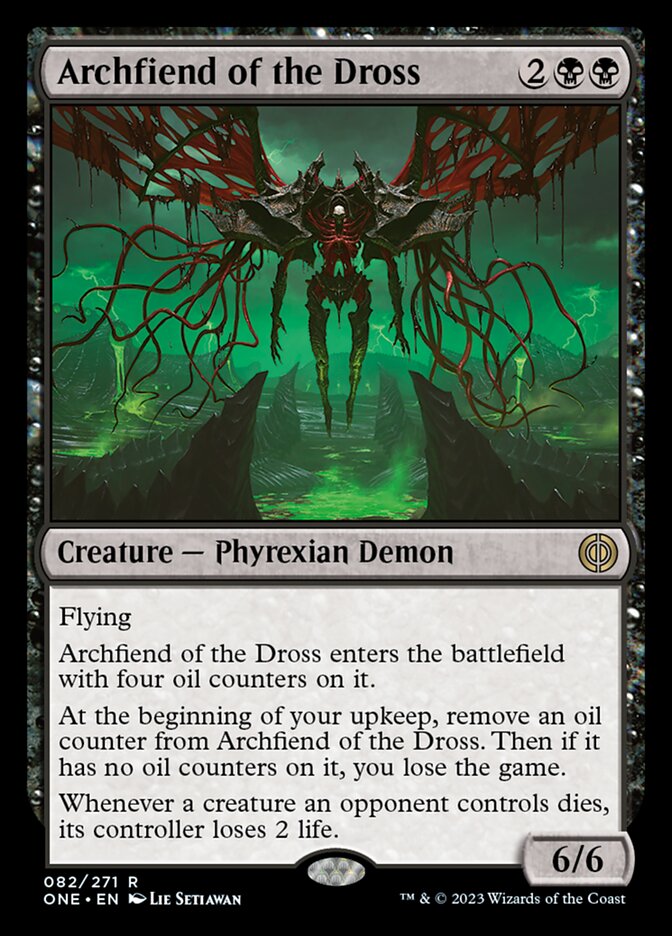
Rating: 8/10
I mean, losing the game is about as big of a downside as you can get. But it’s actually possible to never die to this thanks to proliferate and oil counter synergies.
Even without all of that, is your opponent really going to take three hits from Archfiend of the Dross? It goes and drains them so they’re still losing life in some way even if your opponent has fliers to chump block with.
This is going to be very strong in aggressive decks and is often just a must-kill threat.
Bilious Skulldweller
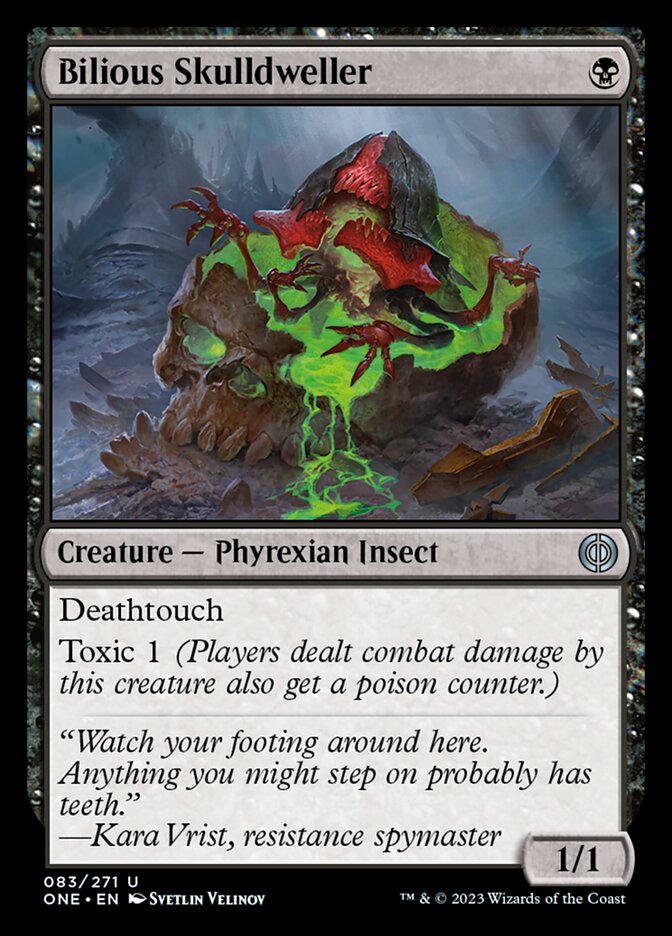
Rating: 5/10
I love me a cheap deathtouch creature. One of their inherent downsides is that there’s never any point in blocking them since you’ll only take one damage. But toxic changes the math on that.
The existence of corrupted makes the first few hits that Bilious Skulldweller can dish out very important and really encourages the opponent to block it, even if they only have a good creature to throw away to it. Plus you can always just block and trade with a big creature that they throw at you, so this looks great all ‘round.
Black Sun’s Twilight
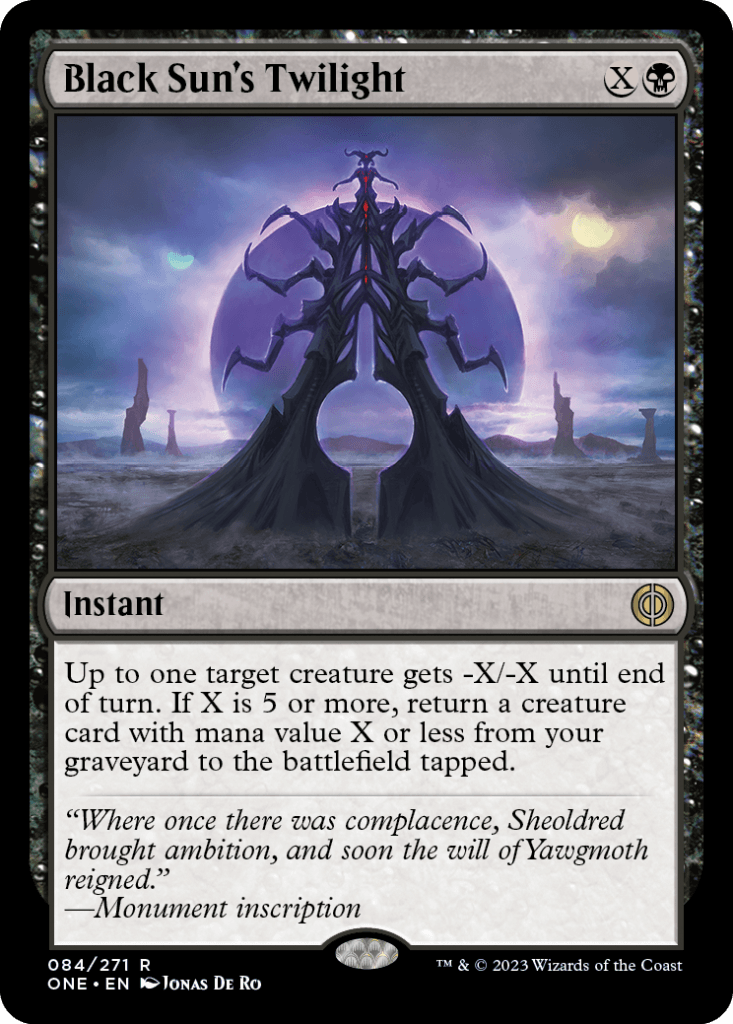
Rating: 10/10
I’ve had to read Black Sun's Twilight several times just to make sure I was getting it right. So it’s a flexible removal spell that turns into a Ravenous Chupacabra at six mana, and it’s also splashable? This has literally everything I want to see out of a card like it.
The only downside I can reasonably think of is that you might not have something available to reanimate. But surely anything you get back is good enough to make this a ridiculous bomb, so just plan your turns out and have something trade off before you’re likely to cast it.
Oh, and did I mention it’s an instant? Just a fantastic card.
Blightbelly Rat

Rating: 5/10
What’s not to love? Blightbelly Rat is a simple Walking Corpse but with two (count ‘em, two) upsides!
Not only is this a really solid 2-drop, but the combination of abilities should be really helpful in getting your corrupted spells online as quickly as possible. The proliferate ability should be useful for something even when you draw it later.
Bonepicker Skirge
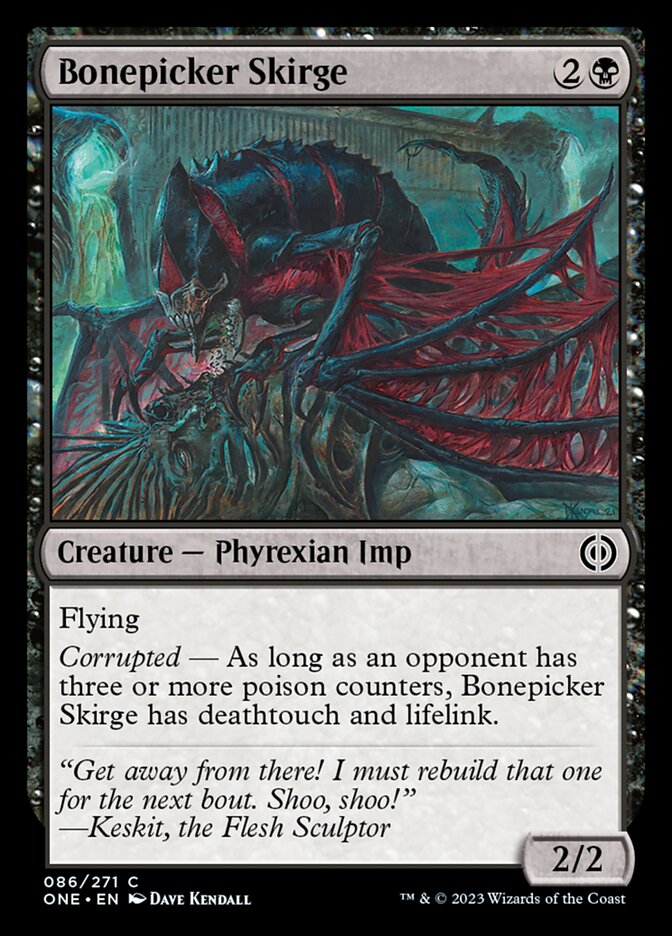
Rating: 6/10
Am I reading this right? I get a black Wind Drake with no downsides that turns into a Vampire Nighthawk if I can get corrupted active?
Bonepicker Skirge is absolutely ridiculous for a common and I am all over it.
Chittering Skitterling
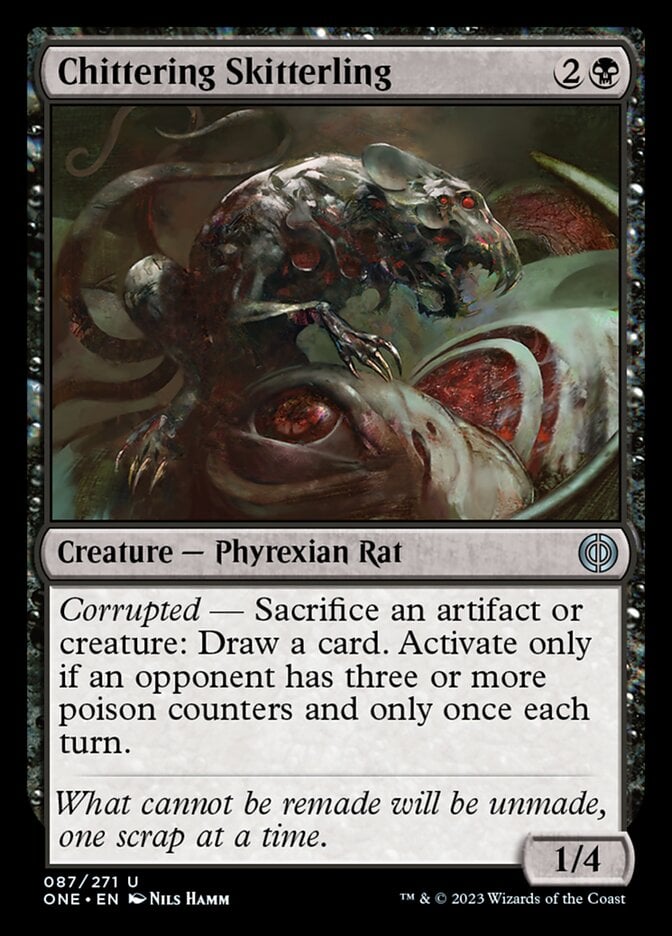
Rating: 4/10
It’s probably a little too costly that Chittering Skitterling is purely a vanilla creature until you get corrupted online, but it shouldn’t be too hard to enable. A free sac outlet that draws you cards is pretty powerful, so I can see this feeling right at home in the right deck.
Cruel Grimnarch
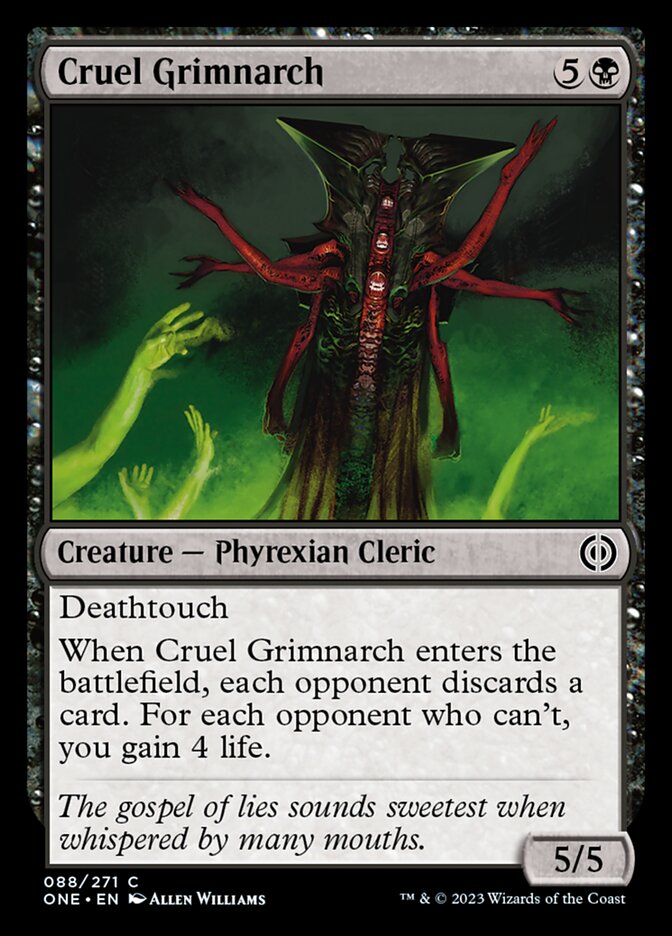
Rating: 3/10
While I like everything that Cruel Grimnarch is doing, six mana is quite a bit too much for most decks to be interested. It’s as simple as that.
It looks like a pretty strong card but I don’t think every black deck in this format will be happy playing a 6-drop.
Cutthroat Centurion
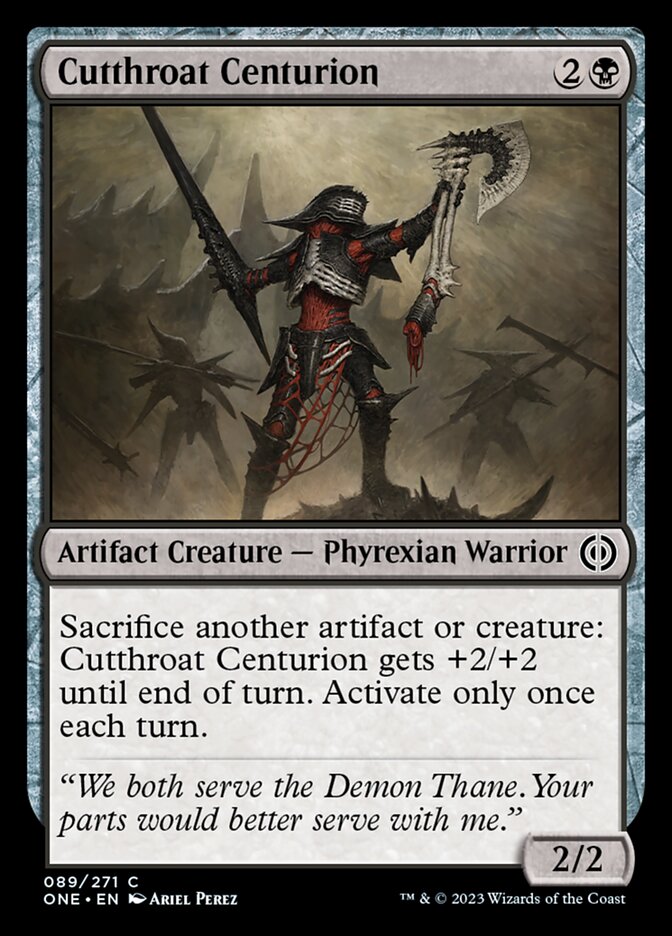
Rating: 5/10
Even if you can’t activate Cutthroat Centurian multiple times per turn it’s still a free sac outlet. Magic is a game of resources, so getting a desirable effect for free is something that you really don’t get very often.
Nantuko Husk was a very strong card and while this is quite a bit worse, it’s basically a 3-mana 4/4 that enables your sacrifice synergies. That’s a great deal for a common.
Drivnod, Carnage Dominus
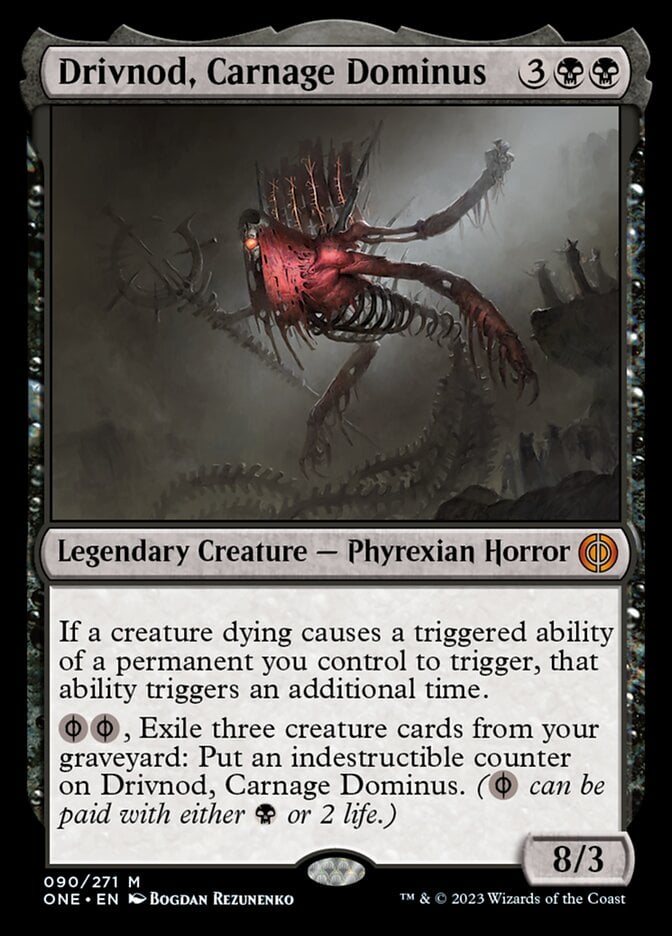
Rating: 8/10
Is that you, Yargle? The weird stat line sure looks like a Yargle.
Well, while three toughness and a huge amount of power often held Yargle, Glutton of Urborg back, the relatively cheap and easy ability to add an indestructible counter means that shouldn’t be much of a problem for Drivnod, Carnage Dominus. Doubling your death triggers is an interesting ability that’s naturally hard to build around but a bonus you can pay attention to when drafting, assuming you pick this up early.
It’s a good card for sure and doesn’t require you to try too hard to make it work.
Drown in Ichor

Rating: 7/10
What is with black’s removal spells in this set? Drown in Ichor is also a banger. Only two mana for -4/-4 and I even get a proliferate on top of that. Are you kidding me?
Oh, it’s only a sorcery, so you can’t use it as a combat trick anymore. Big deal, this is still bonkers.
Duress
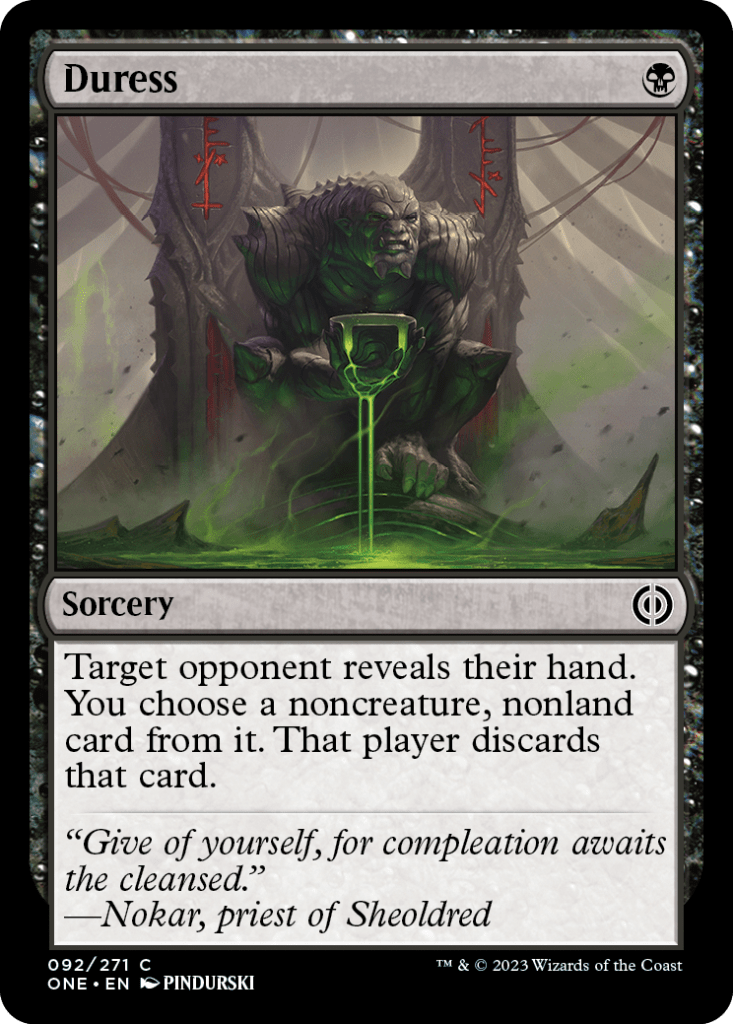
Rating: 1/10
Ah, Duress. You’re always a welcome sight for Standard, but you are not good in Limited.
While it’s a very important sideboard card in constructed, it’ll miss far too often in games of Limited. Throwing away a card for no effect is something you can’t afford to do.
Feed the Infection
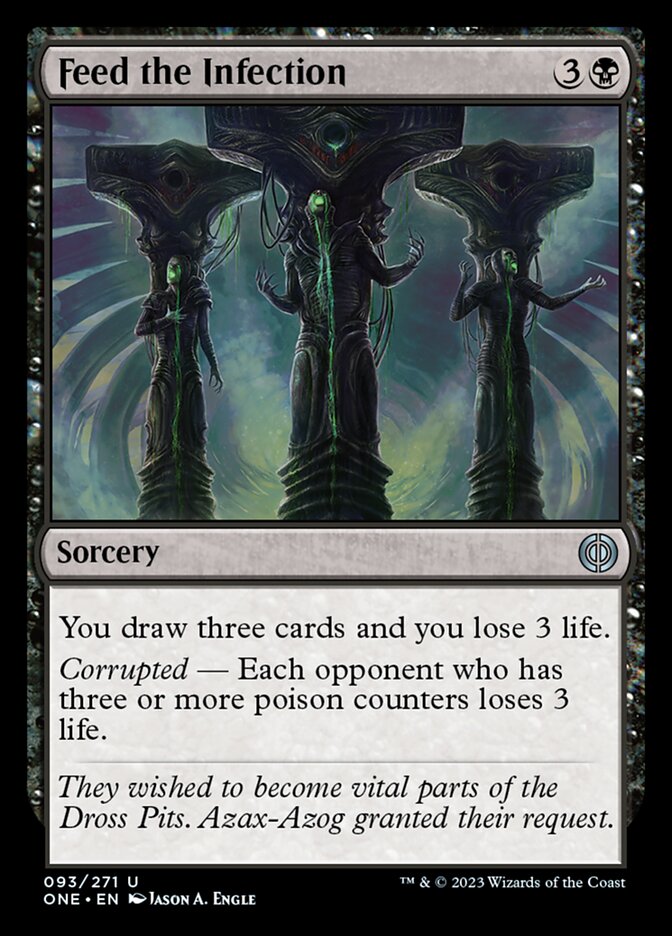
Rating: 6/10
This is a new one for me. We’ve never seen an Ambition's Cost variant make its way into a modern Draft set, but I imagine it’s pretty good.
Three cards is a lot even if you have to lose life in the process. Even better, Feed the Infection gets a hit on your opponent if you get corrupted online.
I think this is likely best in an aggro deck as a great way to find more threats after you’ve deployed your hand, but I can see it being excellent for any deck against slow matchups.
Fleshless Gladiator
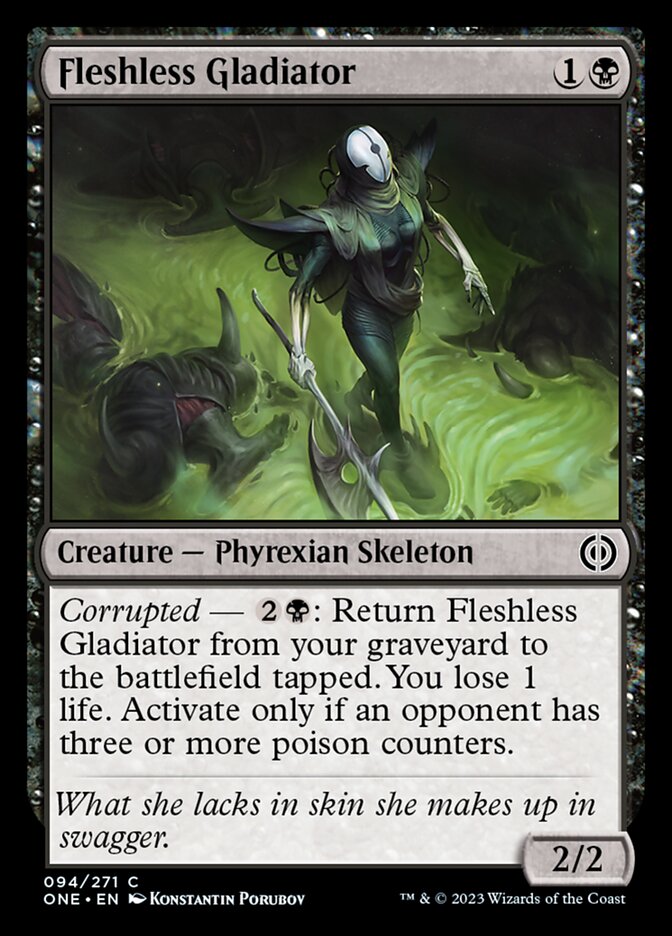
Rating: 5/10
2-mana 2/2s need to be doing a little more these days to keep our attention, so one that can keep buying itself back from the graveyard over and over again like Fleshless Gladiator is probably more than good enough .
Geth, Thane of Contracts
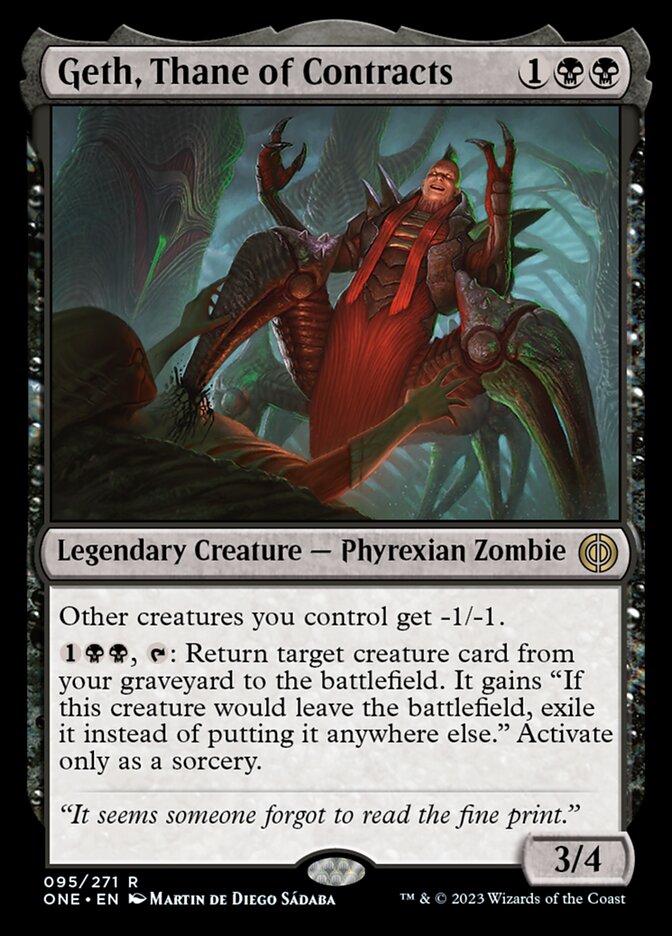
Rating: 6/10
I think Geth, Thane of Contracts will probably still be a hotly talked about card a month from now. It’s generally hard to figure out how good it ends up being overall when you combine a huge upside with a huge downside.
First of all, you just can’t put this in a deck that has a lot of 1-toughness creatures. Second, it’s probably also bad in any aggressively slanted deck since the sizes of your creatures are extremely important. But I think Geth really shines in slower midrange or control-style decks where a 3/4 for three mana does a good job of brick wall-ing an aggro deck early and provides a constant stream of free creatures to help win the late game.
I generally like to look at cards like this optimistically, but it’s very swingy and it might just fall flat. Only time will tell.
Gulping Scraptrap

Rating: 3/10
You have to really want to be proliferating to want Gulping Scraptrap. Otherwise it’s a 4/4 for five mana, which is well below what you expect to see. Getting two shots of that with your creature isn’t too bad if you really need to proliferate, but you just need to be in the dedicated deck for it.
Infectious Inquiry

Rating: 4/10
I’m not sure that we need another draw spell, but drawing two cards while basically hitting both players for two damage doesn’t sound like a bad deal to me. Just like Feed the Infection, Infectious Inquiry is most at home in aggro decks or against slower matchups and should be okay when you cast it.
Karumonix, the Rat King

Rating: 7/10
Without getting into the rat-specific text, a 3/3 with toxic 1 is already a good deal for a 3-drop. There are some rats in the set so it’s quite possible that Karumonix, the Rat King will also draw you a card when it enters, which makes it a great card.
I’d play this regardless of how many rats you have, but the more rats you can find the more likely this is going to turn into a really broken card.
Necrogen Communion

Rating: 2/10
I don’t think it’s all that useful to play an aura that only grants toxic 2. The death clause is interesting and it makes me especially want to put Necrogen Communion on a creature with an ETB or dies trigger, but it can pretty easilybe gotten around by bouncing or exiling the enchanted creature. Or even just killing the creature in response to this being cast.
This isn’t straight up unplayable, but I think it’s harder to make work than you might realize.
Necrosquito

Rating: 7/10
A 2/2 flier for four is pretty small, but it gets bigger very quickly. Whether you do so by proliferating, sacrificing, or a little bit of both, Necrosquito is a great build-around payoff for both decks.
Even just a couple extra counters turns this into a very potent threat and something that must eventually be killed.
Nimraiser Paladin

Rating: 7/10
Yes, I’m in. Even a conditional Gravedigger is still a Gravedigger.
You play Nimraiser Paladin, get a creature back, and immediately be up a card. And a 4/4 with toxic 2 is a much more reasonable threat on the board than something like a 2/2 might be, so I love this card all ‘round.
Offer Immortality

Rating: 3/10
We’ve seen a lot of bad black combat tricks, but Offer Immortality gives me a little bit of hope. Deathtouch and indestructible is a powerful combination that should always let you trade this trick for a whole card, be it an opposing creature or a removal spell that you protect your creature from.
It’s hard to see this being all that good given how many bad versions we’ve seen, but it could yet find its place in the format.
Pestilent Syphoner

Rating: 4/10
Getting corrupted online is generally going to be a little difficult if all you have is creatures that attack on the ground, so I reckon Pestilent Syphoner will be a very important common to enable this as an archetype.
Even just so you can get the first poison counter on to start proliferating the rest.
Phyrexian Arena

Rating: 7/10
Is Phyrexian Arena still good? It’s really hard to say. I imagine Phyrexian Arena is close to game-breaking out of an aggressive deck. You don’t care so much about the life loss, and drawing two cards per turn is a great way to overwhelm your opponent with card advantage in a short span of time.
I don’t think you can play this against other aggro decks, so I’d aggressively board it out in a matchup like that. But I have to assume this is still powerful enough to do a lot of work against anything slower than that.
Phyrexian Obliterator
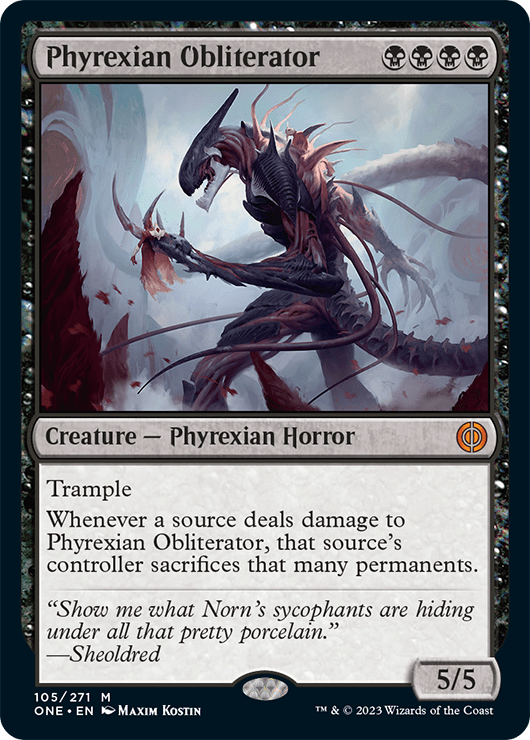
Rating: 3/10
Just like its new white counterpart, the classic Phyrexian Obliterator just isn’t good enough. Phyrexian Obliterator is far too hard to cast and it doesn’t do anything unless your opponent deals damage to it when you do end up casting it.
I know how players tend to overuse the “it dies to removal” argument, but in this case it’s true. If I’m casting a card that’s this hard to cast, I don’t want it to be answered by a simple removal spell.
This just doesn’t do the job.
Ravenous Necrotitan
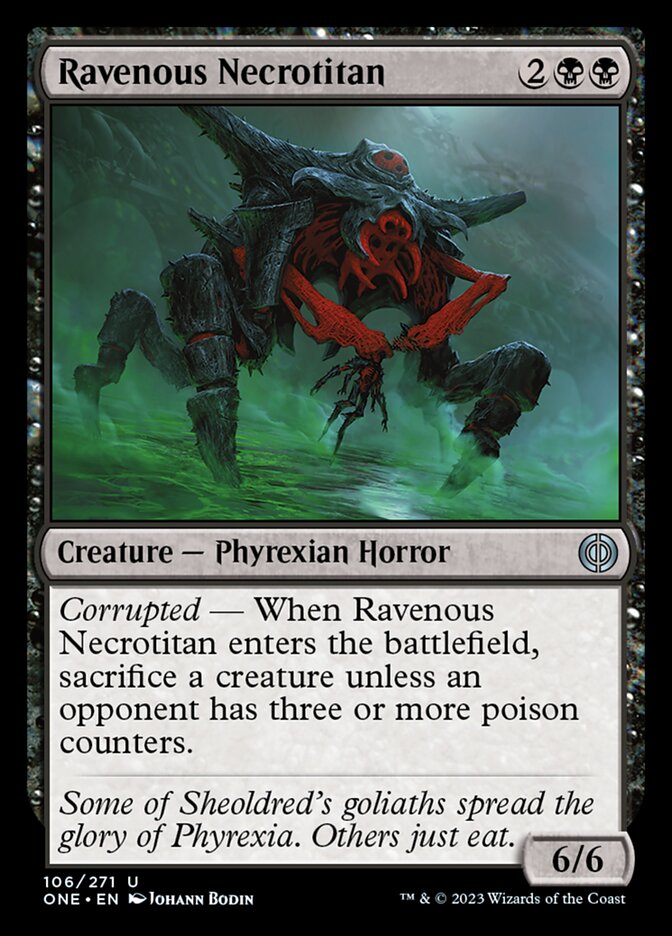
Rating: 4/10
I love the idea of getting up to three poison counters and just getting access to a vanilla 6/6 for four mana. Sacrificing a creature is a pretty poor alternative, but there are probably ways you can support that a little.
Either way you can’t just put Ravenous Necrotitan in any black deck. You should at least find some ways to support it first.
Scheming Aspirant
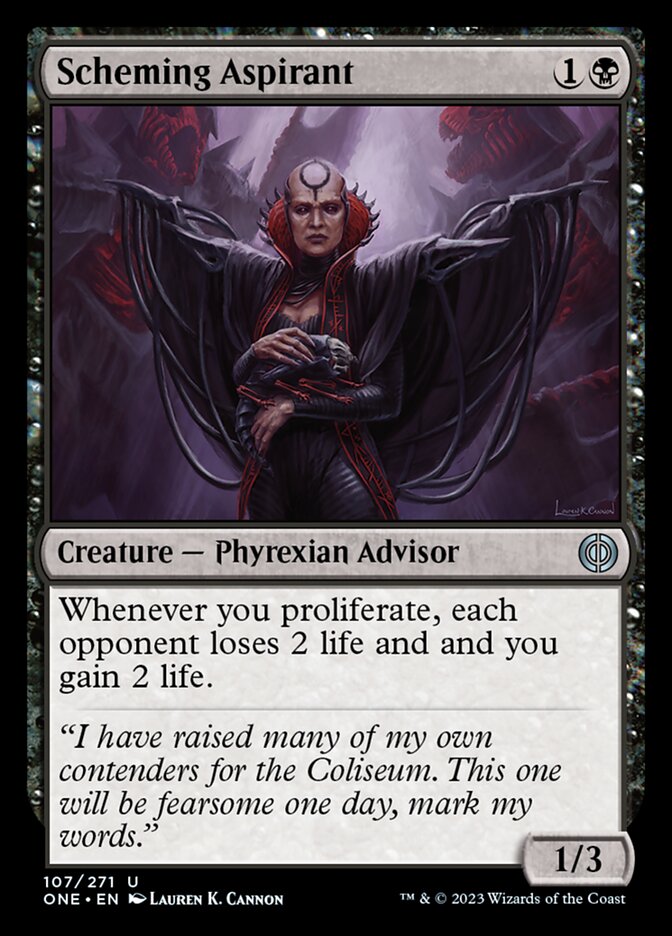
Rating: 5/10
It’s been a while since we last saw a creature like Scheming Aspirant, which triggers whenever you proliferate. Draining for two life is a very strong payoff just for doing an already good thing, but a 2-mana 1/3 is a little too below par to be excited about this.
You can only use this in a deck that’s very heavy on proliferation thanks to that, and it just sucks elsewhere. But it should be a very promising threat in that deck.
Sheoldred’s Edict

Rating: 4/10
The separate modes for this new edict are very welcome with all the tokens that are in this set, but it still boils down to only killing your opponent’s worst creature. You can control that to some extent and engineer situations where you kill off smaller creatures in some other way, but that still doesn’t make Sheoldred's Edict a premium removal spell.
Sheoldred’s Headcleaver

Rating: 2/10
Menace and toxic is a potent combination. My main worry is that Sheoldred's Headcleaver is a little too small for the amount you’re paying for it. It’s very easy to block, and only having two power means it sometimes won’t even trade off for either of those blockers.
I’m not sold, but it might be able to fill out your curve if you need it to.
Stinging Hivemaster

Rating: 5/10
Reasonably-sized creatures that die and leave something behind have always been pretty good. I loved Deathbloom Thallid, which ended up being an excellent creature in both sets we saw it in.
Sure, the token it makes can’t block, but Stinging Hivemaster is still a free upside on a creature I’d already want to fill my curve out with.
Testament Bearer

Rating: 5/10
4/1 is kind of a weird statline, but Testament Bearer straight-up replaces itself when you trade it off. The stats make me think this is much more of a defensive card because you can leave it back to trade off with annoying attackers and get a free two-for-one.
On offense, attacking with your 4-drop and trading down for something much smaller isn’t that great, but the upside is so high that it’s worth it to engineer a favorable situation with this.
Vat Emergence
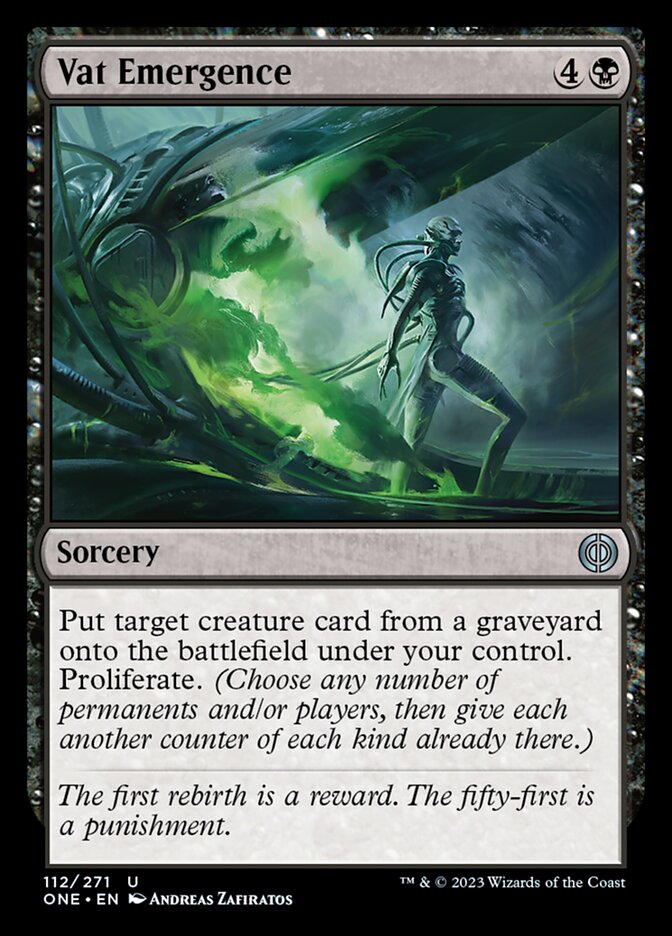
Rating: 2/10
The aesthetic of Vat Emergence is stunning. It reminds me of Neo waking up from the Matrix. I knew it was going to be some generic reanimation spell as soon as I read the card and, oh look, I was right.
Five mana to reanimate a creature just isn’t good enough without a good environment for it, and the proliferate isn’t enough of a bonus to make up for that.
Vat of Rebirth
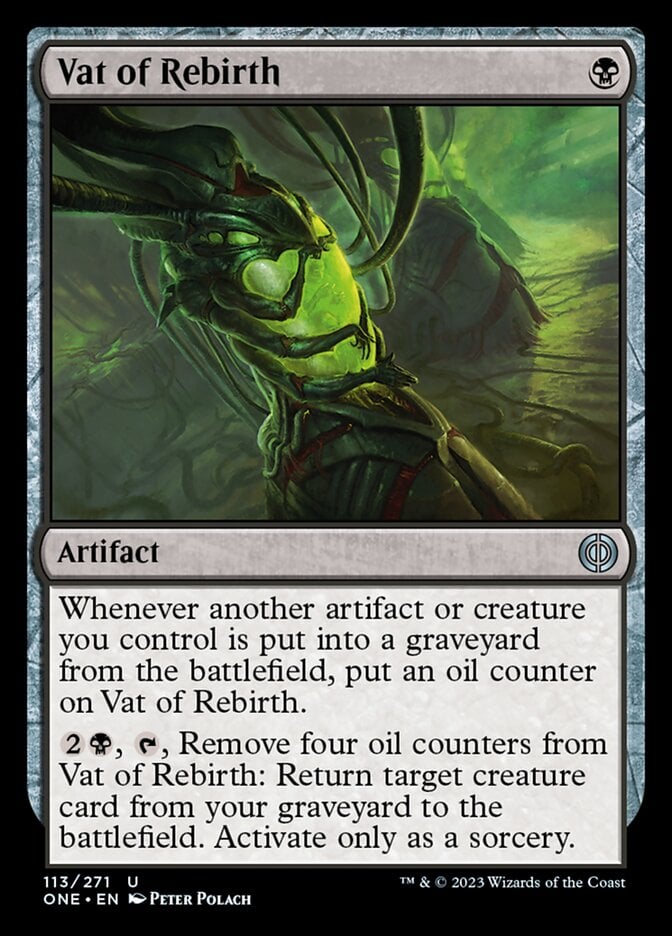
Rating: 5/10
Four counters is quite a lot to have to pay, but costing only one mana means you can sneak Vat of Rebirth down at pretty much any point on your curve, and it’s also very easy to enable. Not only can you proliferate extra counters, but there’s plenty of cheap things to sacrifice and trigger this naturally.
Cards like this usually end up being pretty bad, but I think the payoff is high enough that it will end up being pretty good in the right deck.
Vraan, Executioner Thane
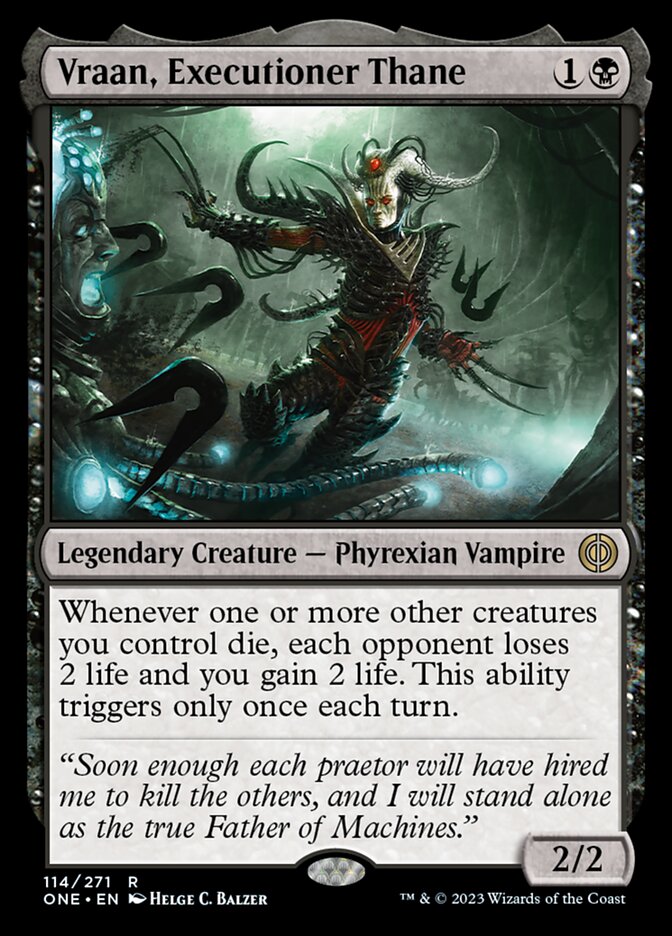
Rating: 7/10
Vraan, Executioner Thane isn’t horrible by itself and provides a pretty hefty life swing as payoff for just having your creatures die. You know, they were probably going to die anyway.
There’s a sacrifice theme available to take full advantage of this, but even just trading a creature off in combat is enough to get a huge win. It’ll be pretty hard for your opponent to trade off effectively since they’ll still take hits either way.
Vraska, Betrayal’s Sting
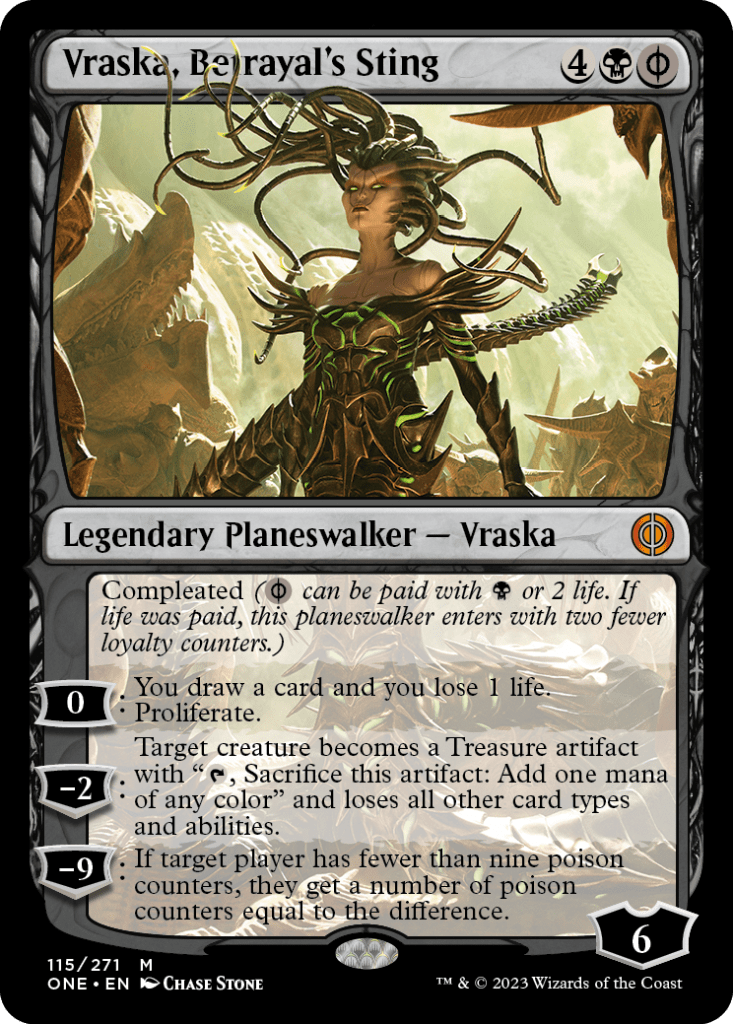
Rating: 9/10
Vraska’s cards have pretty much all been broken in Limited, and Vraska, Betrayal's Sting is no exception. Turning any creature into a Treasure is really strong and even gets around death triggers and the like. Vraska is good on five mana, great on six, and doesn’t even have to kill a creature to be powerful. Proliferating and drawing a card every turn will get out of hand fast and its ultimate is pretty much game winning.
There’s a lot to like about this new Vraska. It should swing a lot of games in your favor, and that’s all you really want a bomb to do.
Vraska’s Fall
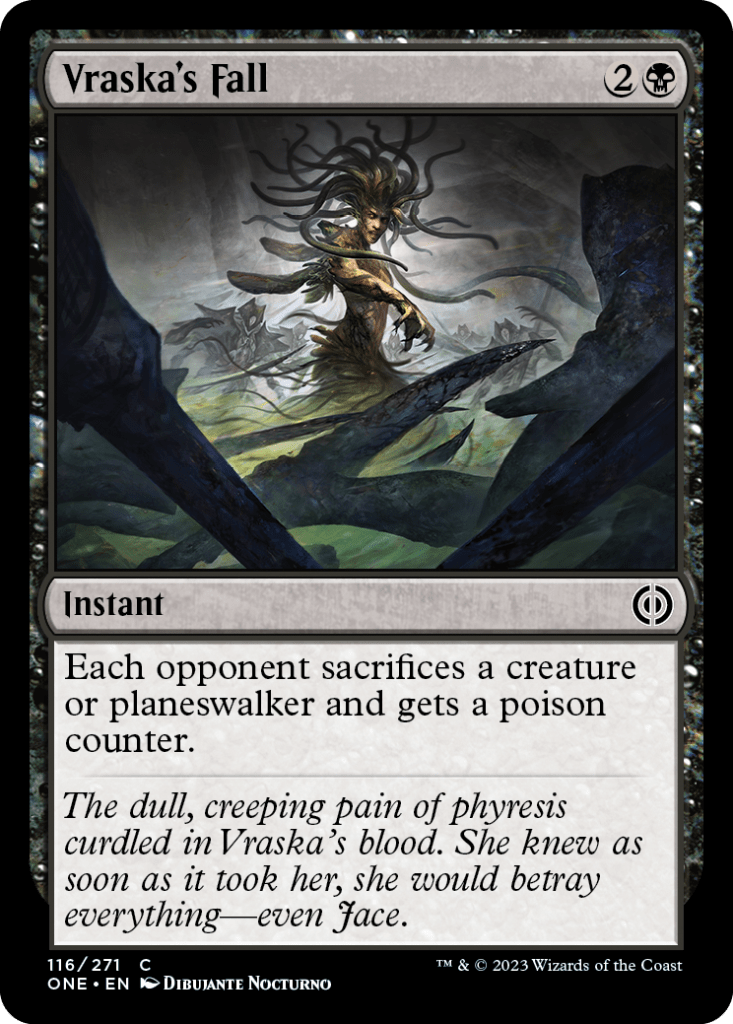
Rating: 1/10
A 3-mana edict effect just isn’t good enough by modern standards. Vraska's Fall will just end up killing a mite or something just as weak too often if you put this in your deck, and you’ll feel like you got scammed out of your three mana.
Whisper of the Dross

Rating: 3/10
Whisper of the Dross is pretty bad removal, but it’s still removal. There are quite a few 1-toughness creatures in the set and you can also use it as a minor combat trick.
We’ve seen these kinds of cards work in the past, but they usually live and die by the extra effect that’s added to them. Proliferate might be good enough for that, but I’m currently on the fence about it.
Red Cards
All Will Be One
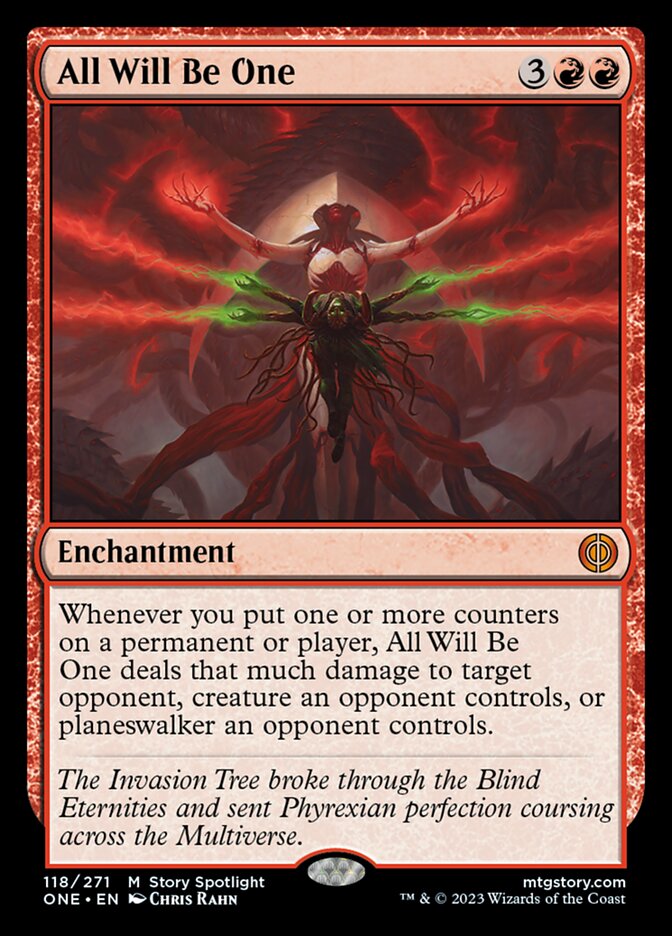
Rating: 2/10
I’m torn on All Will Be One. It’s a very powerful effect, but that’s only assuming that you can trigger it enough times. Proliferate is great with it but only does a significant amount of damage if there are several permanents or players with counters for you to add on to.
Other than that you’re only likely to be adding one counters one at a time and would need to do so several times in a single turn to manage to kill a creature. This is obviously a build around that you have to put a lot of effort into making work.
I just don’t think the payoff is good enough to reward you for that effort.
Awaken the Sleeper
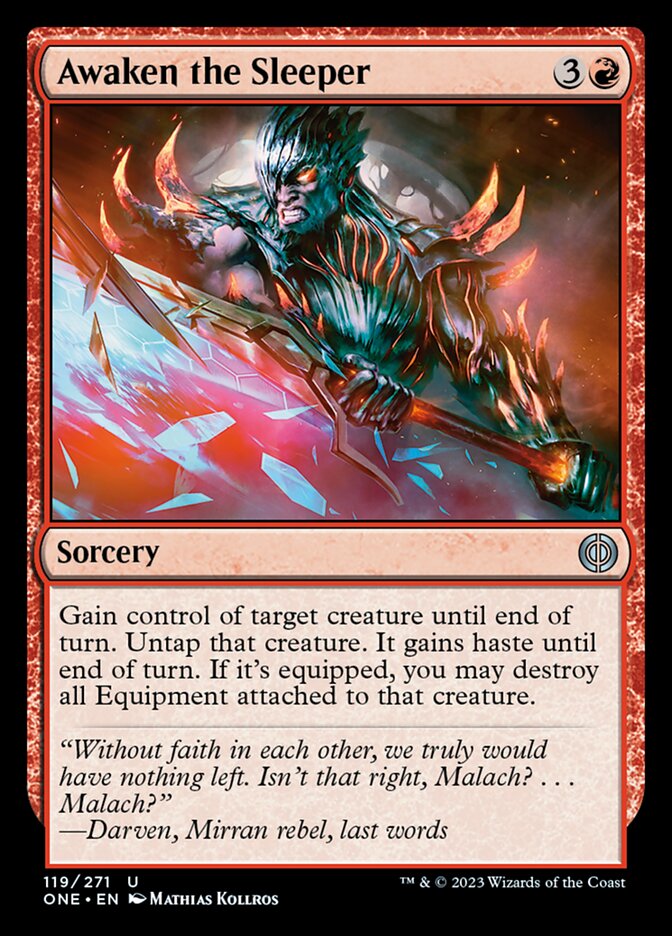
Rating: 4/10
Well, we have a Threaten effect. You can combine these cards with sac outlets to have them become removal spells, and killing off for Mirrodin! equipment is a really nice upside to have.
The value of Awaken the Sleeper entirely depends on how good the sac outlets are, so keep an eye out for them.
Axiom Engraver
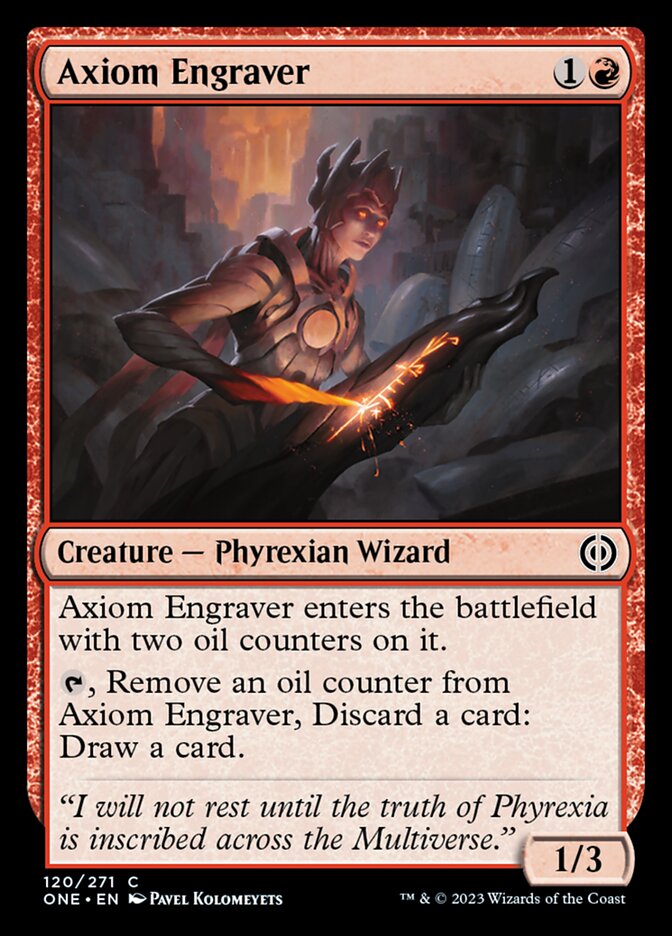
Rating: 2/10
Rummaging away excess lands is definitely a good effect to have access to, but you don’t really care about a 2-mana 1/3 that can only do that twice. Sure, you could add more oil counters, but you could probably find more useful ways to use them than on Axiom Engraver unless you’re proliferating.
Barbed Batterfist
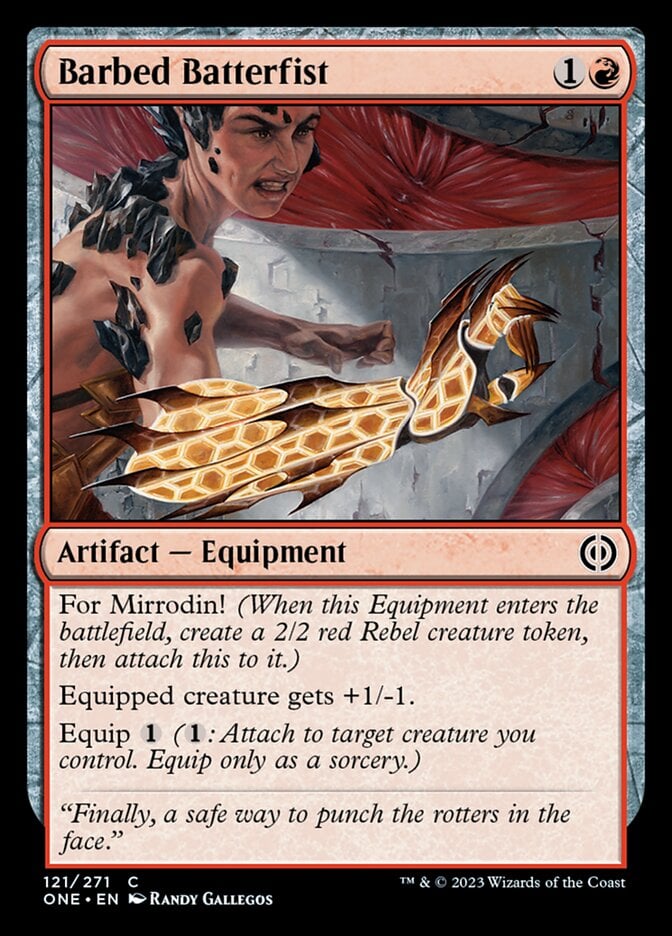
Rating: 4/10
Barbed Batterfist is what I want my common for Mirrodin! equipment to look like. It’s cheap to equip up, gives a reasonable buff, and starts out as a vanilla 3/1 creature. All sounds fine to me.
Bladegraft Aspirant
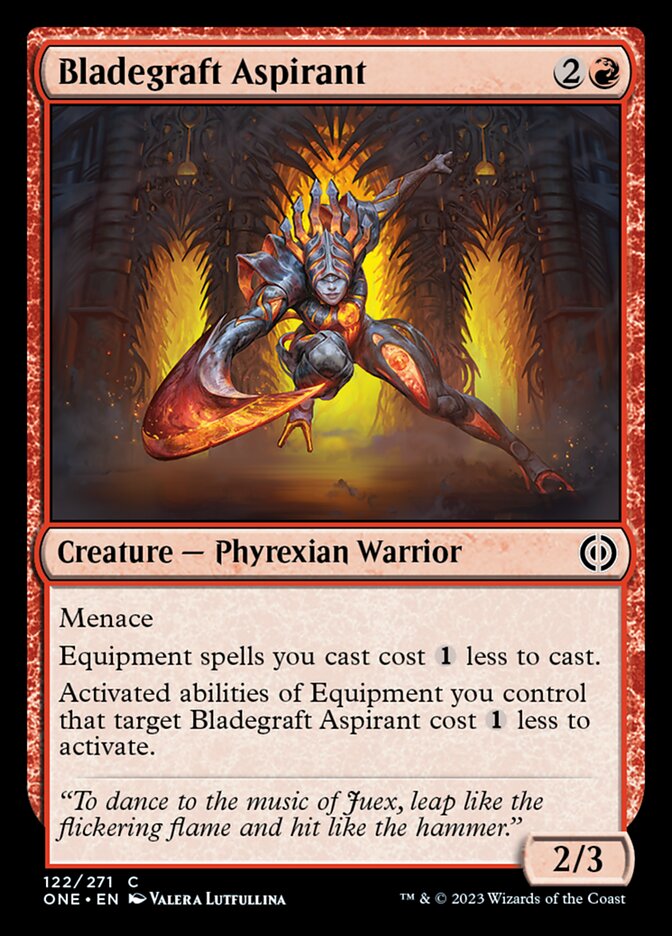
Rating: 5/10
Bladegraft Aspirant looks like it does a lot, especially for a common. It’s already a decent size for a 3-drop as a 2/3 with menace and picks up equipment nicely too.
Cost reductions are usually not that important in Limited, but at least it’s added on for free to a creature you were probably already happy with.
Blazing Crescendo

Rating: 3/10
Well, on one hand Blazing Crescendo is a combat trick that cantrips, which really helps to give you easy two-for-ones. But the downside is that only giving +3/+1 isn’t going to help your creature survive many combats, so two-for-ones often aren’t an option.
I think it balances out and the card is reasonable, especially in an aggressive format.
Cacophony Scamp
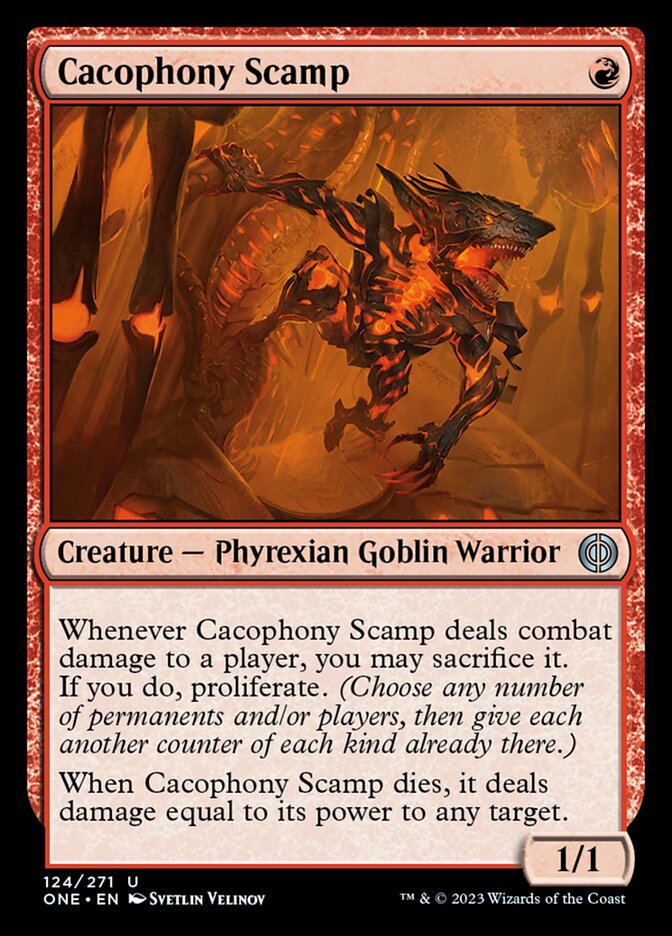
Rating: 5/10
Cacophony Scamp is one hell of a 1-drop. Goblin Arsonist was already a good card, but this is orders of magnitude stronger.
The proliferate option is nice, even if it’s not likely to happen. It’s especially nice to throw equipment onto (especially Colossus Hammer for constructed formats), and if it trades off in combat it’s very possible it’ll trade for two creatures if you can make it big enough.
I suppose this is a reason to be thankful that there are no +1/+1 counters in this set or it might be even stronger.
Capricious Hellraiser

Rating: 5/10
I’m not a big fan of Capricious Hellraiser. There’s no denying it has some power to it, but the random aspect of it is kind of a dealbreaker. The probability isn’t too bad that you’ll hit something, but you have little to no control over what you get to copy.
Let’s do a hypothetical scenario to quickly run the numbers. You have nine cards in your graveyard, three of which are hits and the other six are creatures or lands. Your chance to hit at least one hit in your pile of three is around 77%. If you really want to hit one specific card then you only have a 33% chance of hitting it.
Those numbers aren’t too bad, but they’re also not great. The more you can skew the numbers in your favor then the better this will get, but I think the use case is that this just isn’t good enough.
Chimney Rabble
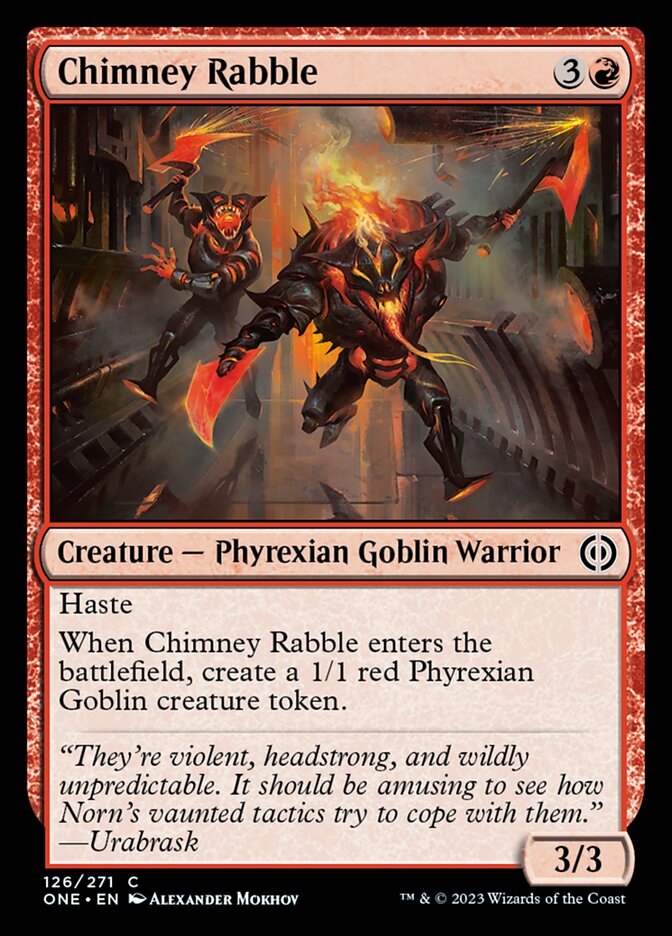
Rating: 4/10
Four mana for 4/4 of stats across two creatures is a pretty good deal, but not all that exciting these days. Chimney Rabble is definitely something you’ll play and I think is especially good in the sacrifice deck, giving you free fodder to throw away to your various abilities.
Churning Reservoir
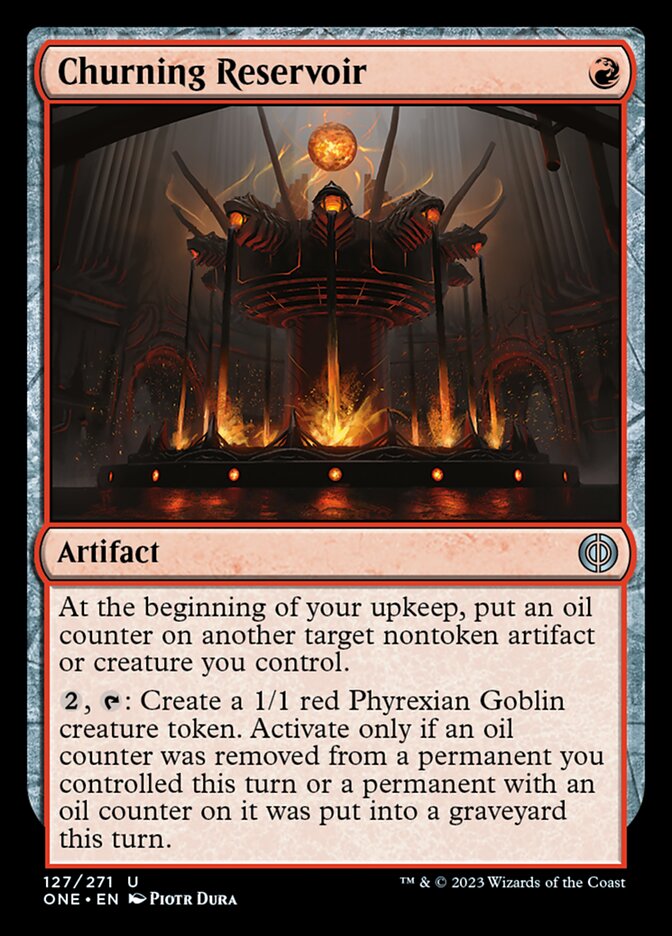
Rating: 7/10
I have high hopes for Churning Reservoir. I’ve said throughout this review that cards that use oil counters always want to have more added, either through proliferation or other means. Well, this is what “other means” looks like.
This is also cheap to cast and pretty good at providing a steady stream of usable tokens. You have to build around it and really be focused on oil counters so you probably won’t be drafting it early, but I think you’ll be very happy to be in an oil counter deck and pick this up later.
Dragonwing Glider
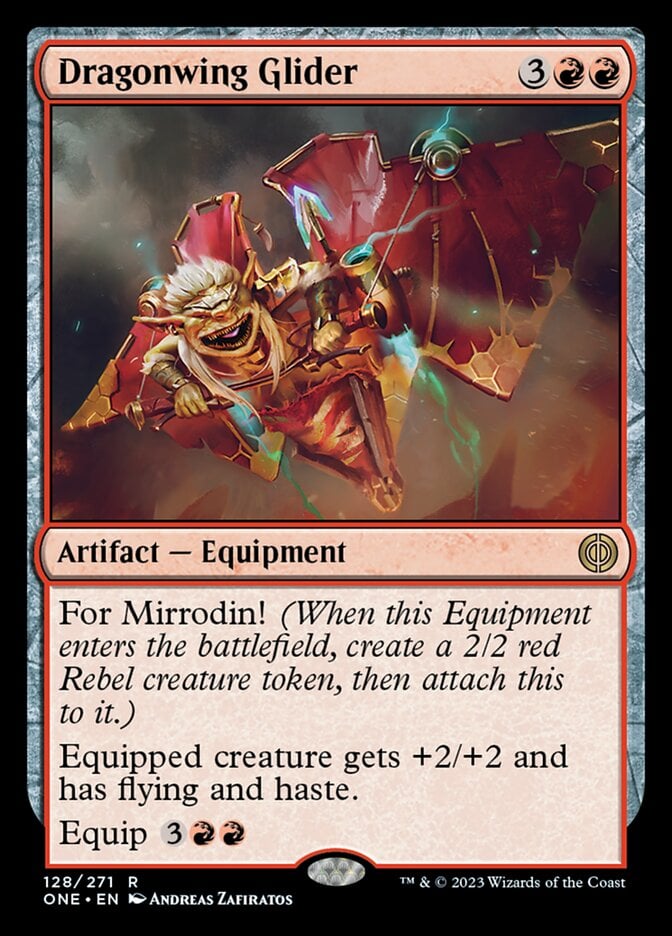
Rating: 9/10
A 4/4 haste flier is already a great card for five mana, but leaving behind a powerful equipment when it dies is just incredible. The equipment is expensive to reequip, but it’s definitely worth the cost when Dragonwing Glider turns any cheap creature into a really strong threat.
Exuberant Fuseling
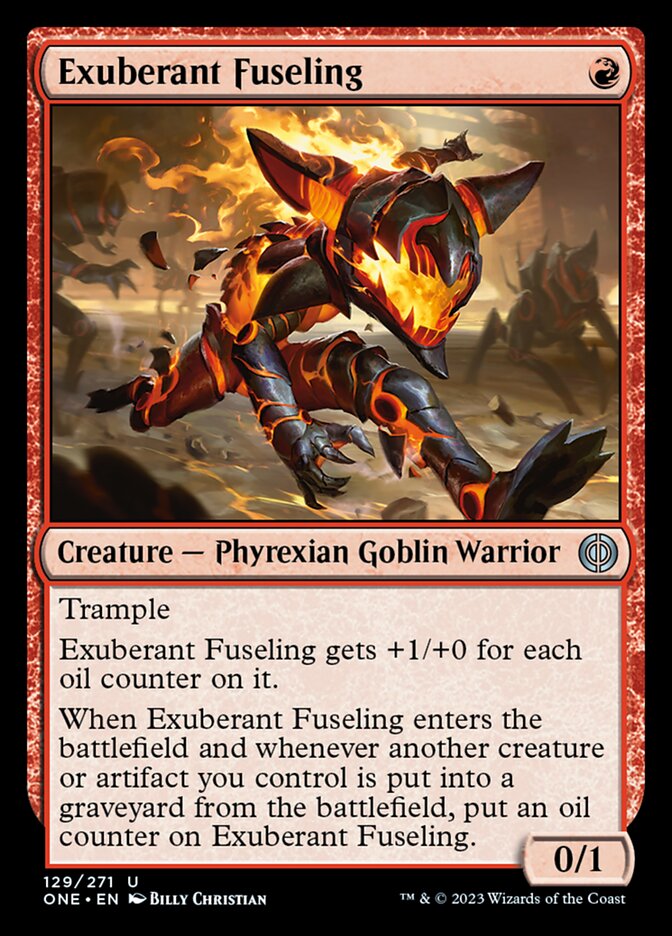
Rating: 5/10
A simple 1-drop that grows in size pretty quickly when you do the thing that your sacrifice deck already wants to do is really nice. Exuberant Fuseling is still only one toughness so attacking with it isn't great, but it might still be a good play to attack, trade off with something rubbish, and get a big chunk of damage in thanks to trample.
It’s also still going to be great on defense where it can easily trade up for bigger creatures.
Forgehammer Centurion
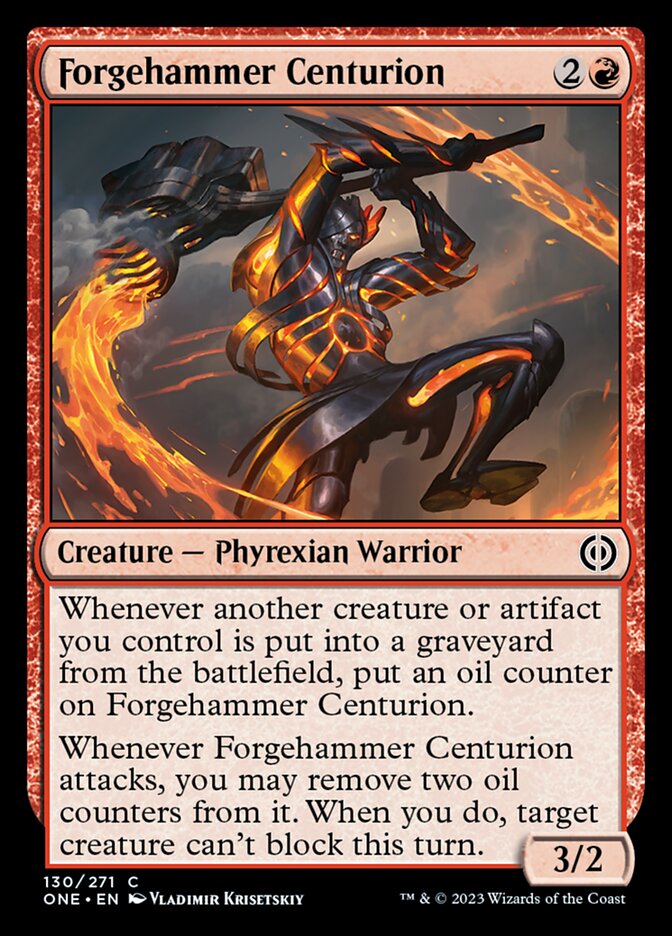
Rating: 4/10
A solid body with a nice ability that cues from two different archetypes looks very nice to me. Whether you’re sacrificing your creatures or artifacts, manipulating oil counters, or a little bit of both, Forgehammer Centurion is an aggressive creature that does a good job swinging combats in your favor.
Free from Flesh
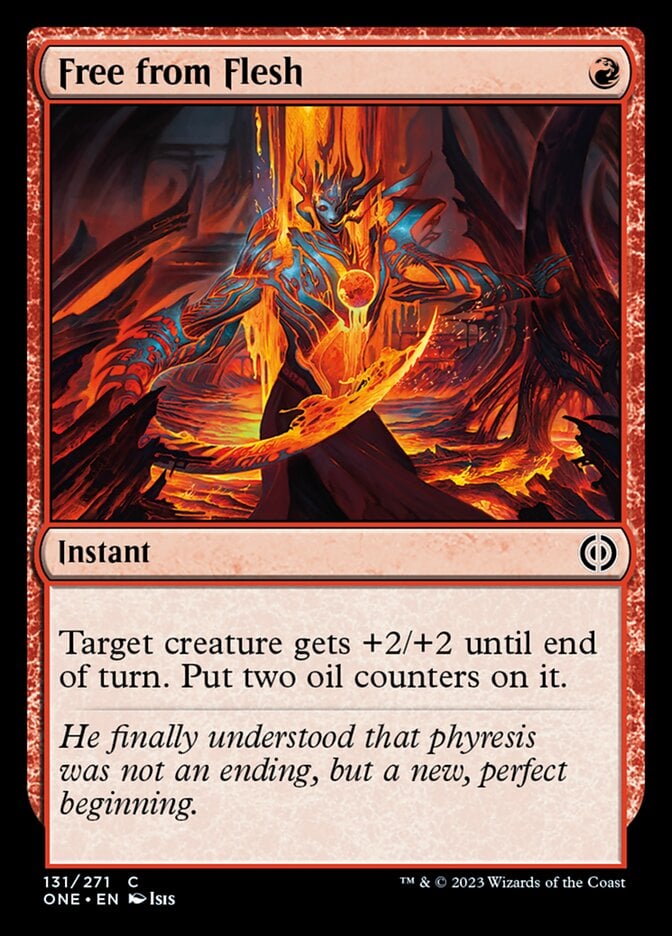
Rating: 3/10
+2/+2 is still a fairly mediocre combat trick, but there are some creatures that really care about the oil counters so Free from Flesh might even be a +4/+4 trick in the right circumstances. It’s also pretty cheap meaning it’s easy to cast in most scenarios, so it might work out pretty nicely in the right deck.
Furnace Punisher
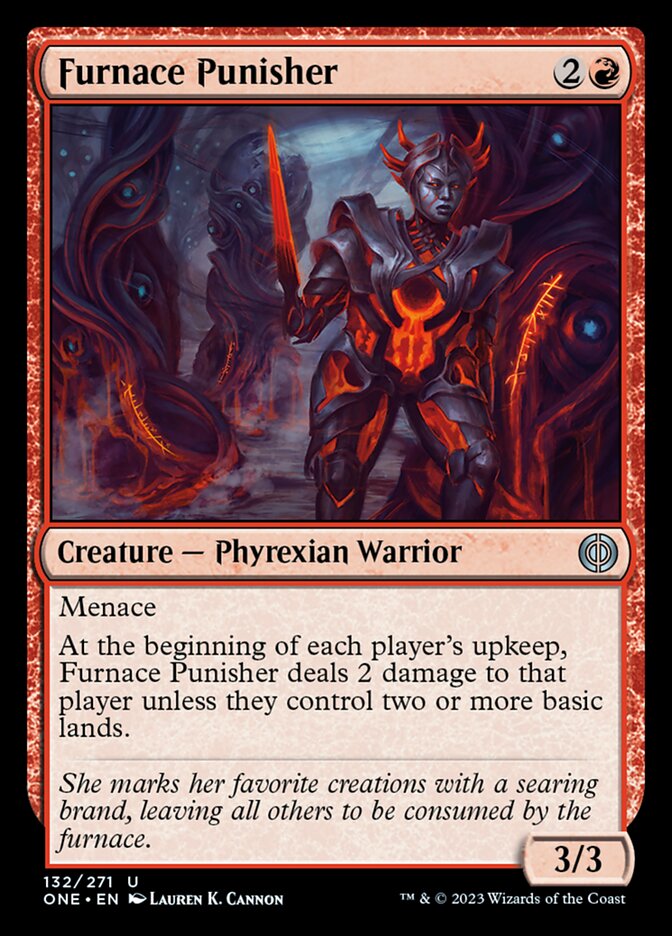
Rating: 5/10
Well, players are almost guaranteed to always have at least two basic lands in play in Limited, which makes Furnace Punisher a vanilla 3/3 menace for three. That’s honestly still fairly decent as a curve filler.
It’s also not impossible that you play this on turn 3 and one of your opponent’s first two land drops was a nonbasic..
Furnace Strider
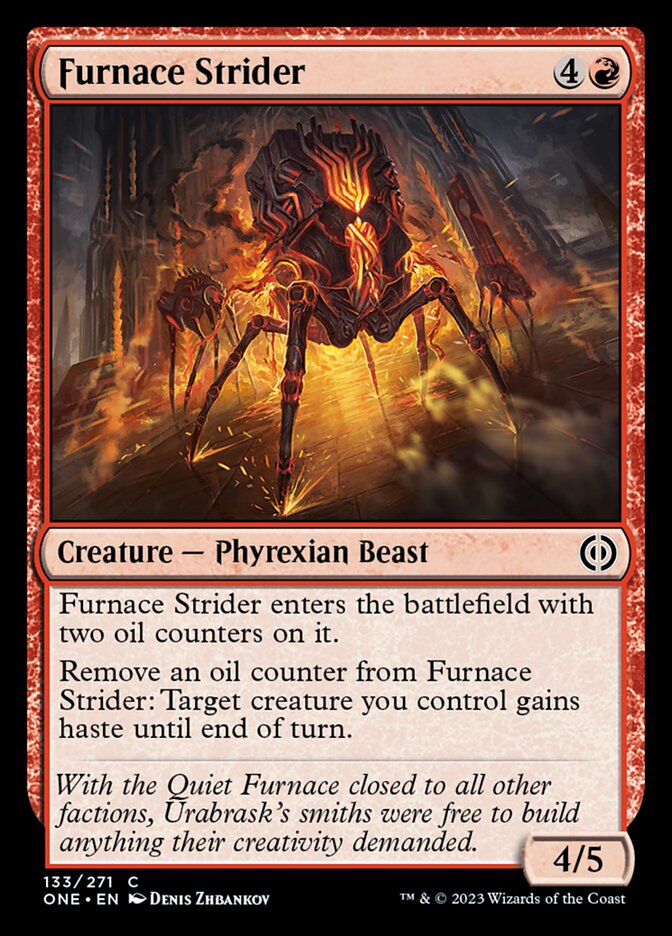
Rating: 4/10
I think it’s fairly obvious that the first oil counter should usually be used to give itself haste. At that point a 4/5 haste for five is quite powerful, and you even have a leftover counter for your next creature.
Furnace Strider isn’t setting the world alight, but big haste creatures are usually a good way to round out the curve in your aggro decks.
Gleeful Demolition

Rating: 4/10
Kids these days will never know the pain that was Kuldotha red, an incredibly low-to-the-ground Standard deck that centered around Goblin Bushwhacker and Kuldotha Rebirth. These days our big token generator is also a very efficient artifact removal spell, and I guess we’re happy for the upgrade.
It’s not that great to turn one of your own artifacts into three 1/1s with Gleeful Demolition unless that artifact already gave you some value, but it’s a nice option to have access to when you don’t need to kill off an artifact.
Hazardous Blast
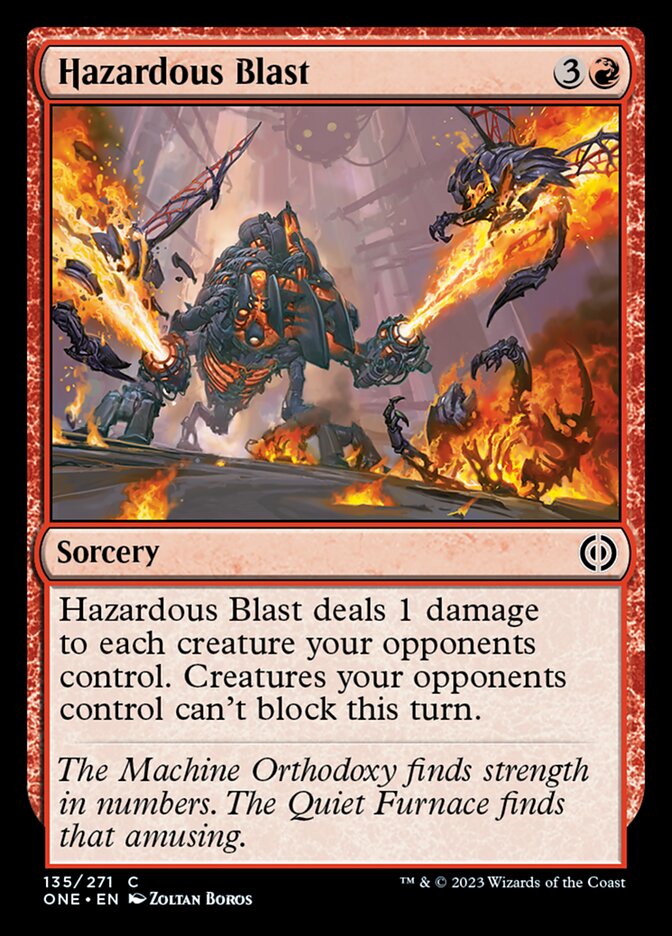
Rating: 5/10
You might be thinking Hazardous Blast looks terrible. After all, four mana for one damage to your opponent’s creatures is awful. But we all thought the same about Cosmotronic Wave back in Guilds of Ravnica. That format was slow and grindy and we ended up feeling like if you drafted Izzet () or Boros () and didn’t get a Cosmotronic Wave then you lost out in some way.
This format looks much more aggressive than that and there are quite a few 1-toughness creatures lying around, so I think this will be quite an important card in the format. You never want more than one as it’s terrible in multiples, but every red deck will probably want that first copy.
Hexgold Halberd

Rating: 7/10
You’d always be happy putting a 2-mana 2/2 with first strike and trample in your deck. Hexgold Halberd is so much better than that.
Like with the other equipment we’ve seen you get a good base rate on it as a creature, and you end up with a free equipment when it dies. That’s just an amazing deal and I’m all here for it.
Hexgold Slash
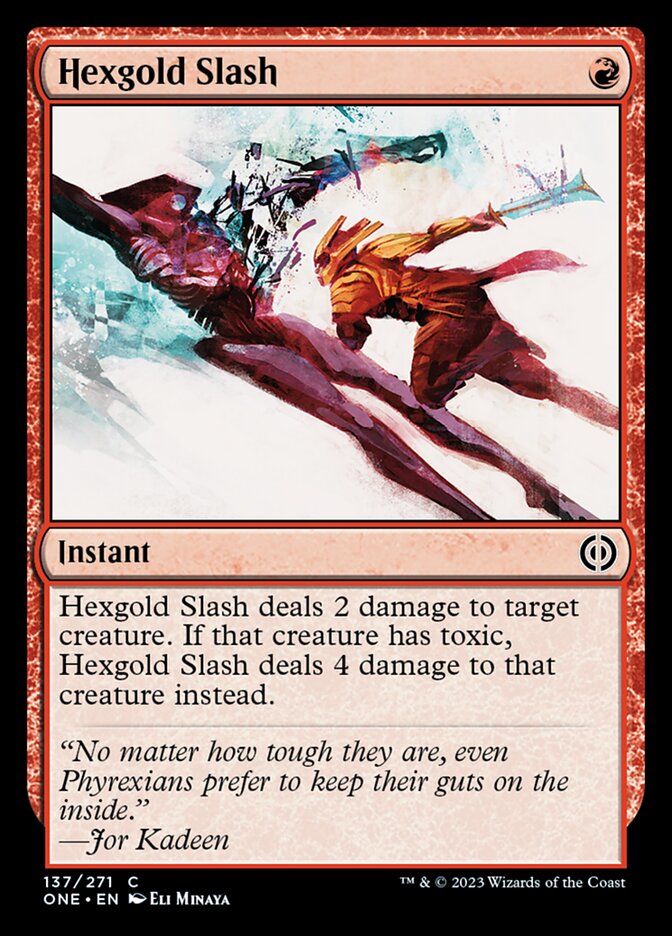
Rating: 6/10
A 2-damage spell that only hits creatures isn’t that great, but being able to hit toxic creatures for four is a great upgrade that turns Hexgold Slash into a nice premium removal spell for red.
Koth, Fire of Resistance
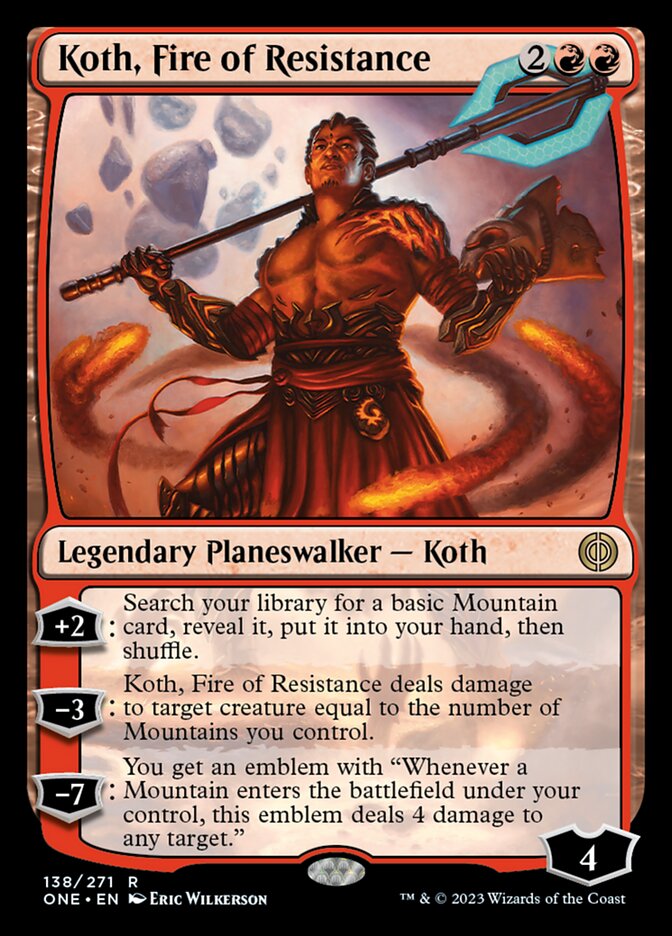
Rating: 8/10
Koth, Fire of Resistance looks a little weak at first glance, but I think it does enough for a good Limited card. I’m very interested in its +2 ability. Not only is drawing a card each turn a good thing to be doing, but Koth’s other abilities really help to give you reasons to want more Mountains. Koth can also get out of aggro range pretty quickly because it’s a +2, making that spicy ultimate much more likely to happen.
Better yet, Koth’s -3 can often just kill whatever creature you need it to if you draw this much later in the game, so it doesn’t get worse as the game goes on. Koth isn’t breaking any games open like the other planeswalkers we’ve seen so far, but it’s still a great card and one you should take highly.
Kuldotha Cackler

Rating: 5/10
The base stats on Kuldotha Cackler are already fine. It’s not hard to imagine this attacking as a 4/3, 5/3, or even bigger trample creature in the right deck, and that’s absolutely insane out of a 3-mana common.
Magmatic Sprinter
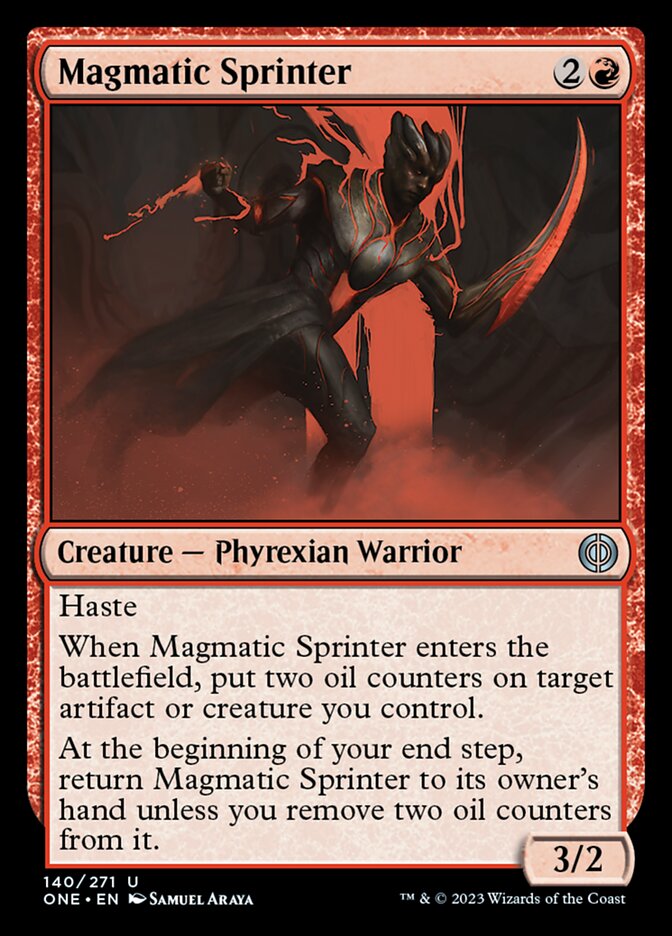
Rating: 5/10
Magmatic Sprinter is a weird one, but we’ve so far gone past a ton of random artifacts that get so much better if you can add oil counters to them and this is a way to do it turn after turn.
I’d prefer to look at it as a buyback spell to put oil counters on my permanents instead of a creature, and that’s something a heavy oil deck is probably into. It can also help your combat by coming down with haste, so it has a few nice things going for it.
Molten Rebuke
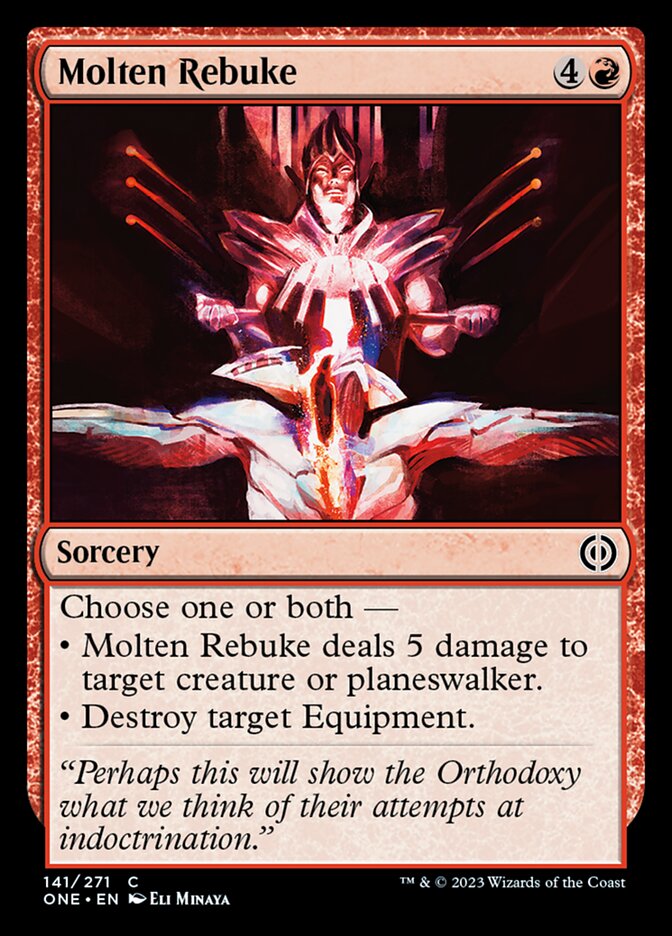
Rating: 3/10
We get these 5-mana burn spells in every set and they’re always fairly mediocre. Yeah, your red decks will be happy with one of them, but every other burn spell in the set is much more efficient than Molten Rebuke.
I’d have liked to see a reprint of Turn to Slag in this spot if only for the meme value of it.
Nahiri’s Sacrifice

Rating: 5/10
I don’t like that you have to sacrifice a very real creature or artifact for Nahiri's Sacrifice to be effective, but it should be worth it if it can clear away two or three creatures.
The dream is to sacrifice a “dead” creature that’s locked down under Planar Disruption or Mesmerizing Dose. I’d immediately bring this in out of the sideboard if you see either of those cards in game 1.
Oxidda Finisher
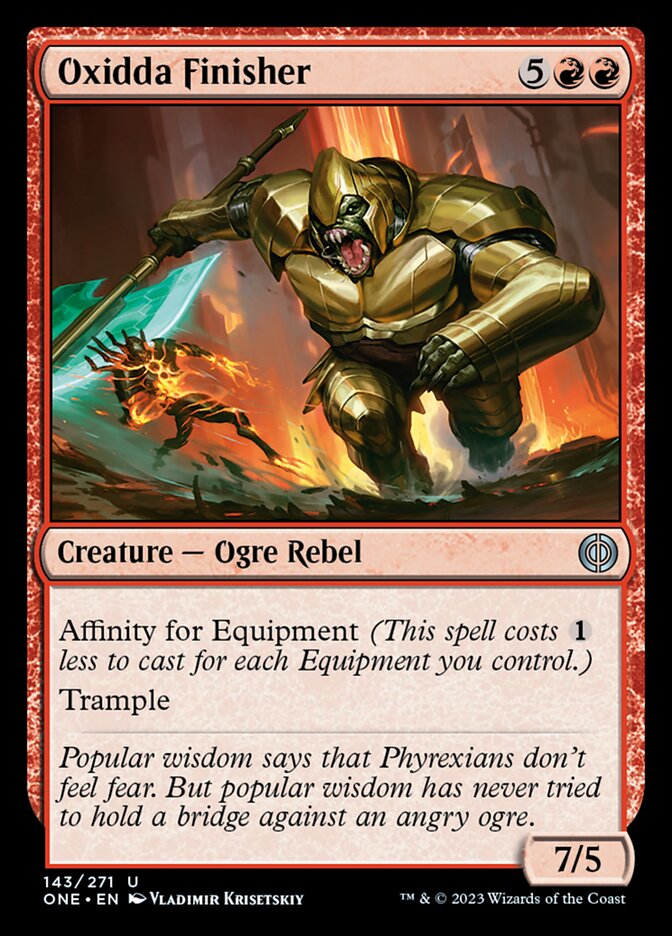
Rating: 6/10
I think the sweet spot for Oxidda Finisher is five mana. It’s a really good card there and I don’t think that’s all that hard to achieve given how powerful this set’s equipment is.
Below that is much harder to do, but it makes the card absolutely bonkers if you can get there.
Rebel Salvo
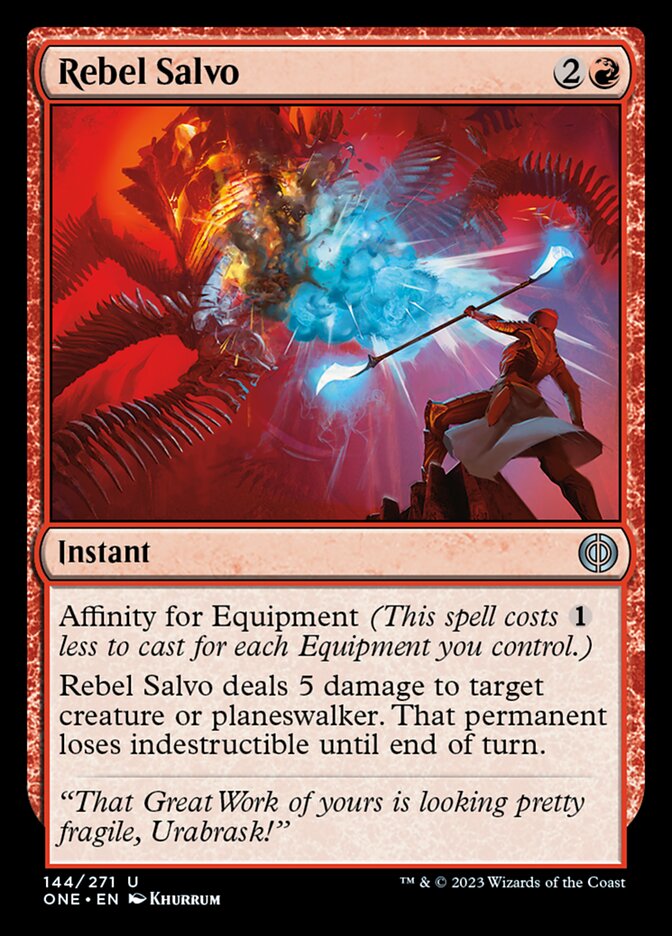
Rating: 7/10
Rebel Salvo would be premium red removal even without the affinity to make it cheaper. It’s going to feel unreal if you end up in situations where this costs one mana, like you’d gotten away with something you shouldn’t have.
Red Sun’s Twilight
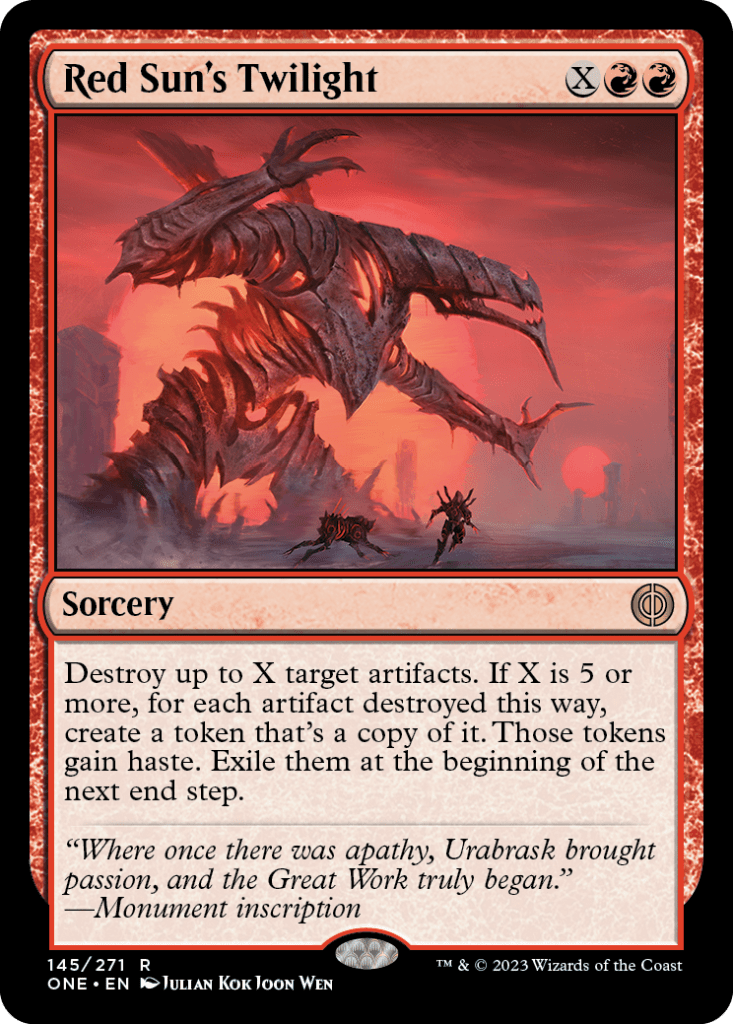
Rating: 5/10
Finally, a twilight spell that isn’t absurdly broken! I’m sure Red Sun's Twilight is elsewhere, but destroying X target artifacts is too narrow of an ability to want to play this in most decks.
It makes for an absolutely disgusting sideboard card, but I don’t think it’s worth putting in your main deck.
Resistance Skywarden
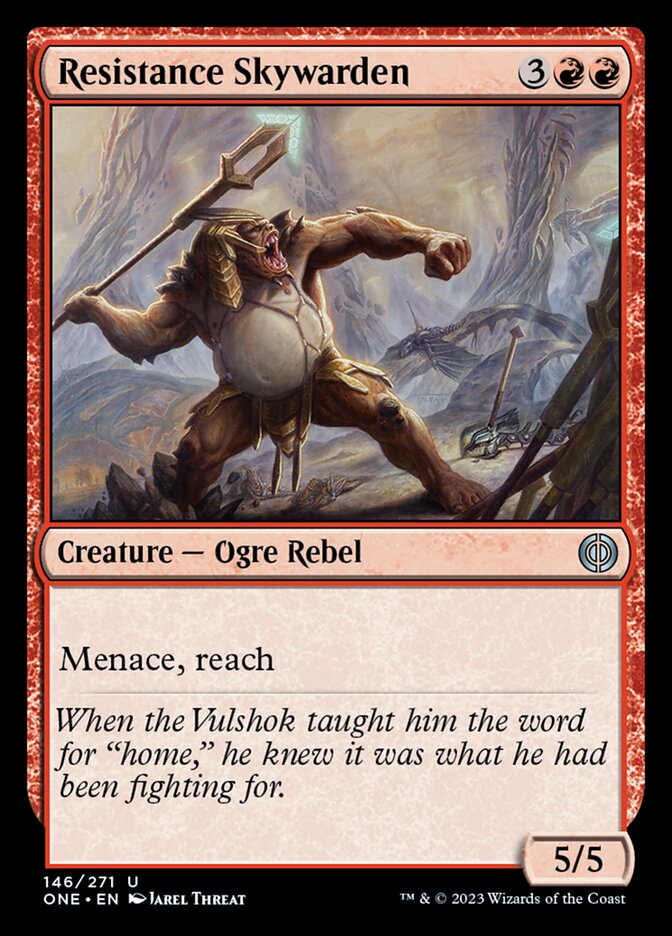
Rating: 4/10
I’ve turned my nose up at cards like Resistance Skywarden in the past and been proven wrong. It’s only a vanilla creature, but it’s very strong on defense and still good on offense.
You won’t always want this, but it’s hardly the worst card to top your curve with.
Sawblade Scamp
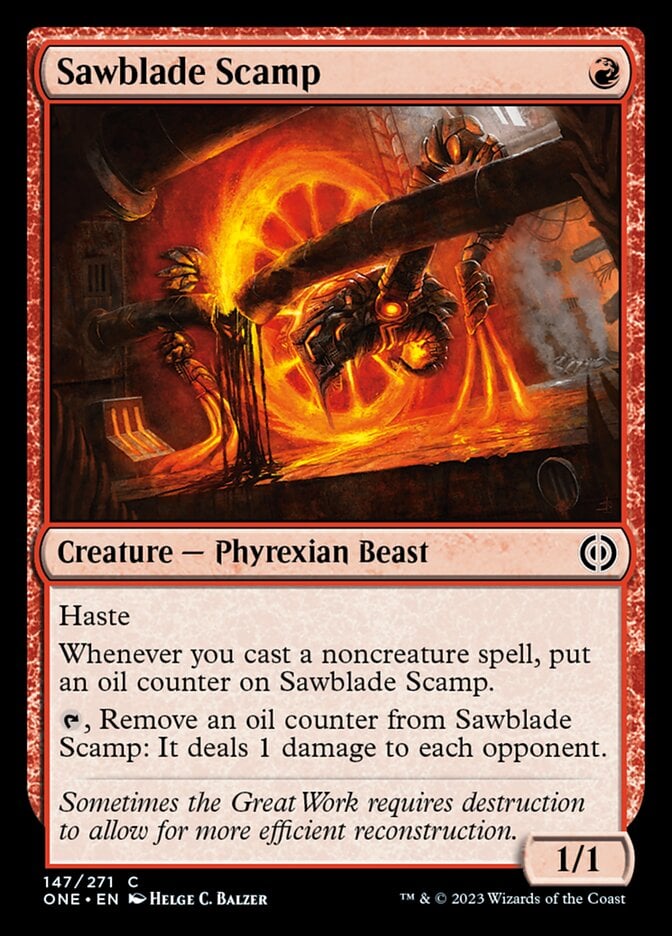
Rating: 4/10
Red has a lot of 1-drops, and they all look good to me. Sawblade Scamp comes right out of the gates to start chipping away at your opponent.
Though it gets outclassed very quickly, its activated ability gives it a great amount of longevity that other 1-drops don’t get. It shouldn’t be that hard to support and get a surprisingly large amount of damage out of it.
Shrapnel Slinger

Rating: 4/10
I like seeing solid 2-drops and Shrapnel Slinger definitely counts. You’re usually very happy just playing this as a vanilla creature, but there are going to be plenty of times where you get to sacrifice your worst creature and kill something very strong.
Slobad, Iron Goblin

Rating: 4/10
Slobad, Iron Goblin is kinda cute, but not something we care too much about. It’s clearly designed for constructed but it’s still possible for you to use this to power out something a bit bigger. It just generally won’t be worth it.
At the end of the day this is a sac outlet and a vanilla 3/3 for three, so it’s a perfectly fine card.
Solphim, Mayhem Dominus
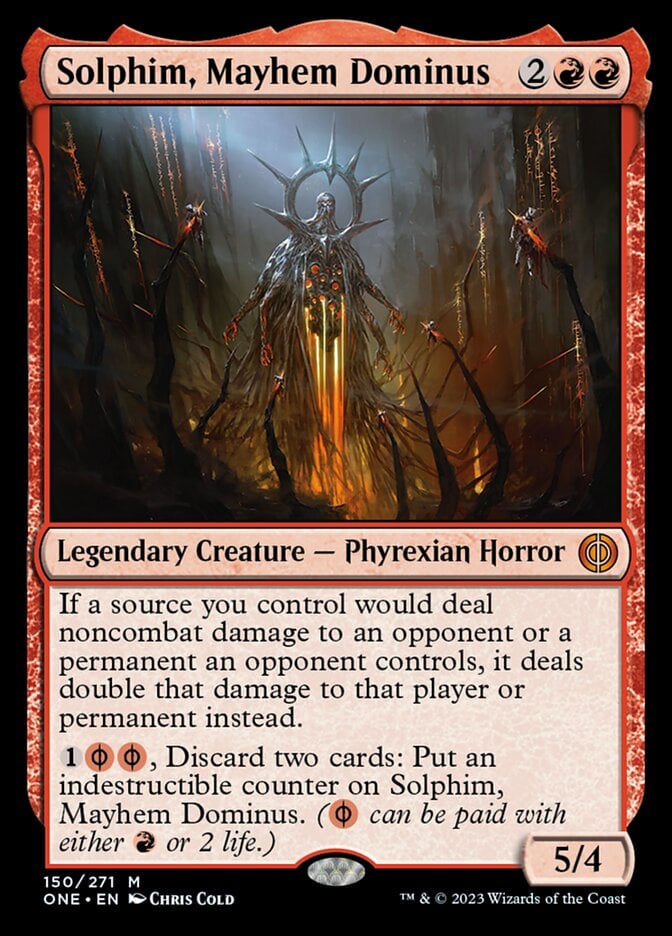
Rating: 7/10
I believe Solphim, Mayhem Dominus is by far the worst of the dominus cycle. Doubling noncombat damage is something that does come up, helping your burn spells kill bigger creatures and the like.
On the other hand, discarding two cards is a really heavy cost for making it indestructible. This is usually little more than an overstatted vanilla creature that might double as a burn spell. That’s still something you’re happy to play, but I don’t think it achieves bomb rare status without a better way to make it indestructible.
Thrill of Possibility
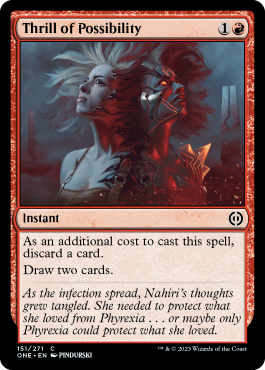
Rating: 3/10
We’ve seen Thrill of Possibility time and time again, and it’s always a welcome reprint. The gist of it is that the spell-based decks are usually very happy to see it.
Other decks don’t care about it very much, but it does make for a decent 23rd playable if your deck comes up a little short.
Urabrask’s Anointer
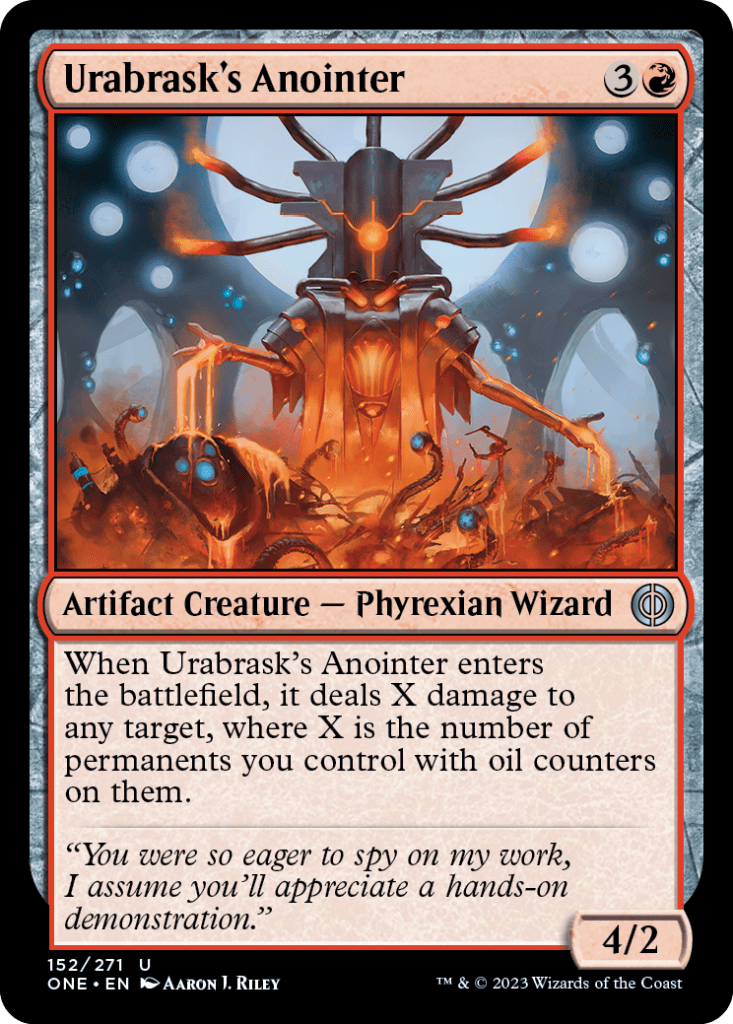
Rating: 7/10
You had me at Flametongue Kavu. The oil deck needs payoffs, and getting access to one of Limited’s best ever uncommons is certainly a way to pay you off.
The downside here is that Urabrask's Anointer doesn’t hit for any damage in a vacuum. The last time we saw this was Basalt Ravager, and that at least always dealt one damage by itself. This is still exactly the card you want as a reward assuming you’re a deck with a heavy focus on oil counters.
Urabrask’s Forge
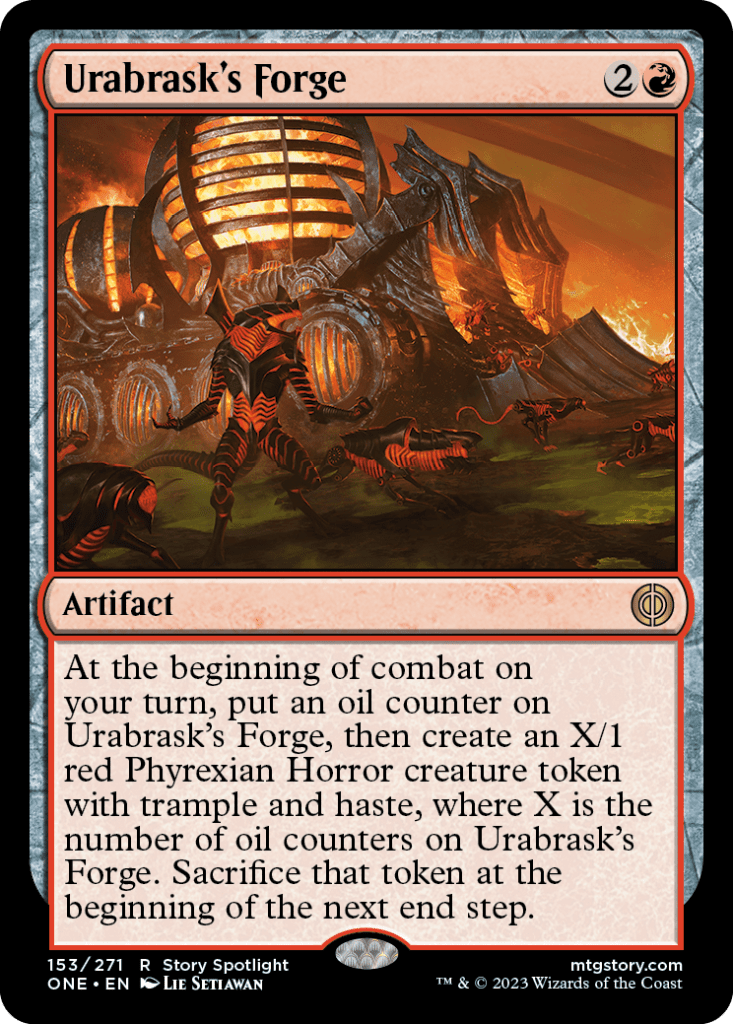
Rating: 7/10
We’ve seen a few cards that make a small haste creature every turn before, and they’ve always been fine. But Urabrask's Forge is insane. I’m saying this a lot, but proliferation and oil counter synergies will help you really get this going, and the extra power you get will never go to waste since it’s churning out tokens with trample and haste.
It takes far too long to get going on its own so you really want to play this in a deck where it can be supported and start making 6/1s and 7/1s as soon as possible.
Vindictive Flamestoker
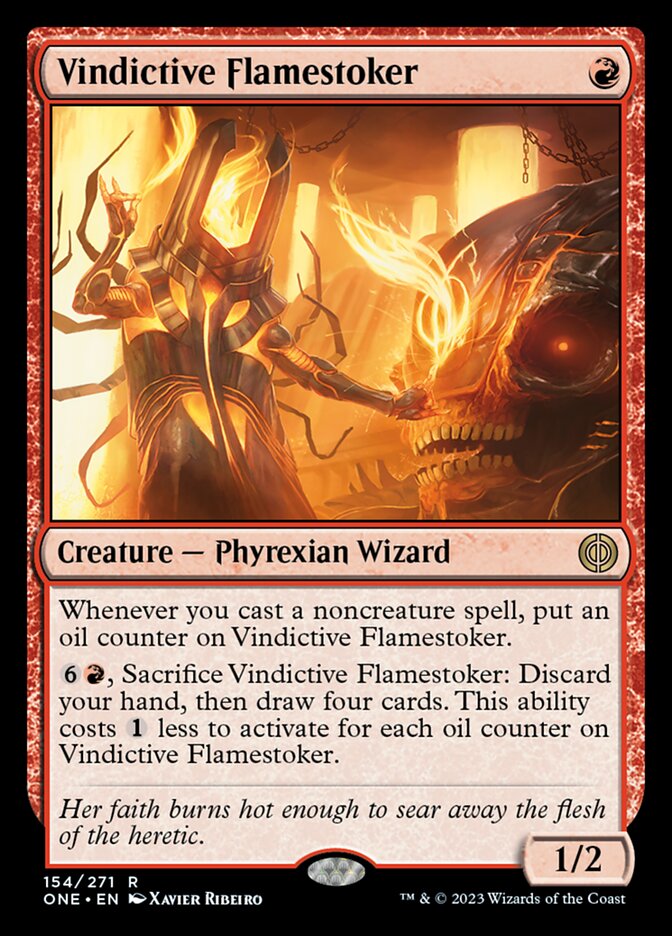
Rating: 2/10
Trading your hand for four cards is a very powerful effect, but that’s why Vindictive Flamestoker is so embarrassing up front. It’ll probably end up with enough counters to eventually do this cheaply if you play it early, but it doesn’t do a single thing until that point.
Eight mana to draw four cards is just not a good deal if you draw it late.
Volt Charge
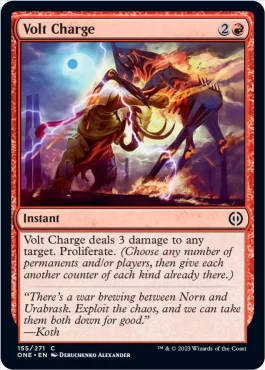
Rating: 7/10
Volt Charge was the best red common back in New Phyrexia, and I doubt much has changed since then. 3-damage burn spells are still strong and the proliferate matters for a lot of decks.
Simple, sweet, and still very powerful.
Vulshok Splitter
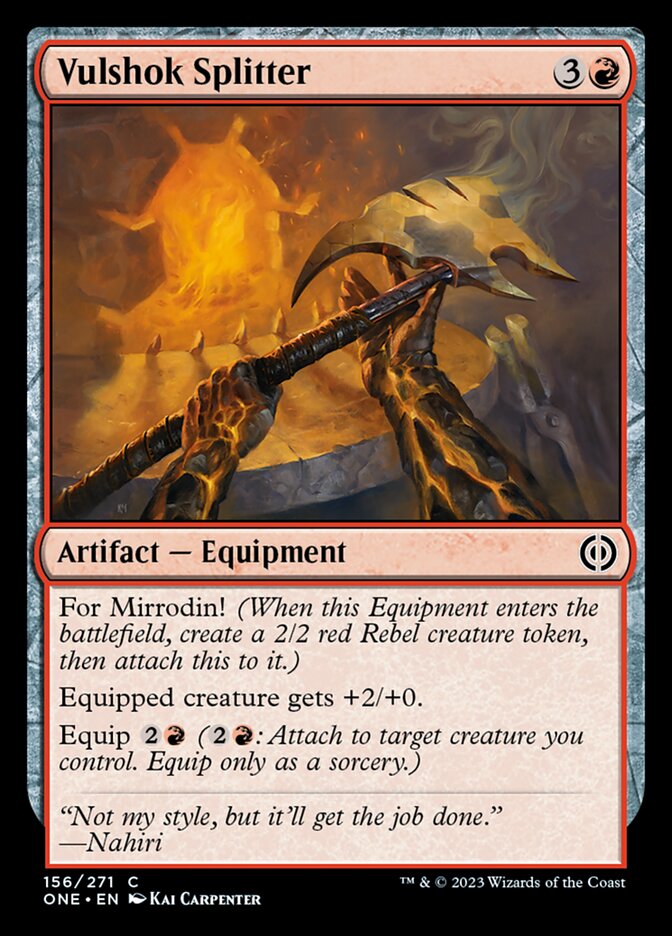
Rating: 4/10
A vanilla 4/2 for four isn’t the best, but having that in the form of a for Mirrodin! equipment sounds pretty good to me. There are a few things that key off these equipment cards, and Vulshok Splitter looks good enough to make the cut.
Green Cards
Adaptive Sporesinger

Rating: 3/10
Adaptive Sporesinger doesn’t amount to much more than just a mediocre playable in every scenario I can see. Its stats are well below par and neither ability really makes up for that.
It does help to push attackers through blockers, but that’s often not a problem for green decks.
Armored Scrapgorger

Rating: 7/10
It goes about it in a weird way, but Armored Scrapgorger is still a good mana dork that fixes your colors and eventually turns into a usable 3/3 creature. That’s always been a highly-desirable card for Limited and I don’t see that changing now.
Bloated Contaminator
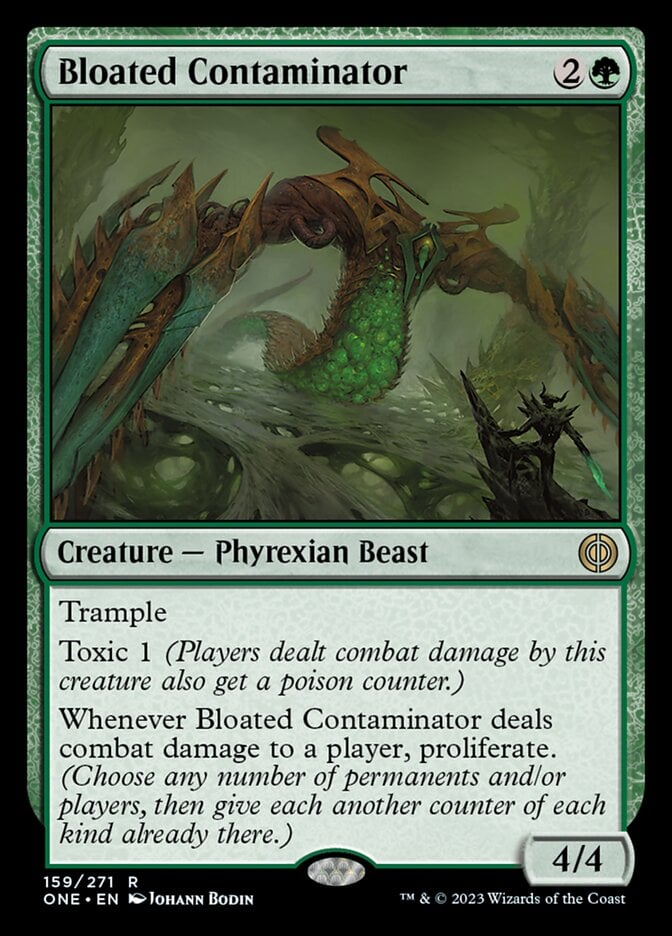
Rating: 9/10
What vanilla test? We clearly don’t need that anymore. What an absurd rate for a 3-drop. A 4/4 with three upsides? Surely you don’t need me to tell you Bloated Contaminator is a great card.
I’ll leave it at that. The card speaks for itself.
Branchblight Stalker
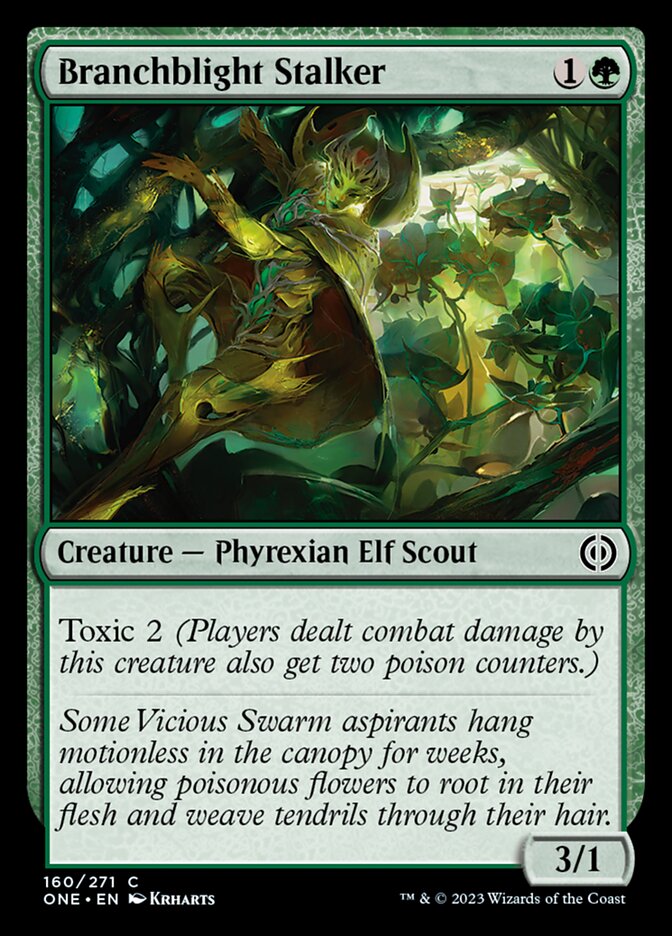
Rating: 2/10
2-drops are likely going to be very important, but 3/1s need a lot of help. Literally any creature your opponent plays in the first turns of the game will be able to trade for Branchblight Stalker.
The toxic isn’t even that relevant since it’s so easy to block.
Cankerbloom

Rating: 7/10
A 3/2 for two mana is already great. The power buff over a simple 2/2 is enough to help Cankerbloom trade up for most 3-drops and some 4-drops.
That would be enough to make it playable, but its ability pushes it way over the edge. Most notably for the first mode since there are quite a few artifact creatures in this set, and this is an answer to all of them.
Carnivorous Canopy

Rating: 3/10
Broken Wings is a fine card, even at sorcery speed. Carnivorous Canopy is basically just a sideboard card, but the number of artifact creatures in this set makes me think that you might want to main it sometimes as the format shapes up.
The proliferate ability is a nice bonus, but not enough to make you play it if you weren’t going to otherwise.
Conduit of Worlds
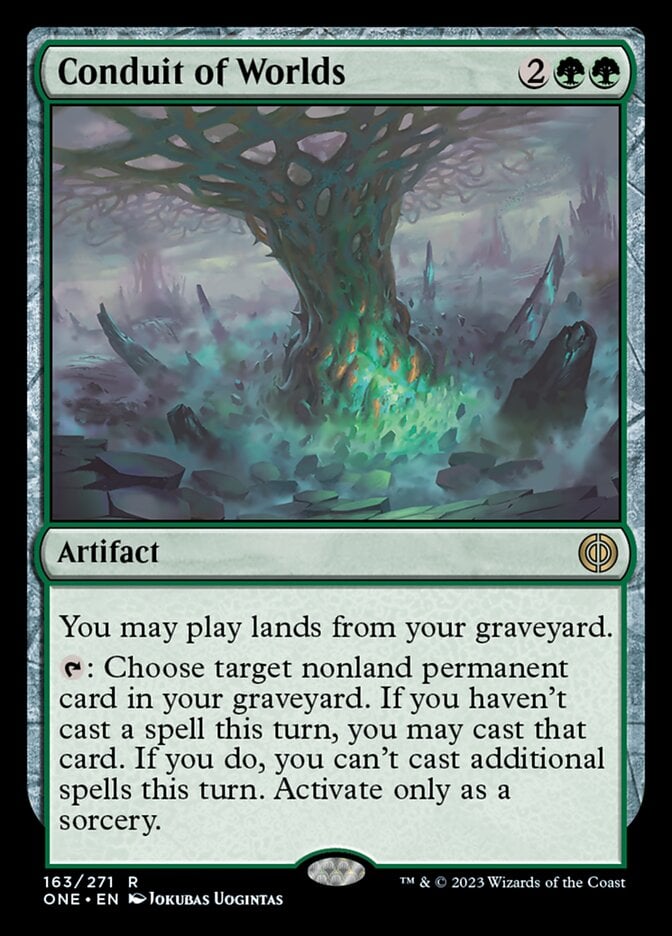
Rating: 2/10
Crucible of Worlds would be straight-up unplayable, so we’re not paying any attention to that side of Conduit of Worlds. I’m quite interested in a card that lets you basically flashback a card every turn. The only problem is that you have to spend four mana on this and then you get to start using it on future turns.
My instincts say this is far too slow, but the potential is there. It makes for a good sideboard card against slower matchups, but it might just stop there.
Contagious Vorrac

Rating: 6/10
We’ve come quite a way since Centaur Courser. A 3/3 that usually draws you a card is very strong, especially for just three mana. That card may only be a land, but that guarantees your land drop for the following turn.
You can always fail to find and choose to proliferate instead, and sometimes your board will be set up such that that’s the better option. Contagious Vorrac is excellent value no matter what you’re picking and I’d want to draft as many of these as I could find in any green deck.
Copper Longlegs
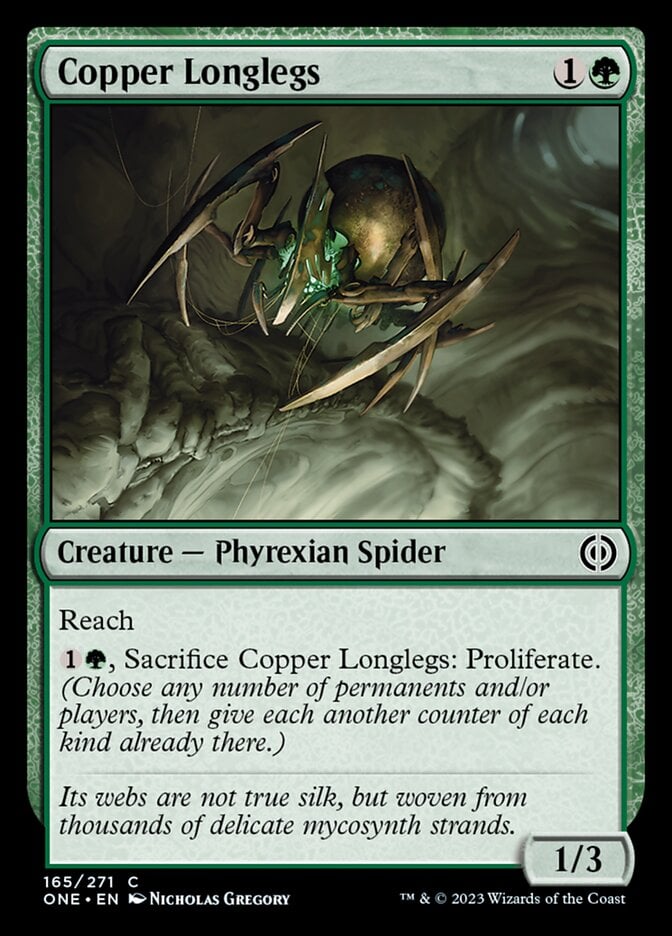
Rating: 2/10
Copper Longlegs isn’t doing it for me. Proliferating isn’t really worth a whole card, and a 1/3 reach for two is nowhere near big enough to make much of an impact. It’s also not like you can sacrifice this in response to removal since no one is going to spend a removal spell to kill it in the first place.
I think it’s just awful, so I wouldn’t recommend putting it in your main decks.
Evolved Spinoderm
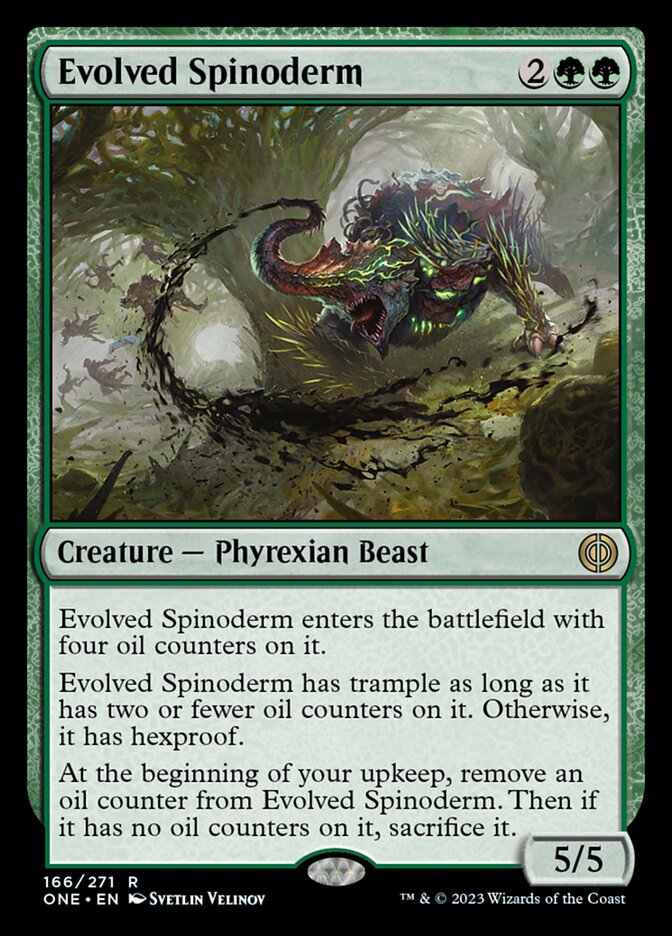
Rating: 6/10
Much like Archfiend of the Dross you can use proliferation and oil counter synergies to keep Evolved Spinoderm going and are reasonably well-rewarded for doing so. I don’t especially want to play this if it’s just going to die in a few turns, but having trample on the last couple makes it really hard for your opponent to ignore.
I can’t wait to set up a situation where this has two oil counters and I add a third at instant speed in response to a removal spell. Gotta love that free value.
Evolving Adaptive
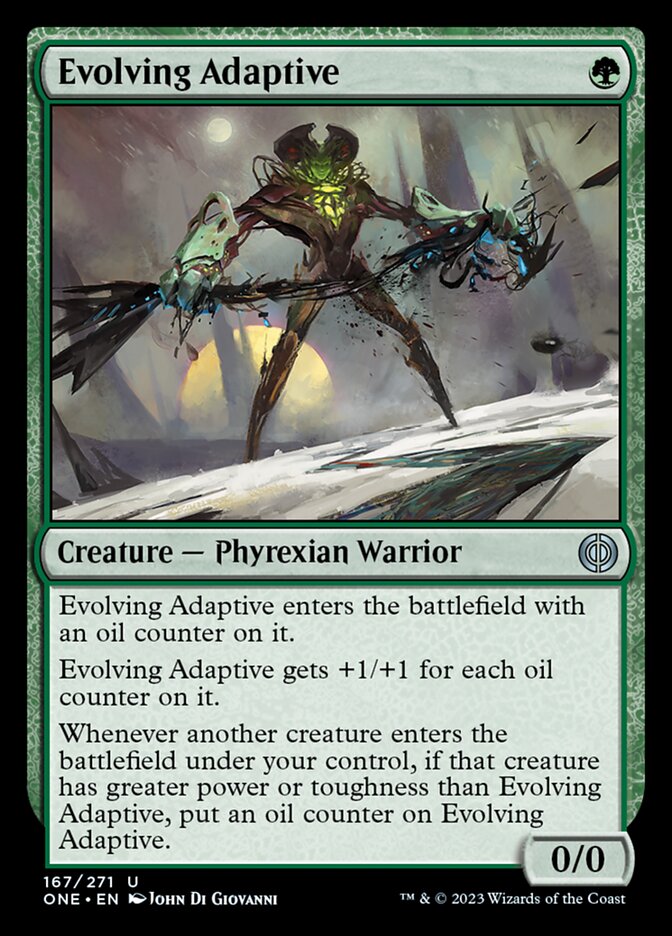
Rating: 6/10
You’ve got to love the pun work on show here, as Evolving Adaptive is a creature that basically has the keyword evolve. It’s functionally the same as Experiment One which was an incredible card in its day, but we have access to oil counter manipulation and proliferation in this set to really make it shine.
Expand the Sphere

Rating: 2/10
Cartographer's Survey was a terrible and unplayable card. Expand the Sphere at least has a little saving grace in that you can fail to find lands and choose to proliferate instead.
I don’t know if you really need or want to cast a double proliferate for four mana given that proliferate has been tacked onto a bunch of spells, but it could work in the right situation for sure.
Green Sun’s Twilight
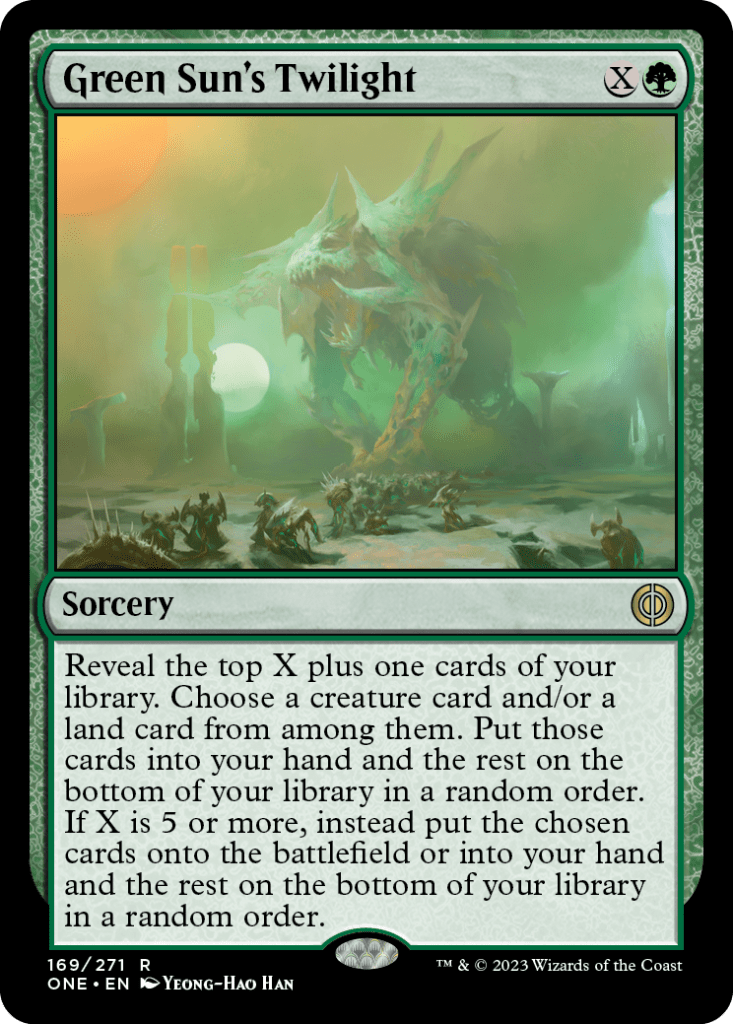
Rating: 1/10
It’s already difficult to run draw spells in modern Limited sets, let alone running one that has a chance to miss. There’s not much worse than casting Green Sun's Twilight for, say, four mana and only hitting a land. Worse yet if you cast it for six or more cards, looking for a free creature, and you only get a 2-drop.
While this looks like it will be a solid constructed card, I think there are too many risks for this Twilight to be worth it in Limited.
Ichorspit Basilisk
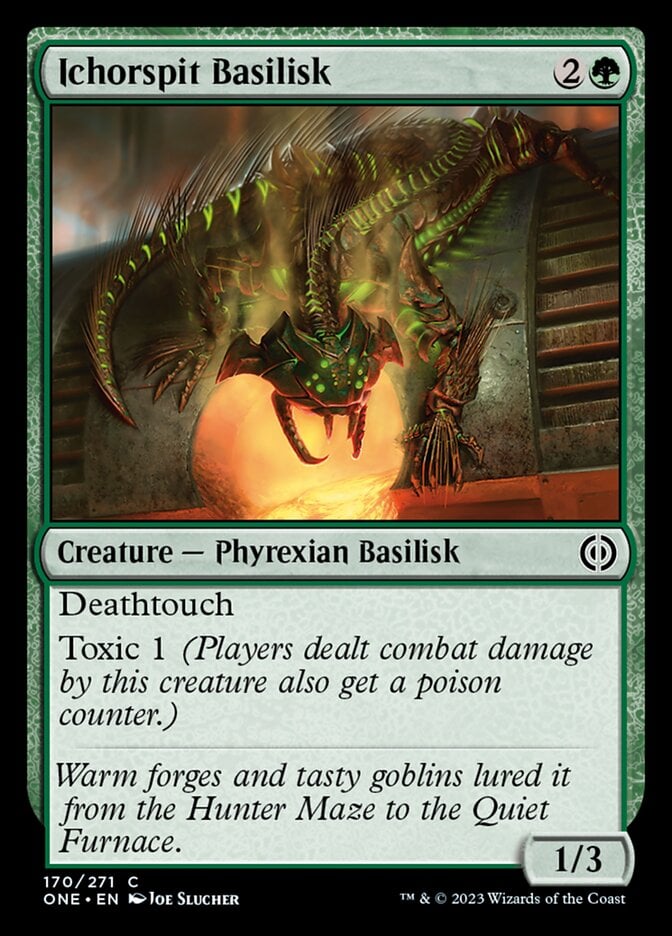
Rating: 4/10
I like Ichorspit Basilisk. It’s annoying to block, but toxic often makes you want to. It’s good on defense.
Nothing bad I can say about it really.
Incubation Sac
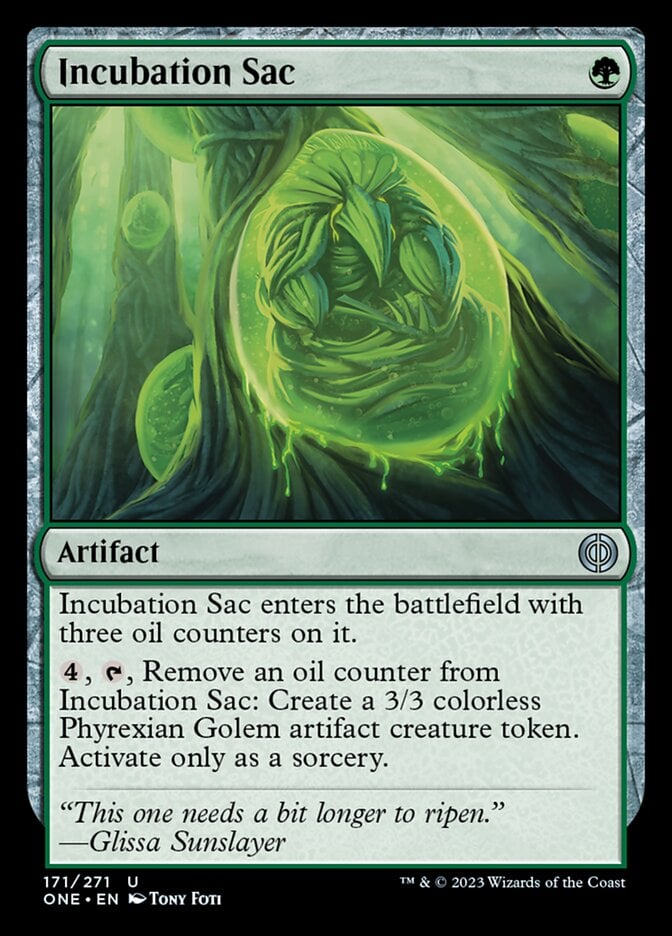
Rating: 5/10
There was a time when a card like Incubation Sac would be absolutely broken. These days, not so much.
Four mana is a lot to pay to make a 3/3 token, even if you can do it over and over again. The steady stream of tokens could be game breaking in slower matchups and you can add more oil counters to keep them going. But the mana cost of doing so is too high for it to be good in the faster matchups.
Infectious Bite
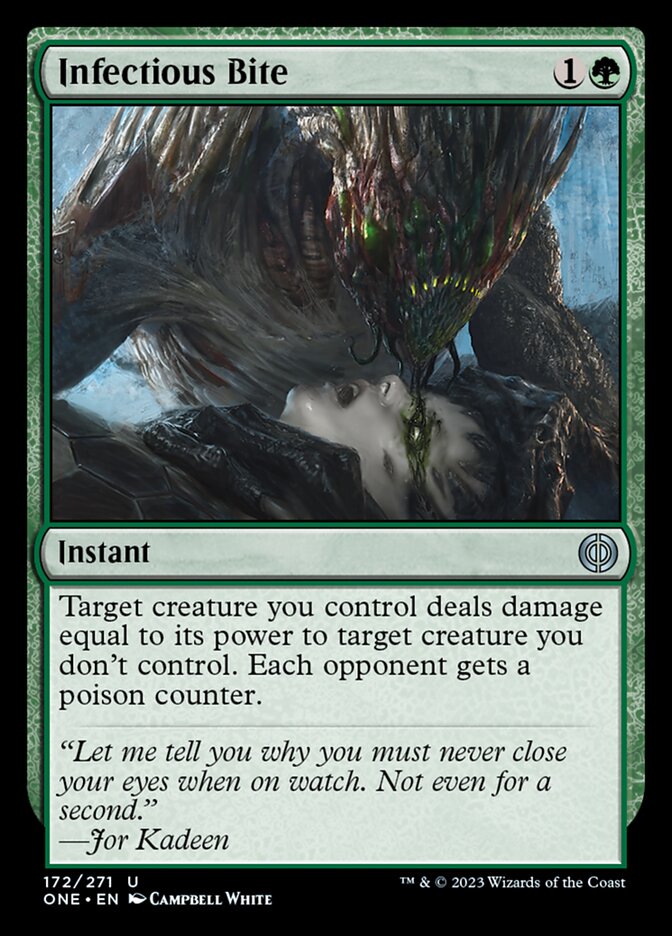
Rating: 6/10
These “bite” spells are always good to see. Green needs good removal and Infectious Bite is more than good enough for it. The extra poison counter is a very good bonus to see, but you don’t need to care about poison for this to be a premium green removal spell.
Lattice-Blade Mantis
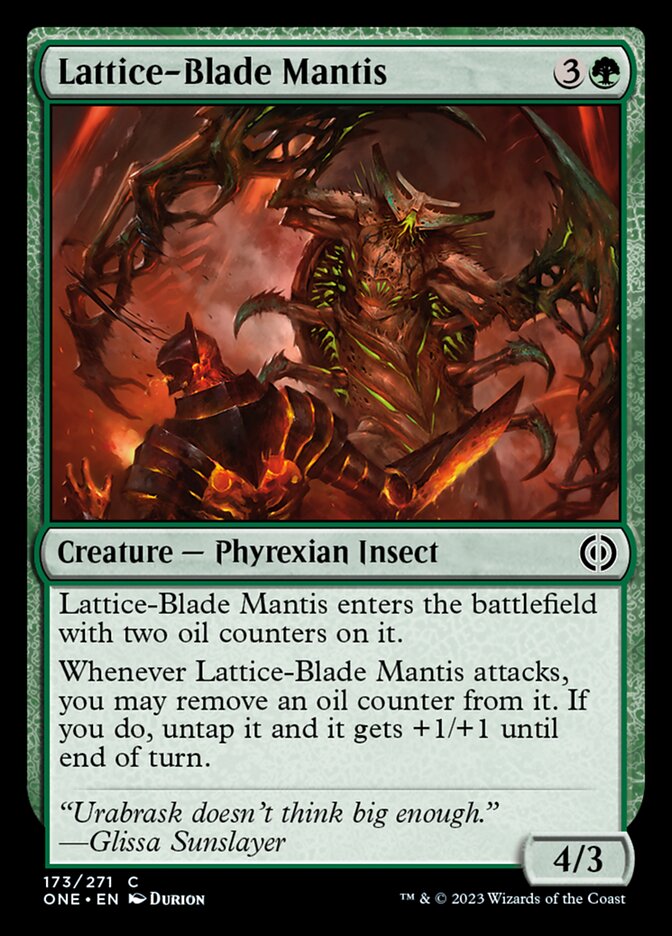
Rating: 5/10
Lattice-Blade Mantis can get really absurd. It’s basically just a 5/4 with vigilance for four mana. It only gets two shots at doing that, but if you’ve done that twice then it’s presumably done its job and your opponent is nearly dead anyway.
Maze’s Mantle
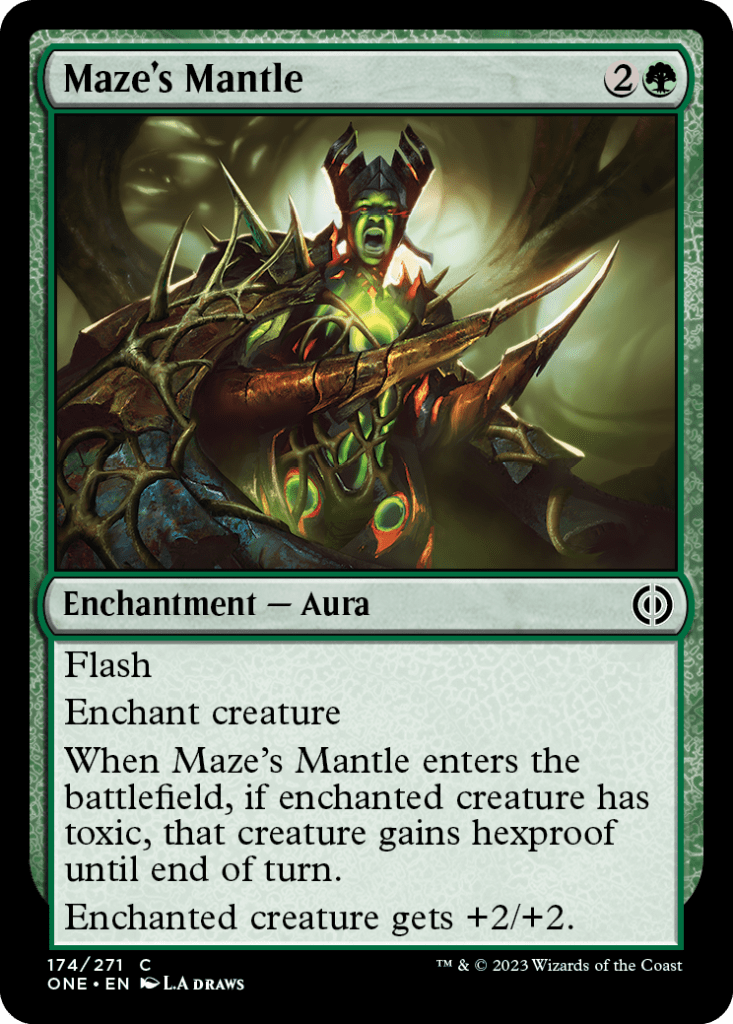
Rating: 3/10
I’m typically a fan of combat tricks like Maze's Mantle. The worst part about tricks is that they get used up, but if they stick around and continue providing a buff then that gives them extra functionality.
The hexproof option is a nice bonus to see over the standard Feral Invocation, but it’s likely too conditional to elevate it beyond just an average combat trick.
Nissa, Ascended Animist
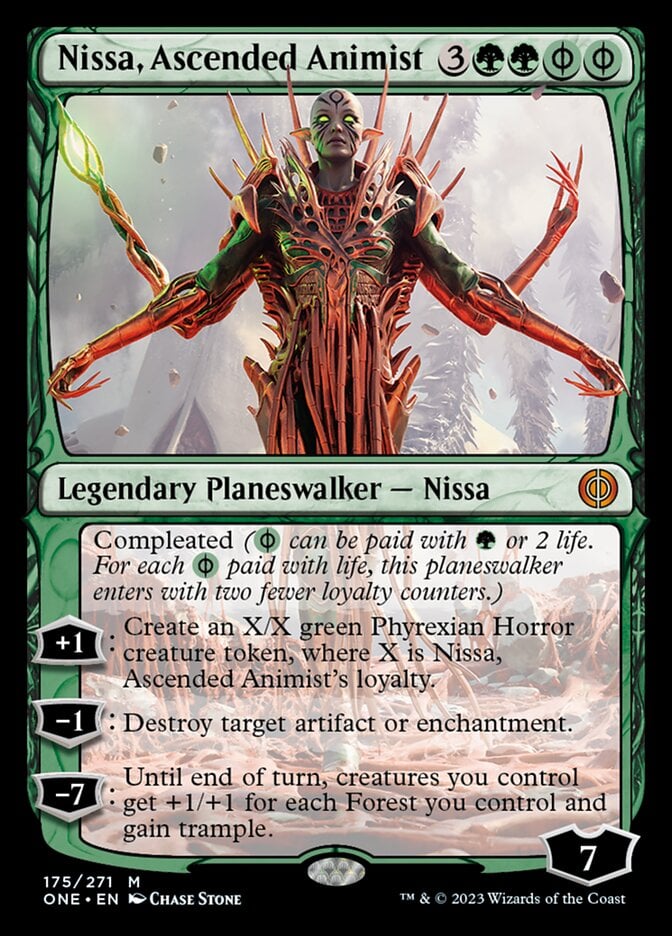
Rating: 10/10
On five mana, Nissa, Ascended Animist’s +1s to make a 4/4 token. Six mana gets you a 6/6 and seven mana gets you an 8/8. All of these are excellent modes to be casting this on.
From then on it makes a free token turn after turn and those tokens should still be big enough to make a big impact on the board even if Nissa takes a hit or two. Destroying an artifact is also very relevant with all the artifact creatures roaming around.
You even have the mode of casting this on seven mana and just using its -7 right away for a big Overrun effect. Everything here adds up to an exceptionally powerful planeswalker, and one that I’m honestly scared to have to play against.
Noxious Assault
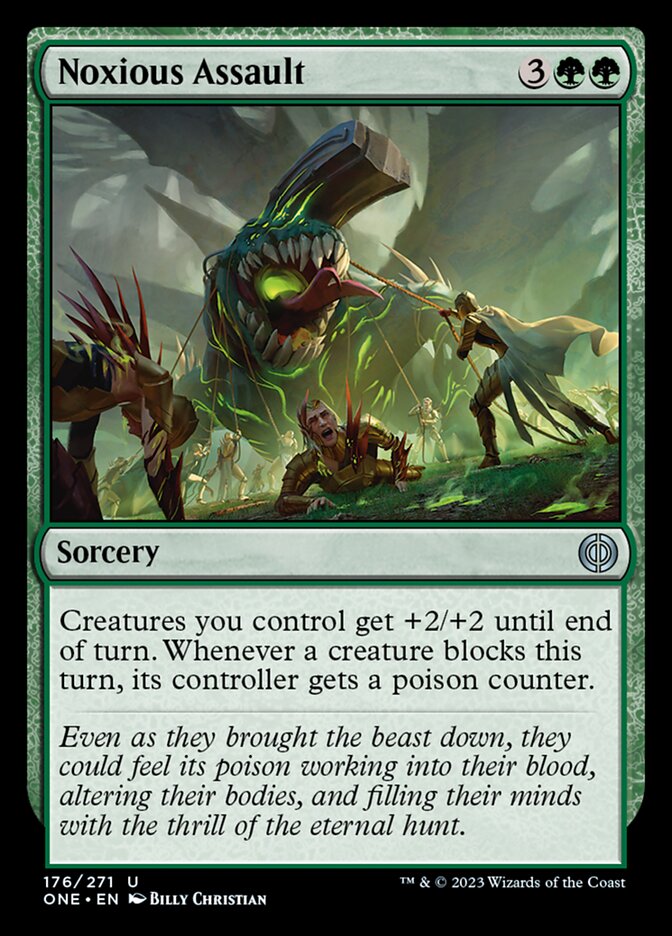
Rating: 2/10
Noxious Assault isn’t exactly Triumph of the Hordes. Your creatures can all still get chump blocked, and picking up a couple poison counters is often not enough to dissuade someone from doing that.
Granted there are definitely going to be some situations where this wins the game because your opponent is too close to losing on either life or poison, but it’s not worth running an otherwise bad card just for the narrow situations where it might do something.
Oil-Gorger Troll
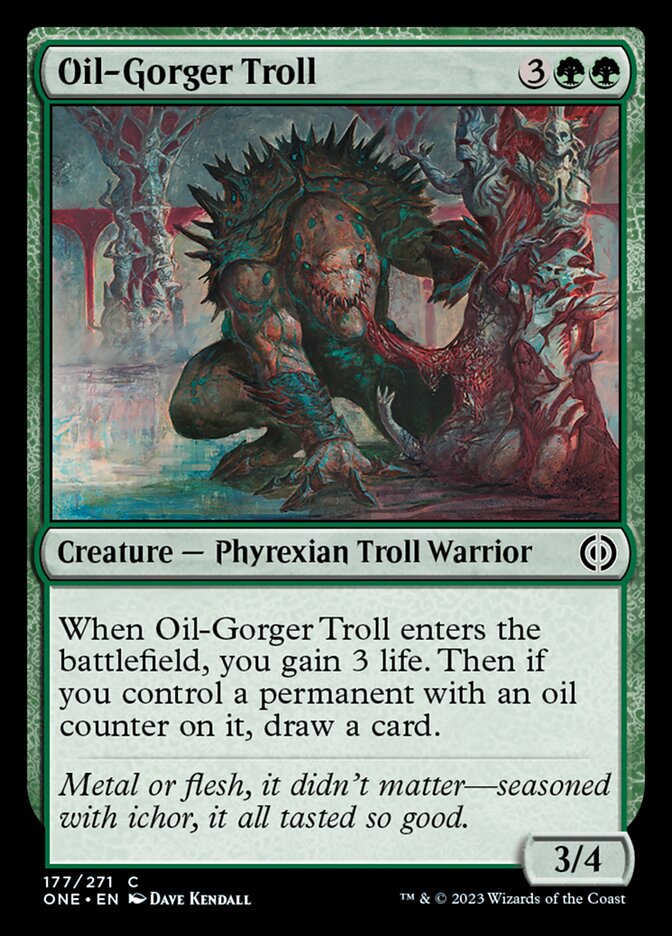
Rating: 6/10
You have to have plenty of oil counter cards in your deck before playing Oil-Gorger Troll, but when you do it’s absurd. Yeah, a 3/4 for five is pretty below rate, but add in three life and a whole extra card and you have a really powerful card.
Paladin of Predation

Rating: 3/10
Toxic 6 is a pretty huge ability, and the unblockability combined with that turns Paladin of Predation into an absolute house. My biggest complaint is that it’s too vulnerable to just fall prey to a cheap removal spell at seven mana, which loses you a huge amount of tempo.
7-drops aren’t that easy to cast in the first place, so my inclination is to assume this is below average until I’m proven otherwise.
Plague Nurse
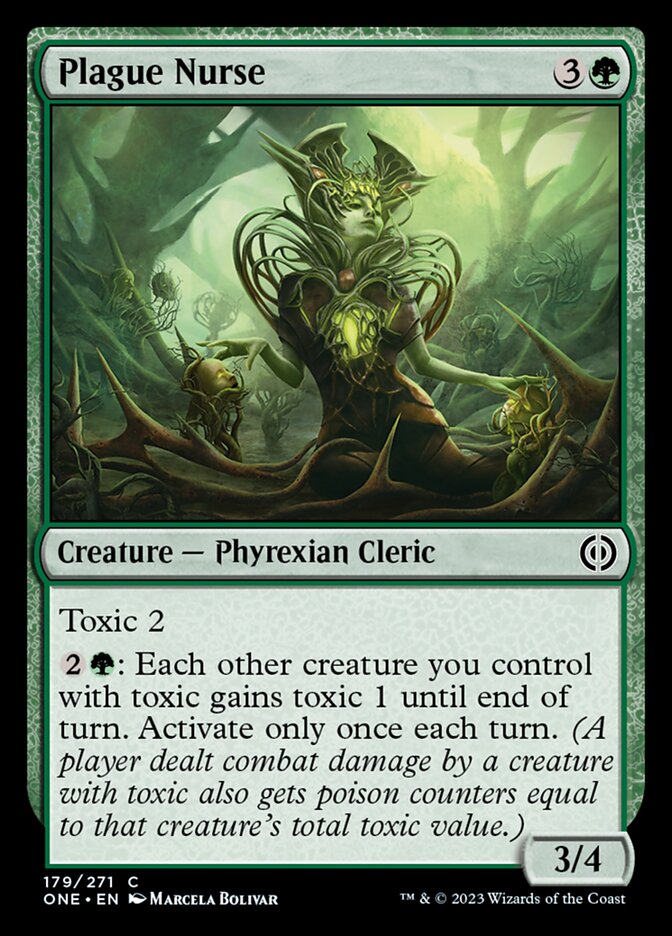
Rating: 4/10
Plague Nurse is a nice reasonably-sized creature and the activation isn’t great, but definitely a useful bonus to have. It’ll be hard to get into combat with, and toxic 2 plus the potential activated ability can really punish players who can’t afford to block it.
Predation Steward
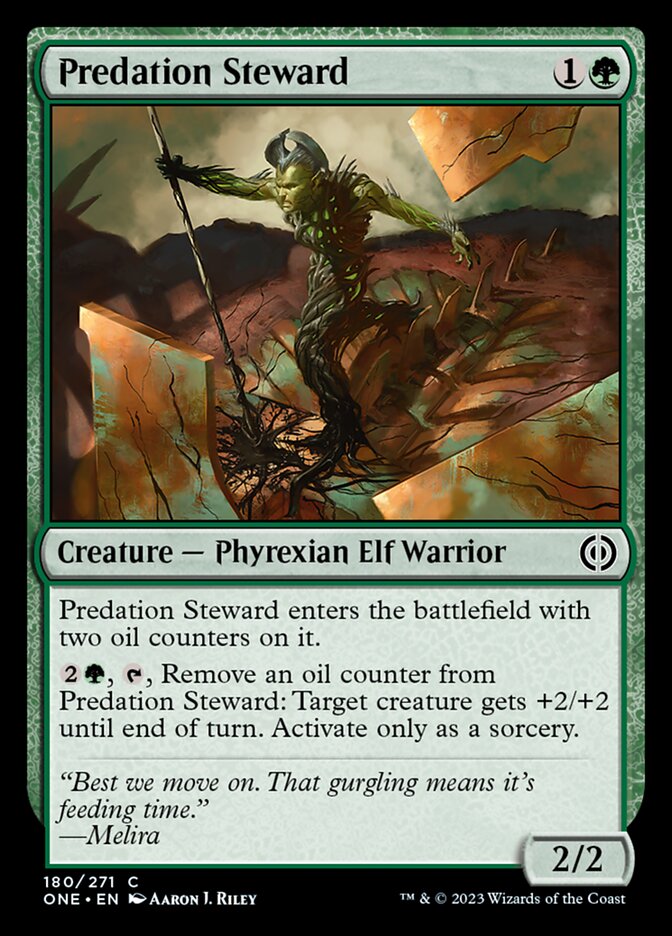
Rating: 4/10
Predation Steward was so close to being the best green common, but then they added the line “activate only as a sorcery.” Still, there’s nothing bad about the card.
2-mana 2/2s are solid and its ability is relevant at all points of the game, so you’ll definitely play it and it’ll be quite strong.
Rustvine Cultivator
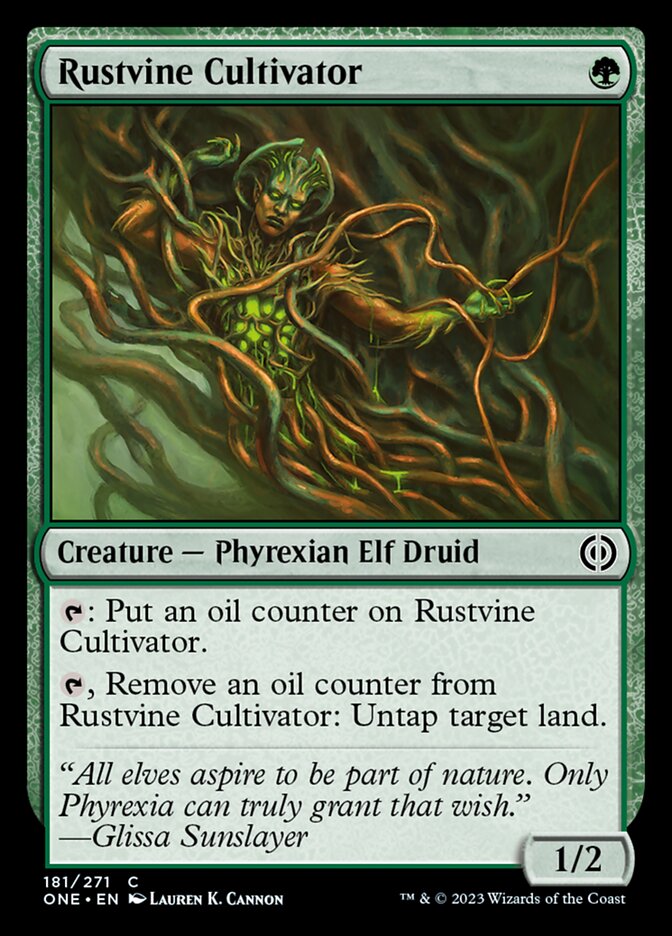
Rating: 4/10
A 1-drop mana dork that taps for mana every other turn is pretty slow, but still a mana dork that can do some work. You can even pile on extra oil counters on turns where you don’t need extra mana.
Rustvine Cultivator isn’t all that exciting, but I think looks like a solid roleplayer for a few strategies.
Ruthless Predation

Rating: 6/10
We may prefer our green removal to be bite not fight spells, but Ruthless Predation still ticks all the right boxes. +1/+2 is a big enough stat boost to let your creature survive the fight, and it helps some creatures punch up a bit too.
This is the common removal spell that we get for green, which makes it a very high pick if you know that’s what you’re drafting.
Skyscythe Engulfer
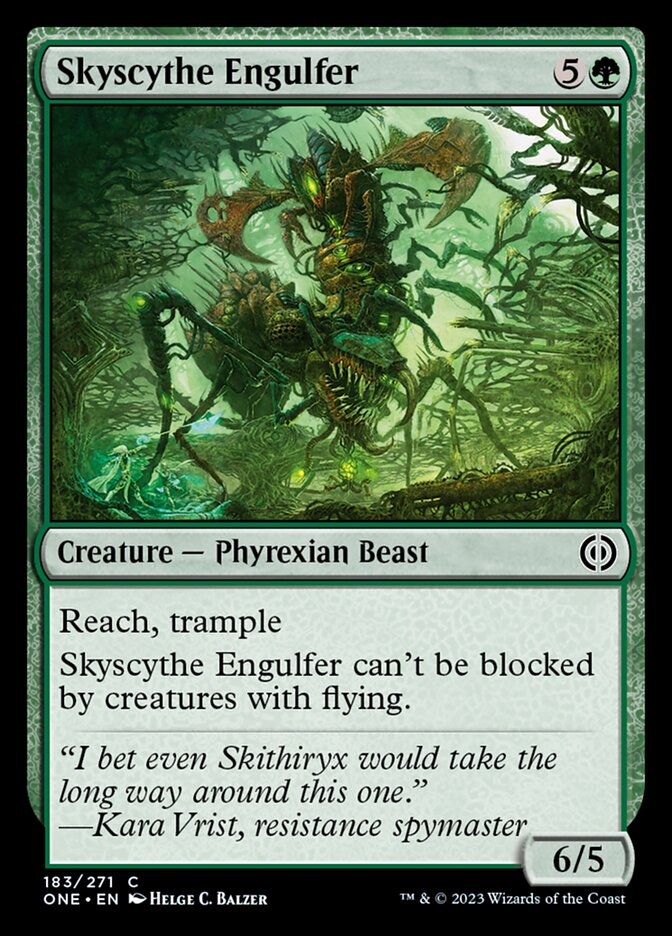
Rating: 4/10
Our traditional 6-drop fatty has evolved a fair bit with this latest incarnation. We’ve had variants on Honey Mammoth for a while now, and they’ve been great. Going back to a glorified Colossal Dreadmaw isn’t likely to make any headlines though.
Skyscythe Engulfer is big, it’s dumb, and it hits hard. It’s good on offense and defense. It dies to cheap removal without giving you any advantage in return so its power is fairly limited. But it tops your curve and is something common that you can ramp into.
Sylvok Battle-Chair
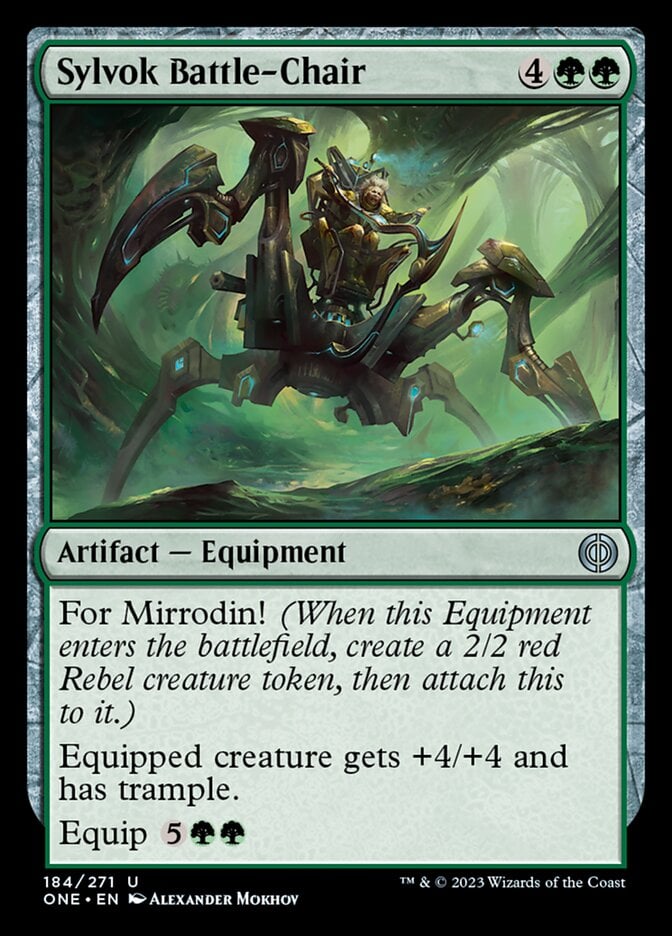
Rating: 5/10
Easily the best card name in the set. Don’t need to say anything else. Sylvok Battle-Chair is a 6/6 trample for six that leaves behind a ridiculous equipment when it dies.
Though seven mana is a lot to equip it up again you do basically get it for free, so no complaints from me.
Thirsting Roots
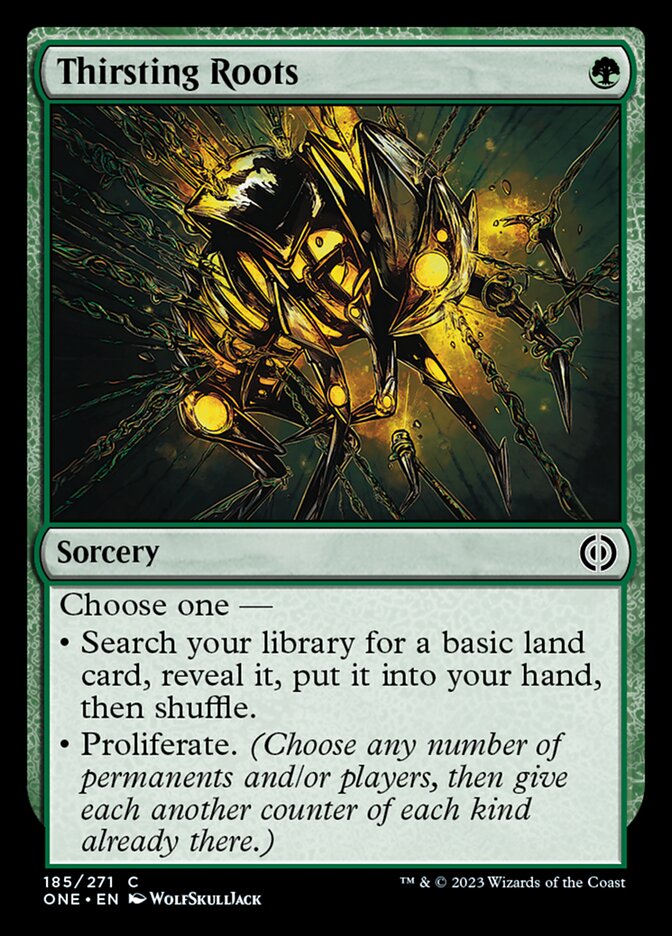
Rating: 3/10
I’m still not sure that proliferating is worth spending a whole card to do. It might be sometimes, but Thirsting Roots is a Lay of the Land with a little upside.
That’s still something we’re very interested in, especially if you have a dubious splash to help fix for.
Thrun, Breaker of Silence
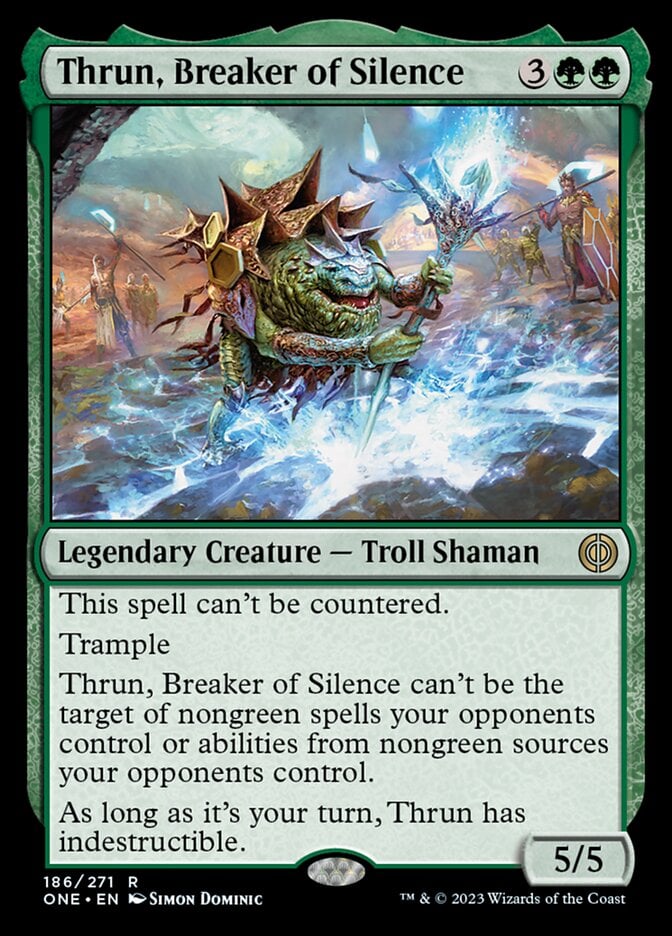
Rating: 10/10
Thrun is back! As someone who enjoys green decks I imagine I’m happier than most. This new Thrun is the real deal and has a lot of bases covered with his abilities. Can’t be countered, pretty much can’t be targeted, and is also indestructible when it matters.
And in an improvement over the old version, Thrun the Last Troll, Thrun, Breaker of Silence has trample. The Last Troll’s biggest flaw was that it was so hard to deal with but could still be chump blocked indefinitely. This new one doesn’t care and is just so hard to deal with that it’ll single-handedly win a lot of games without even trying too hard.
Titanic Growth

Rating: 2/10
Well, it’s a combat trick. Titanic Growth doesn’t do much more than that. +4/+4 is very solid and this definitely has its uses, but this card has been little more than just a mediocre trick that you’ll sometimes begrudgingly play every time we’ve seen it in the past.
Tyrranax Atrocity

Rating: 4/10
4/4 is a little bit on the small side for a 5-drop haste creature without at least some form of evasion. That said, toxic 3 is a lot to come swinging out of nowhere and that surprise factor is going to immensely help Tyrranax Atrocity’s power level.
Tyrranax Rex

Rating: 9/10
Oh boy, has Tyrannax grown up. We saw it come back in Scars of Mirrodin as Alpha Tyrannax, and now it’s the king.
While seven mana is by no means trivial to get to, the impact Tyrranax Rex will have on the board is outstanding and well worth the price. The ward ability is key because it makes it very easy to manufacture a situation where you drop this and it’ll be guaranteed to hit on the same turn.
There just won’t be anything your opponents can do to stop it when an 8/8 with haste and trample comes swinging out of nowhere. And the relatively high toxic value means they’ll be dead very quickly on top of that.
Tyvar’s Stand

Rating: 4/10
Don’t sleep on casting Tyvar's Stand for X=0 just to give hexproof and indestructible. This sells it for me, making it basically a split card of Tamiyo's Safekeeping and Untamed Might. Both are quite narrow in application, but the combination should be pretty decent.
Unnatural Restoration
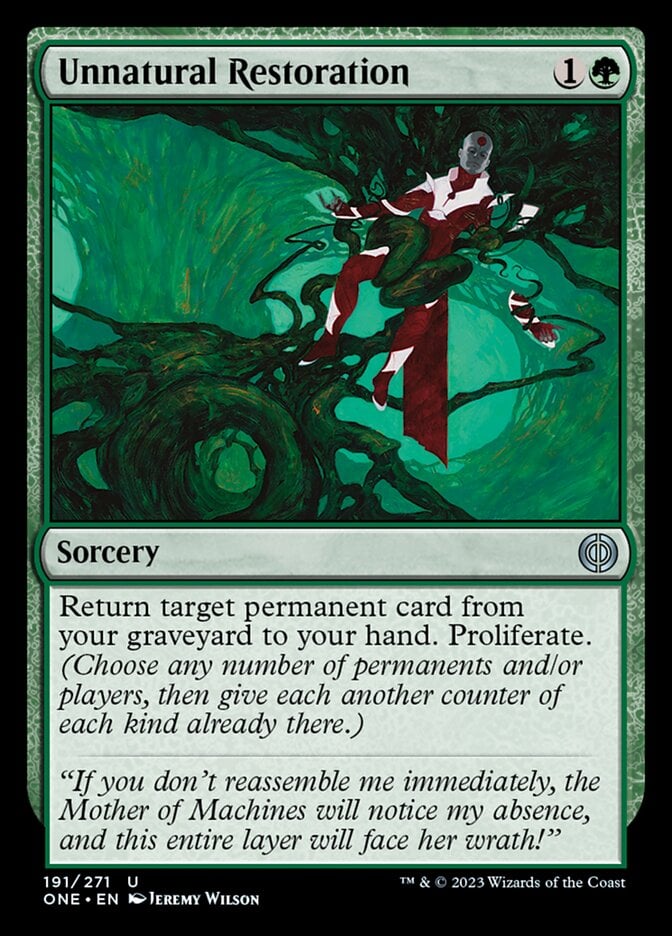
Rating: 3/10
Nature's Spiral is just not good enough for Limited. Tacking on a free proliferate does make Unnatural Restoration a fair bit better, but only enough to make it a below-average playable as opposed to completely useless.
Venerated Rotpriest
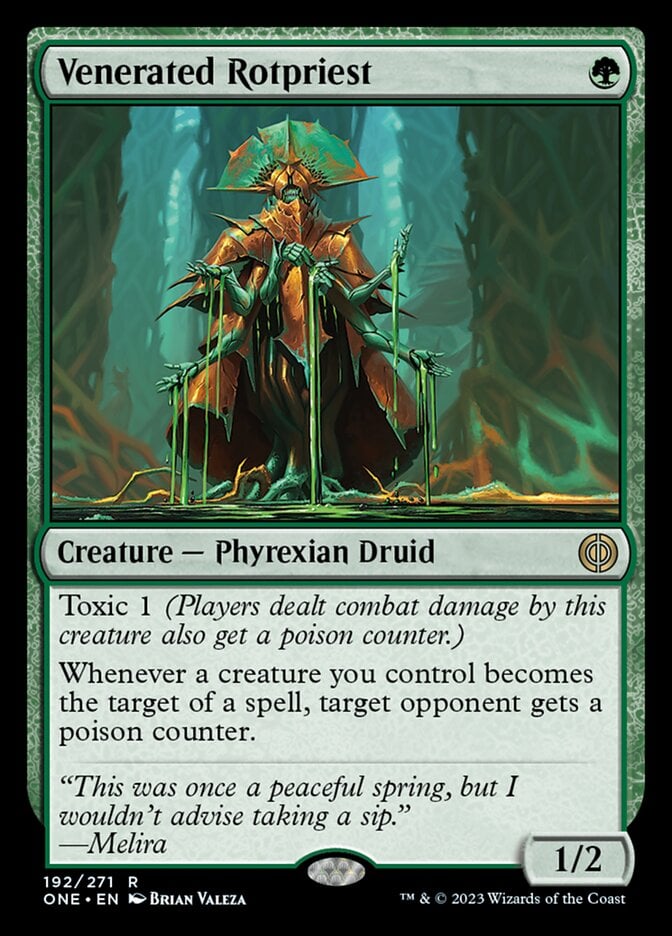
Rating: 5/10
I like that Venerated Rotpriest triggers off your own spells, which is of course what it’s designed to do for Modern infect decks.
As far as Limited is concerned it’s still a 1-drop with toxic, which is probably good enough on its own. The trigger isn’t likely to come up too much but it’s not unreasonable to expect a couple counters from it in a game.
While this looks incredible for Modern, it’s about average for Limited.
Venomous Brutalizer
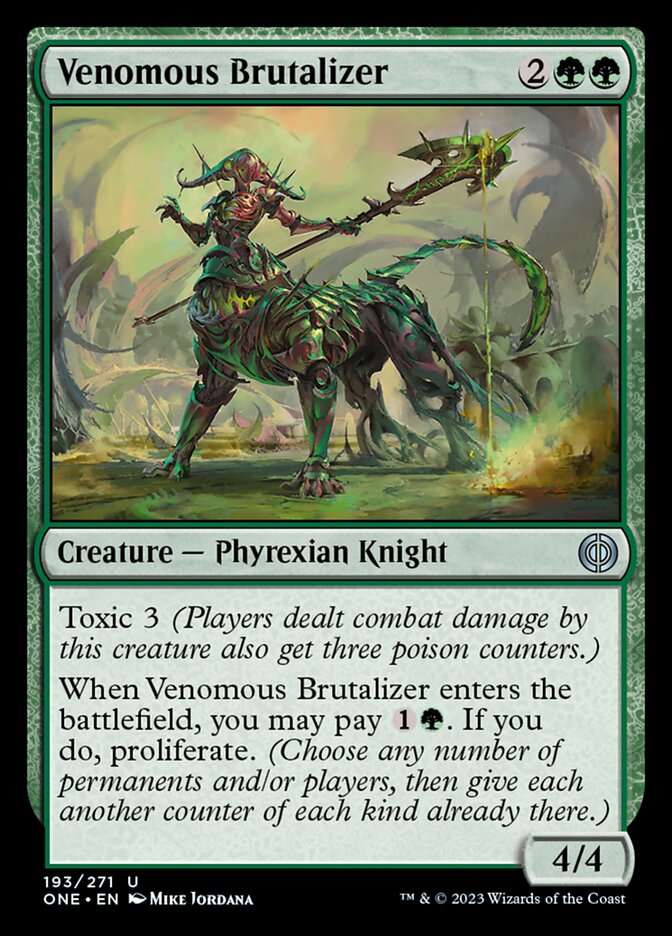
Rating: 6/10
A 4/4 with toxic 3 for just four mana is absurdly good. Paying an extra two to proliferate isn’t that good and not what we’ll be focusing on with Venemous Brutalizer, but it clearly can be effective when you draw it in later turns.
Running this out on turn 3 or 4 and protecting it a little looks like a surefire way to get your opponent dead, quickly. Only a couple hits from this should be enough to win you the game because proliferation can finish the job from there.
Viral Spawning
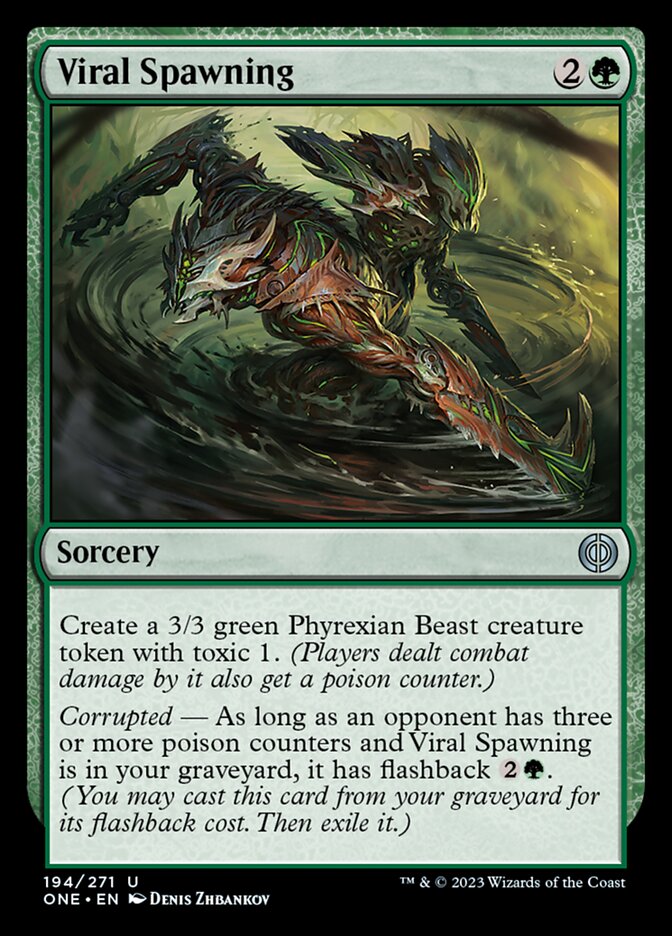
Rating: 7/10
Call of the Herd was once a broken Standard card. While times have evolved a lot since the early 2000s, getting a pair of 3/3s out of one card is still huge for Limited.
Viral Spawning even comes with toxic for a nice little bonus and it’s also costed very aggressively so that both tokens feel worth it. I love this, and it’s exactly the kind of value I like to see.
Zopandrel, Hunger Dominus
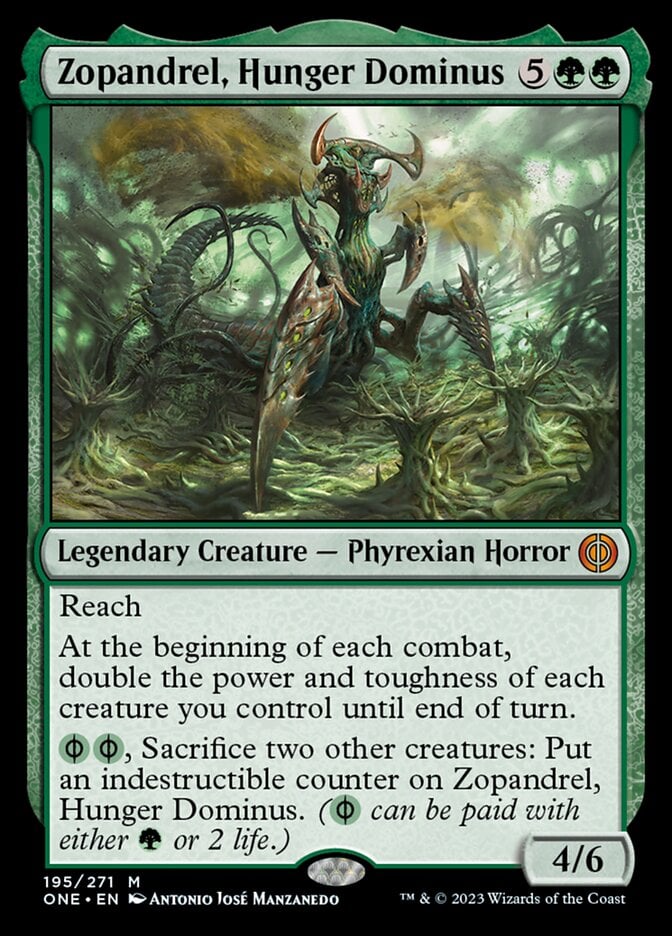
Rating: 9/10
Costing a whole two mana more than any of the other domini, Zopandrel, Hunger Dominus is actually the most impactful of the lot for Limited. Seven mana is a lot and it might hold the card back a fair bit, but doubling the power and toughness of all of your creatures at the start of every combat is an insane ability to have.
This looks small but it’ll be an 8/12 when it matters, which is hardly anything to sniff at. But even turning your 3/3s into 6/6s and so on will make an enormous impact on the game whenever it’s cast.
Sacrificing two creatures to make it indestructible is a pretty hefty cost, but you can do it for zero mana. It’s probably worth it given how powerful the rest of the card is.
Multicolored Cards
Atraxa, Grand Unifier
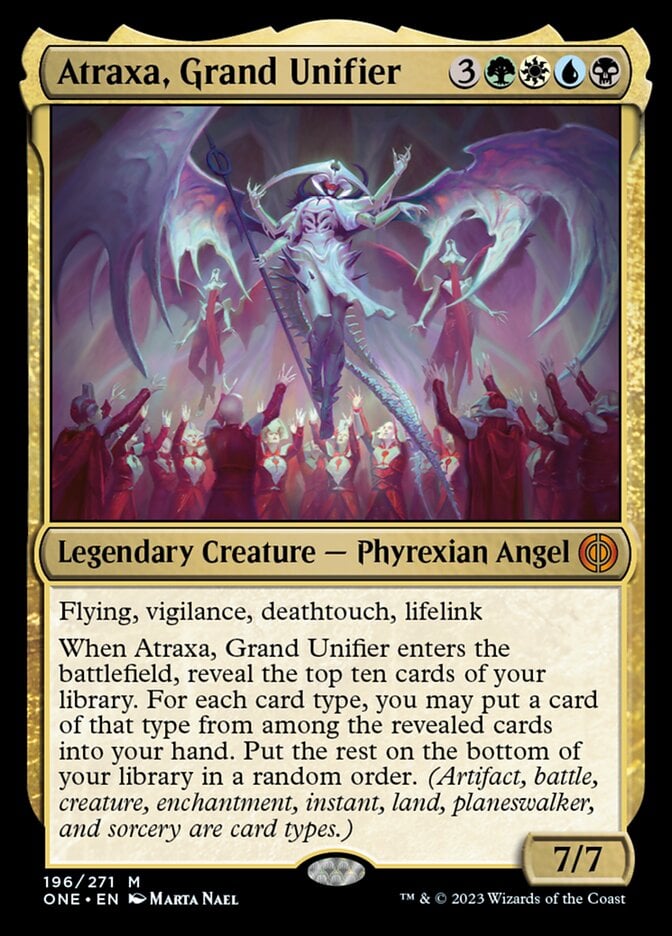
Rating: 9/10
I wrote Atraxa, Grand Unifier’s review before the full set, panning it because it looks wildly uncastable. But then the full set dropped and I had a look over it.
“Oh, Prophetic Prism is a sweet reprint! Phyrexian Atlas looks fairly good. Oh nice, we get Terramorphic Expanse back! Wait a minute…”
Turns out the set has quite a lot of actively good mana fixing at common. It’s still not trivial to cast Atraxa, but the tools are there if you can get them and it’s well worth the effort. Its trigger will draw you at least two cards every time, and surely I don’t need to tell you that a 7/7 with flying, vigilance, and lifelink will dominate literally every board you play it onto.
You have to find the fixing or Atraxa is still uncastable, but the reward is massive if you do.
Bladehold War-Whip
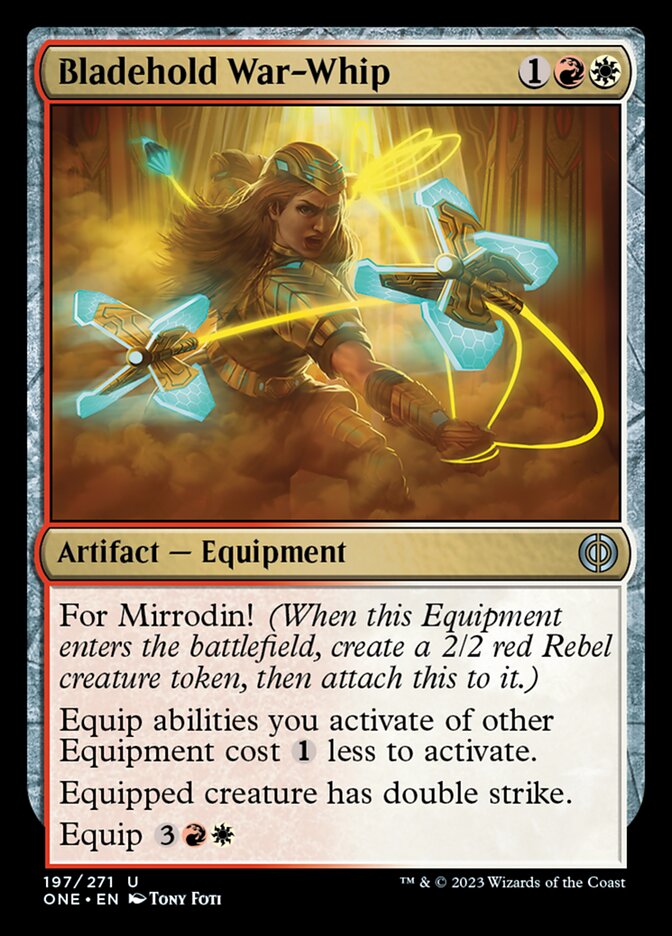
Rating: 7/10
We normally have to jump through a few hoops just to get to a 2/2 double strike for three. Not only does Bladehold War-Whip give it to us right away, but it leaves behind a powerful equipment for free.
While this doesn’t do a lot in supporting a for Mirrodin! Draft archetype because we don’t care too much about reducing equip costs, you don’t need to build your deck around it for it to be a great card.
Cephalopod Sentry
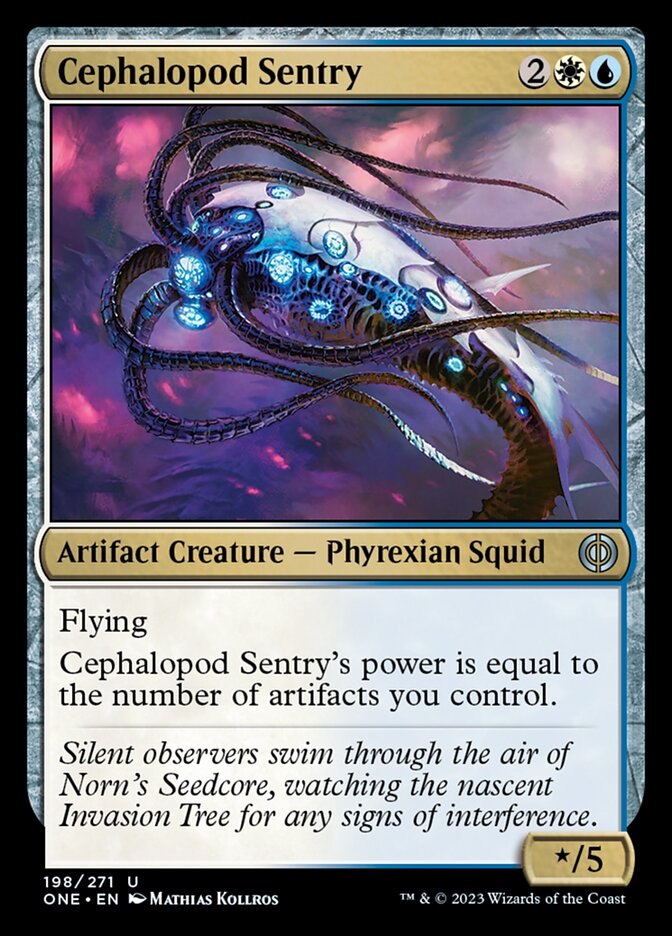
Rating: 6/10
All Cephalopod Sentry is is a big vanilla flier, but we’re all for that to be honest. It’s a 1/5 already and I don’t think it looks too hard to get this into the realms of 4/5 or 5/5 in a vacuum.
There are a lot of cheap and replaceable artifacts, which we’ll get to shortly, plus the white/blue archetype cares about having artifacts. So the colors themselves are full of useful ones. It should be easy to enable and once this starts getting high enough then it needs to be killed, which makes for an all ‘round good creature.
Charforger
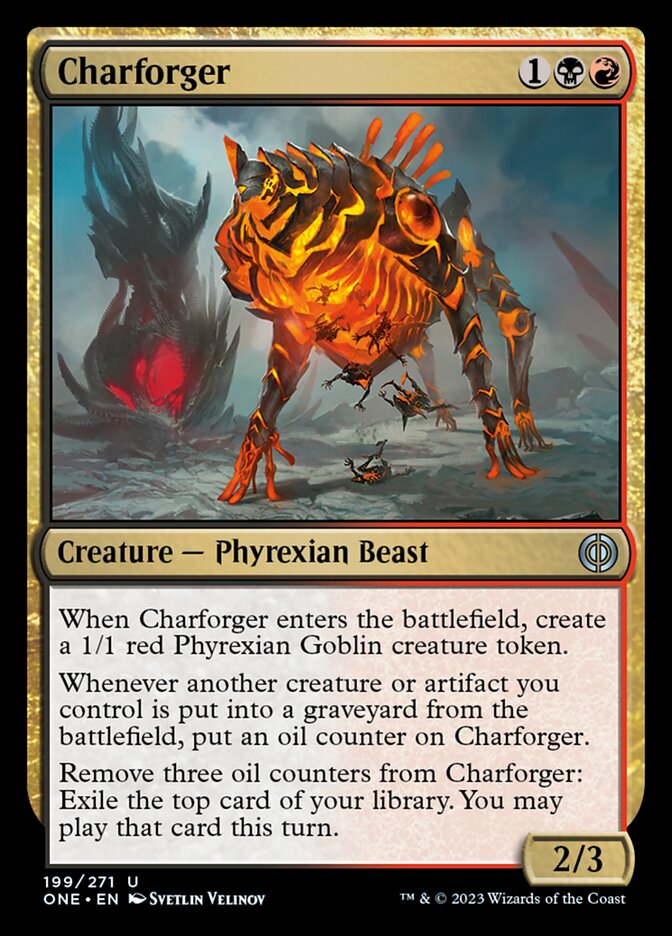
Rating: 7/10
You had me at a 2/3 and a 1/1 for three mana. While Charforger looks like a fairly weak trigger, the upfront creature is a very good deal. You’ll also see that it might be a lot easier to trigger than it looks at first when I get to the Skullbomb cycle of artifacts in a bit.
Cinderslash Ravager
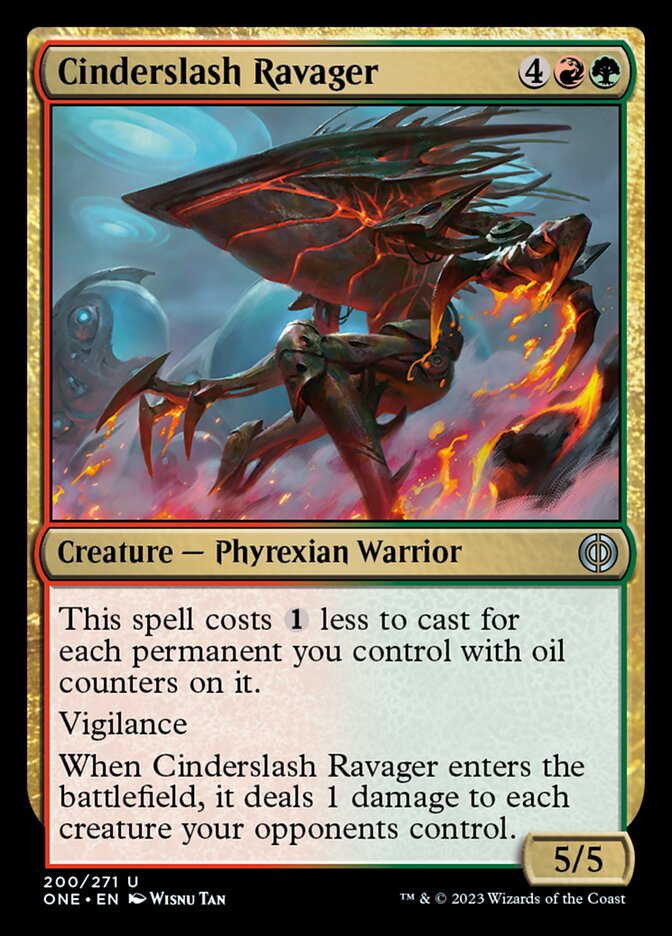
Rating: 6/10
You only need to make Cinderslash Ravager cost one or two mana less to feel like you’re getting a great deal. It’s absurd if you can get the full cost reduction of four.
There are enough incidental oil counters lying around that this should slot nicely into any red/green deck, but sometimes you’ll be dedicated to oil counters and this will feel like getting away with a hell of a lot.
Ezuri, Stalker of Spheres
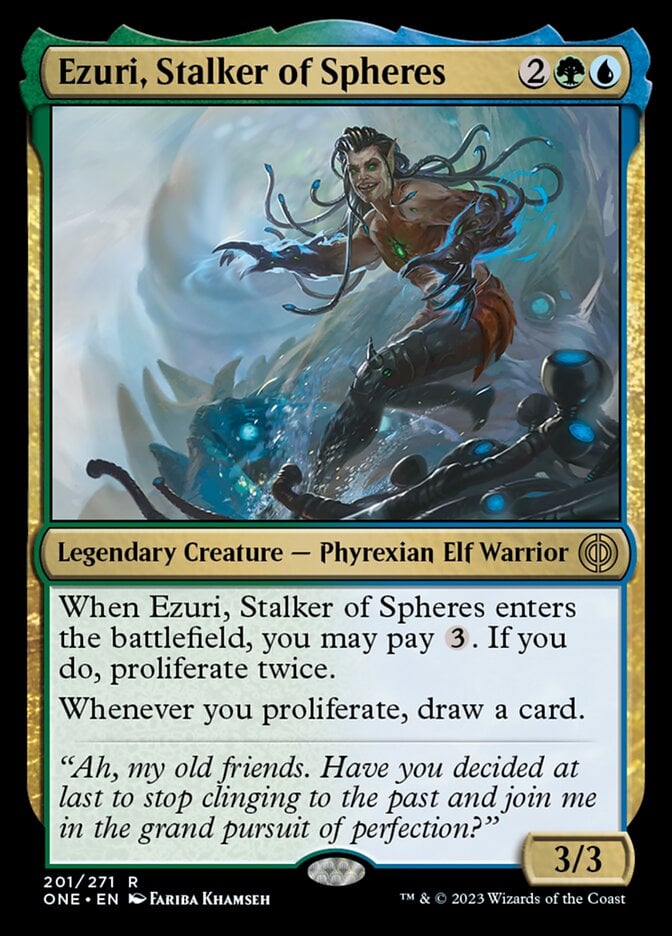
Rating: 7/10
Yep, the new Ezuri draws cards. I love it. Casting Ezuri, Stalker of Spheres for the full seven mana makes it an overcosted Mulldrifter and that’s all I need to know. Yeah, you also proliferated some counters, big whoop. You draw more cards! Then future proliferation nets you more cards.
I’ve said a couple times so far that proliferating doesn’t seem worth a whole card of value. Well, as turns out, now it actually is!
Glissa Sunslayer

Rating: 9/10
First strike plus deathtouch is one of Magic’s holy grails of absurd combinations that almost never comes up.
To put it into context, you need to block Glissa Sunsalyer with four creatures, each of whom are large enough to kill her by themselves, if you want to kill it in combat. Or you need a first strike creature of your own. It’ll largely be attacking completely unimpeded, which is a problem seeing as the bare minimum it’ll do when connecting is drawing its controller another card.
Glissa is even good on defense because very little can attack past it without dying first. It does still die to removal and there are a few other ways to neutralize its abilities, but the fact that you have to deal with it presents a really awkward scenario that sometimes you just won’t be able to work out.
Jor Kadeen, First Goldwarden
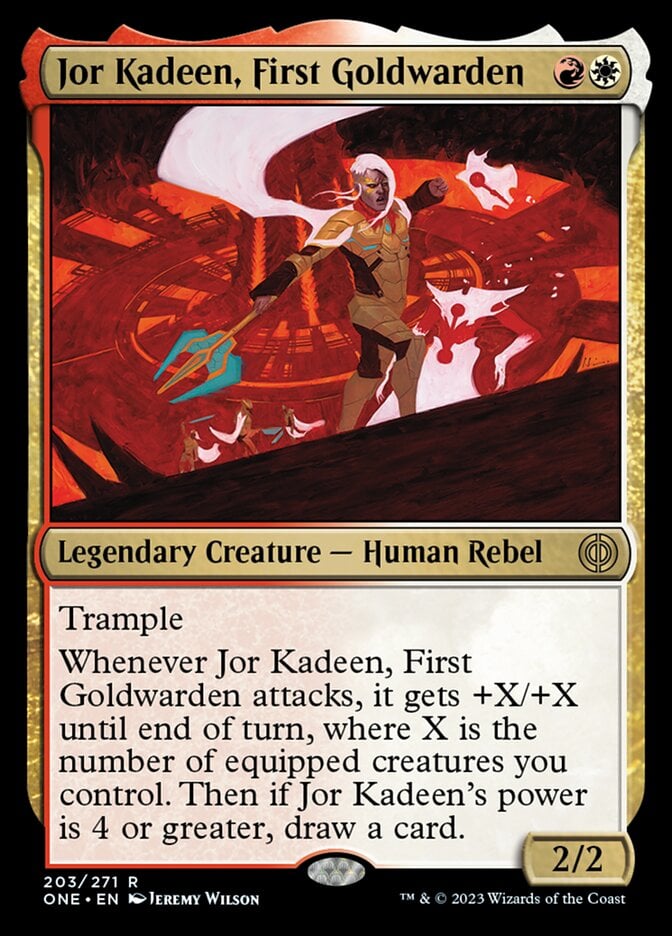
Rating: 7/10
Jor Kadeen, First Goldwarden requires a little bit of effort to get going, but it’s not that hard to get it big enough to draw a card thanks to the for Mirrodin! mechanic. You can even cheat it a little bit by having it equipped with something and it’ll even count itself in this ability.
Equip it with a Vulshok Splitter, for example, and it’ll attack as a 5/3 and draw a card. Not to mention that trample goes really well on a creature that’s likely to get pretty big. It’s generally a great build around for this archetype and looks fun to try and make work.
Kaito, Dancing Shadow
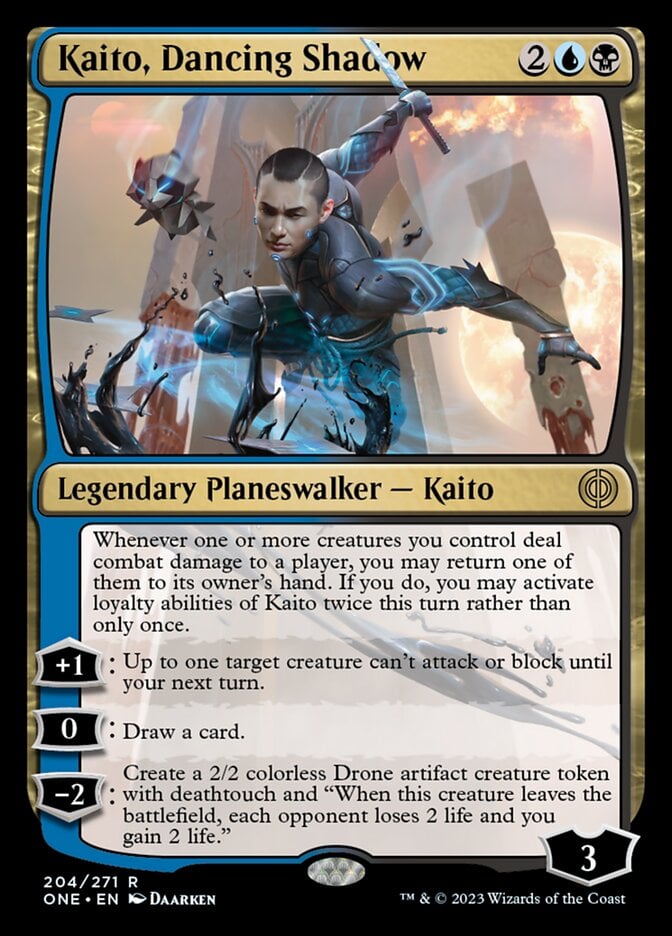
Rating: 10/10
There are so many incremental synergies with Kaito, Dancing Shadow that it’s hard to know where to start.
The first and most obvious one is that you can use its trigger to bounce creatures with ETB triggers, draw a card with its 0 ability, and then replay the creature for value. You can use the +1 to guarantee a creature getting through while essentially being removal for it too.
The tokens it makes are very strong and they trade up for creatures while netting you some life. Everything about Kaito is strong in Limited, and there are going to be games where it completely blows your opponent out of the water.
Here’s another scenario! Your opponent has two creatures, one is tapped because it attacked you last turn, the other was just played and is there to block. You play Kaito, +1 on the untapped creature, attack your creature into them, bounce it with Kaito’s trigger, and then -2 to make a drone that can block the other creature. Unbelievable.
Kaya, Intangible Slayer

Rating: 10/10
These rare planeswalkers are scaring me. They’re all just incredibly powerful.
Kaya, Intangible Slayer may be seven mana, but everything about it is insane. Hexproof on a planeswalker is just nasty, especially on one that starts on six loyalty and can +2 up to eight. Not to mention that +2 presents a six-point life swing in your favor. Six might even be more than enough loyalty to sit on so it also draws you two cards as a 0 ability?
Oh, and if there’s a big threat to deal with then Kaya also has the ability to exile that creature and give you a copy of it? Sure, it’s only a 1/1, but who cares? I’d have been stoked if Kaya’s ability exiled the creature and did nothing else!
If you’ve ever watched Luis Scott-Vargas do a Vintage Cube Draft then you might be aware how broken Fractured Identity is outside of multiplayer. But that’s just one of the modes on this ridiculous rare planeswalker?
I’ll say it again: unbelievable.
Kethek, Crucible Goliath
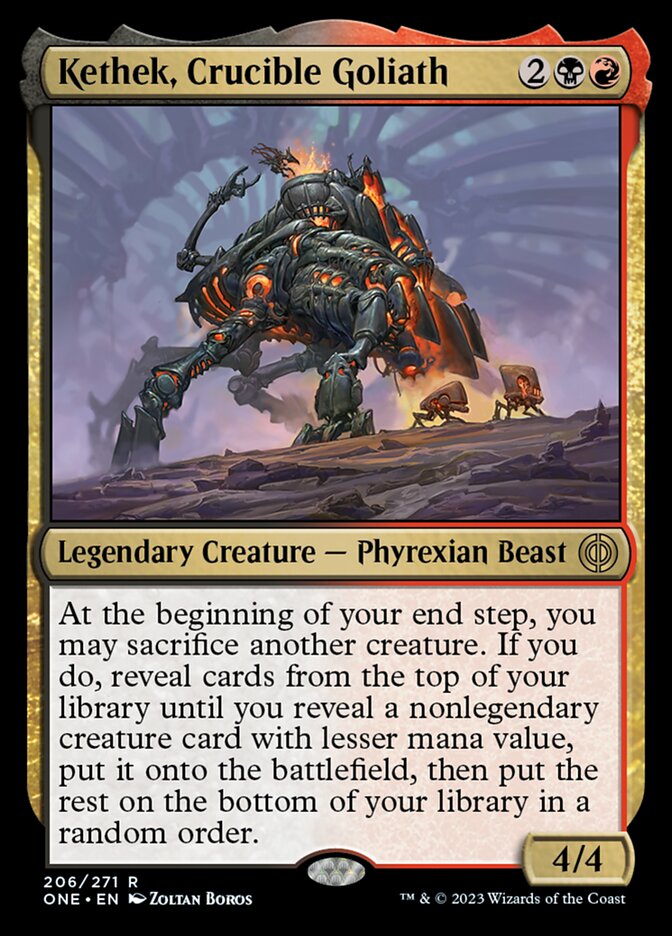
Rating: 4/10
“With lesser mana value” kills this for me. All Kethek, Crucible Goliath amounts to is sacrificing one of your creatures to turn it into a presumably worse creature. Why do I want to do that?
It triggers sacrifice synergies, can sacrifice creatures that are locked down by auras, and is good with Awaken the Sleeper. But that’s it? I just don’t get why this is a negative ability. If anything it should get something of greater mana value so I feel like I’m accomplishing something.
But no, it’s just bad unless you can do the specific things I’ve mentioned. It can at least be a well-costed vanilla creature until then.
Lukka, Bound to Ruin

Rating: 10/10
I think I particularly want to cast Lukka, Bound to Ruin for four mana as opposed to five. It’s basically identical to Garruk Wildspeaker in a very good way.
Playing this on four mana and immediately using its -1 to make a 3/3 Beast is a great opening play. Next turn its +1 lets you cast a 6- or 7-mana creature ahead of schedule. If you do cast it on five mana then that allows you to take full advantage of its big -4 ability, which has the potential to kill one or even two creatures depending on how big your creatures are.
At the end of the day Lukka is an extremely strong planeswalker with two modes that protect it from incoming damage and helps you ramp into huge creatures. It’s everything I love in a red/green planeswalker.
Malcator, Purity Overseer
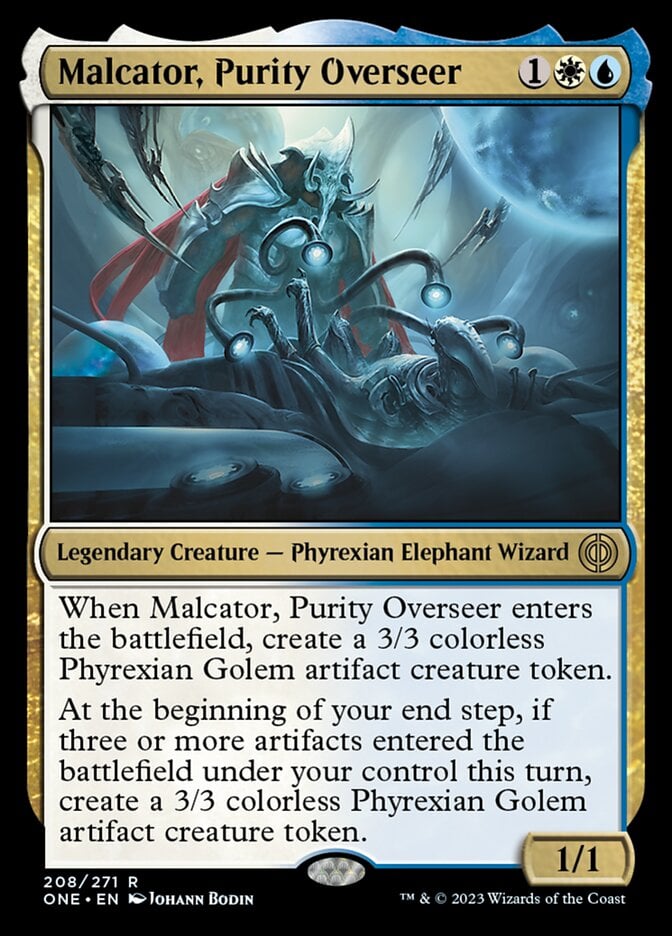
Rating: 6/10
I guess we’ve found the thing we want to be flickering. Malcator, Purity Overseer is excellent as just a 1/1 that spawns a 3/3 token at its base rate.
I don’t think the second ability is likely to happen, but there are enough free mites and cheap 1-mana artifacts in the set that it’s not exactly impossible.
Melira, the Living Cure

Rating: 6/10
Even before we get to the abilities, a 2-mana 3/3 doesn’t need to do much else to be worth playing. The safety net of saying you can only get one poison counter per turn makes it a lot easier to take hits from decks that are trying to poison you out.
You also get this sweet little Saffi Eriksdotter ability that lets you save one of your creatures by killing Melira, the Living Cure instead. It does quite a lot for a simple 2-drop, and you’ll be very happy to have it around.
Migloz, Maze Crusher
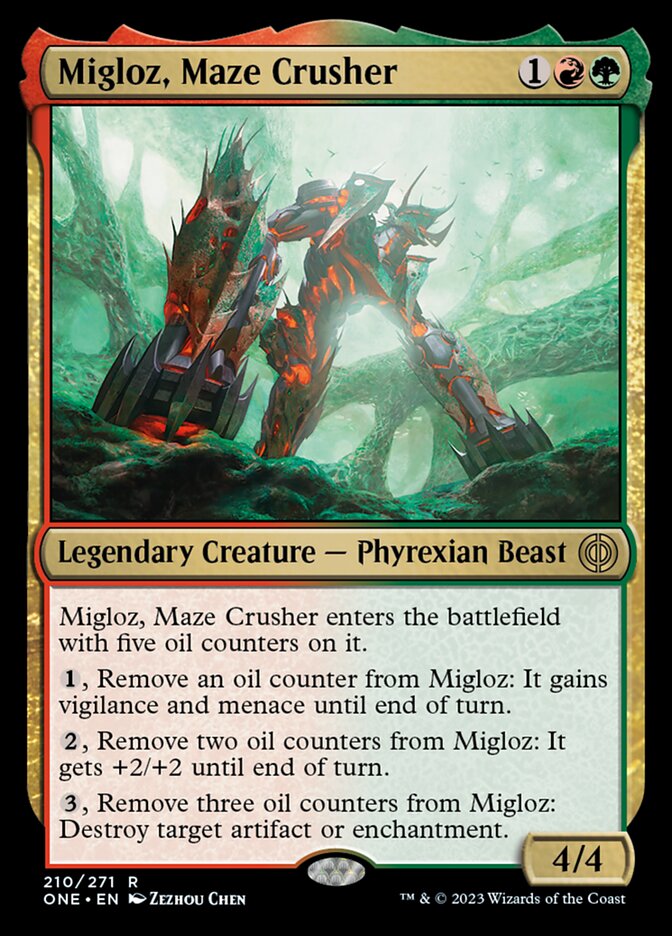
Rating: 8/10
Once again we start with an oversized creature for the mana we’re spending and get a pile of good upsides. I naturally want to be sparing with these oil counters just in case we can’t add more. Migloz, Maze Crusher’s best ability is the +2/+2 mode, so I’d want to make sure I always have the threat of activation available.
One thing that’s missing is trample, so adding a load more oil counters and making it gigantic is less applicable than I’d like. It still makes for an extremely strong threat that always threatens to be a 6/6.
Nahiri, the Unforgiving
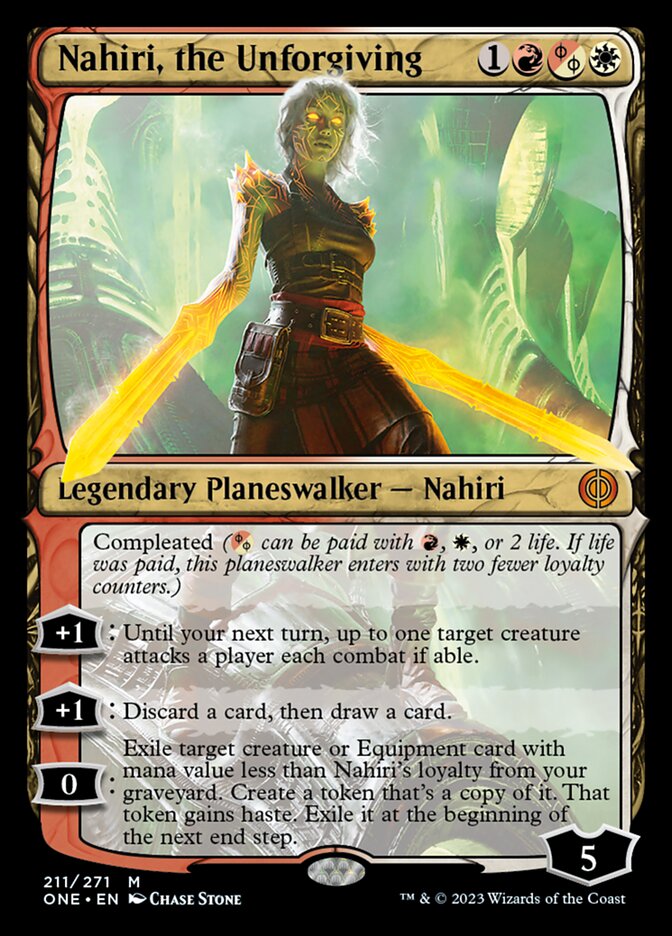
Rating: 4/10
Finally, a planeswalker that isn’t absurdly broken!
The main problem that Nahiri, the Unforgiving its relatively weak set of abilities.
While the first +1 does help protect it (one creature can't attack Nahiri), it doesn't really add any board presence or prevent multiple attackers.
Its 0 ability is capable of protecting it from an incoming attack, but that’s only if the creature or equipment you get can spawn a creature (which of course is very possible if you get something with for Mirrodin! on it).
Necrogen Rotpriest
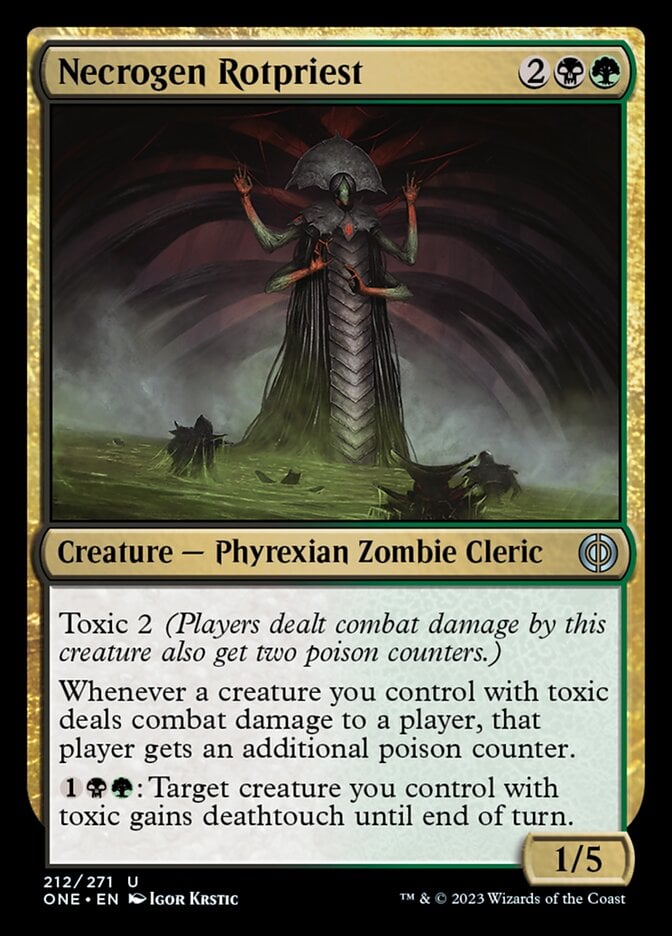
Rating: 7/10
Now Necrogen Rotpriest is something that benefits toxic creatures. Not only does it buff the toxic value of your creatures, it also helps them attack past any blocker without even doing anything. Just the threat of giving them deathtouch whenever you like is enough to dissuade potential blocks, but dealing extra poison damage means your opponent has pretty much no time to waste.
The Rotpriest also presents a massive threat when it starts to attack since five toughness means your opponent will have to send a really big creature to trade for it or else take three poison.
Ovika, Enigma Goliath
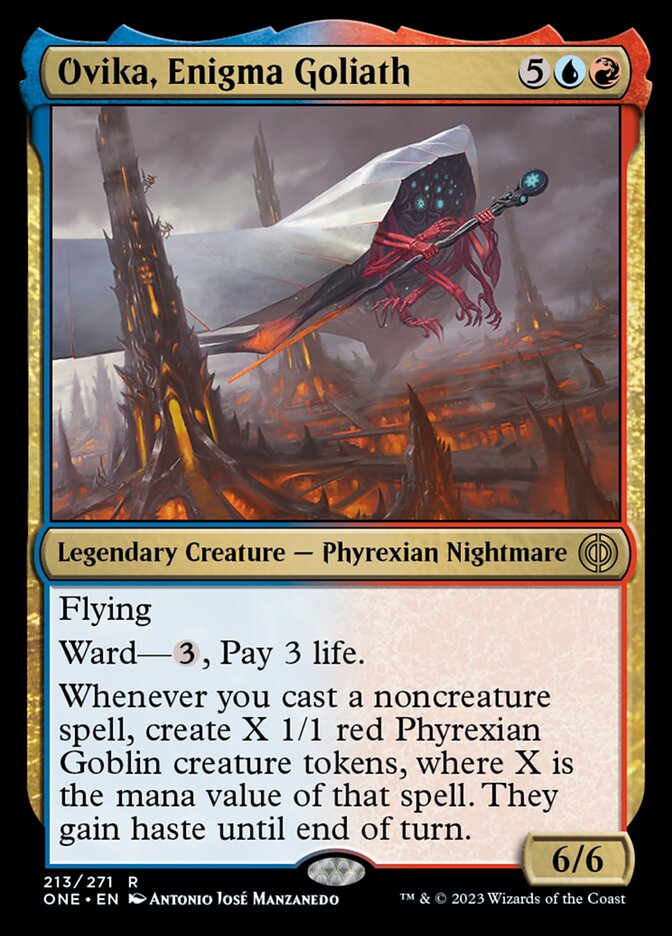
Rating: 6/10
Seven is quite a bit too much to want to cast Ovika, Enigma Goliath on. the trigger is absolutely disgusting if you do.
The ward is a little scary, but your opponent can happily just untap and pay the ward cost to kill it since you probably tapped out to cast this. 7-mana spells are very hard to cast in Limited so they need to immediately give you enough to make that cost worth it, which Ovika just doesn’t.
On the plus side the trigger is powerful enough to help you turn a game around very quickly if you’re fortunate enough to untap with it.
Ria Ivor, Bane of Bladehold

Rating: 8/10
Quick history lesson: Hero of Bladehold was one of the best cards back in Mirrodin Besieged. It was quickly identified as the best card in block constructed and became one of the best cards in Standard once Jace, the Mind Sculptor was banned.
Ria Ivor, Bane of Bladehold isn’t quite on the same power level since you have to jump through a few extra hoops just to get your 1/1 tokens, but it’s still very powerful. I like that you can play it before combat and immediately use its trigger to send something into combat that same turn and get you some tokens.
You basically give up tempo to create a bigger board presence by using this, which in many cases is going to be well worth it. Especially once it starts attacking and Battle Cry starts letting you hit for bigger amounts of damage.
Serum-Core Chimera
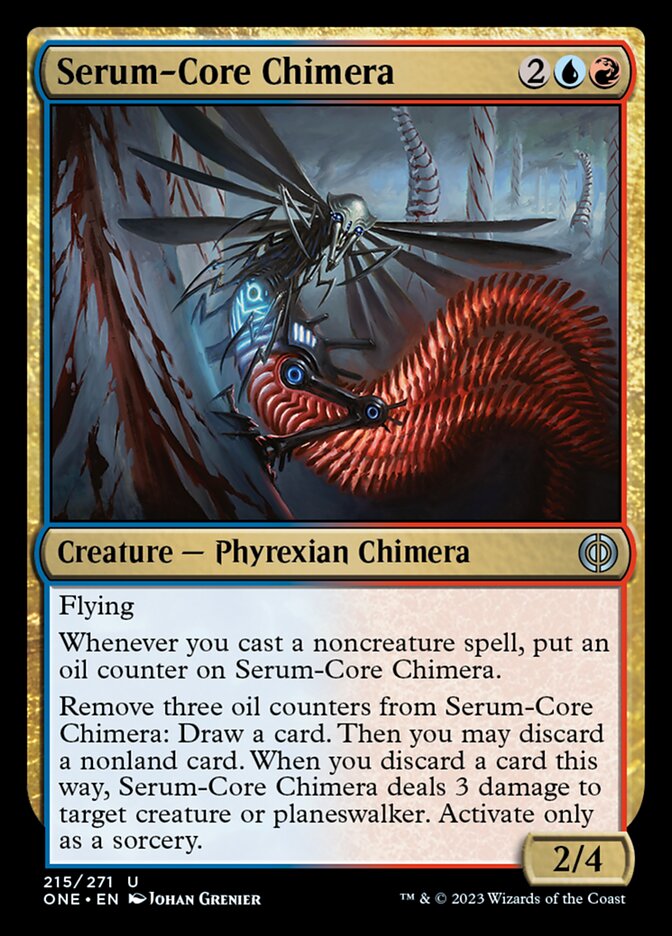
Rating: 7/10
I’m all for these new designs where you’re required to trigger multiple times before you get paid off, but you can supplement it through proliferation and so on. Drawing a card is one of the best payoffs you can get, and turning any nonland card into your hand into a removal spell will come in very handy too.
Serum-Core Chimera is the key build-around card that blue/red needs in order to compete with some of the other strategies.
Slaughter Singer
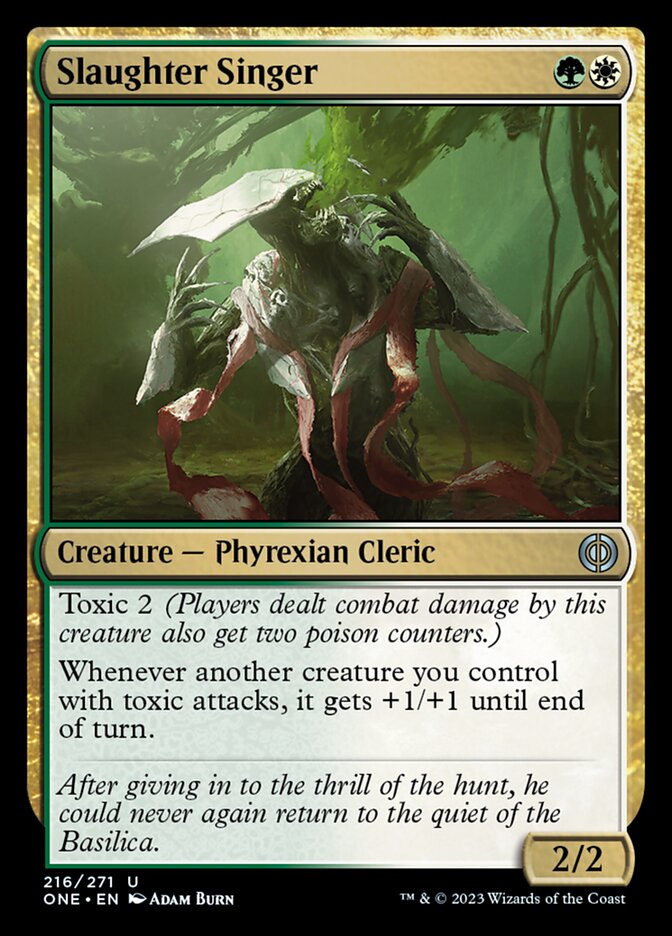
Rating: 7/10
Slaughter Stinger is basically just a tribal lord for toxic creatures since toxic creatures really want to attack and rarely want to block (or, in the case of mites, can’t even block in the first place).
That’s pretty great as far as I’m concerned, and even hits hard itself with toxic 2.
Tainted Observer
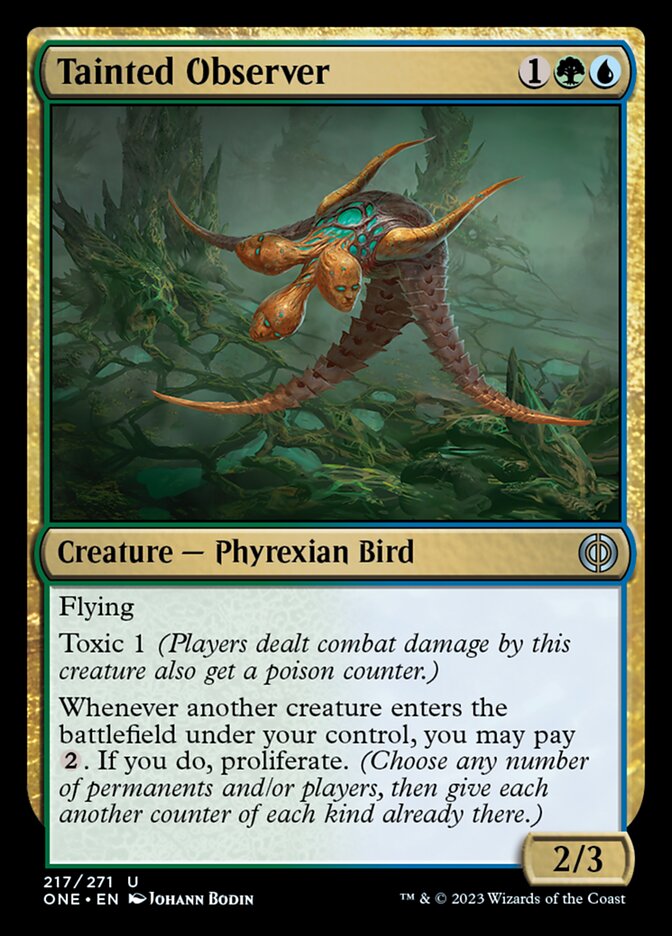
Rating: 7/10
There’s nothing bad about Tainted Observer at all. It’s a very good size for its mana cost, has toxic to start the poison train, and even has a repeatable way to proliferate.
What’s not to love?
Tyvar, Jubilant Brawler
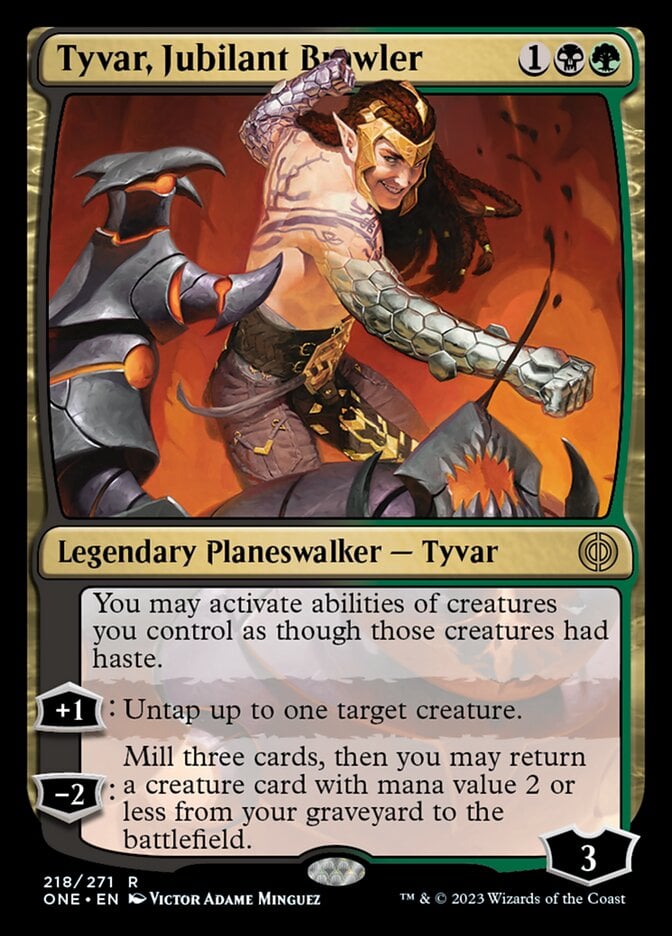
Rating: 4/10
Until now I’ve given the rare planeswalkers ratings of 10, 8, 10, and 10. At least one of them had to be a stinker, and sadly for elf fans it’s Tyvar, Jubilant Brawler.
The first Tyvar Kell has abilities that are centered around mana elves, and so does this one for some reason. There are almost no mana dorks in the set, and even with them this isn’t doing a great deal.
Reanimating a 2-drop is fine and it can untap creatures to use them as blockers, but you’re not exactly building up any advantage with Tyvar like literally every other planeswalker in the set is capable of doing.
Venser, Corpse Puppet
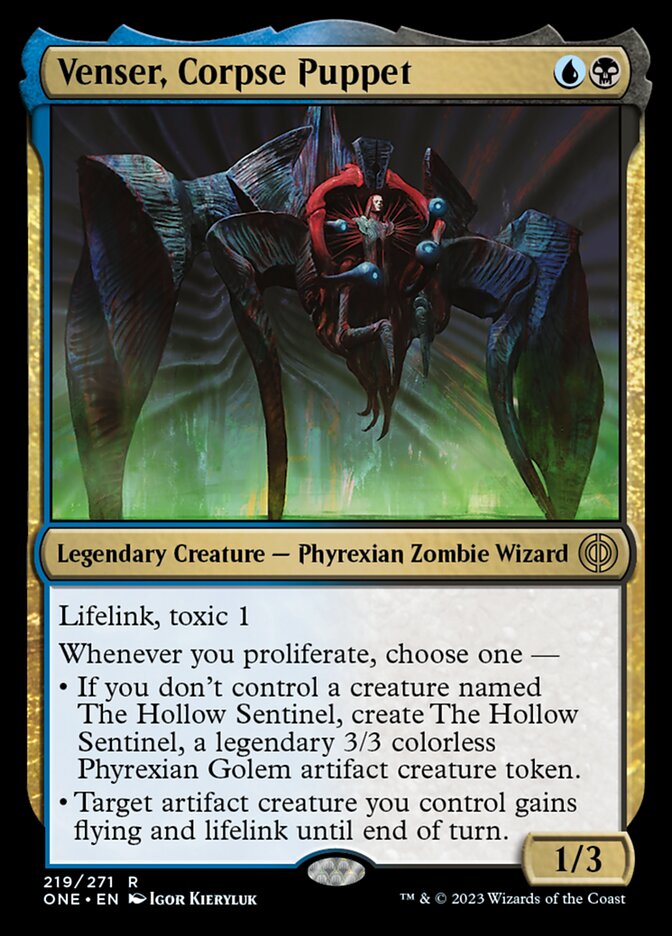
Rating: 6/10
I’m getting huge Seymour Flux vibes from this new Venser as a huge fan of Final Fantasy X.
Unlike that incredibly annoying boss battle, Venser, Corpse Puppet actually starts off a little on the weak side. Triggering off every proliferate is quite powerful, and the 3/3 legendary token it makes will just keep coming back over and over again if you decide to deal with it. Give Venser enough time and it’ll dominate the board with its trigger going off all the time, so take that how you will.
You may heari the ominous words of Seymour, “Your hope ends here. And your meaningless existence with it!”
Vivisection Evangelist

Rating: 9/10
Oh boy, is it my birthday? One of the absolute best Limited creatures of all time is whatever variant of Nekrataal or Ravenous Chupacabra we get given next. Removing any creature is great, but why not get that attached to another creature? It’s the easiest way to get a straight up two-for-one.
Plus Vivisection Evangelist can be flickered, bounced, or reanimated for even more value. All it asks is that you get corrupted online first, but the sheer amount of proliferation that’s available in this set leads me to believe that that should be possible before this comes down.
Absolutely incredible card and likely the mythic uncommon of the set.
Voidwing Hybrid
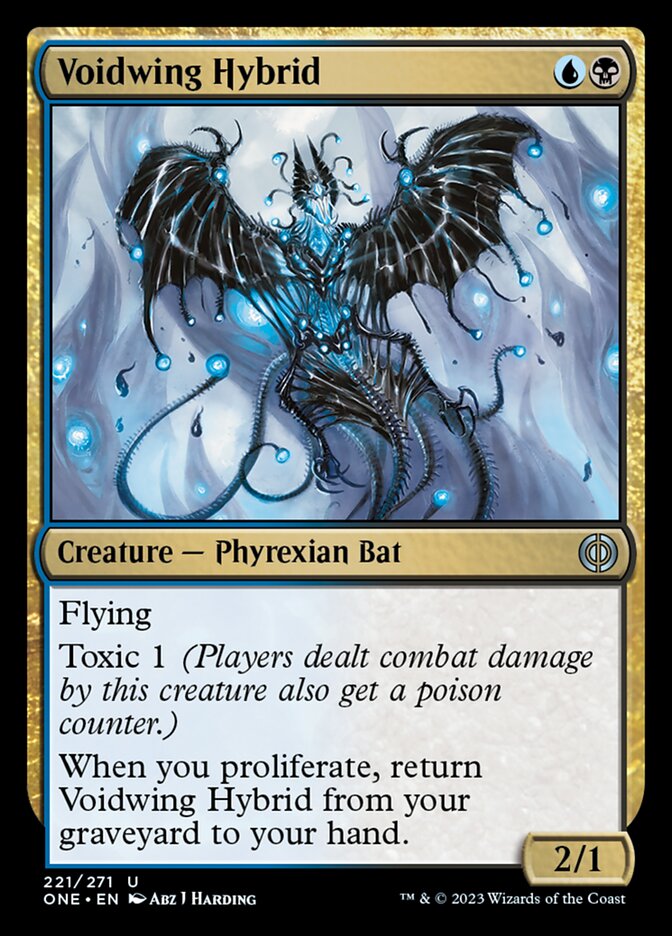
Rating: 7/10
You don’t have to sell me much on a 2/1 flier for just two mana.
Yeah, I’ll take toxic 1 as a nice add on. Oh, I get to return Voidwing Hybrid from the graveyard for free every time I do the thing I wanted to do a lot of anyway? Where do I sign up?
Colorless Cards
Argentum Masticore
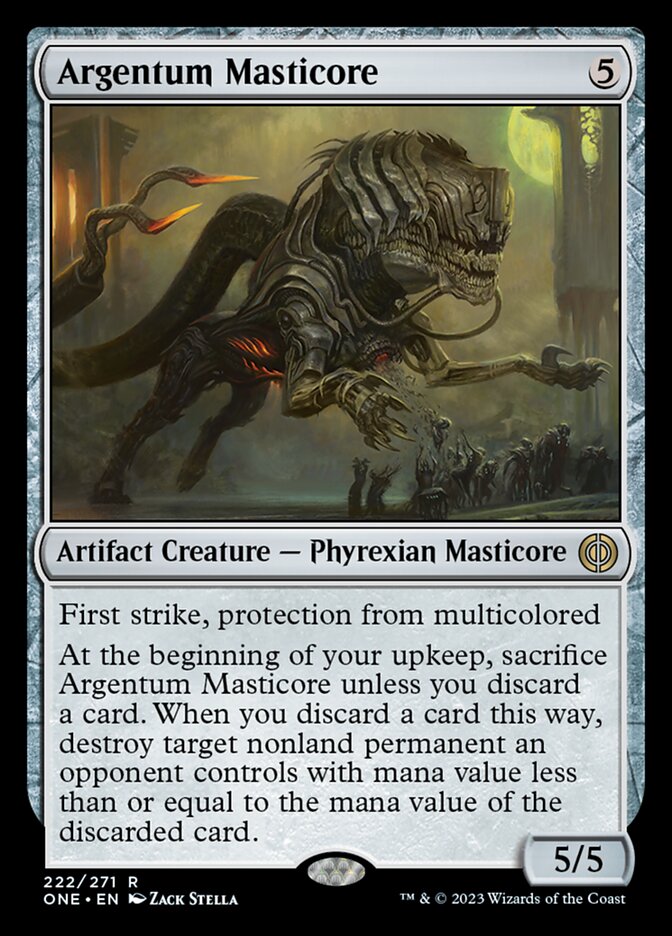
Rating: 6/10
Believe it or not, the original Masticore was once one of the best cards in Standard. We’ve seen a lot of variations on the theme that haven’t hit anywhere near the same mark since then. Argentum Masticore has the potential to be different.
We still have the heavy cost that all the big Masticores have of needing to discard a card each turn to survive, but at least they’re turned it into an upside on this one, allowing you to turn your cards into free removal spells. The creature itself is pretty big, but it doesn’t protect itself as well as the original was able to.
Once again the “it dies to removal” argument is active because it can just be killed by a lot of removal spells while providing you little to no advantage before it does.
Atraxa’s Skitterfang
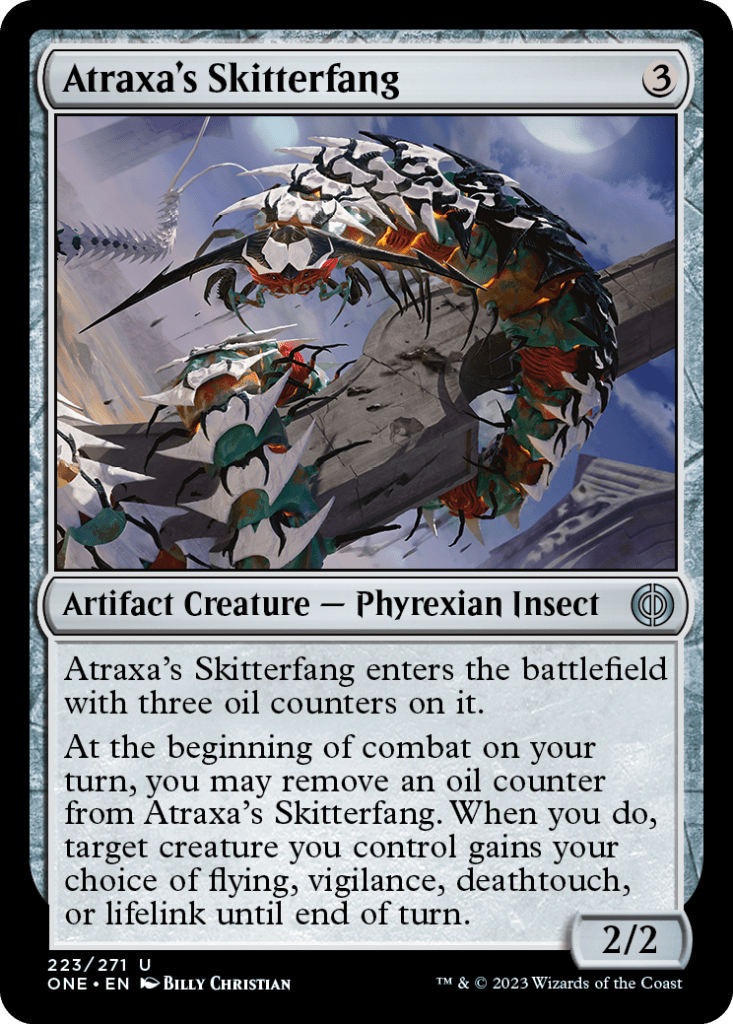
Rating: 5/10
A mini Steel Seraph is still a Steel Seraph.
The mode I particularly like on Atraxa's Skitterfang is flying, which is particularly useful at letting your toxic creatures attack past blockers and get poison counters down. Next would be lifelink to help swing races in your favor.
Above all else the fact that this is a colorless card means literally any deck has access to it, even if that deck wouldn’t normally have access to effects like this.
Basilica Skullbomb
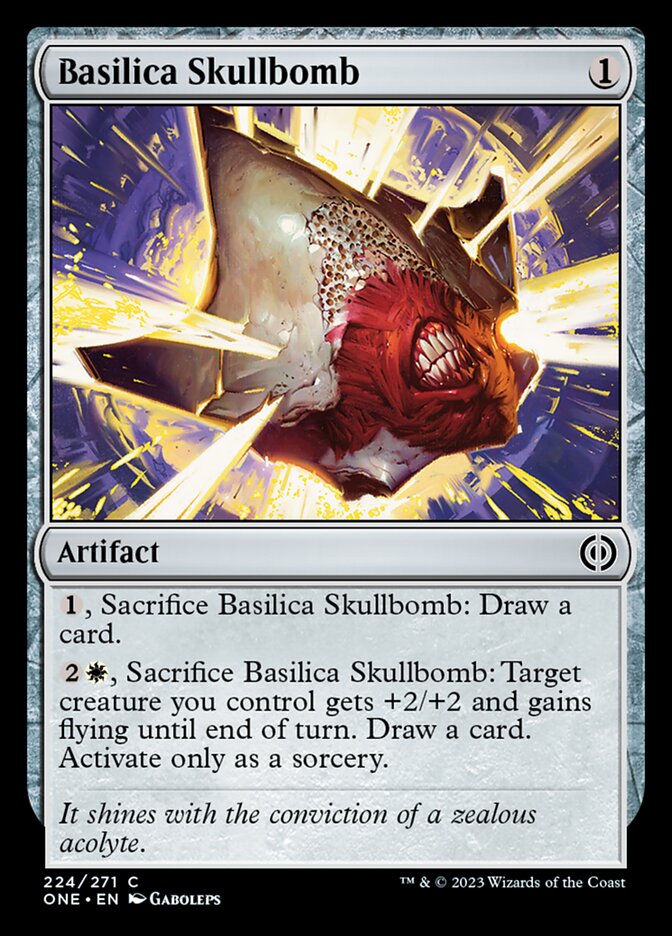
Rating: 5/10
Before I talk about Basilica Skullbomb specifically, I’m going to talk about the Skullbomb cycle in general.
This cycle is absolutely awesome. There are five of them, one for each color, and they’re all 1-mana artifacts that can sacrifice for one mana and draw a card, or sacrifice for more mana to do an effect and then still draw a card.
The fact that these all sacrifice for one generic mana to draw a card makes them all equally good at one specific thing. They’re exceptionally good at triggering artifact synergies or sacrifice synergies. They’re also 1-mana ways to trigger abilities that trigger off of noncreature spells.
I’d be happy taking any Skullbombs that come my way if I was in any of those decks, regardless of which colors they were. Even without those synergies the least they can do is cycle, so they can fill any deck’s curve. Plus (spoiler alert): they’re all quite strong anyway.
Now, to talk about Basilica specifically, giving +2/+2 and flying is a really strong ability, especially on toxic creatures. The fact that you’re still drawing a card makes this always a good card to play.
Dross Skullbomb
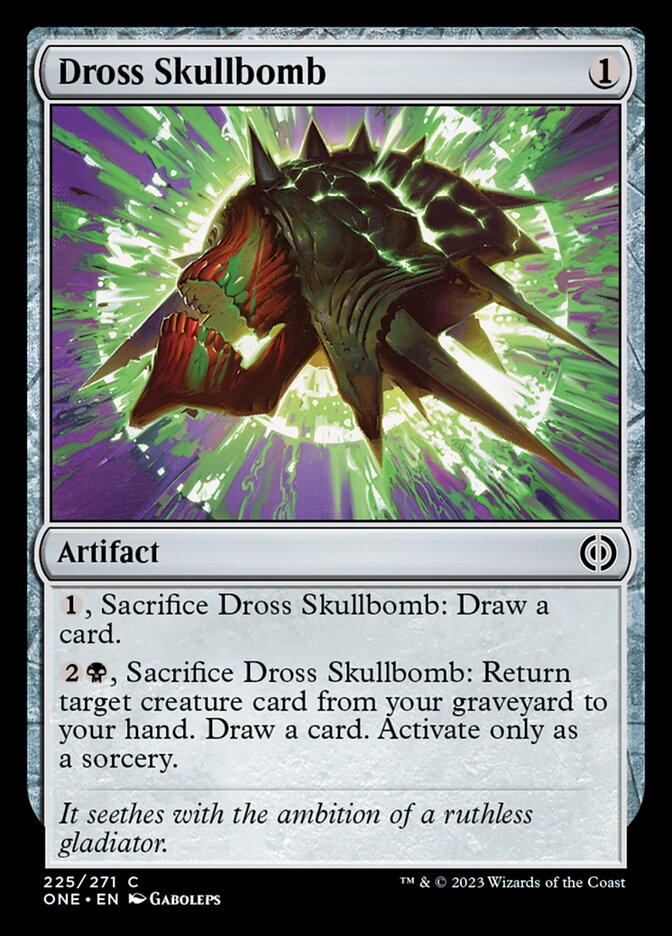
Rating: 6/10
I believe Dross Skullbomb is the strongest of the Skullbomb cycle. It has all of the usual benefits and is also Recover on an artifact, all while being in what appears to be the best color in the set and the color that wants these the most.
Dune Mover
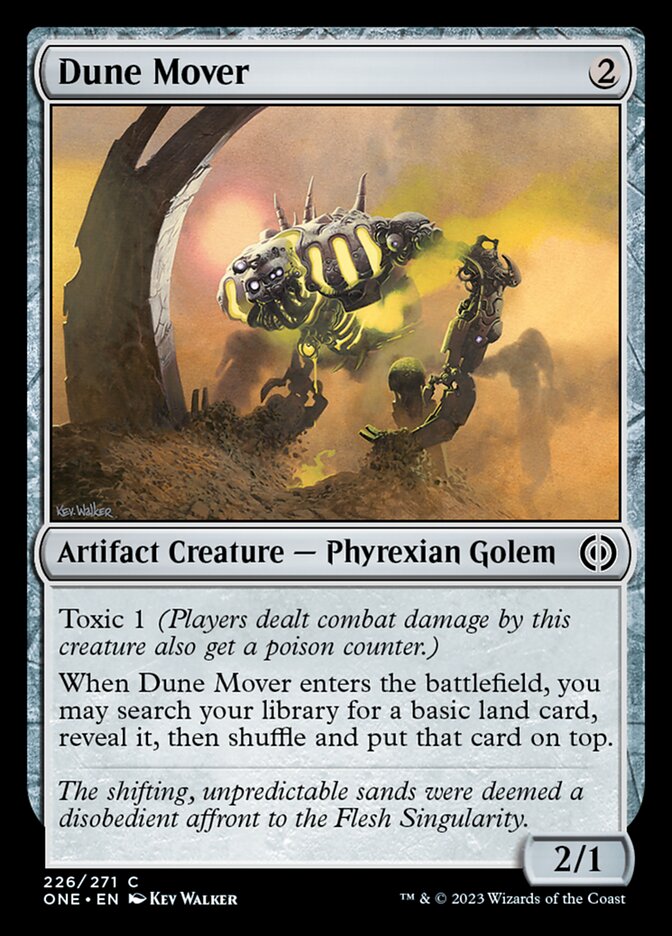
Rating: 3/10
While it’s not good mana fixing, Dune Mover is still a bit of fixing nonetheless. Having toxic is a nice upside that should help this go a bit further than just a simple Campus Guide.
The Filigree Sylex
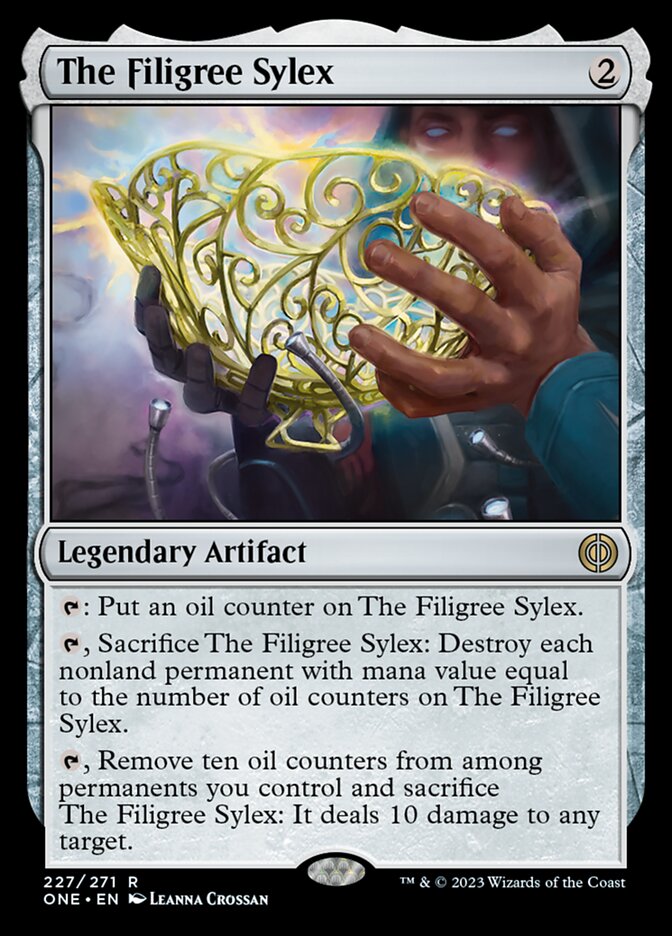
Rating: 8/10
The Filigree Sylex is basically just a Ratchet Bomb that works with oil counters instead of charge counters. Given how much there is in the set that works with that, it might even better than Ratchet Bomb ever was.
As if that wasn’t good enough, it can also turn oil counters on any permanent into a huge shot of 10 damage to any target (our opponent could be a target…) That ability in particular could work nicely with the random cards in this set that enter with a sizable number of oil counters already on them, which makes me think that reaching 10 counters won’t be all that unreasonable to do.
Furnace Skullbomb
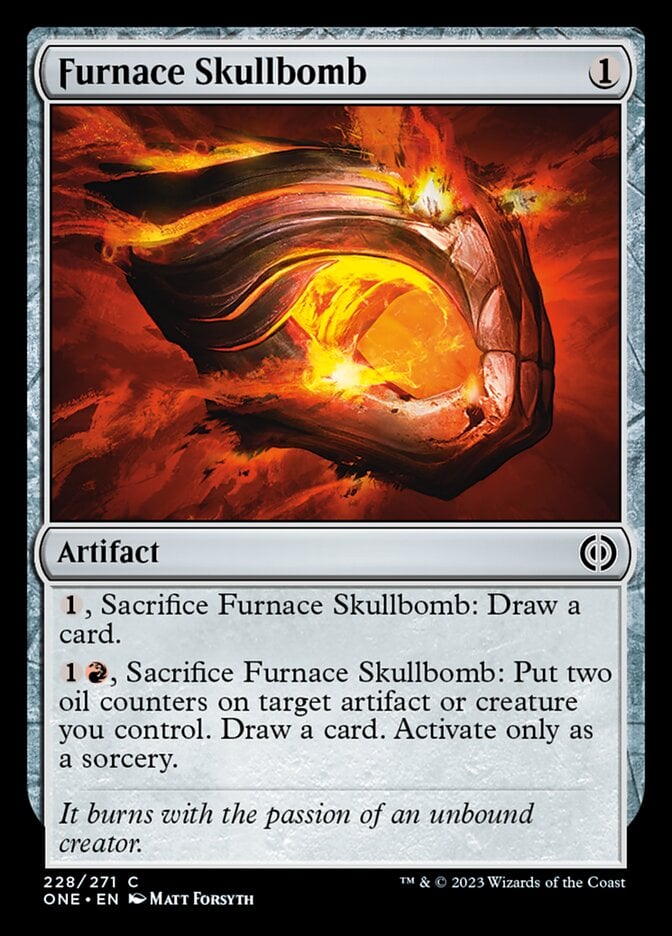
Rating: 4/10
Furnace Skullbomb seems like the weakest of the Skullbombs just because not every creature/artifact you play will care about oil counters. Any creature should be happy with +2/+2, but not with just two oil counters.
That said, the card is still strong and there are plenty of creatures to use it with. This seems like one of the best ways to distribute oil counters cheaply if you’re one of red’s dedicated oil counter decks.
Graaz, Unstoppable Juggernaut
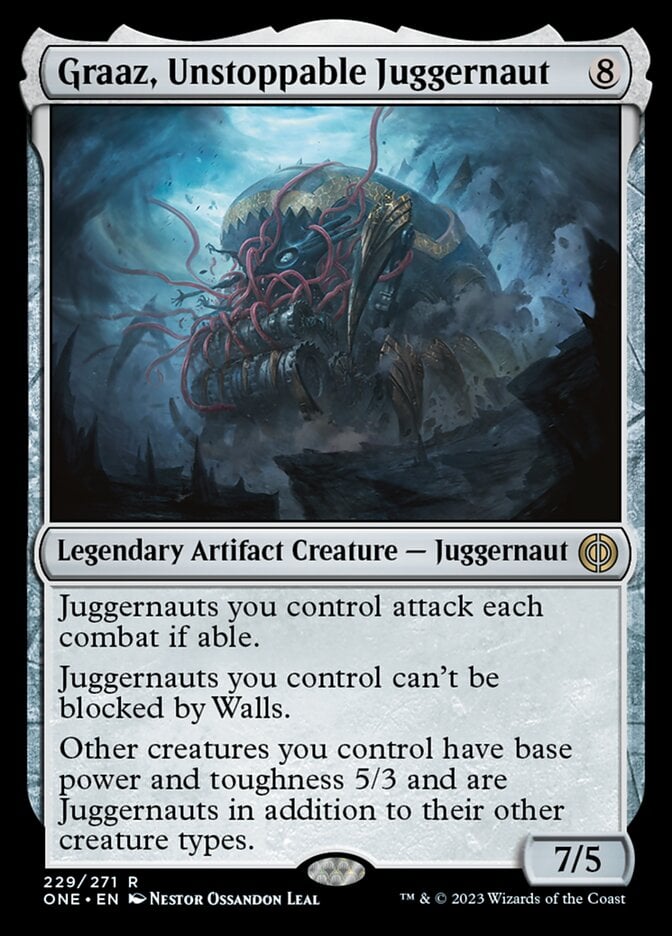
Rating: 5/10
Everything on Graaz, Unstoppable Juggernaut is clearly absurd. Turning all your creatures into 5/3s is very strong, even if they have to be Juggernauts and attack every turn.
But eight is a prohibitively expensive mana cost and I don’t see this being very castable with there not being a lot of ramp available in this set. I’ve given high grades to a few 7-drops so far, but the difference between getting to seven and getting to eight is massive.
This should be incredibly powerful f you can cast it, but I don’t think you’ll be channeling your inner Vinnie Jones any time soon.
Ichorplate Golem

Rating: 5/10
Of course you need to care about oil counters for Ichorplate Golem to even do anything, but tribal lords are definitely worth keeping an eye on. This is quite powerful if you have enough oil counters going on, and any deck has access to it.
Maze Skullbomb
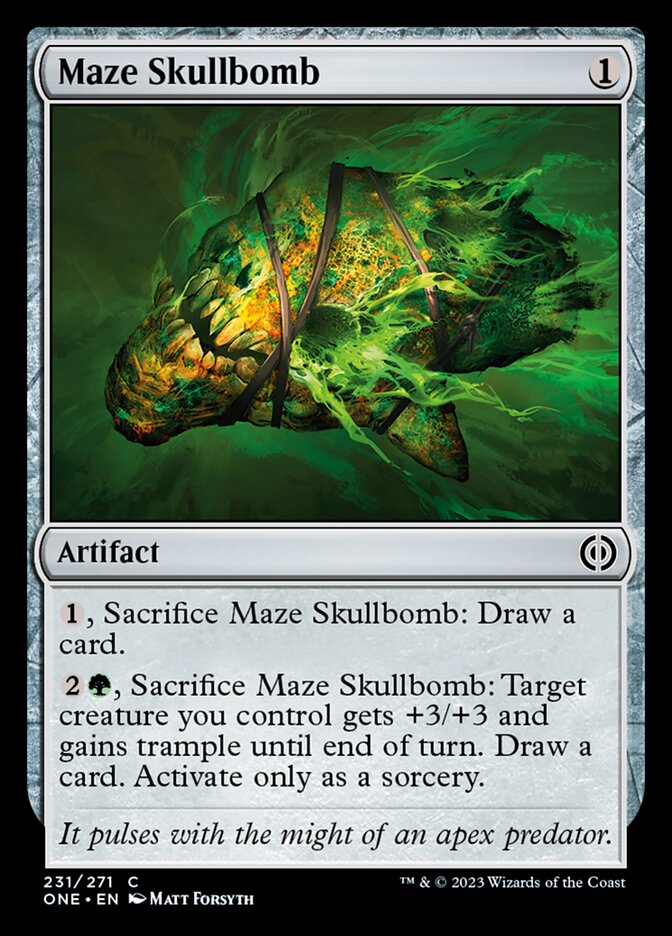
Rating: 5/10
+3/+3 and trample is nothing to be sniffed at. Maze Skullbomb’ll do a good job of pushing a lot of creatures through blockers while cantripping and having all the aforementioned benefits of being a Skullbomb.
This one is held back a little bit more than the others since green doesn’t really have any ways to use the Skullbombs, but you can still use it as a decent spell that can cycle.
Mirran Safehouse
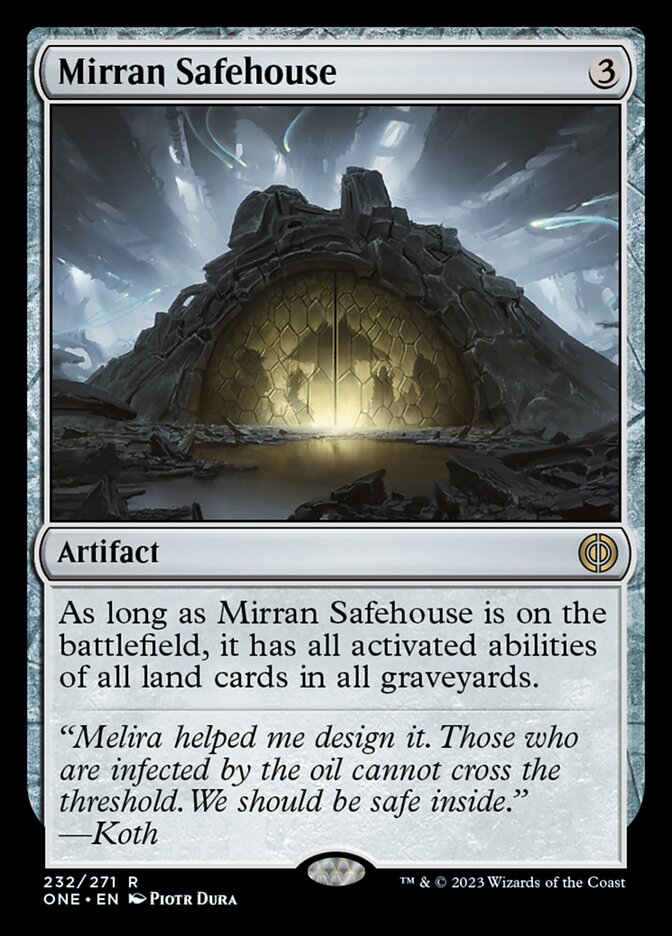
Rating: 0/10
We’re playing Limited, so nearly all of our lands will be basics and aren’t particularly likely to end up in the graveyard in the first place. Mirran Safehouse is designed for constructed and is basically a bad mana rock that requires setup to even do its thing in Limited.
Monument to Perfection
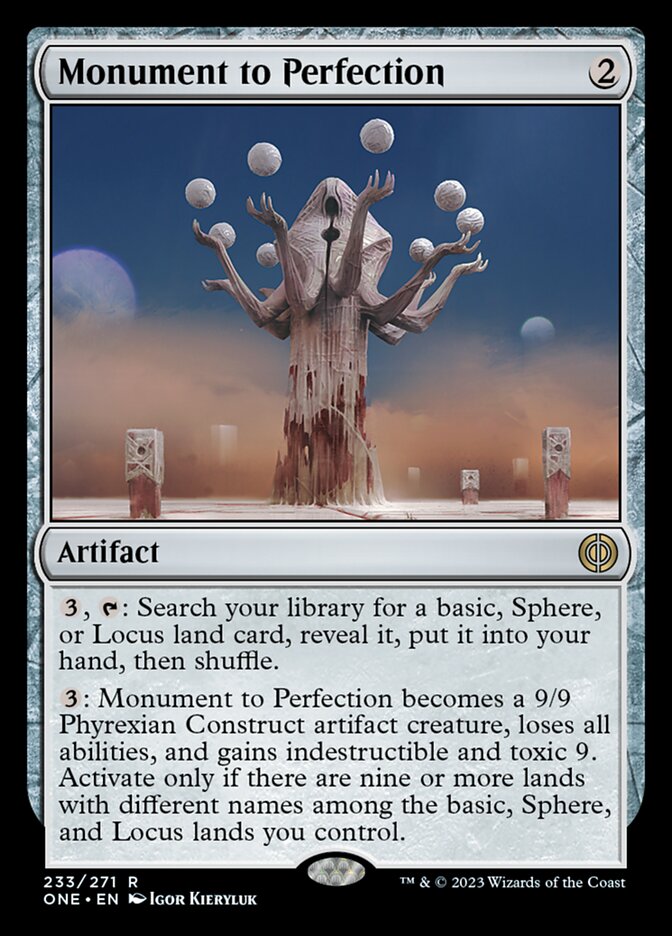
Rating: 1/10
I gave Journeyer's Kite a 2/10 in the last set, and my estimation of it has gone down since then. Sure, you can also find Spheres, but that’s not much of an upgrade.
Given that your deck will be mostly basic lands regardless, getting to turn Monument to Perfection into a 9/9 is just not going to happen in most circumstances.
Myr Convert

Rating: 7/10
It’s really cool that this mana dork is literally turning any colored mana into Phyrexian mana for you. You can’t use Myr Convert too often, but the power of a mana dork usually comes from accelerating one or two big things and then being a normal creature after that.
Luckily for us Myr Convert isn’t too shabby at that second part, being a 2/1 with toxic 1, meaning it should be acceptable for most decks.
Myr Custodian
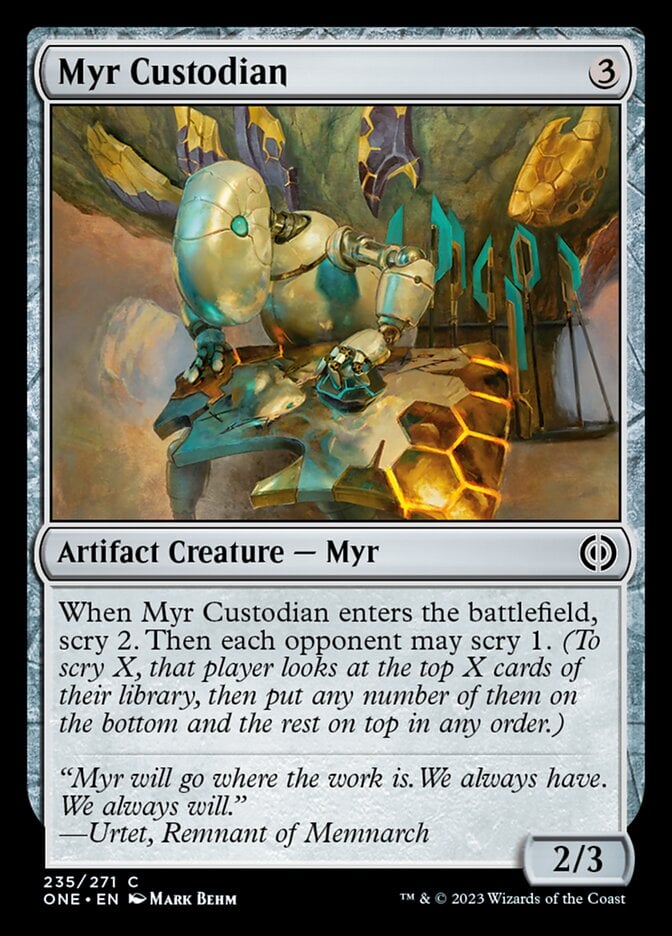
Rating: 2/10
Myr Custodian is very much a “begrudgingly playable” card. Sure, it’s not horrible to cast, but I don’t want to if I can help it.
This is the sort of card that looks really good when you only ended up with 21 or 22 playables and are struggling to round out your deck.
Myr Kinsmith

Rating: 4/10
I bet there are a few Myr fanatics out there who love Myr Kinsmith. I quite like it too, mainly because it can search for extra copies of itself. Similar cards in the past like Legion Conquistador and Self-Assembler have been very strong when you can get multiples of them.
A 4-mana 3/1 does sound quite a bit worse than those previous versions, but it should still be good if you can get a few of them.
Phyrexian Atlas
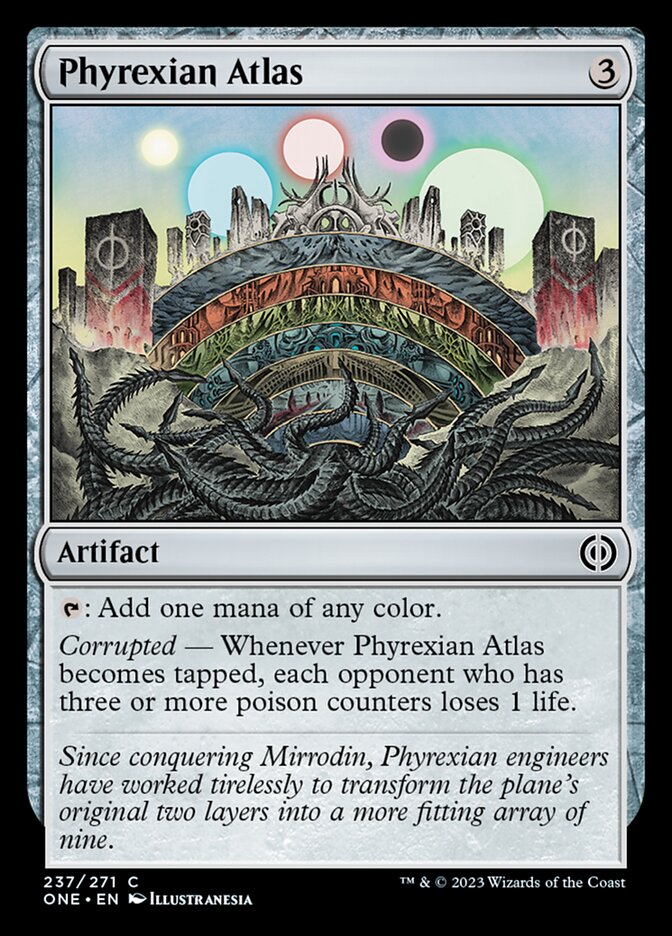
Rating: 3/10
Phyrexian Atlas’ artwork perfectly illustrates how the plane now looks with its nine Spheres stacked on top of each other. Mana rocks have been very hit-and-miss in recent sets, and this one doesn’t seem to break the mold.
Most decks won’t want this at all, but there are some strong incentives to splash colors. This isn’t a horrible way of going about that.
Prophetic Prism
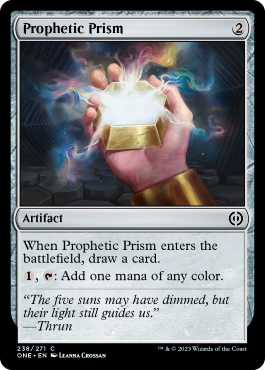
Rating: 7/10
Prophetic Prism is an exceptionally strong card. We saw Energy Refractor do a lot of work in The Brothers’ War, and this is even stronger. It’s been great every time we’ve seen it, from color fixing in Rise of the Eldrazi to being literally the best common in Kaladesh.
Prism does more than just fix your colors because it’s also a cheap artifact that replaces itself, making it excellent to trigger artifact synergies and act as sacrifice fodder. It really does it all, and any deck can play it.
Prosthetic Injector
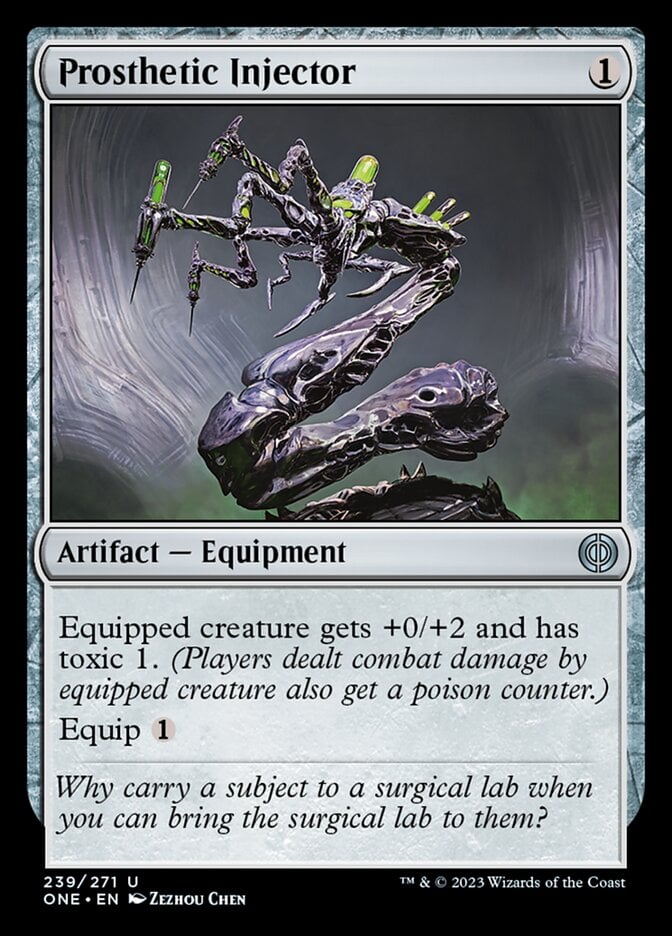
Rating: 3/10
In a world where equipment cards come with free creatures attached, I’m not sure why I want one that doesn’t do that. On the other hand, Prosthetic Injector is cheap enough that it could slot into some decks. It’s just not likely to be high on anyone’s priority lists.
Ribskiff
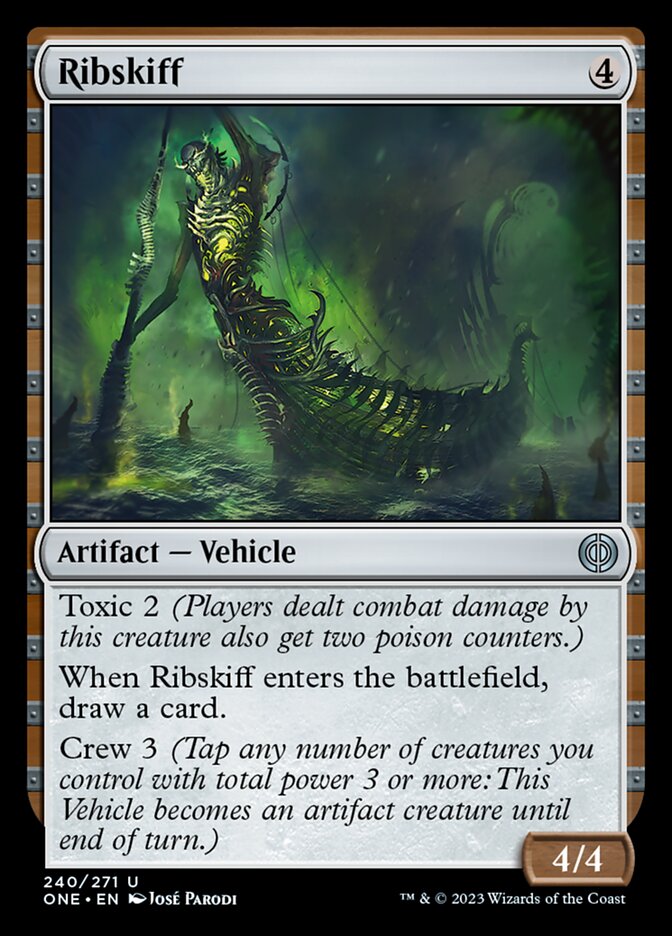
Rating: 6/10
Even though crew 3 is quite hard to satisfy, Ribskiff does pay you off for playing it. It draws a card on entering and is a very big body for what you’ve paid.
I think you should want a big toxic creature in order to play this, but I’d be very happy with it if I was.
Soulless Jailer
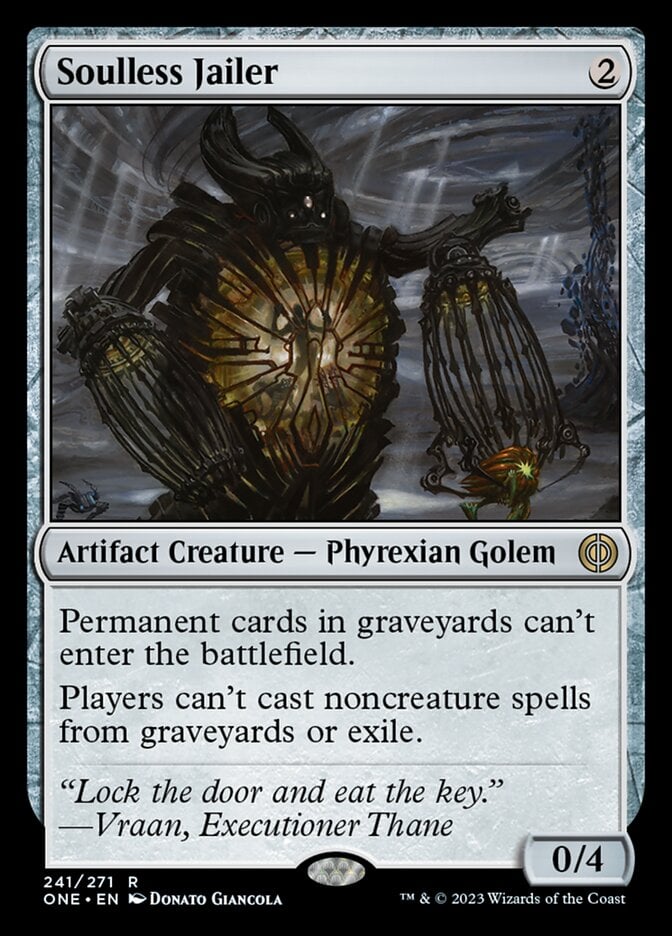
Rating: 1/10
Soulless Jailer’s abilities do nothing. It’s very clearly a plant for constructed formats. The only reason it isn’t getting a flat 0 is because it’s a 2-mana 0/4. There are certainly some decks that might want it as a sideboard option in an aggressive format.
Staff of Compleation
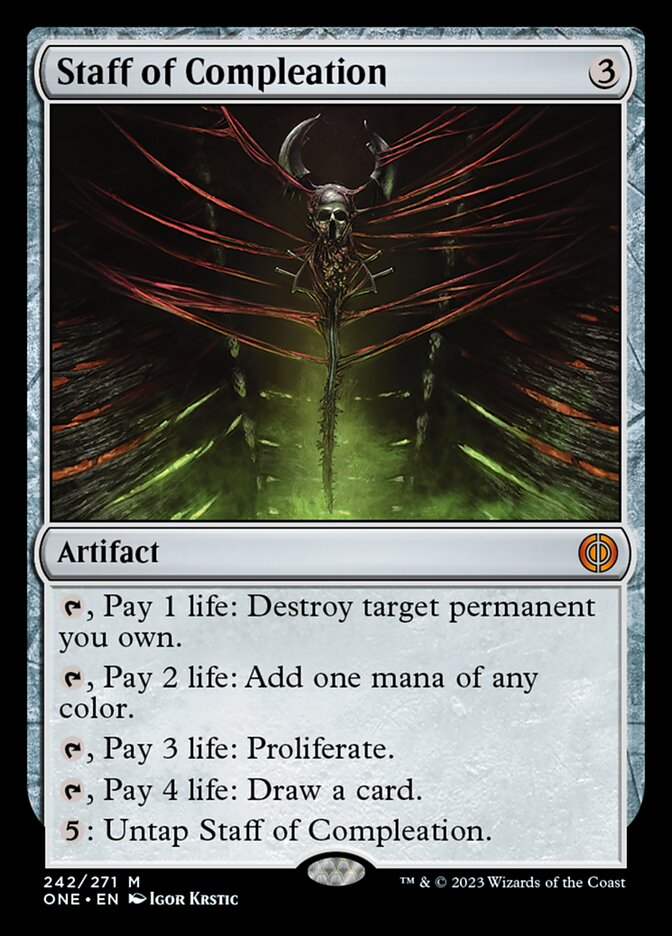
Rating: 0/10
I’d like to find out I’m wrong, but Staff of Compleation doesn’t do it for me at all. You can’t afford to pay life in such huge chunks. The point of the card is surely being able to untap it and use multiple modes, but you can’t afford to do that and the modes are too niche to care about them.
I’d just leave this to the constructed gods and not bother in Limited.
Surgical Skullbomb
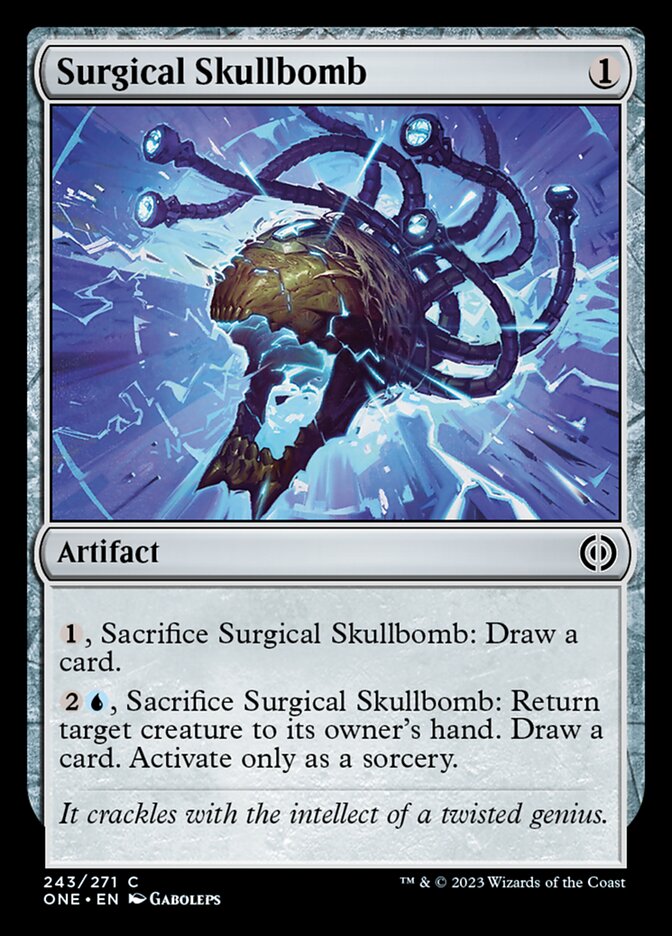
Rating: 5/10
Sorcery speed kills Surgical Skullbomb a little bit, but it still has a lot going for it. Bouncing a creature and drawing a card is a great deal and especially useful on your own creatures to reuse their ETB triggers.
You usually have to find the right opportunity to use it, but that’s never going to be much of a problem thanks to the ability to just sacrifice it for one and cycle it.
Sword of Forge and Frontier
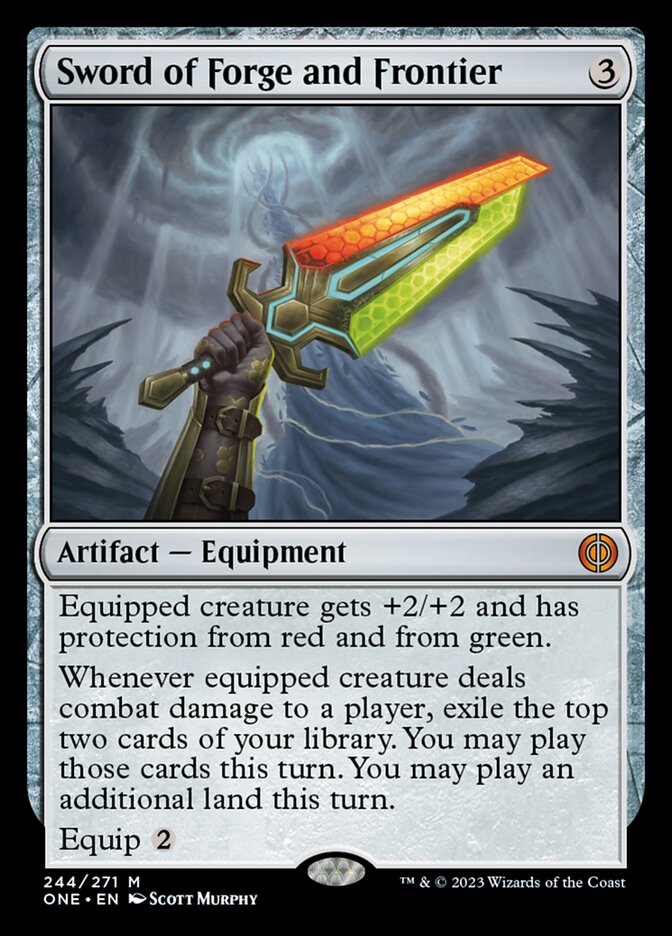
Rating: 10/10
Our ninth protection sword starts to close out the cycle with another very welcome entry. Basically allowing you to draw two cards when your creature connects is a very powerful ability, and the clause of getting an extra land drop will mean that they’re rarely wasted.
What sells Sword of Forge and Frontier (and other protection swords for me) is that they’re so cheap and efficient. 2-mana to equip and get +2/+2 is a good deal regardless of whether the protection colors are relevant.
It’s also colorless so it goes in literally any deck. This is likely one of the best first picks in a Draft thanks to that very fact.
Tablet of Compleation

Rating: 4/10
2-mana rocks are incredibly powerful, which is why WotC is scared to print them. The result is cards like Tablet of Compleation, which look like it’s supposed to be that but has none of the advantages.
The best use is likely to be something you can pile counters on and be able to draw a card each turn which is fine, but the effort that goes into making that happen means only a few decks will be into it.
Zenith Chronicler
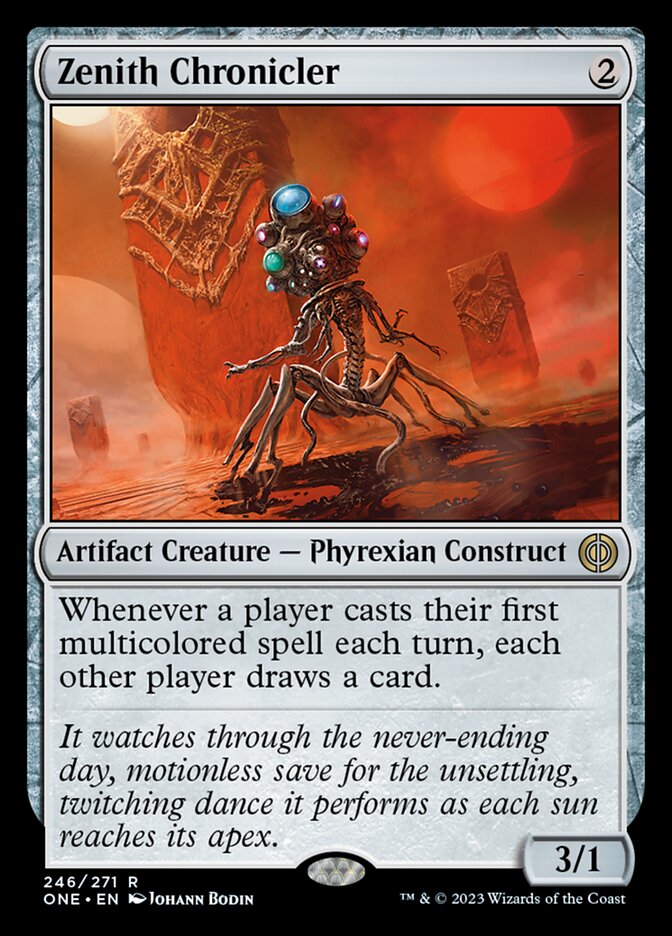
Rating: 1/10
The multicolored cards in this set are extremely powerful, but not abundant. Zenith Chronicler is a constructed plant and nothing more. Sometimes the trigger might even be a downside, which isn’t something that you want on a vanilla 3/1.
Lands
The Common Spheres
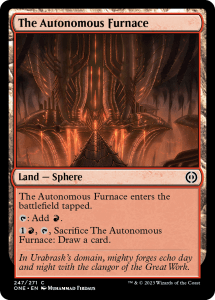
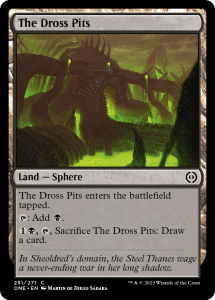
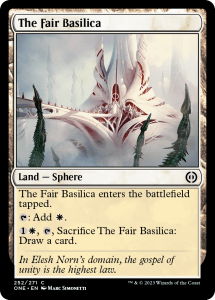


Rating: 4/10
This common cycle of lands is pretty good. They have a lot of similarities to the cycling lands from Urza’s Saga and Onslaught, but you don’t have to worry about deciding whether to just play them or keep them in hand.
I’d be higher on these if being a Sphere mattered more, but WotC seems to have omitted any cards that actually reference them. So I’m struggling to find any reason to care other than they’d be better than taking cards I wouldn’t play.
The “Fast” Lands
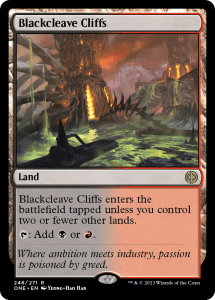
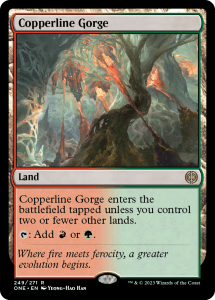
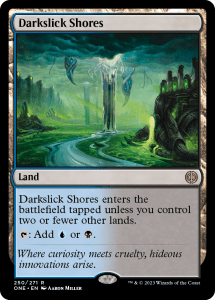
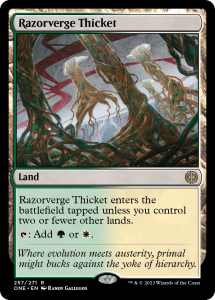
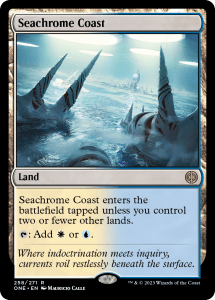
Rating: 4/10
These are easily the most influential cards in the entire set as far as constructed is concerned. A long-awaited reprint of some very strong dual lands that’ll make them both Standard-and Pioneer-legal, slotting into dozens of different decks while also bringing their secondary market value down.
But they’re not all that in Limited.
Mirrex

Rating: 5/10
I’ll say this for each of these, but colorless lands take a heavy toll on your mana base and it’s often not worth playing them because of that.
What I like about Mirrex is that it still spots you a mana of any color the turn you play it, which mitigates that downside to some extent. Making a mite for free is a very good ability, but they won’t really help you if you need to stall out the game without the ability to block, something that other token-generating lands are good at doing.
This becomes more powerful if the games are going slowly, but I wouldn’t rely too heavily on it otherwise.
The Monumental Facade
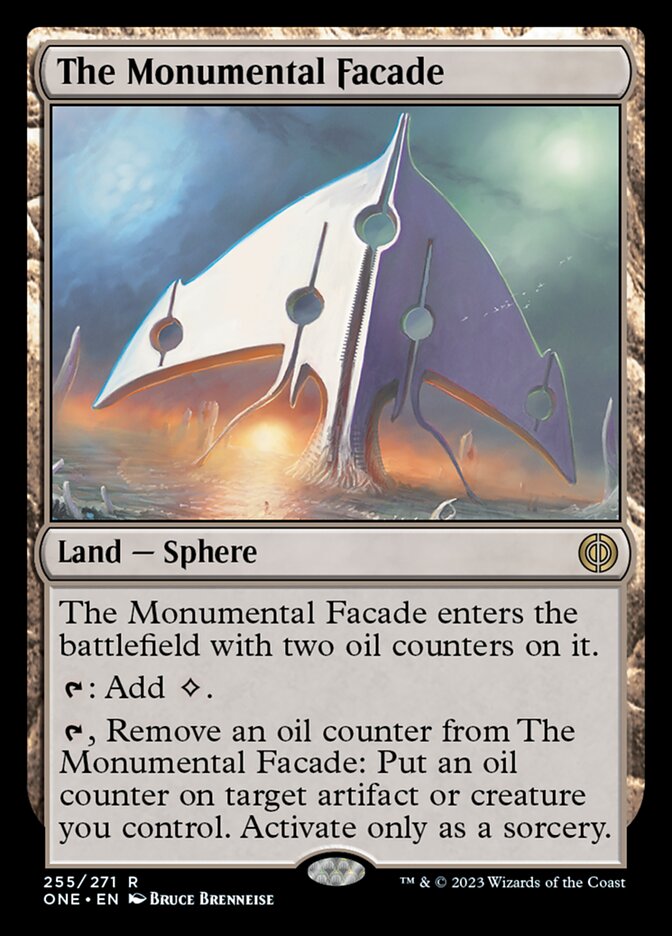
Rating: 4/10
Like I just said, colorless lands have a massive inherent downside associated with them. The upside needs to be big enough to warrant playing them, and I’m not sure that you get that from The Monumental Facade.
I’d certainly try it when I got an opportunity to do so, but I think it’s very possible that a lot of decks that use oil counters won’t be able to afford playing this.
The Mycosynth Gardens
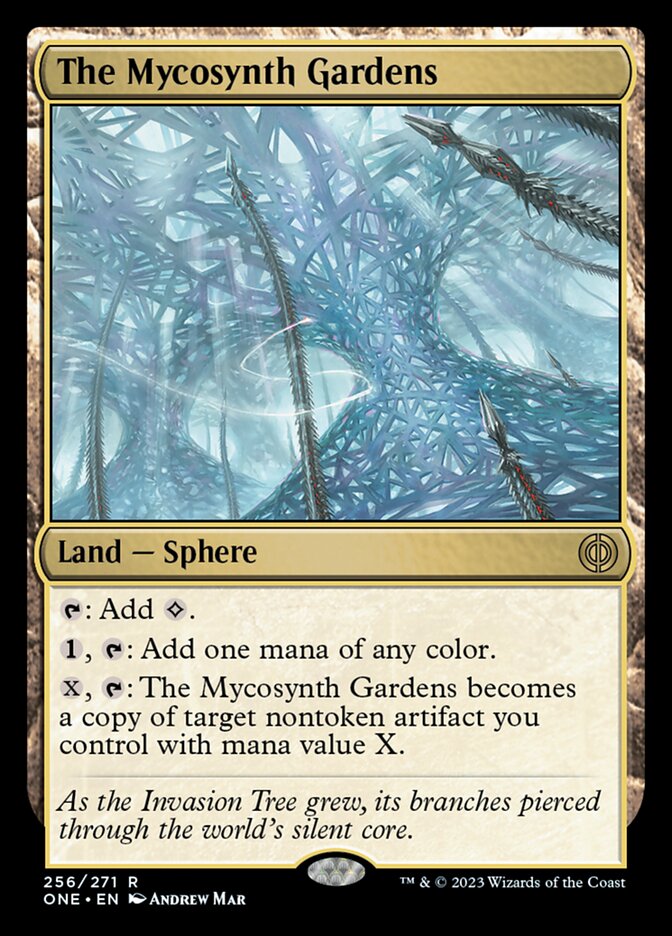
Rating: 7/10
Yeah, I’m not a fan of Unknown Shores, but that’s still a better baseline than just being colorless. Turning into a copy of an artifact you control is a massive upside for a land, especially if that artifact is also a creature.
A land that eventually turns itself into a creature like The Mycosynth Gardens does is always strong, especially when you don’t need to keep activating it each turn like typical creature lands.
The Seedcore
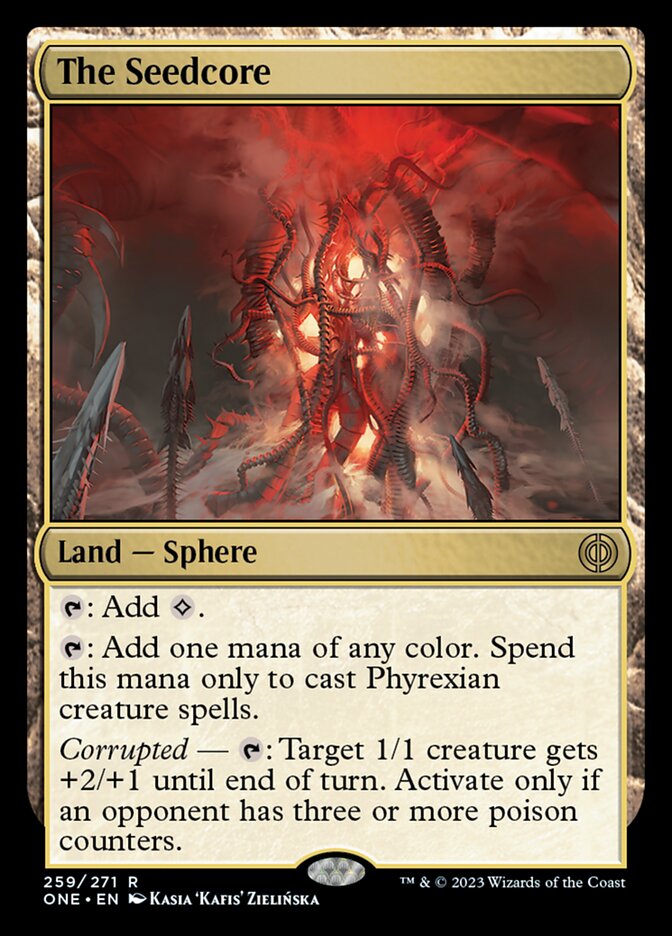
Rating: 7/10
There are 138 creatures in this set and 127 of them are Phyrexian, so when The Seedcore is color fixing you for 92% of the creatures in this set I’d say it’s going to be pretty useful no matter which deck you’ve drafted.
The Pendelhaven-style ability on this is also very useful for decks that use mites or other small creatures. I’d assume this is a high pick if you’re anywhere close to a deck like that.
Terramorphic Expanse

Rating: 5/10
Interesting choice of reprints, but of course the Spheres of Phyrexia aren’t exactly full of wilds and wide open plains for Evolving Wilds to feel very thematic. As always, Terramorphic Expanse is a great land to pick up and I’ll always play at least one in everything but the most aggressive decks.
And Done…
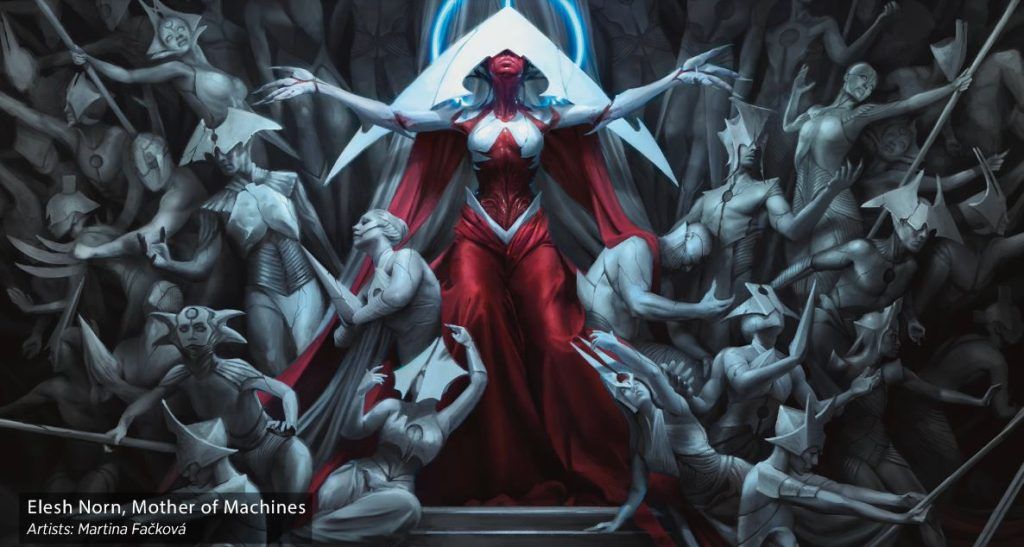
Elesh Norn, Mother of Machines | Illustration by Martina Fackova
That is Phyrexia: All Will Be One! I hope you enjoy your prereleases and are looking forward to this set as much as I am.
If anyone reading this is going to Magic Con Philadelphia and would like to say hello, I’ll be at the event as a judge! It’ll be my first big event in about 3 and a half years (of course because of covid) so I’m very excited, especially to be coming back to the States. I’ll be a floor judge in the blue tournament area if you’d like to find me and say hi.
Are you looking forward to drafting this set? Which cards do you think are the most standout for Limited? Let me know in the comments below or join the discussion over in the Draftsim Discord. And don’t forget to download Arena Tutor if you’re going to be drafting on MTGA when it drops.
Until next time, take care of yourselves!
Follow Draftsim for awesome articles and set updates: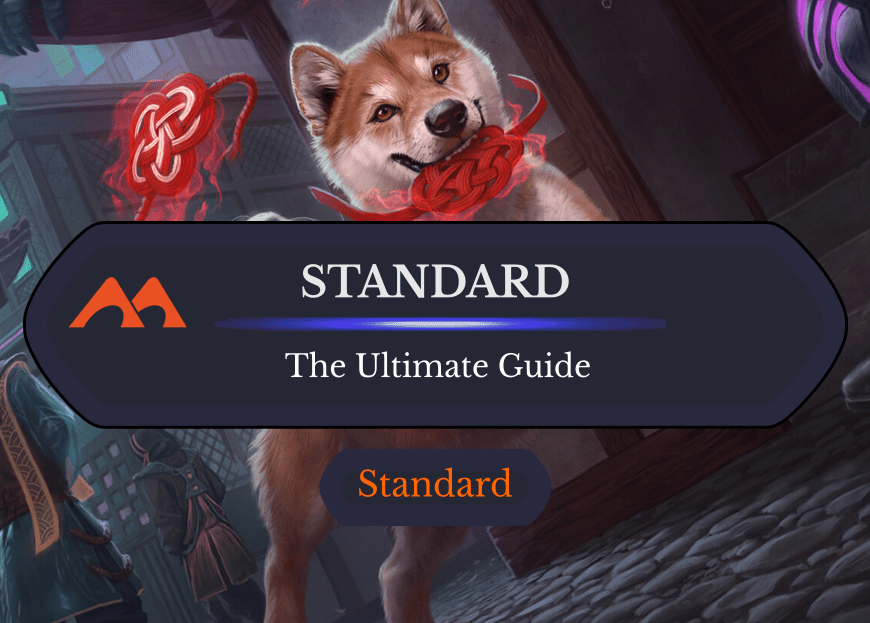

Add Comment